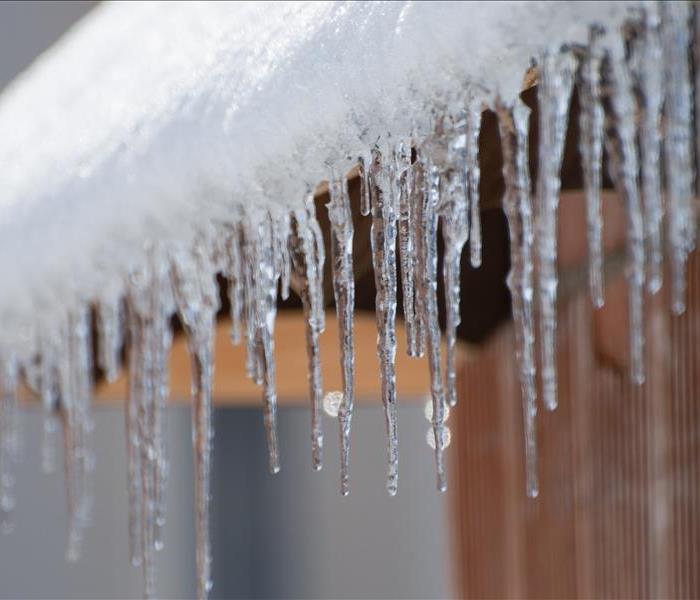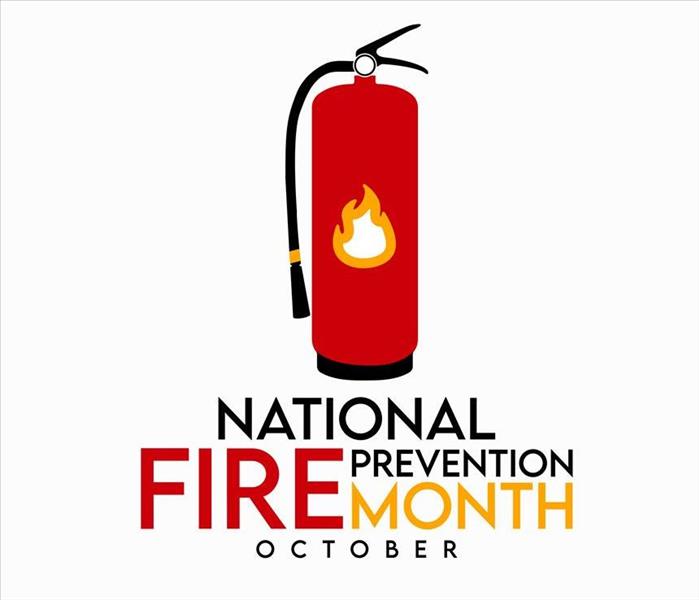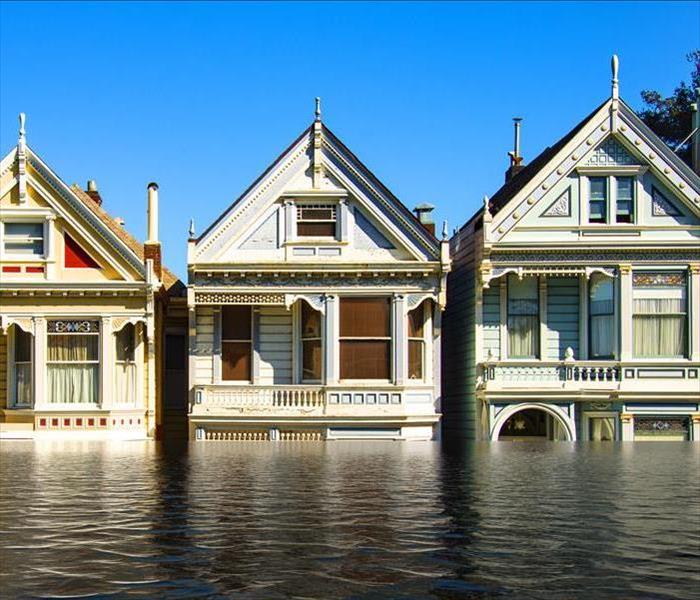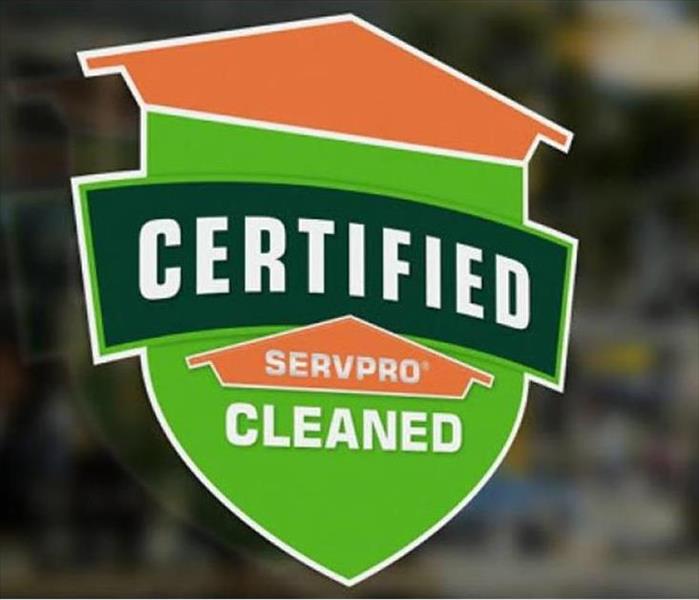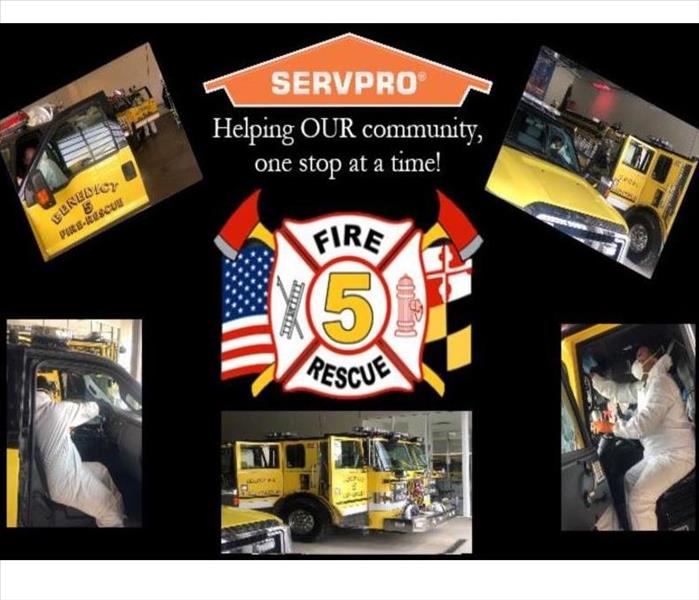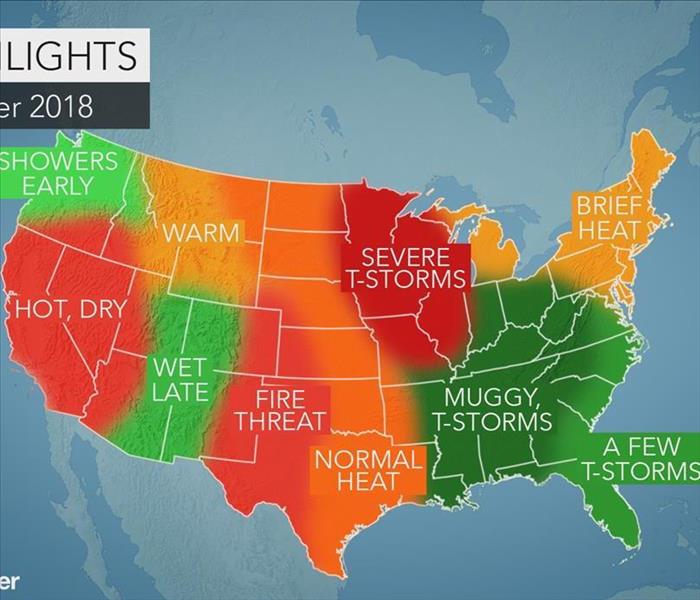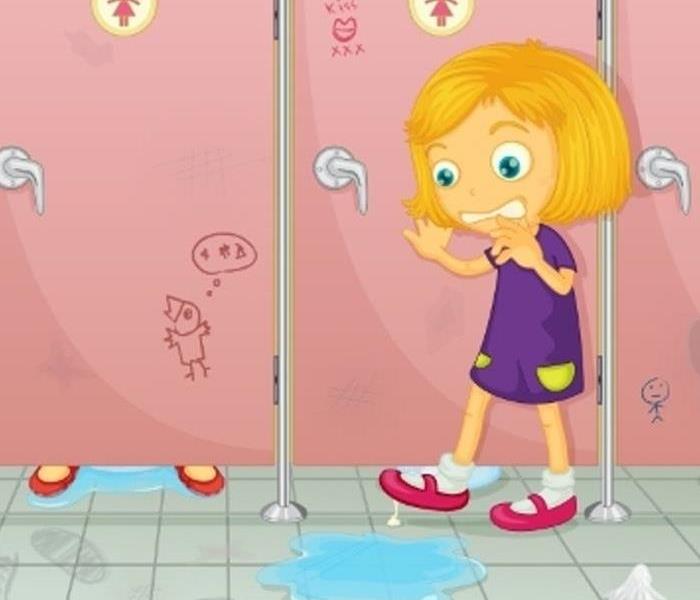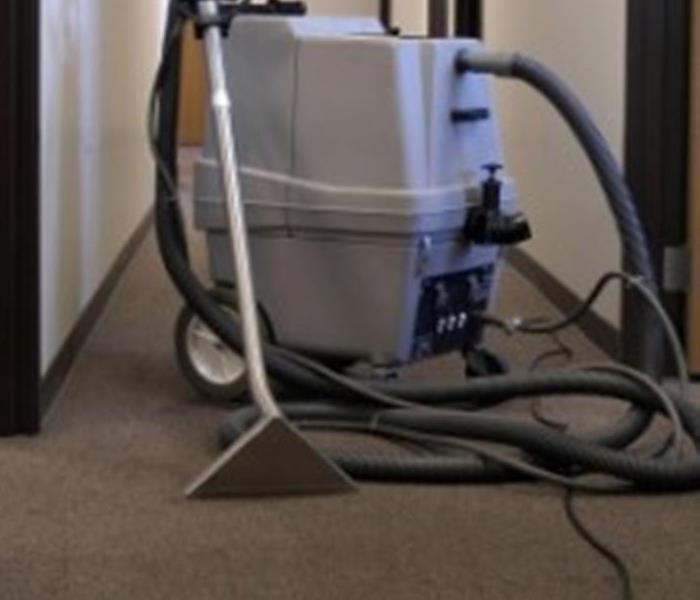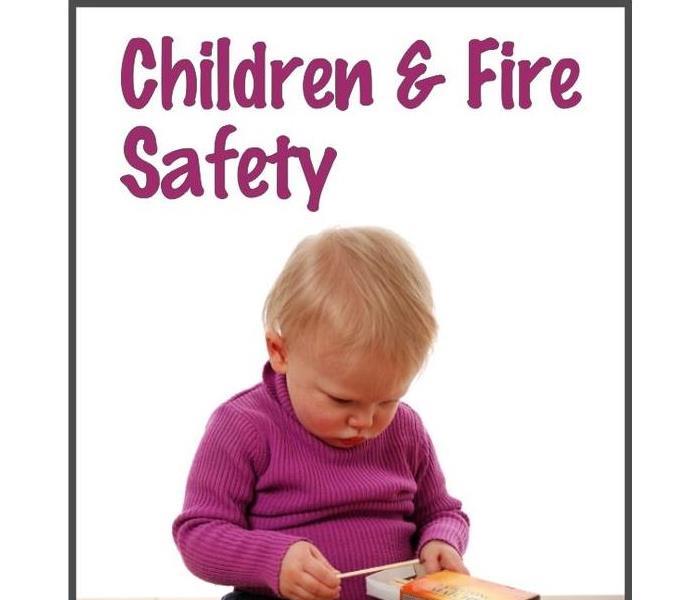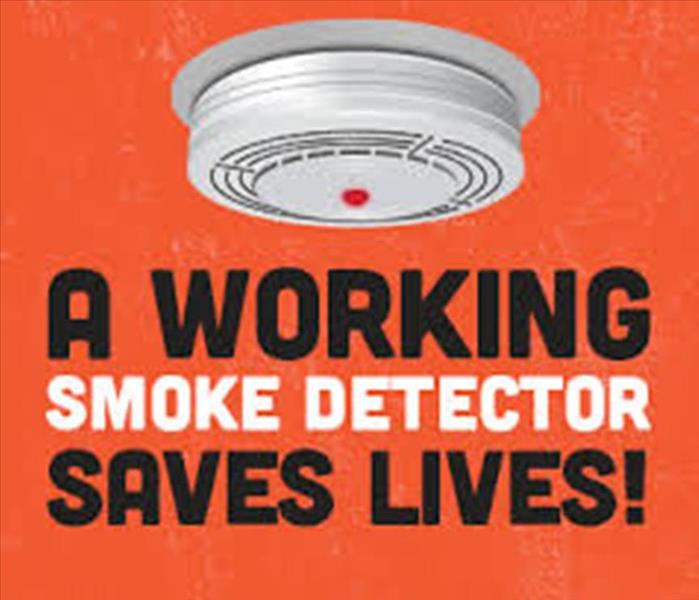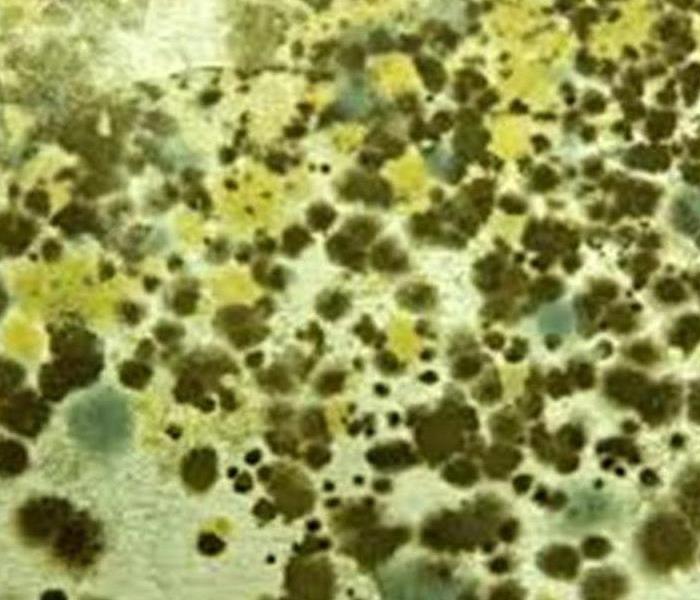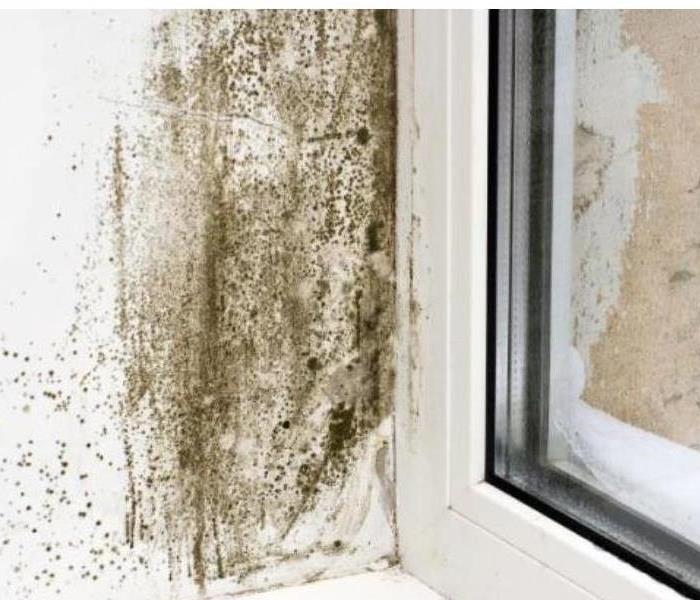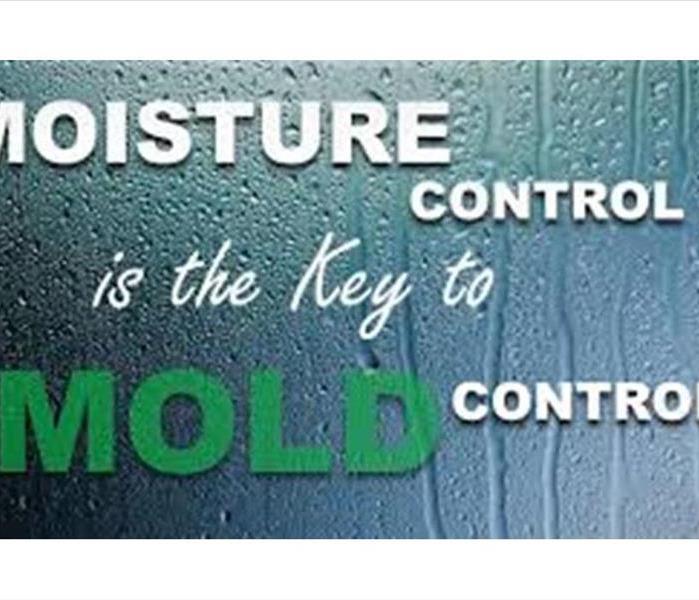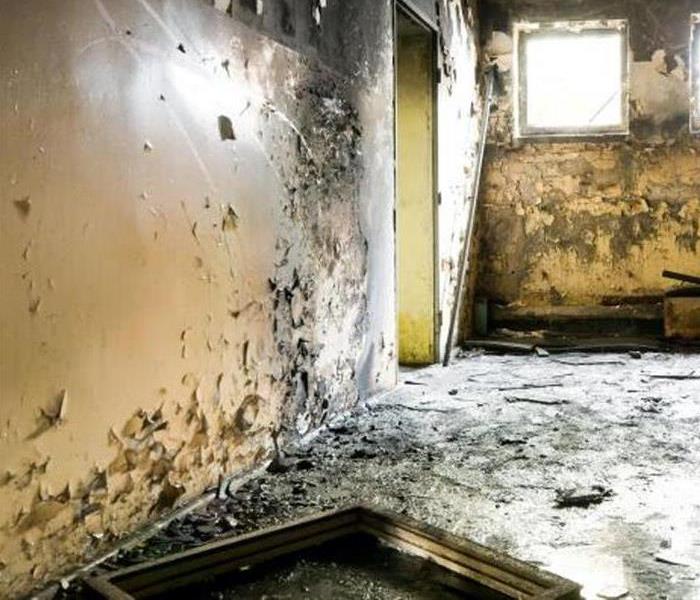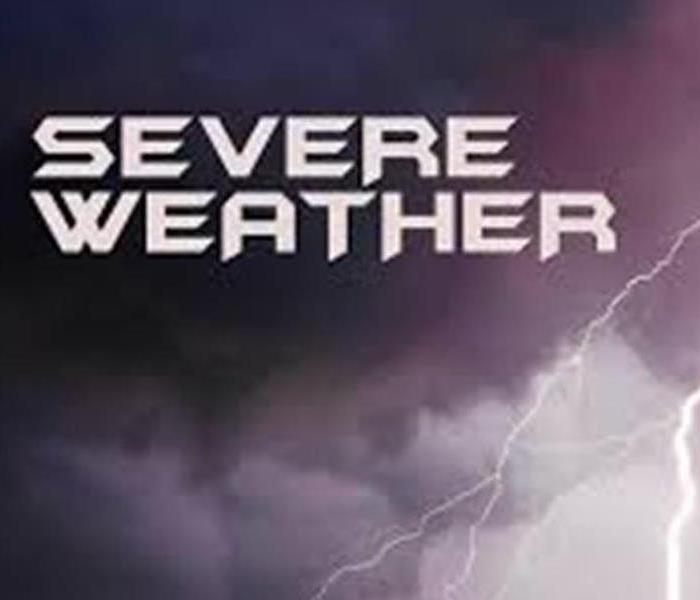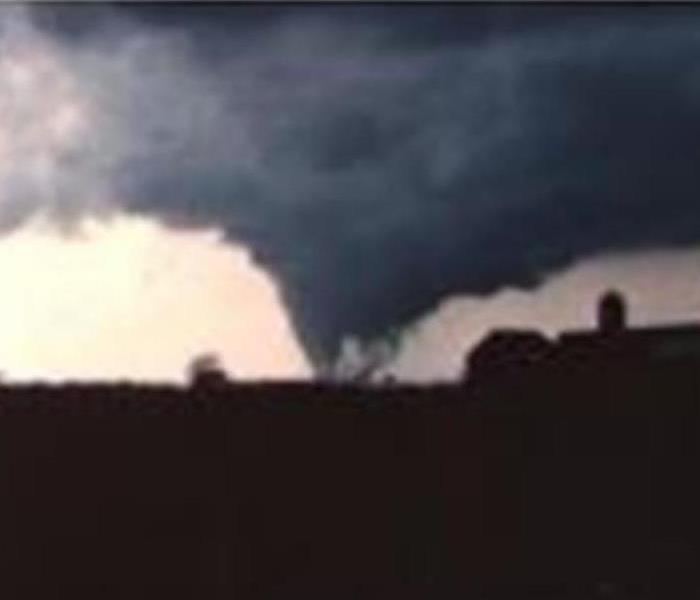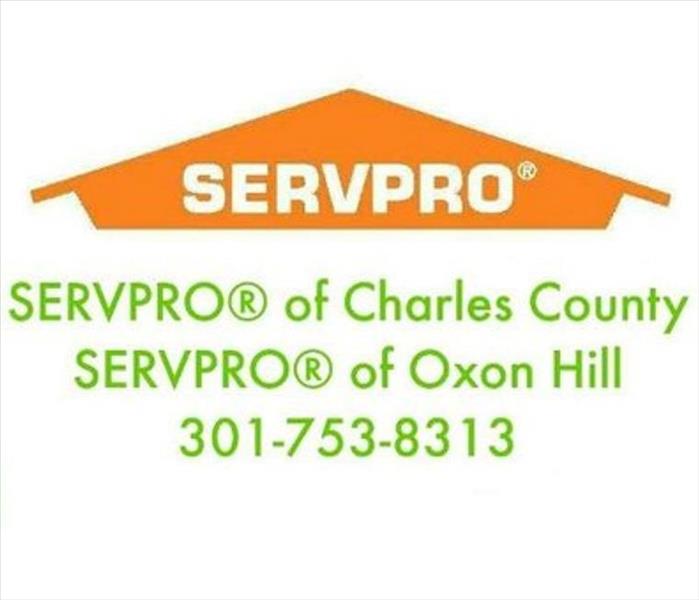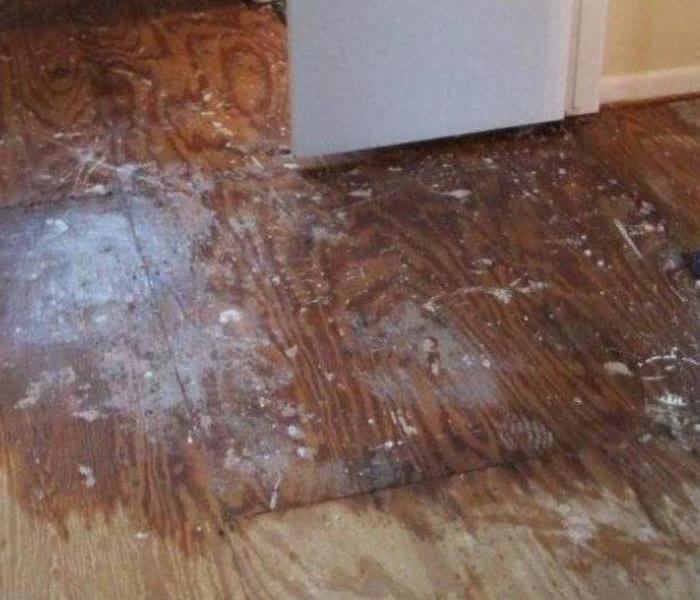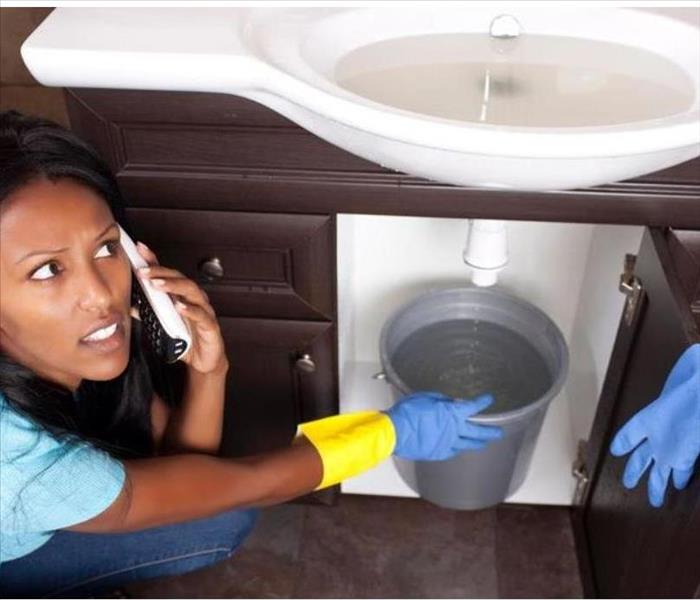Archived Blog Posts
Impact of Water Damage
8/18/2022 (Permalink)
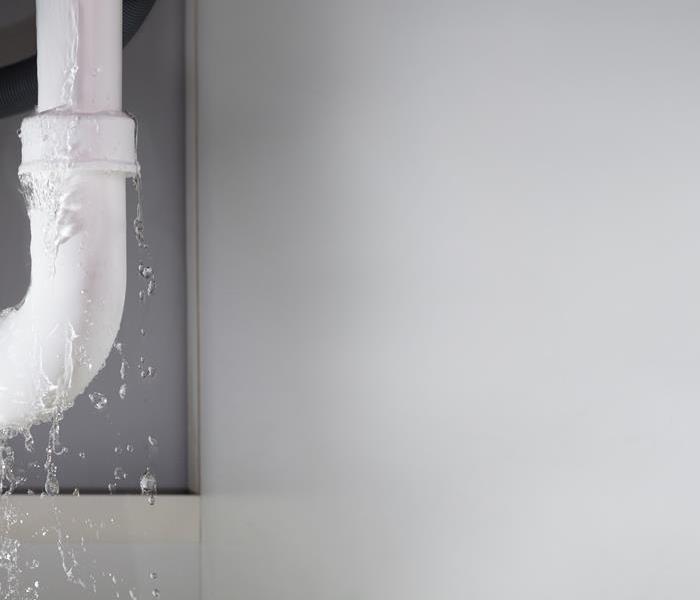 Pipe leak
Pipe leak
Your home is your safe place or respite and relaxation. It provides protection and comfort for family, friends and loved ones. However, sometimes accidents happen. Houses flood, pipes burst, and roofs leak. What might not seem like a big deal initially may become much worse if left unchecked. Water damage in a home can have a substantial negative impact on those living in the house. Water damage and freezing as a category is the second-most common type of home insurance claim (following wind and hail).
- Nationwide, household leaks waste an estimated one (1) trillion gallons or enough to supply 11 million homes with water for a year.
- 10% of homes with leaks waste 90 gallons or more per day.
- A leaky faucet can waste 3,000 gallons per year.
- A leak in an irrigation system can waste 6,300 gallons in a year.
- An average household leak can waste up to 10,000 gallons of water in a year.
- Annual water wastage from a typical household leak is equivalent to the water used for:
- 270 loads of laundry.
- 600 showers.
- 1,200 loads of dishes in a dishwasher.
- 6,250 flushes of a standard toilet.
- 80,000 servings of water.
Flooding and water damage is very invasive. Water quickly spreads throughout your home and gets absorbed into floors, walls, furniture, and more. SERVPRO of Charles County arrives quickly and starts the water extraction process almost immediately. This immediate response helps to minimize the damage and the cleaning and restoration costs.
Flooding and water emergencies don’t wait for regular business hours and neither do we. SERVPRO of Charles County provides emergency cleaning and restoration services 24 hours a day, 7 days a week—including all holidays. As always, SERVPRO of Charles County and SERVPRO of Oxon Hill professionals are here to help!
Hailstorm
8/18/2022 (Permalink)
 Hailstorm Damage
Hailstorm Damage
Occasionally, we southern Marylanders encounter a hailstorm. Let’s discuss what causes hail and its impact.
What is and what causes hail?
Often round in shape, hail is layered ice particles produced by thunderstorms with strong, tilted updrafts. They usually form within a unusually unstable air mass in which the temperature falloff with height is much greater than normal. The unstable air is required to create large updraft speeds -- fast enough to keep a developing hailstone from hitting the ground.
- Hailstorms are the identifier of a strong thunderstorm.
- The eventual size of the hail depends on how long they can defeat gravity.
- Hail size depends on the strength of the updraft.
- The bigger the hail balls are, the harder they fall.
- The largest hailstone ever recorded was the size of a volleyball.
- Hail causes $1 billion in damage each year with millions of ice balls ranging in size from golf balls to grapefruits.
- Oklahoma is the large hail champion in the United States.
Regardless of the type of storm, we recommend:
- Check your surroundings and make sure you are safe.
- Contact your insurance company.
- Inspect the roof and exterior siding.
- Check other outside structures
- Inspect your home’s appliances
- Check the attic, crawlspaces and basement.
- Document any and all damage.
In the event of an emergency, we are here to help and available 24 x 7. Call SERVPRO of Charles County and SERVPRO of Oxon Hill 24/7/365 Emergency Services at 301-753-8313.
The Importance of Professionals
4/11/2022 (Permalink)
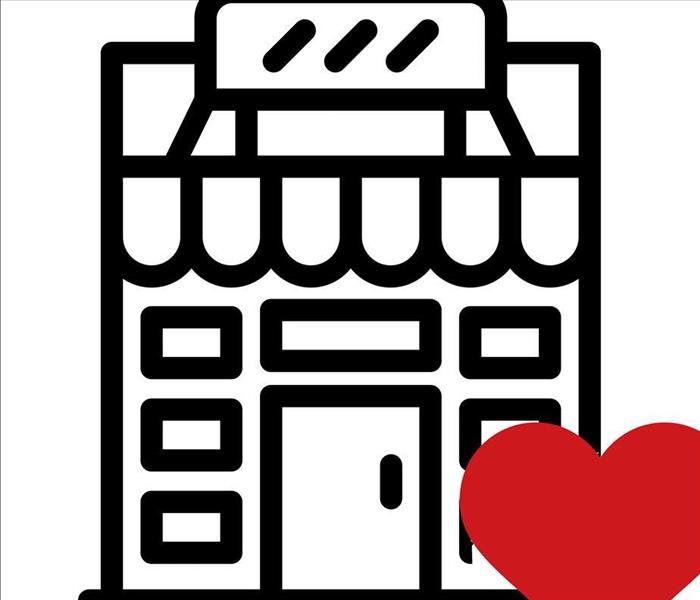 We are here to help!
We are here to help!
We can never accurately predict when the disaster will strike. But when it does, it is vital for us to understand that restoring damaged commercial property is a huge responsibility. In the case of commercial property, when it is the physical face of your company, it is always best to rely on professionals.
At SERVPRO® of Charles County and SERVPRO® of Oxon Hill, we provide:
- 24 x 7 Response to your emergency from the restoration team
- Experienced and trained technicians to guide you through the process
- Commercial equipment capable of restoring fire, water, mold, and storm damage
- Stress-Free claims process working with your insurance company
- Limits to service disruption while working on getting you back in business
Whether businesses, apartments, hospitals, hotels, medical facilities, or educational institutions, SERVPRO® of Charles County and SERVPRO® of Oxon Hill are here to help! We offer the best restoration services for commercial buildings so that your business can start running smoothly again. We can be reached by calling (301) 753-8313 for commercial restoration service.
Responsive, Ready and Qualified
3/28/2022 (Permalink)
SERVPRO of Charles County and SERVPRO of Oxon Hill are available 24 hours a day for emergencies, large or small. Depending upon the situation, immediate action may be crucial. A delay of just a few hours can greatly increase the severity of the damage.
We understand that when you call us, you may be feeling confused, stressed, and vulnerable. You need an expert to guide you through this crisis.
Serving our community for over 35 years, SERVPRO of Charles County and SERVPRO of Oxon Hill have the specific training and experience to help you through this tough time.
We specialize in the cleanup and restoration of residential and commercial property after a fire, smoke, or water damage event. Our staff is highly trained in property damage restoration. From initial and ongoing training at SERVPRO’s corporate training facility to regular IICRC-industry certification, rest assured our team is equipped with the knowledge to restore your property.
Our Commitment to our Community
3/28/2022 (Permalink)
 Communities begin with Children
Communities begin with Children
Why choose SERVPRO® of Charles County and SERVPRO® of Oxon Hill? With many other choices available, we stand out because of our local ties and commitment to our community. We are not just about work, work, and work. At SERVPRO® of Charles County and SERVPRO® of Oxon Hill, we believe a strong and cohesive community can grow and flourish. We understand the importance and responsibility of giving back to the community. When you give back through donations, volunteerism, promotions, we broaden our horizons and perceptions of the world. We realize what actually matters and are thankful.
To demonstrate our commitment to our community, we continue to support the Children’s Aid Society. The Children’s Aid Society is all about improving the quality of life for struggling Charles County families and children. We stand behind their goal of offering basic amenities of life like food, clothing, holiday assistance and much more.
The importance of community service lies in the fact that it connects us to the community by improving it, and making it a better place for all of us to live in. SERVPRO® of Charles County and SERVPRO® of Oxon Hill are here to help!
Exceeding our Customers Expectations
3/28/2022 (Permalink)
 Exceeding our Customers' Expectations
Exceeding our Customers' Expectations
After commercial or residential damage, it is necessary to begin the restoration process as soon as possible. Analyzing the damage on your own leaves behind many unnoticed areas that can cause havoc later or can lead to a bigger damage to your property. SERVPRO® of Charles County and SERVPRO® of Oxon Hill are professionals equipped to take care of everything, from analyzing to repair and restoration.
Why SERVPRO® of Charles County and SERVPRO® of Oxon Hill?
- Services on Time: We provide emergency services and are at your service as soon as you reach out to us for help.
- Expert Personnel and Technology: We provide highly trained technicians who are familiar with advanced technology designed for property damage restoration. With IICRC industry certifications, our staff is equipped with the knowledge to restore your property.
- Low Restoration Costs on High Quality Process: Our “restore first” mentality helps to lower costs and get you back in your home or business sooner. This focus relies upon our specialized training and equipment to restore your property back to pre-event condition.
- Insurance Claim Handling: We are also experts in handling insurance matters. If you have no experience in filling the insurance claims, then we can provide stress-free claims process where we manage the insurance paperwork and process.
Trained experts of SERVPRO® of Charles County and SERVPRO® of Oxon Hill are available 24*7 for emergency requirements and are reachable at (301) 753-8313.
Flash Flood Facts!
3/7/2022 (Permalink)
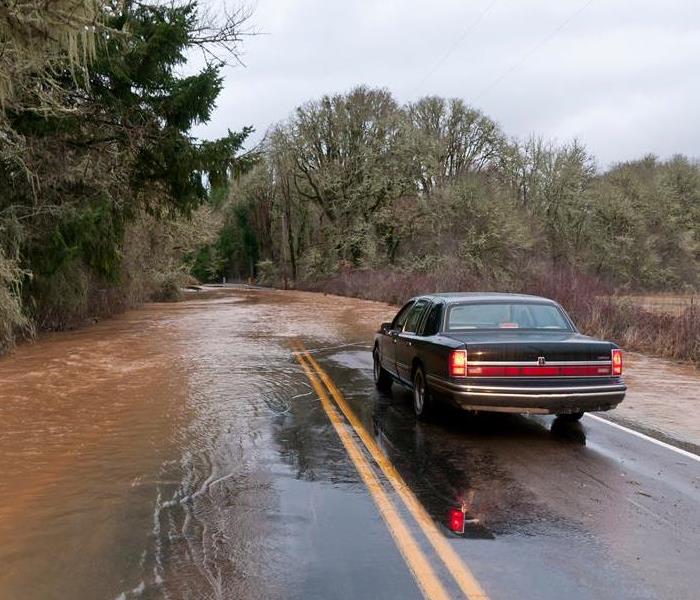 Don't do it! Stay Safe!
Don't do it! Stay Safe!
As severe spring weather begins to come into our region, it is wise to understand the importance of flash floods. A flood watch is issued when flooding is possible within the watch area. A flash flood is a rapid rise of water along a stream or low-lying area. They can be produced when slow-moving or multiple thunderstorms occur in the same place. A significant number of deaths occur due to flooding more than any other hazard related to thunderstorms. Accidents resulting in death commonly happen when vehicles are driven into hazardous floodwaters. It is essential to be aware of many of the possible hazards and precautions to take during a flood watch or warning, including:
- Gather emergency supplies, including food and water
- Listen to your local radio or TV station for updates
- Have immunization records handy
- Bring in outdoor possessions
- If advised to evacuate, do so immediately
- Only drive if necessary, since only two feet of water can float most vehicles
- Do not cross flowing streams where water is above your ankles
- Do not drive through a flooded road
- Do not camp or park your vehicle along streams or washes
- Do not drive around a barricade as they are there for your protection
- Be especially cautious at nights as it is harder to recognize
Let’s welcome Spring 2022 safely!
SERVPRO® of Charles County and SERVPRO® of Oxon Hill
(301) 753-8313
Knowledge is Key
1/31/2022 (Permalink)
 The more you know!
The more you know!
SERVPRO® of Charles County and SERVPRO® Oxon Hill works to support commercial and residential customers. Available 24 hours a day and 7 days a week, we are ready to support you whether your facility is a hospital, school, college, apartment complex, hotel, casino or home. Our knowledge and experience at SERVPRO® of Charles County and SERVPRO® Oxon Hill is over 35 years plus strong and we are only getting better and stronger.
Our Crew Chiefs and Technicians are trained on the latest and most up-to-date technology which helps us stay on top of our game and fully prepared to deliver quality service to you. We are constantly learning and improving our skills. There is so much to learn in this industry that our guys are constantly searching for new and more efficient ways to help improve our abilities to handle disasters. Additionally, we use the most recent equipment in order to provide the best for your property. No matter the size of your emergency, SERVPRO® of Charles County and SERVPRO® of Oxon Hill are here to help! What is better than having those that genuinely care, help you restore your home or business? We can be reached by calling (301) 753-8313 for water damage repair and restoration service.
Winter Warm and Cozy
12/20/2021 (Permalink)
 Snow Covered Homes
Snow Covered Homes
Although you may be all warm and fuzzy with thoughts of freshly fallen snow, a crackling fire and a warm mug of hot chocolate, damage that may come from a winter storm is infinitely less cozy. Storm and flood damage can be devastating and occur when you least expect it. Storm damage may include flooding from heavy rainfall, snow, freezing pipes or roof leaks from heavy wind and driven rains. Here are some steps to make your home more resistant during a storm:
- Protect potential wind and water entry points
- Make sure roof shingles are secure using roofing cement
- Make sure any openings or cracks by phone and cable lines are chalked up
- Install proper weighted shutters to cover your windows and doorways
- Invest in a heavy-duty garage
- Protect and secure your HVAC system
- Secure any loose item outside i.e., bikes and trashcans
But in the event your winter dreams of sugar plums fairies and candy canes turn into a personal version of the Grinch who stole Christmas, SERVPRO® of Charles County and SERVPRO® of Oxon Hill are here to help! We can be reached by calling on (301) 753-8313 for storm damage repair and restoration service.
Holiday Fire Safety Tips
12/20/2021 (Permalink)
 Beautiful Candlelight
Beautiful Candlelight
During the holiday season, warm wishes, family time and good cheer come to mind, however, there are a few precautions that should be remembered because no one wants a reenactment of the infamous National Lampoon’s Christmas Vacation.
Cooking
- In the U.S., most home fires and accidents are cause by unattended cooking.
- Anything that can catch fire must be kept away from the stove and it should be turned off when you leave the kitchen.
- At least three feet around the stove and hot food areas, create a “kid-free zone”.
Heaters
- Create a three feet zone for heating equipment such as furnaces, fireplaces, wood stoves and portable space heaters.
- Turn off portable heaters when leaving the room or going to sleep.
- Never use an oven to heat your home. This is very dangerous and can lead to an electrical fire.
Christmas Trees
- U.S. fire departments annually respond to an average of 160 structure fires caused by Christmas trees. 44% of these fires are caused by electrical problems, and one in five resulted from a heat source that’s too close to the tree.
- Three feet zone rule which suggests that fireplaces, space heaters, radiators, candles and heat vents or lights should be followed for trees as well. Make sure your tree is not blocking an exit.
- Before leaving the home or going to bed, always turn off Christmas tree lights.
Candles
- December is the high month for candle fires.
- Keep candles at least 12” away from anything that can burn, and blow candles out when you leave the room or go to bed.
- More than one third of home candle fires begin in the bedroom or in other areas where people may fall asleep.
Enjoy your holiday season safely!
SERVPRO® of Charles County and SERVPRO® of Oxon Hill
(301) 753-8313
Ahh Choo!
12/20/2021 (Permalink)
 Flu and Cold Season
Flu and Cold Season
As the COVID pandemic continues to wreak havoc, we at SERVPRO® of Charles County and SERVPRO® of Oxon Hill support your efforts to keep your business open and your employees safe. There are a few steps you can take to help keep your facility clean, sanitized and the viruses at bay.
Identify the frequently touched areas and regularly wipe them down
- Focus on tables, door handles, sinks, fridge/microwave handles and coffee pots
- Use disposable disinfectant wipes/paper towels
- Recommended to wipe down these areas three times a day
- Provide Hand sanitizer
- Remind employee to clean and sanitize their desks
- Invest in commercial cleaning services
- Remind employees to stay home or take a sick day if not feeling well
- Wash hands frequently
- Practice respiratory hygiene
SERVPRO® of Charles County and SERVPRO® of Oxon Hill are STILL Here to Help!
We are being called on by many businesses and community leaders to perform the necessary bioremediation services to clean, disinfect and sanitize their facilities. SERVPRO® uses EPA approved products and follows CDC guidelines for all cleanup practices. We have years of experience in dealing with biological contaminants and we will go beyond the scope of work that regular janitorial staff perform on a daily basis.
Many things have changed during these unprecedented times, but one thing remains the same. We are here to support our community and help get us back to normal as best we can.
Call today for your free Certified: SERVPRO® Cleaned evaluation today, (301) 753-8313.
Icicles
12/20/2021 (Permalink)
Water damage in your home or business is a tragic event. The causes of water damage vary from a pipe bursting, leaking appliances, sewer backups, and or an extreme storm. In these events many people have no clue what first steps to take in order to deal with this flowing problem. Some of the immediate steps to take after water damage in your home and business include:
- Turn off the power! If the water level reaches any electric sockets in the area, it creates a bigger hazard zone.
- Call your insurance company. Contact an adjuster to assess the damage and determine if it is a covered loss.
- Start water damage repair immediately. Mold can build up under wet surfaces within 24 hours.
- Once all standing water is removed from your home or business, the area must be dried out removing all humidity. Air movers and dehumidifiers can help dry damp areas.
- Determine what needs to be fully restored after water damage. Flooring and walls are typical a major concern in the restoration process.
We at SERVPRO® of Charles County and SERVPRO® of Oxon Hill are here to safely ensure the water damage removal process is done thoroughly and correctly. Give us a call at (301) 753-8313.
Thank you to the Fire Fighters!
10/19/2021 (Permalink)
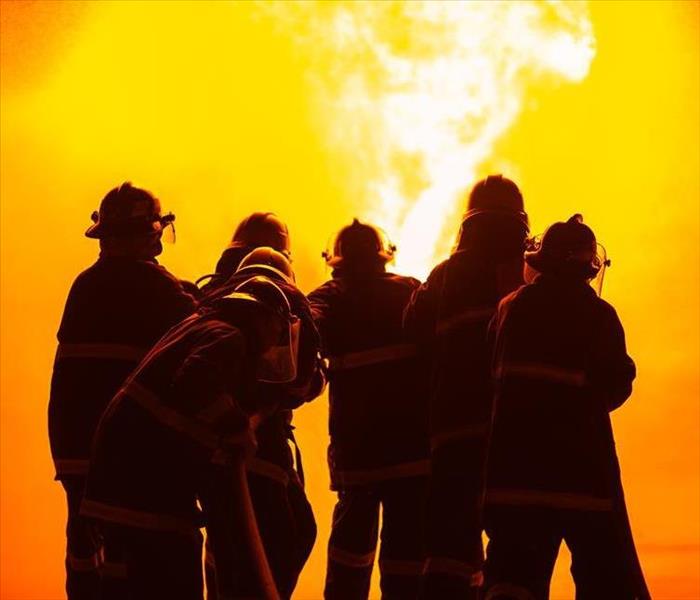 Fearless Firefighters
Fearless Firefighters
October is not only fire prevention month, but it is also a time to honor those strong firefighters that took an oath to protect our communities. The National Fallen Firefighter Foundation was honored to announce their 40th Annual National Fallen Firefighters Memorial during the first weekend of October 2-3, 2021. The memorial service honored the names of 215 firefighter who are now a permanent part of the National Memorial in honor of their sacrifices. Many landmarks and fire departments far and wide across the United States were lit up red to honor our fallen firefighters.
The National Fallen Fire Fighter Foundation is also very dedicated in providing families of the fallen firefighters with important resources, programs, and support as they face a long and difficult journey. Some of the resources and programs include scholarships, wellness conferences, and a remembrance program. We at SERVPRO® of Charles County and SERVPRO® of Oxon Hill salute our firefighters and thank them for their service.
When the Storms Come...
10/19/2021 (Permalink)
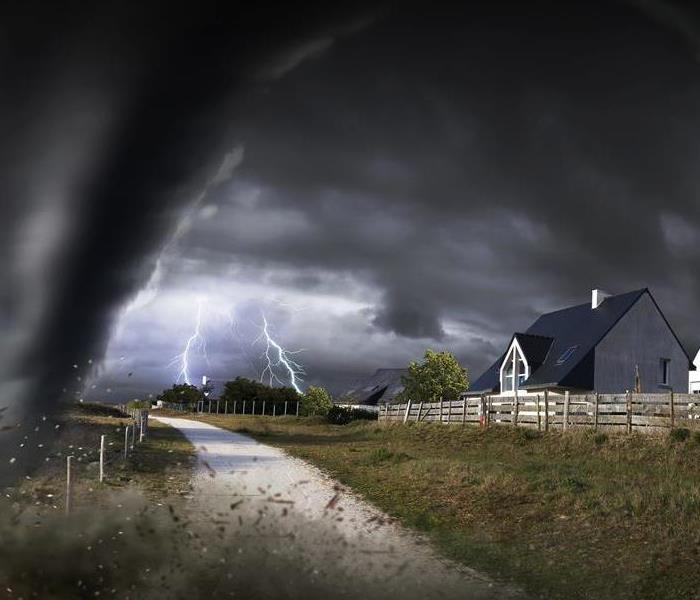 Stormy Weather
Stormy Weather
Storm and flood damage can be devastating and occur when you least expect it. Storm damage encounters may include flooding from heavy rainfall or roof leaks from heavy wind-driven rain. Here are some useful measures you can do to make your home more resistant during a storm:
- Protect potential wind and water entry points
- Make sure roof shingles are secure using roofing cement
- Make sure any openings or cracks by phone and cable lines are chalked up
- Install proper weighted shutters to cover your windows and doorways
- Protect and secure your HVAC system
- Secure any loose item outside, i.e. bikes and trashcans
After the Storm, SERVPRO® of Charles County and SERVPRO® of Oxon Hill are here to support you! Call SERVPRO® of Charles County, 301.753.8313 or SERVPRO® of Oxon Hill, 301.292.4447. We provide free visual inspections, and we will guide you through the claim, cleanup and reconstruction processes as necessary. We are Here to Help!
Every Business is Unique
10/19/2021 (Permalink)
Owning a business is a considerable investment. The saying “it takes a village” could not be more accurate. That is why it is essential to hire someone you can trust who provides excellent service and can perform critical restoration tasks without interfering with the business itself. Just like every person is different, every business is different and has unique needs. We will cater to each of your needs to ensure all services requested are completed not only promptly but in a way that makes sense for you and your business. Our technicians at SERVPRO of Charles County and SERVPRO of Oxon Hill are trained to mitigate the damage quickly and manage the restoration process. No matter the size of your emergency, SERVPRO® of Charles County and SERVPRO® of Oxon Hill are here to help! We can be reached by calling on (301) 753-8313 for water damage repair and restoration service.
Smoke and Soot
10/19/2021 (Permalink)
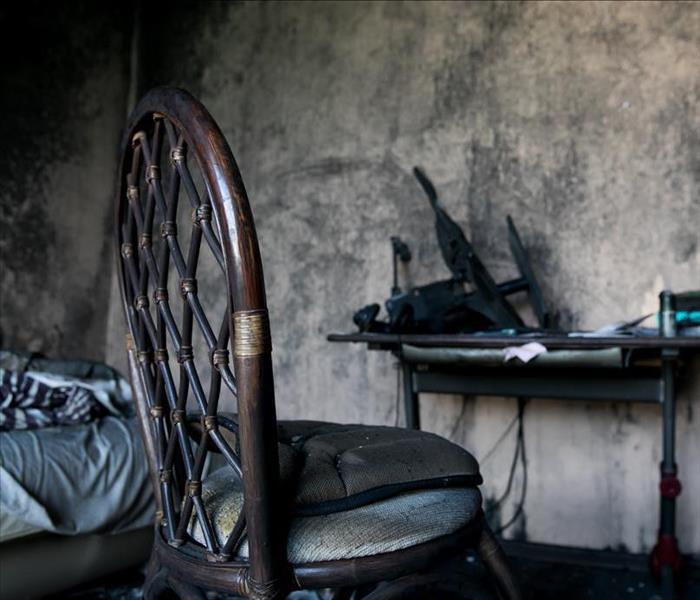 Smoke and soot covering everything.
Smoke and soot covering everything.
An unexpected fire in your commercial property can cause damage for which you are completely unprepared. Along with the structural damage, fire damage leaves a mark on your heart as well. The soot, odor, damage of belongings and water damage are some of the effects in the aftermath of a fire. Soot can cover almost every inch of your business. Smoke can seep into walls, air ducts and surfaces. Unseen odors may be everywhere. However, SERVPRO® of Charles County and SERVPRO® of Oxon Hill’s fire damage restoration process can reverse this damage and make it "Like it never even happened."
Burned equipment and fried possessions after a fire, are just the damages visible on the surface. Even after the flames have been put out and the smoke has cleared, your business is still in trouble. Smoke and soot are highly acidic and can damage a wide range of materials they come in contact with. The unexpected amount of smoke damage can easily devastate any business owner. That's why it's important to call SERVPRO® of Charles County and SERVPRO® of Oxon Hill at (301) 753-8313 to restore your building to a clean, healthy, and safe condition for yourself and your employees. We are always Here to Help!
Fire Prevention Month
10/15/2021 (Permalink)
October is fire prevention month. The overall goal of fire prevention month is to raise fire safety awareness and help ensure your home and family are protected. Fire prevention month was established in 1922 by The National Fire Protection Association (NFPA). NFPA along your local firemen celebrate fire prevention month by raising fire safety awareness and educating communities, families, students, and encouraging everyone to practice fire prevention and keep their home and families safe.
The NFPA campaign theme for 2021 Fire Prevention Month is “Learn the Sounds of Fire Safety”. With so many devices in our homes today from safety systems to personal electronics, it is important to be able to distinguish the difference between a potential emergency or push notification. Smoke alarms when triggered make a continuous beeping sound to alert those around of smoke coming from a potential fire. Smoke alarms may also make a chirping noise indicating that the batteries need to be changed. If the alarms continue to chirp after a battery change it may be time to fully replace the smoke alarm with a new one.
SERVPRO® of Charles County and SERVPRO® of Oxon Hill join with the NFPA and firefighters to celebrate National Fire Prevention month and all efforts to keep our community safe!
When the Water Rises...
10/15/2021 (Permalink)
During these seasonal changes we tend to see more wet weather and heavy winds. These factors cam have an adverse effect on your home. Here are some of the ways to detect signs of water damage if they occur in your home.
- Listen for leaks or constant water flow around your home.
- Be mindful of your water bill, note any high fluctuation.
- Look out for cracks in the wall that may spread or seem to have movement.
- Be aware of a distinct, musty order, mold may be present.
- Look for dark spots or white patterns that may differ from the flooring, roof, & base boards.
- If you have hardwood flooring, be aware of any buckling or lifted nails from the floorboard.
- Be mindful of pooling water or puddles that may appear in random areas of your home.
No matter the size of your emergency, SERVPRO® of Charles County and SERVPRO® of Oxon Hill are here to help! We can be reached by calling on (301) 753-8313 for water damage repair and restoration service.
Be Prepared
8/4/2021 (Permalink)
Did you know that nearly 4,000 Americans die each year in house fires and over 2,000 are severely injured? Having a working smoke detector more than doubles one’s chances of surviving a fire.
The most vulnerable people in fires are the elderly and young. That is why it is so important to teach your children fire safety by creating evacuation plans in the event a fire should occur. They should learn how to exit safely in the event of a fire and basic movements, i.e. stay low, stop drop and roll, etc.
Fire produces gases and fumes that can make you sleepy, weak, and confused. You may not smell these fumes and they won’t wake you, but a smoke alarm will. That is why it is so important to have smoke detectors that work within your home, ideally just outside areas where you sleep. Following a few basic precautions and having a plan may save your life. Be safe!
Storms and Fear
8/4/2021 (Permalink)
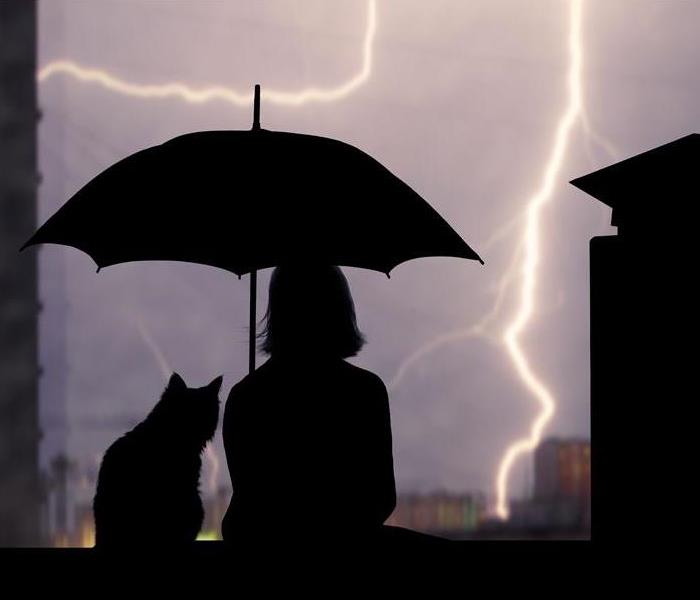 Some animals fear storms
Some animals fear storms
Storms come in all shapes and sizes. The one that comes to mind the most often are thunderstorms. However, tropical, lightning, flood, snow, ice and hurricane are just another few types of storms that exist. Some are scarier than others, and some are more of a nuisance than anything.
Did you know that tropical storms are given names before hurricane season begins? They have to get pre-approved by the World Meteorological Organization and can be repeated after six years. If there is a storm that causes major destruction, that name is retired permanently and replaced with a different one.
Astraphobia is the extreme fear of thunder and lightning. While children and adults suffer from this fear, animals do as well. This causes them to run and hide or howl. Did you know that often times, pets can sense a storm coming before we can? That could be why it always seems quiet outside before a storm hits, pets are busy looking for shelter and a place to hide. Your pet may hide under blankets, pace a lot, tremble or pant when a storm is either coming or already happening. Be fearless knowing that no matter the type of storm, SERVPRO® of Charles County and SERVPRO® of Oxon Hill are here to help!
Fun Facts About Water!
8/4/2021 (Permalink)
 The Worlds Water
The Worlds Water
Enjoy these fun facts about water!
- Did you know that the water from your faucet could contain molecules that dinosaurs drank?
- 97% of the world’s water is salty or otherwise undrinkable, 2% is locked in ice caps and glaciers. This leaves just 1% for all humanity’s needs.
- A person can live 1 month without food, but only one week without water.
- 70% of the human brain is made up of water.
- Drinking too much water can be fatal.
- Water covers about 71% of Earth’s surface.
- 85% of the world’s population lives in the driest half of the planet.
- Water is less dense as a solid than it is as a liquid which is why ice floats.
As much as we love water, its not so much fun when it floods and damages our homes. As always, SERVPRO of Charles County and SERVPRO of Oxon Hill professionals are here to help!
When the Unexpected Occurs
8/4/2021 (Permalink)
When the unexpected and inexplicable occur, SERVPRO is here to help! The tragedy of a crime in a home or business can be painful and traumatic, and we are dedicated to helping families and communities. Your property, home, or business may be affected by blood, body fluids, and sometimes other damage. We are available to compassionately, quickly, and discretely provide thorough cleanup services. The decontamination of a home or business due to trauma, sewage backups, chemical spills, hoarding, or other biohazards can be both dangerous and emotional. Bioremediation is the removal, cleaning, and disinfection of blood, bodily fluids and other pathogens requiring specialty training, equipment, certification and licensing. Our technicians follow OSHA and EPA protocols to help transform an unsafe environment back into a clean, safe home or business. Our focus is always safety first. SERVPRO of CHARLES COUNTY and SERVPRO of OXON HILL are available 24 hours a day, 7 days a week, 365 days a year! We can be reached by calling (301) 753-8313.
Home Fire Safety
7/28/2021 (Permalink)
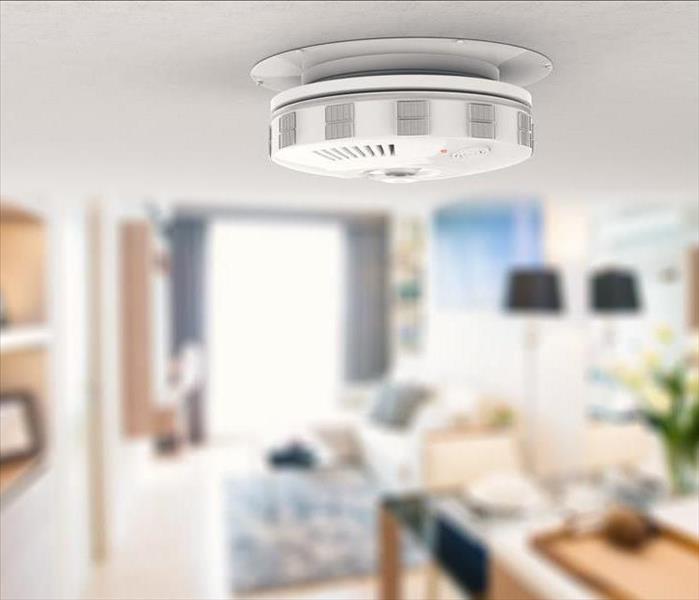 Smoke Detectors Save Lives
Smoke Detectors Save Lives
We have all experienced that annoying beeping noise that you can’t seem to locate in your home no matter how hard you search. You instinctively know that it is the smoke alarm, but for all of your efforts, you can’t pinpoint which one is going off. Well, instead of pulling out the batteries from all of them in frustration, use this time to refresh and replace the batteries for each. This will make sure that all of your smoke detectors are good to go.
This is so important because the Federal Emergency Management Agency, National Fire Academy state that “Three out of five home fire deaths result from fires in properties without working smoke alarms.”*
Additionally, they recommend the following steps:
- Choose interconnected alarms, so when one sounds off, they all do.
- Put smoke alarms outside of each sleeping area and every level of your home.
- Test them and make sure they work.
- Replace the batteries at least annually
- Replace smoke detectors every 10 years
- If you hear the alarm, you may have less than 2 minutes to get out
- Practice fire drills with your family
We hope you have a safe and enjoyable summer and as always, We are Here to Help!
Storm Variety
7/4/2021 (Permalink)
Understanding Common Types of Storm Scenarios
Storms can be sometimes, really frightening and dangerous. Once the disaster is passed, call the professionals from SERVPRO® of Charles County and SERVPRO® of Oxon Hill to assess your property and start the repair and restoration process. Here are some common storm scenarios that you should be aware of:
Hail Damage: Dents and bents are common during a hailstorm, but deeper damage may not be visible. In this case, take an expert opinion as hailstorm damage can lead to serious roof leaks causing structural issues.
Lightning and Thunderstorm Damage: Electrical Damage can be a life-threatening during lightning and thunderstorms. Stay indoors till the storm is over and once it has passed, give us a call at SERVPRO® of Charles County and SERVPRO® of Oxon Hill.
Storm-related flood Damage: Flooding can have a serious impact on your property. River floods, flash floods, coastal floods and storm surges can destroy your home. It is recommended to keep a track of weather reports and stay alert in certain situations.
Please call us at SERVPRO® of Charles County and SERVPRO® of Oxon Hill by calling (301) 753-8313 for storm damage repair and restoration service. We are Here to Help!
Storm Tips
5/29/2021 (Permalink)
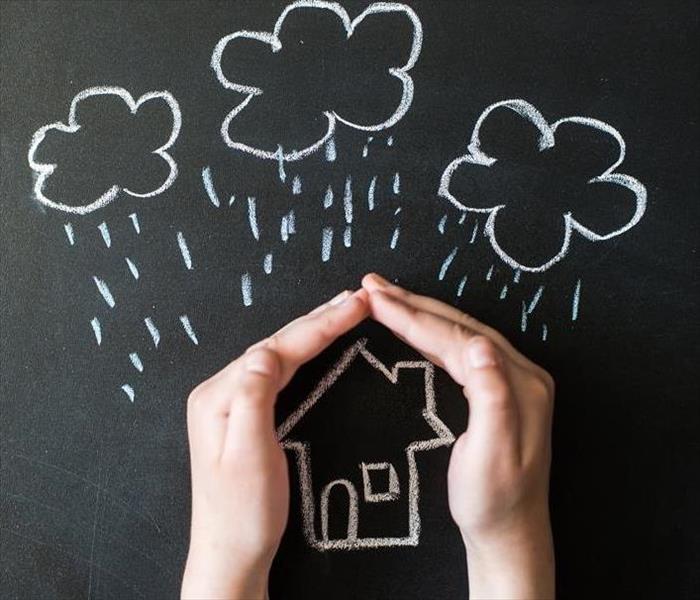 We are Here to Help!
We are Here to Help!
Did you know that in the United States alone, an estimated 100,000 thunderstorms occur each year? Not only do thunderstorms produce rain, thunder, and lightning, they can also produce high winds, heavy rain, and flooding. The safest place to be during a thunderstorm is inside.
That is why it is so important to properly prepare your home for all the unexpected things that can happen when a storm comes your way. We at SERVPRO are here to help you prepare you and your home and help you after a storm has come through. Here are some helpful tips to prepare your home before a storm comes:
- Trim the trees in your surrounding area
- Buy a backup generator
- Install storm shutters
- Check your insurance to ensure flood coverage is available
- Flood-proof your home
- Have an expert check your home for any weak areas
- Protect your belongings – elevate all critical items in your home to ensure they do not get damaged due to flooding.
If your home sustains damage as a result of a storm, contact SERVPRO at 301-753-8313 because we are here to help!
SERVPRO Helping Friends and Neighbors
5/24/2021 (Permalink)
 We are here to help!
We are here to help!
No one can prepare for the stress that fire, smoke, water, or mold damage in your home or place of business can cause. Feeling confused, violated, upset, and unsure of how to move forward and fix the situation can be very daunting.
Here at SERVPRO of Charles County and SERVPRO of Oxon Hill, we have trained IICRC (Institute of Inspection Cleaning and Restoration Certification) experts who receive continued training throughout their employment and provide 24-hour services. We know how hard this can be for you; we know how frustrating and confusing this situation is for you. That is why we at SERVPRO believe in treating all our customers like family. There is no better feeling than knowing we are helping our friends and neighbors get back on their feet, restore their homes and businesses. What is better than having those that genuinely care help you restore your home or business? Contact SERVPRO at 301-753-8313.
SERVPRO Supports All Businesses
5/24/2021 (Permalink)
 We support all types of businesses!
We support all types of businesses!
Owning a business is a huge investment. The saying “it takes a village” could not be more accurate. That is why it is so essential to hire someone you can trust, who provides excellent service and can perform daily tasks without interfering with the business itself. Just like every person is different, every business is different and has different needs. We will cater to each of your needs to ensure all services requested are done not only in a timely manner but in a way that works for you and your business.
Especially with the ongoing COVID-19 pandemic, it is so important that work areas are sanitized regularly. Our crew at SERVPRO are trained to provide the day-to-day tasks at your business as well as assist when the unexpected occurs. Whether it is cleaning/maintaining, fire or water damage restoration, sanitization, etc. you need someone you can trust and SERVPRO is here to help!
No Matter the Size
5/24/2021 (Permalink)
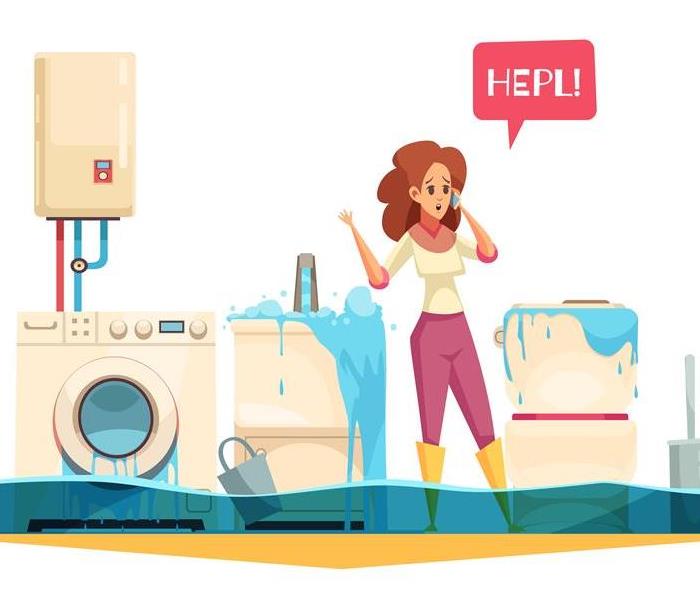 Water damage from anywhere... we can help!!
Water damage from anywhere... we can help!!
When people think of water damage, they usually imagine flooding due to a storm. But what a lot of people do not realize is that flooding in your home can come from something as simple as leaving the faucet or bathtub running, your dishwasher flooding, or your washer or toilet overflowing.
Water damage is not only a hassle, but it can also cause a domino effect and create even more problems within your home. These include but are not limited to:
- Hazardous health conditions
- Mold
- Roof damage
- Foundation damage
- Electric and plumbing issues
- Home value
When it comes to water damage, time is of the essence. If you currently have damage to your home, no matter the size, please contact us and one of our highly trained experts will come to your house and assist. We at SERVPRO provide 24-hour service. Please contact us at 301-753-8313.
April Showers Bring May Flowers
4/13/2021 (Permalink)
 Enjoy the flowers and leave the showers to the professionals!
Enjoy the flowers and leave the showers to the professionals!
April showers may also result in a variety of different types of water damages. Freezing and thawing pipes as the weather tries to make up its mind, torrential spring storms, clogged gutters, or overflowing downspouts may cause various types of water damage. Flood and water damage are quite common in the U.S., with more than 83 percent of water hazards resulting from flash floods. We all fear water disaster as it creates havoc and gives rise to several other problems such as mold or structural damage.
SERVPRO of Charles County and SERVPRO of Oxon Hill understand the importance of keeping your business's doors open! We respond quickly to mitigate the damage and manage the restoration process with experienced, trained, and certified technicians. No matter the size of your emergency, SERVPRO® of Charles County and SERVPRO® of Oxon Hill are here to help! We can be reached by calling on (301) 753-8313 for water damage repair and restoration service.
Dirty Duct Cleaning!
4/13/2021 (Permalink)
The spring is a time to refresh, reinvigorate and renew. Is your home ready for the spring season? Now is the perfect time of year for air duct cleaning. Spring is when we tend to focus on a clean house, but what if it is not as clean as you imagine. Air ducts can collect a lot of dust, dirt, and allergens that are not visible. As air conditioners draw in outside air, they may also pull contaminants. Duct cleaning is a complicated job and SERVPRO has professional technicians with specific knowledge to do a thorough job. Some indicators that you should have your ducts cleaned include:
- In an annual service of your air conditioning system, if mold is detected, then you should have your ducts cleaned.
- If your home has been newly renovated home, then your ducts should be cleaned from the dust and dirt that may have resulted from the construction
- If your home is still dusty despite cleaning, take a look at the supply and return vents and if they look dirty, it may be time to schedule a duct cleaning.
- Every year your heating and cooling costs should be predictable and similar to the previous year. However, if those costs have increased then you should schedule a duct cleaning.
At SERVPRO of Charles County and SERVPRO of Oxon Hill, our professionals will be able to help you with keeping your air ducts clean. Feel free to contact us for more information about our services today!
Should You Worry About Kitchen Fires?
4/5/2021 (Permalink)
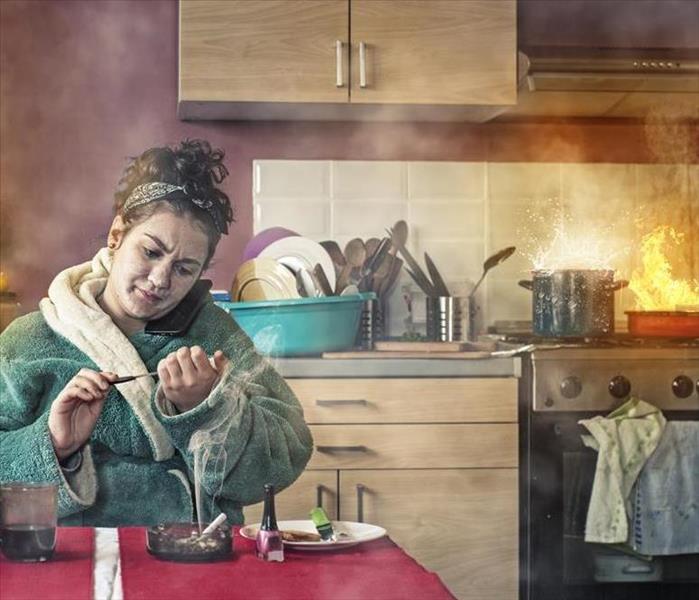 Unattended Kitchen Fire
Unattended Kitchen Fire
According to the National Fire Protection Association (NFPA), cooking accidents resulting in fires are the #1 reason for house fires in the US. It is estimated that around 189,300 home structure fires started each year due to cooking between 2016 and 2018. The leading cause of fires in the kitchen is unattended cooking.
It is more than clear by the above mentioned that Kitchen Fires are not to be taken lightly. Safety tips recommended to prevent a Kitchen fire are:
- Don’t leave your pan. If you have to leave the kitchen, turn the burner off.
- Pay attention. Fires start when heat is too high. If you see smoke, turn the burner off.
- Pot handles should be turned toward the back of the stove so that no one can bump them or pull them over.
- Make sure flammables are away from cooktop. Keep oven mitts, wooden utensils, food packaging, towels or curtains away.
- Keep a pan lid or baking sheet nearby because you can use it to cover the pan if it catches on fire which will put out the fire.
In the event of a kitchen fire:
- Just get out! When you leave, close the door behind you to help contain the fire.
- Call 9-1-1 after you leave.
- If you try to fight the fire, be sure others are getting out and you have a clear way out.
Lastly, if you need help because of fire damage, SERVPRO® of Charles County and SERVPRO® of Oxon Hill are here to help 24 x 7 at (301) 753-8313.
Thunderstorms 101
4/5/2021 (Permalink)
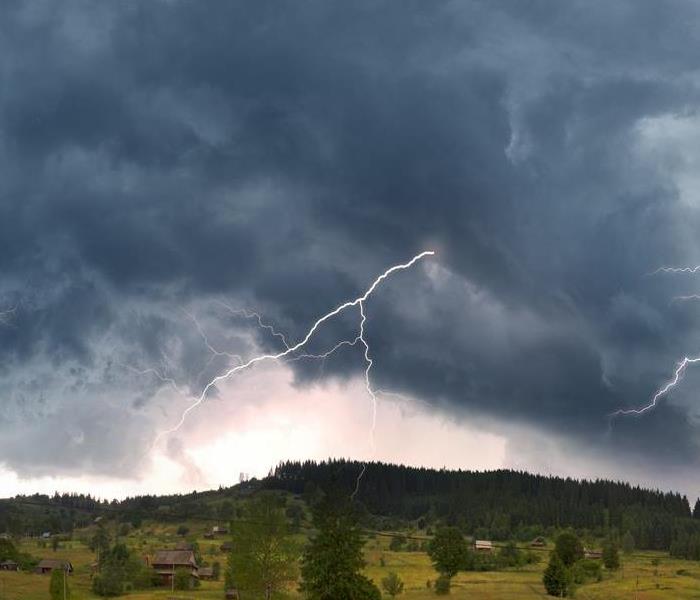 Raging Storms
Raging Storms
A rain shower in which you hear thunder is a thunderstorm. All thunderstorms have lightning since thunder comes from lightning. A “severe” thunderstorm is one which contains one or more of the following: hail one inch or greater, winds gusting in excess of 57.5 mph, or a tornado. Spring and summer months are when thunderstorms are most likely to occur during the afternoon and evening hours.
Many hazardous weather events are associated with thunderstorms. Under certain conditions, thunderstorm rainfall may cause flash flooding, killing more people each year than hurricanes, tornadoes or lightning. Fires started from lightning cause fatalities. These storms may produce hail up to the size of softballs which can do a lot of damage. Strong winds associated with thunderstorms can knock down trees, power lines and mobile homes.
A Severe Thunderstorm WATCH is issued by the NOAA Storm Prediction Center meteorologists who are watching the weather 24/7 across the entire U.S. for weather conditions that are favorable for severe thunderstorms. In the case of a Watch, be prepared for more severe weather.
A Severe Thunderstorm WARNING is issued by your local NOAA National Weather Service Forecast Office meteorologists who watch a designated area 24/7 for severe weather that has been reported by spotters or indicated by radar. Warnings mean there is a serious threat to life and property to those in the path of the storm. In the case of a warning, act immediately to find safe shelter!
If your home or business is damaged by a storm, our professionals at SERVPRO® of Charles County and SERVPRO® of Oxon Hill are here to help 24 x 7 at (301) 753-8313.
Top Causes of Water Damage
4/5/2021 (Permalink)
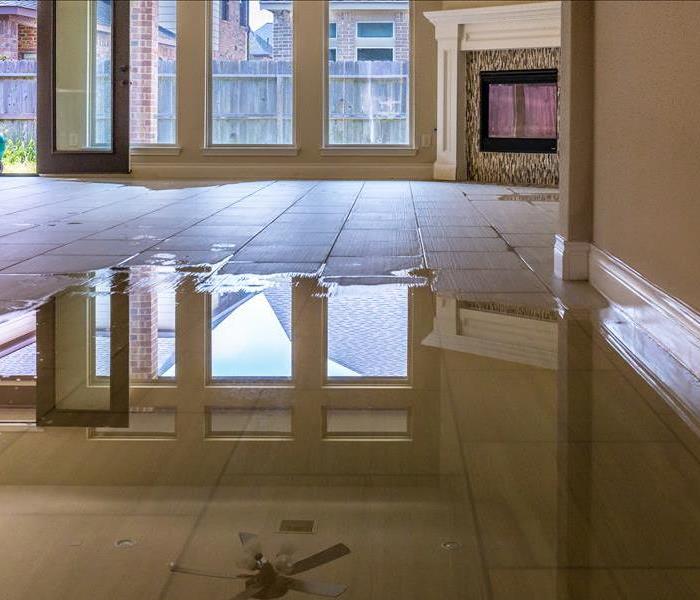 Water Damage
Water Damage
Water damage can substantially affect buildings wherein water creeps into the areas of a property discoloring walls and adding moisture. This moisture can lead to the formation of mold causing excessive damage. Without water damage repair and restoration, all this can weaken the structure of the building. Below are some common causes that can cause water damage in the property:
Plumbing Issues: Plumbing issues are quite common in every property; therefore, it is essential to inspect the plumbing systems once a year to fix hoses, pipe joints and drain pipes.
Severe Weather/Natural Di: Natural disasters such as thunderstorms, hurricanes and snowstorms can cause excessive damage to your property. Strong winds and heavy downpour can damage your roof letting rainwater enter your home.
Clogged Drains: Clogged drains are quite common in the residential and corporate areas. Bathroom or sink drains can get clogged with dirt, hair or other substances. This can case pipe damage as well as structural damage. If left untreated, this can damage to other places in the home.
Structural Damage: Moisture creeping in the walls of your home can cause mold formation and rotting.
SERVPRO® of Charles County and SERVPRO® of Oxon Hill are here to help! We can be reached by calling on (301) 753-8313 for water damage repair and restoration service.
Help... Mold!
3/24/2021 (Permalink)
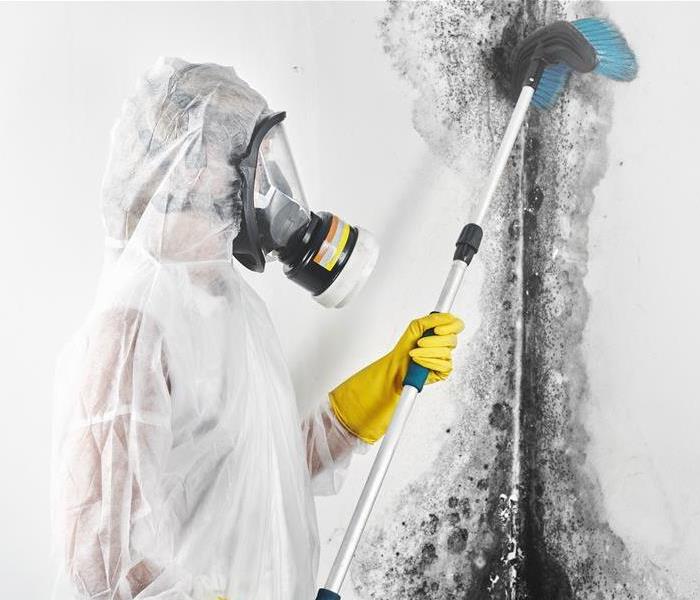 Expert Mold Remediation
Expert Mold Remediation
Mold is one such thing that can grow unnoticed; sometimes it is visible and sometimes, hidden inside the walls/tiles, and can devastate your property without warning. Besides affecting your property, it can have effects on your health as well. With the winter thaw and the start of spring, it is important to be on the lookout for any signs of water intrusion or water leakage which can result in mold. Mold is tiny and everywhere, thrives on moisture and often smells. Mold spreads quickly and can impact your property and personal belongings, and thus, mold remediation becomes essential.
Why SERVPRO® of Charles County and SERVPRO® of Oxon Hill?
- We are faster to any size disaster and we start the remediation process immediately after you contact us.
- We are highly trained and certified and have invested in the proper equipment and tools to restore your home quickly and efficiently.
- We are experts in repairing the contaminated space.
These professional services are available for commercial mold remediation as well. SERVPRO® of Charles County and SERVPRO® of Oxon Hill are here to help 24 x 7 at (301) 753-8313. Our experts inspect, assess and remediate the mold with specialized equipment and many years of expertise and knowledge.
Spring has Sprung!
3/22/2021 (Permalink)
 Happy Spring Cleaning!
Happy Spring Cleaning!
Birds are chirping and flowers are blooming! Spring cleaning is a tradition that allows us to revitalize and spruce up our living and working spaces, although with this year of COVID, the two have in many cases become one and the same. We are looking forward to the excitement of spring and summer and the chance to make wonderful new, positive, healthy and happy memories.
A healthy environment is as critical in your office workspace as it is in your home. It is important to keep your office space clean and well-maintained. Currently, sanitization and professional cleaning have become a primary necessity for all office spaces. We at SERVPRO are here to help you keep your customers and employees safe, and let everyone know you've chosen a higher standard of clean.
As a professional office cleaning Service, we have the right tools, equipment and expertise in cleaning offices. We can save a lot of time and effort, allowing you to focus on the necessities of your business.
Good spring cleaning keeps everyone happy with their working conditions, and makes your work environment professional and inviting. SERVPRO of Charles County and SERVPRO of Oxon Hill can be relied on to make your workspace look its very best, just give us a call at 301-753-8313.
We Got Your Back!
3/19/2021 (Permalink)
 Proud to Serve our Community
Proud to Serve our Community
After storm damage, it is necessary to begin the restoration process as soon as possible. Analyzing the damage on your own may result in many unnoticed areas that can cause havoc later or lead to more extensive damage to your property. Therefore, hire a professional storm damage restoration company like SERVPRO® of Charles County or SERVPRO® of Oxon Hill, and we will take care of everything, from analyzing, to repair and restoration, leaving your home "Like it never even happened."
So here is why you should opt for our professional storm damage restoration company:
- Locally Grown Company: You know us. We have been servicing Charles County and Oxon Hill for over 30 years. We have grown exponentially and continue to do so year after year. Here at SERVPRO® we are a family, and we attempt to make every customer that we meet feel that they are part of ours. We understand the stress and disruption that happens with fire or water damage and we do our best to provide comfort and peace of mind during those times.
- Services on Time: The sooner you connect with us, the less loss you will bear. We are available for emergency services around the clock and are at your service as soon as you reach out to us for help.
- High-Quality Process and Highly Trained Staff: Hiring a trained professional company for storm damage restoration will help you reduce the restoration cost. We begin with an assessment, provide the restoration and clean-up. The restoration process will be thorough, timely, and to your complete satisfaction.
- Insurance Claim Handling: We are experts in handling insurance matters. If you have no experience in filing insurance claims, then we can help you. Proper filing ensures maximum benefit as we provide you with adequate and comprehensive proof of damage.
You may not often need us, but we are here and happy to help when you do! There is no greater satisfaction than knowing you are helping your community not only with their homes but with their schools and businesses.
How to choose a commercial cleaning service?
3/11/2021 (Permalink)
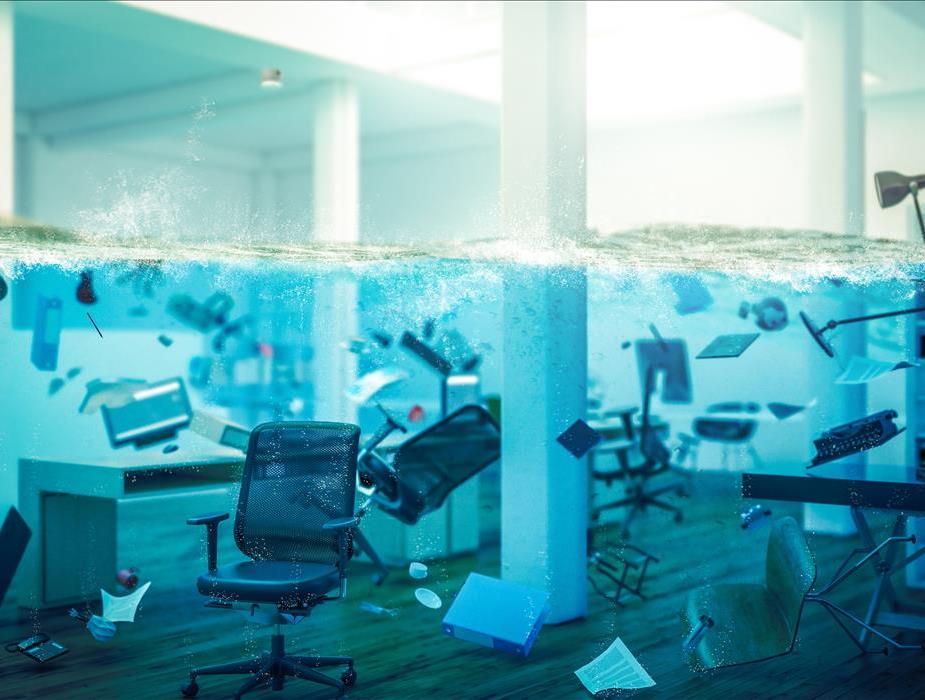 SERVPRO can make it like it NEVER happened!
SERVPRO can make it like it NEVER happened!
Choosing a professional as well as commercial cleaning service is not such a daunting task as we think of it. You just need to choose the right one for you. A cleaning service provider that is highly reputable and protects your assets can be a perfect choice. You need to narrow down your search as per the following parameters:
- A Professional Commercial Cleaning Services Company will inform you about the process of hiring, products they use and the formal training process that their employees have gone through.
- Check for the proof of insurance of the company. It is quite necessary for today’s scenario so that any loss can be recovered.
- While searching for a cleaning services company, you should consider the experience of a company. With years of experience, companies develop a system for cleaning and know the art of handling cleaning equipment.
- Check if the company has any references and positive feedback. A quality company will be able to provide you with positive feedback from its clients. You can also choose to contact the references and ask about their experience. This will help you choose a better commercial cleaning service.
SERVPRO of Charles County and SERVPRO of Oxon Hill is available 24 hours a day to restore your property and get you back to business.
What happens if your Sump Pump fails?
2/26/2021 (Permalink)
These days, sump pumps have almost become a must for houses constructed below the basement's main surface. In the event of a serious storm, a sump pump sends accumulated water out of your basement, thus, preventing flood and water damage. Once the water begins to accumulate, it may cause wood to warp, rot and allow mold to grow.
It should be clear to everyone that sump pumps can also fail at times, or become overwhelmed in a severe storm. As such, it is always advised to check your sump pump's functionality regularly. They can fail due to age, lack of water while still running, debris or a serious clog or the loss of power.
If your sump pump fails,
- Immediately check whether the sump pump is defective or functioning.
- In case the pump has failed, remove any debris if it's clogged.
- Do not step into the water without ensuring the electricity is turned off.
If you experience flood or water related issue call SERVPRO® of Charles County or SERVPRO® of Oxon Hill and let us walk you through the process. We provide free visual inspections, and we will guide you through the claim, cleanup and reconstruction processes as necessary. We are always Here to Help!
SERVPRO® of Charles County
(301) 753-8313
Serving Our Community-Children's Aid Society
1/12/2021 (Permalink)
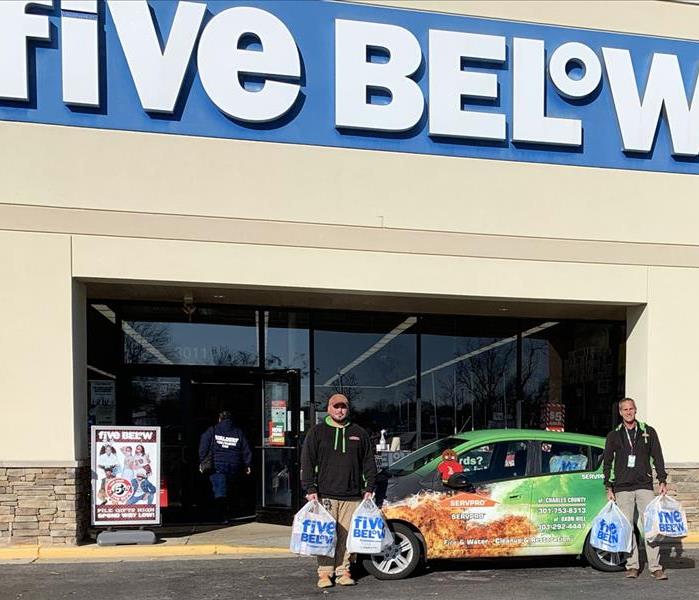 Toys for the Children purchased from community partner Five Below
Toys for the Children purchased from community partner Five Below
During this horrible pandemic and its associated restrictions, SERVPRO® of Charles County and SERVPRO® of Oxon Hill remembers that it is vitally important that we do not stop helping each other in this time of need. We can make a difference as individuals, families and communities. We are fortunate enough to work, live and SERV our communities, so we give back as well. In mid-December, we were able to provide a plethora of toys to the Charles County Children’s Aid Society, Inc.
The Charles County Children’s Aid Society was founded in 1934 by a group of compassionate women who recognized that some of their neighbors were having difficulty feeding and clothing their children. The “society’s” initial goal was to ensure that the basic life necessities of local families were met. However, as time progressed the group realized that they were unable to provide independently for the less fortunate, and in 1957, the Children’s Aid Society became a 501(c)(3) non-profit human service agency. CCCAS has continually evolved to address the needs of the current community.
Here at SERVPRO®, we find it very important to be involved in our communities beyond doing business, and we are proud to be able to support them in their mission.
The COVID Effect
11/27/2020 (Permalink)
The Novel Coronavirus pandemic has changed society more than we could have ever imagined. The COVID-19 pandemic changed our communities, workplaces, families and even our simple daily routines. The term "social distancing" has become a normal part of our vocabulary and face masks have become a fashion accessory. Businesses and social interactions have changed dramatically and even the interactions between family members have changed. Before COVID-19 I would check on my grandparents at least every other day making sure they were ok and had everything they needed. Now I call and make sure they are ok and if they need anything, I will leave it on their porch. Now I get to interact with my grandparents once a week if I am lucky. With my grandfather's weakened immune system I cannot be too careful when being around him.
Now with flu season 2020 here and historically peaking between December and February there will be even more cause for extreme caution and concern. As communities have begun to reopen and face this pandemic head on there are so many questions that we have as a community. Is it safe? When will we have treatment for this virus? Will the treatments be safe? Will there be adverse reactions? Will we get back to normal as we know it?
These questions have no real answer, but we want you to know SERVPRO® of Charles County and SERVPRO® of Oxon Hill are STILL Here to Help!
We are being called on by many businesses and community leaders to perform the necessary bioremediation services to clean, disinfect and sanitize their facilities. SERVPRO® uses EPA approved products and follows CDC guidelines for all cleanup practices. We have years of experience in dealing with biological contaminants and we will go beyond the scope of work that regular janitorial staff perform on a daily basis.
Many things have changed during these unprecedented times, but one thing remains the same. We are here to support our community and help get us back to normal as best we can.
Call today for your free Certified: SERVPRO® Cleaned evaluation today, (301) 753-8313 or (301) 292-4447 and as always you can email me directly, HERE.
Stay Safe from Hurricanes!
11/19/2020 (Permalink)
This has been an unusual Hurricane season for Maryland and it is not over yet. While Hurricanes may not be as common as other disasters, it is still essential for you to learn how to act against this disaster.
A Hurricane holds the potential to expand its reach to hundreds of kilometers in a few minutes! During a Hurricane, consider doing the following:
- Keep your emergency kit close with you.
- Keep listening to the radio for further updates.
- Unplug appliances and turn off the electricity.
- Watch for water entering the home.
- Follow guidance of any emergency personnel.
Do not go outside of the house in case of a Hurricane. Stay inside the house with your family. If possible, shift your whole family to the most substantial part of the house.
After the Storm, SERVPRO® of Charles County and SERVPRO® of Oxon Hill are here to support you! Call SERVPRO® of Charles County, 301.753.8313 or SERVPRO® of Oxon Hill, 301.292.4447. We provide free visual inspections, and we will guide you through the claim, cleanup and reconstruction processes as necessary.
Stay Safe!
Signs there could be a water damage in your home
11/12/2020 (Permalink)
People often assume that the term “Water Damage” is going to mean gallons of water running through their home or several inches of standing water. That is not always the case. Sometimes it can be as common as an overflowed toilet or as simple as the kids splashing too much water out of the bathtub while playing. Water is a very sneaky thing, and you could have a water damage occur and not realize it until there is bigger issue!
Here are 5 signs that could mean you have a water damage.
If you see dark or wet spots on your ceiling, walls or exterior, INVESTIGATE. This could mean there is or has been water damage.
- Ceiling, Walls, and Floor structure
If water has reached these surfaces from inside you will notice the structure of these areas change. Your ceiling and drywall could begin to bubble, crack or flake. Your flooring can become soft and even begin to buckle. These are normally signs of water damage.
Have you noticed the sound of running water that is outside of the normal? This could be a sign of water damage. If you hear dripping, running water or even notice a new floor creak it is important to investigate.
Have you noticed a spike in your water bill? This spike could be caused by a hidden water leak. Investigate this issue with a plumber or your local water company.
It is quite easy to smell when something is wet and has been sitting. Have you ever forgot about the clothes in the washer? Yes, that smell. If you smell dampness, investigate! This could surely be a sign of water damage.
If you discover or even think there is a possibility you have a water damage, no matter how small you think it may be, call SERVPRO® of Charles County, 301.753.8313 or SERVPRO® of Oxon Hill, 301.292.4447 today! We provide free visual inspections, and we will guide you through the claim, cleanup and reconstruction processes as necessary.
Fire Safety in Fall 2020
11/11/2020 (Permalink)
Fire Safety in Fall 2020
2020 has been a year for the books. In one sense it seems like this has been the NEVERENDING story and on the other hand I cannot believe we are in Fall 2020! Where did the time go? Normally right about now we are winding down from Halloween, preparing for Thanksgiving, and just now getting into the rhythm of the new school year. This year, well it looks a little different.
This year we are figuring out online schooling for our children and wondering if they will ever return to a “normal” school day. We are still actively taking measures to protect our families from the global pandemic, COVID-19 and some of us have returned to work and attempting to find a balance. Crazy right?!?
With all the changes going on around us SERVPRO® of Charles County and SERVPRO® of Oxon Hill feel like it is so important to remind our community to perform their fall safety checks. Here are some reminders to ensure your safety and efficiency this fall!
- Change the batteries and inspect your smoke detectors.
Get in the habit of changing them when the time changes. Spring forward and Fall back will ensure that you never have an inactive smoke detector.
- Have your heating system inspected.
Central Heating systems should be inspected and serviced.
- If you have gas, make sure you have your tank filled and inspect your carbon monoxide detectors.
- If you use space heaters, please make sure to use them responsibly and inspect them for any damage that could pose a risk.
- If you have a chimney have your chimney inspected, repaired, and cleaned each fall if necessary.
With all these tips you are taking an additional step to ensure the safety of your home and loved ones. Fall is also a great time to revisit your family’s evacuation plan and ensure everyone is reminded of what they should do in an emergency.
If you are faced with an emergency and need assistance call 911. Once your emergency has been controlled please do not hesitate to reach out to SERVPRO® of Charles County and SERVPRO® of Oxon Hill as we are always Here to Help! We will walk you through the cleanup, restoration and reconstruction process and get you back to living life.
We are available 24/7/365 @ 301.753.8313 or 301.292.4447.
Thanksgiving Safety Tips 2020
10/20/2020 (Permalink)
Thanksgiving Safety Tips 2020
I know we all have heard the saying, “The kitchen is the heart of the home”, well believe me when I tell you this is true for my family. We all enjoy cooking for our family and others and this time of year offers multiple opportunities to do just that with Thanksgiving, Christmas, and New Year’s right around the corner. This time of year also provides a time to reflect on the year and be joyful for the things you have accomplished as well as set goals for the coming year. During this season we tend to spend a lot more time in the kitchen preparing food and we do not realize the dangers that are associated with this activity.
Did you know that Thanksgiving is the peak day for home cooking fires? Then followed by Christmas Day, Christmas Eve, and the day before Thanksgiving. WOW! Unattended cooking was the leading factor in cooking fires and fire deaths.
Here are the Top 10 Safety Tips to keep in mind this holiday season.
- Stay in the kitchen when you are cooking on the stove top so you can keep an eye on the food.
- Stay in the home when cooking your turkey and check on it frequently.
- Keep children away from the stove. The stove will be hot, and kids should stay three feet away.
- Make sure kids stay away from hot food and liquids. The steam or splash from vegetables, gravy or coffee could cause serious burns.
- Keep knives out of the reach of children.
- Be sure electric cords from an electric knife, coffee maker, plate warmer or mixer are not dangling off the counter within easy reach of a child.
- Keep matches and utility lighters out of the reach of children — up high in a locked cabinet.
- Never leave children alone in room with a lit candle.
- Keep the floor clear so you don’t trip over kids, toys, pocketbooks or bags.
- Make sure your smoke alarms are working. Test them by pushing the test button.
This holiday season enjoy the time with family and friends while also remembering safety. SERVPRO® of Charles County and SERVPRO® of Oxon Hill is Always Here to Help if you need us, but we hope that you don’t and you can enjoy each moment with family and friends.
Flood and Water damage, aren’t they the same?
10/9/2020 (Permalink)
Flood and Water damage, aren’t they the same?
Most people believe that flood and water damage are the same and this is not the case in many scenarios. Though they both cause damage to your home and headaches, they can be quite different when dealing with an insurance company.
Flood insurance is a separate policy from your traditional homeowners’ insurance. If your home is in a flood zone you may be required to obtain flood insurance but if you are not, well then you may not have to. The scary thing about it is you may not even be offered the additional coverage or know that you may need it. Flood insurance will cover flood damage to your foundation, plumbing, flooring, walls, and electrical components. Flood insurance DOES NOT normally cover anything outside of the main property such as detached garages or swimming pools. Flood insurance will usually deny coverage for damage caused by moisture, mold or mildew if an adjuster states that the damage could have been prevented. You often can add coverage to your personal belongings under this policy as well.
Water damage is usually covered under your standard homeowners’ policy. You should examine your policy to see what your specific coverages are. Water damage is normally defined as damage occurring BEFORE water touches the ground. This could be damage caused by rainstorms, burst pipes, overflowing bathtub, washing machine malfunction etc. This list could go on. Things not considered water damage would be your flooded yard backs up into your home, foundation leaks causing inside damage due to heavy rain etc. Sump pumps are also another thing a homeowner should verify are covered in their policy because that’s a separate add on as well.
Making sure you understand your policy, coverages and individual needs is especially important when protecting your largest investment. Consult with your insurance agent yearly to ensure proper coverages.
If you experience a water related issue call SERVPRO® of Charles County or SERVPRO® of Oxon Hill and let us walk you through the process. We are always Here to Help!
SERVPRO® of Charles County
(301) 753-8313
SERVPRO® of Oxon Hill
(301) 292-4447
Breast Cancer Awareness Month
10/8/2020 (Permalink)
Breast Cancer Awareness Month
As we all know 2020 has been an extreme year for all of us fighting the global pandemic, COVID-19. Our lives have changed drastically in our day to day activities from putting the kids on the bus and heading to the office to wearing a mask, hunting for Lysol™ and hand sanitizer and becoming full time teacher's aids to help educate our children from home. It is easy to get caught up and bogged down by the drastic changes in the world around us, BELIEVE ME I KNOW, but it is so important to not let this year pass us by without stopping to reflect, remember and rejoice.
October is Breast Cancer Awareness Month, and this is something that I hold extremely near and dear to my heart. I have lost loved ones to this disease; I have watched people I love fight this disease and win as well as I am watching someone currently fight this disease head-on. Through all the changes and obstacles we face in life it is imperative that we remember self-care. The National Breast Cancer Foundation website offers so much information and many wonderful tips for you to review. They offer education, tips and step by step instructions that are easy to read and understand. They also provide a way for you to get involved if you want to help support the cause and if you need help they offer the ability to receive it as well. I highly recommend you check it out.
All in all, I want you to know that SERVPRO® is not just your premier cleanup and restoration company--we are a part of the community. We live, work, shop and support our community in many ways and consider our community family. There is nothing more important to us than the success, health and overall well-being of our community!
Take care of yourselves family, and remember, we are always Here to Help!
Generator Safety from SERVPRO®
10/8/2020 (Permalink)
Generator Safety from SERVPRO®
Here in Southern Maryland we know all too well that having a generator is important. When we decide to purchase generators, we are thinking about the good it will bring and what protection it offers. A generator can allow us to keep the lights on, fan or heaters going and as a mom I think of the refrigerator, we must preserve our food!
What we often forget are the safety concerns that come along with using a generator. Here are some generator safety tips to consider.
- Never use a generator inside the home or even in partially enclosed spaces, like the garage! Opening windows, doors and using fans will not prevent carbon dioxide buildup.
- Install carbon dioxide alarms in central locations on every level of your home.
- Do not use a generator in wet conditions. Make sure the generator is outside but not in the rain or snow as this could cause electrocution.
With Southern Maryland’s crazy weather patterns, we need to be prepared with knowledge and equipment to protect our families in a storm.
SERVPRO® of Charles County and SERVPRO® of Oxon Hill are available 24 hours a day – 7 days a week and YES even during the storm, so call us today: 301.753.8313 or 301.292.4447.
Fire Safety Month- Is your business prepared?
10/7/2020 (Permalink)
Fire Safety Month- Is your business prepared?
Often when you hear the phrase “Fire Safety” you automatically think of your home not necessarily your business. Well here at SERVPRO® of Charles County and SERVPRO® of Oxon Hill we realize that Fire Safety is critical, and we want to help you prepare and protect your business and employees. Making sure that your entire staff is prepared in case of an emergency could be the difference between a quick reopening or losing everything and even scarier it could be the difference between life and death.
SERVPRO® of Charles County and SERVPRO® of Oxon Hill offers a FREE service to all businesses within our service areas, that will ensure employees and business are prepared in case of an emergency. SERVPRO® Emergency Ready Plan, ERP. This is an online document that is meant to accompany any contingency plan you may already have in place. What makes this so unique? Well our ERP is outlined to provide you instant access to all pertinent information on your businesses no matter where you are. What if your business located in Waldorf, MD but you are on vacation in Paris and something goes awry? Or maybe your business is located at the National Harbor and you happen to be in a meeting in Arlington, VA and cannot get to the office immediately. Well our ERP app is available for download on both IOS and Android platforms and will allow you to not only access information, but you can make calls within the application and have all account information handy or you can email a copy of all pertinent information to someone who is onsite. Having all this information readily available in an instant allows you or your designated employee to act swiftly and reduce business interruptions.
Often, we see businesses that are faced with catastrophe and they are unable to access their buildings and 90% of the time all the information business owners or managers would need remains inside of the office. I have personally seen business owners scramble for hours just to determine who they use for certain utilities and coverages. It took a local business owner two days to get in touch with the right insurance carrier to report his loss and then another 3 days for an adjuster to arrive on site. At that point, this business had been closed for 5 business days and had thousands of dollars in lost business, not including the severe monetary loss caused by secondary damage because the building sat untreated.
Had this business owner had SERVPRO® complete an Emergency Ready Plan evaluation and setup his ERP application he would have had all necessary information accessible the minute he needed it. This simple 30-minute process could have potentially saved him thousands and provided peace of mind.
If you are interested in learning more about the SERVPRO® Emergency Ready Plan please do not hesitate to reach out to Lauren – Marketing@SERVPRO5407.com.
SERVPRO® of Charles County and SERVPRO® of Oxon Hill are always Here to help!
ERPs provided by SERVPRO® of Charles County and SERVPRO® of Oxon Hill are available in Waldorf, White Plains, La Plata, Bel Alton, St. Charles, Bryans Road, Indian Head, Port Tobacco, Cobb Island, Newburg, Welcome, Nanjemoy, Bryantown, Hughesville, Brandywine, Clinton, Temple Hills, Oxon Hill, Camp Springs, National Harbor, Fort Washington and Accokeek. Some other areas may be available by request.
Fire Safety Month- 2020
10/7/2020 (Permalink)
October is Fire Safety month and let’s face it, 2020 has caused us all to focus a lot more on safety than ever before. SERVPRO® of Charles County and SERVPRO® of Oxon Hill are always Here to Help if you have an emergency, but we would like to HELP before an emergency occurs.
Maryland public schools are currently operating on a virtual learning platform due to the COVID-19 Pandemic, which gives us a little more time at home with our children. This would be the perfect time to discuss Fire Safety and possibly even create some cool activities to make sure everyone knows what to do in the case of an emergency.
Here are some ideas to get the creative mind working!
I know you remember when you were in school and the fire drill would sound and everyone would STOP, GASP and MOVE! (For me it always seemed to occur right when I was really getting into something good in class!) We can recreate those in our homes. If you know your kid has a break from on screen learning between 11:30 and 12:30 plan a fire drill. Set an alarm and BOOM! Everyone to their places. This will ensure that everyone knows what to do and where to go in case of a real emergency.
No, I am not talking about those really cool new places that are popping up in a town near you! I am talking about a real escape plan for each room in your home. The entire family should be involved in the creation of your family's escape plan. They should know exactly what to do, where to go and honestly, they should know what NOT to do. Example: I tell my daughter that in the case of an emergency we will meet at the mailbox. I also explain to her that if I do not show up to the mailbox that she is to stay there until help arrives. DO NOT COME BACK TO THE HOUSE. I explain this because I could have to go out the back door and walk all the way around the property to get to her and if she doesn’t stay there she is causing more danger for our entire family.
If you have smaller children some of these discussions can be overwhelming, scary and just plain hard to understand for them. Try printing out coloring pages and talking about the pictures. One thing that worked when my daughter was little is, I drew our escape plan and let her color it. As she colored each room, the yard etc. we discussed what the different paths looked like. This also prompted us to go around the house and spot all the fire extinguishers. This was an easy way for her to understand and comprehend our safety plan.
These are just some ideas on how to make sure that our community and your family are prepared in the case of an emergency. Here at SERVPRO® of Charles County and SERVPRO® of Oxon Hill we find it most important to try and educate our community and be a wealth of knowledge. If 2020 has taught us one thing it is that safety, health, family and community are especially important in times of crisis, and we want to be a vital part of each one!
If you need help, have questions or have experienced damage to your home, please do not hesitate to contact us immediately. We are available 24 hours a day, 7 days a week and 365 days a year! Someone from our office is always Here to Help!
SERVPRO® of Charles County
(301) 753-8313
SERVPRO® of Oxon Hill
(301) 292-4447
Tropical Storm Isaias expected to affect Southern Maryland this week!
8/3/2020 (Permalink)
Maryland is not normally known for hurricane related disasters, but it seems that within the last few years it has become increasingly common. With Topical Storm Isaias approaching the coastline SERVPRO® of Charles County and SERVPRO® of Oxon Hill find it important to prepare.
Hurricane Isaias has caused The National Weather Service to issue a Tropical Storm Watch and Flash Flood Watch for Monday afternoon through Tuesday evening for much of Maryland. In Southern Maryland tropical storm conditions are possible within 48 hours.
Tropical Storm Isaias is expected to cause winds from 40-70 MPH with about 3-4 inches of rain. The Eastern Shore could possibly see 7 plus inches of rain by Tuesday evening. Flash Flood warnings are issued for Southern Maryland from Monday afternoon through Tuesday evening.
During this time, it is important to take necessary measures to protect your family and your home.
- MEMA is reminding Maryland residents to make sure emergency kits include at least 2 face masks for each person as well as Hand Sanitizer, disinfectants, and other COVID-19 related supplies.
- Tie down any loose furniture or grills that are outside and subject to substantial winds and could be blown about causing secondary damage.
- Keep devices charges in case of power outages.
- If the roadway is flooded, TURN AROUND, do not attempt to drive through the standing water.
- Only use generators outdoors! Generators should be at least 20 feet away from home, doors, windows, and vents.
SERVPRO® of Charles County and SERVPRO® of Oxon Hill will be on standby if we are needed. In the time of an emergency we are still Here to Help! Do not hesitate to call us right away, 301.753.8313 or 301.292.4447.
Summer Water Damage Tips
8/3/2020 (Permalink)
Unfortunately, we know all too well that water damages can happen at anytime in Southern Maryland. Water damages can happen at any time, any place and under any circumstance but there are some things to keep in mind that could help prevent water damage to your home this summer.
Southern Maryland Severe Storms
Severe storms are common in the summer months for southern Maryland because of the heat and a lot of our areas are bordered by water. During our hot, humid months severe storms can abruptly dump several inches of rain in a very short period of time. This could cause water damage to your home if you are not prepared.
- Check your gutters! Make sure your gutters are clear of any blockage. Blocked gutters coupled with substantial rain fall could result in foundation leaks, basement floods and water damage to exterior walls.
- Check your roof for damage frequently. Roof damage is something no one wants to face but you especially do not want it to begin raining inside your home. With a substantial amount of rain and roof damage you could see not only roof leaks and attic saturation you could see a complete flood. In some cases we have seen ceiling collapse causing additional damage.
Air Conditioner causing water damage?
As we all know it gets hot and humid in the summer months here in Southern Maryland and we have our air conditioners set accordingly! What we don’t realize is the potential risk that a central AC unit poses to our homes. These units are designed to extract gallons of water vapor from the air inside our homes. This water is collected in a condensate drip pan and then sent down the drain line. Well what if the condensate drip pan overflows or the drain line is clogged? Would you notice right away? Probably not! Check your AC unit to make sure that everything is running correctly, especially when the temperature rises outside. Checking your system on a regular basis could mean preventing a water damage incident in your home.
If you experience a water damage in your home this summer call SERVPRO® of Charles County and SERVPRO® of Oxon Hill immediately! We are OPEN and Here to Help! 301.753.8313.
Commercial- Insurance Check up
7/31/2020 (Permalink)
As we approach Hurricane Season 2020 on top of the worldly events already in full swing, it is easy to get lost in day to day activities. SERVPRO® of Charles County and SERVPRO® of Oxon Hill want to remind you to do an Insurance Checkup.
What is that you ask?
Every so often as a business you and your agent should be performing an Insurance Checkup which will review your coverage and coverage limits. As we know things change rapidly and you should always have the appropriate coverage and limits to protect your business.
Years ago, we would have never imagined tornadoes and hurricanes in Southern Maryland and now they have become more normal for our area.
During your checkup make sure you have enough coverage to repair, sustain and even replace your business. Have you recently made upgrades to your facilities? Have you upgraded equipment? Hired or Fired an employee? Making sure that all of your information is up to date is preparing you for success in the wake of a disaster.
Do you have an Emergency Ready Plan? If not reach out to us directly and we can provide you one for FREE. We will make sure that you always have paper copies as well as electronic copies available to you. Being prepared could be the difference between losing everything and coming back strong if your business suffers a loss.
Here at SERVPRO® we are not only in the business of helping AFTER a loss but more importantly we are Here to Help BEFORE a loss! Call us today for your Free Emergency Ready Plan- 301.753.8313 or email me directly. LAUREN LANCASTER
FIRE- Smoke and its behavior in your home!
7/31/2020 (Permalink)
The flames of a fire are the thing that we are most worried about during an active fire because they are scary, for a lack of better term. We know the flames are damaging our property and threatening our safety but smoke damage is the sneaky partner to flames. Smoke inhalation is just as dangerous as actual flames. Smoke is what makes the cleanup process complicated due to the different types of smoke and soot residue.
When SERVPRO® arrives on the scene of a fire we are going to first asses the situation to determine our plan of action. We will need to determine the type of smoke so that we can clean accordingly. There are different types of smoke and SERVPRO® of Charles County and SERVPRO® of Oxon Hill are trained to handle them all.
WET SMOKE: (Plastic and Rubber) Low heat, smoldering, high odor and smears. Smoke webs are more difficult to clean.
DRY SMOKE: (Paper and Wood) Fast burning, high temperature- heat rises so the smoke will as well.
PROTEIN FIRE: Virtually invisible, discolors paints and varnishes and has extreme odor.
FUEL SOOT: Often caused from puff backs and can seem overwhelming, but SERVPRO® has you covered.
OTHER: Special losses need special care. Some things in this category would be fire extinguisher residue, fingerprint powder and tear gas.
No matter what your situation is SERVPRO® of Charles County and SERVPRO® of Oxon Hill are Here to Help!
Summer 2020 Fire Tips
6/29/2020 (Permalink)
With the presence of the global pandemic, COVID-19, we are seeing more and more families opting for outdoor vacations. Camping can be a fun way to still enjoy summer while reducing exposure to COVID-19. Personally, I am not the camping (in a tent) type but I am even considering this for my family as we NEED a summer getaway!
Here are some summer campfire safety tips!
Most campgrounds have posted rules in place. These rules can vary from campground to campground because of the risk associated to the specific areas. It is important to take the time to review them with your family and ensure that they understand the rules.
Make sure that your family is aware of the generational lesson, STOP DROP and ROLL! This phrase has been heard for years and it is important to make sure that your family understands this phrase! Practice what this looks like.
If grilling or starting a campfire, assess your surroundings. Make sure you are in a safe spot away from fire hazards. Check the wind direction and make sure there is enough room between trees and camping materials.
If starting a campfire, make sure you always have supplies nearby to extinguish the fire if things take a turn for the worse. Water, fire extinguisher, sand, shovel etc. could be the difference between a scare and a catastrophe.
COVID-19 has caused us to be aware of our surroundings and we should continue this practice when it comes to Summer Safety as well!
Summer Heat Storm!
6/29/2020 (Permalink)
Summer is approaching fast! In Southern Maryland it seems we have gone from Winter to Summer again this year. Over the last few years, we have skipped spring and this year was no different. With that in mind it is important to remember extreme heat precautions, especially with COVID-19 causing us to do more outdoor activities because a lot of businesses are still closed.
Heat affects everyone but especially young, sick, elderly, and overweight people. There are several things you can do to prepare for extreme heat.
- Stay inside if possible
- Check on your pets if they are outside
- Stay hydrated! Limit alcohol or caffeine if outdoors.
- Wear loose, light colored clothing if outside.
- Apply sunscreen!
If you must be outside during extreme heat please be aware of the symptoms of heat exhaustion, such as heavy sweating, weakness, cold, clammy skin, nausea or vomiting and fainting. Heat exhaustion can lead to a heat stroke which is life threatening. Signs of heat strokes are body temperatures of 103 degrees +, rapid pulse and possible unconsciousness. If you think someone is having a heat stroke CALL 911, DO NOT give them fluids, try to reduce body temp with cool wet rags.
We want you to enjoy the outdoors this summer, especially because we have spent so much time indoors this year due to COVID, but we want you to be safe! Our community is our family and your safety is important to us!
Maryland’s 2020 hurricane season is predicted to be a rough one
5/29/2020 (Permalink)
As if the coronavirus was not enough, we are coming up on hurricane season 2020, June 1- November 30, and it is potentially going to be a tough one for the East coast. The 2020 hurricane season could produce 16 named storms for the Atlantic Coast, which is four more named storms than the average.
Colorado State University meteorologists are predicting that the 2020 hurricane season will be 140% of the average hurricane season. The team is predicting eight of the 16 storms will become hurricanes and four of the storms could become Category 3-5 storms and produce winds of 111 miles per hour.
The April forecast for hurricane season 2020 may seem a bit early but basing their predictions on over 50 years of data, has proven them well. The team from Colorado State will provide updates to their predictions as the season moves along and let us hope that there is a change for the better. I think I can speak for everyone in Southern Maryland, and across the Atlantic seaboard for that matter, when I say we would like a nice, calm, and uneventful remainder of 2020. The updates will be published on June 4, July 7 and August 6… keeping our fingers crossed.
As you know, no matter the time or situation SERVPRO® of Charles County and SERVPRO® of Oxon Hill are ALWAYS available and Here to Help! You can call us, 301.753.8313- Email us, Marketing@SERVPRO5407.com or find us on social media if you need our assistance.
Southern Maryland Emergency Water Damage Tips
5/29/2020 (Permalink)
Here in Southern Maryland we have experienced many weather-related events that have caused water damages for many over the last few years. One thing SERVPRO® of Charles County and SERVPRO® of Oxon Hill wants our community to know is what to do when you have a water damage. The first 24 hours of a water damage is critical in reducing the damage to your home or business. Here are some tips to help you if you experience a water damage…
- Shut off the water source if possible.
- Turn off circuit breakers for wet areas.
- Remove as much excess water as possible
- Place aluminum foil or wood blocks between furniture legs and wet carpet
- Move any valuable items to a dry place
- Do not enter affected areas if electrical outlets are exposed to water
- Do not use vacuum to remove water
- Do not use ceiling fixtures if the ceiling is wet
If you have experienced a water damage and need a professional to walk you through call us today @ 301.753.8313.
COVID Support for our community.
5/15/2020 (Permalink)
It is easy as a SERVPRO® employee to tell people that you are always “Here to Help” and honestly, we are. But when it really counts, and your community needs you that is when you stand behind those words and show up.
SERVPRO® of Charles County and SERVPRO® of Oxon Hill will always show up for our community. We will always be here to lend a helping hand when our community calls on us. We have partnered with multiple organizations within our community and it is part of what makes my job so rewarding.
With the COVID19 pandemic we have been called on to utilize our expertise to protect the community we serve. With our expertise in bioremediation SERVPRO® is the Nations #1 choice for cleanup and restoration and we are proud to have earned that title.
Recently we had the opportunity to clean and disinfect the Emergency Service Vehicles at Benedict Volunteer Fire Department and it was an honor. Benedict VFD has been proudly serving Charles County since 1950 and it was amazing to be able to give back.
Thank you to all our Firefighters, Paramedics and Police Officers! You all are appreciated every day! If there is anything we can ever do please do not hesitate to let me know.
Sincerely,
Lauren C. Lancaster
Email ME
301-753-8313
Certified: SERVPRO Cleaned – a defensive cleaning program
5/13/2020 (Permalink)
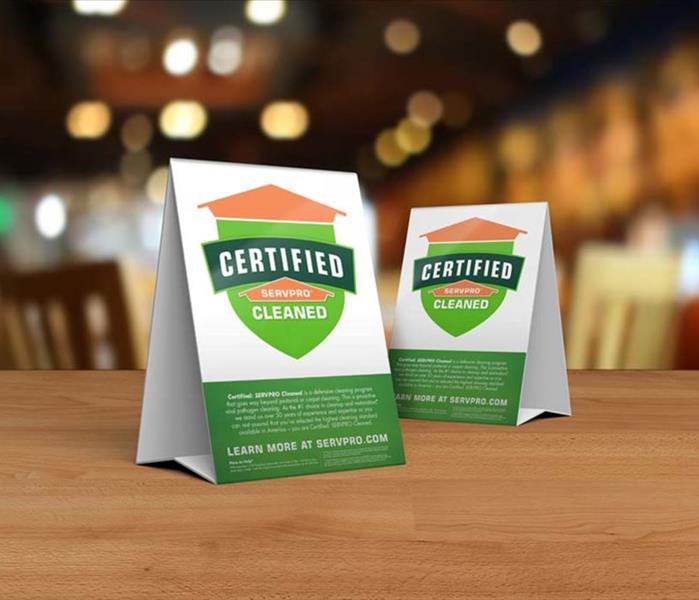 Our defensive cleaning program gives your business a way forward by providing your employees and customers ongoing safety and assuredness.
Our defensive cleaning program gives your business a way forward by providing your employees and customers ongoing safety and assuredness.
Let us help you get back to business
As our communities re-open, we’re all moving back toward a new kind of normal. The expectations of visitors, customers, and employees who come into our establishments have evolved, and staying safe and well is a top concern. The global COVID-19 pandemic has changed what it means to be clean, and we’ve developed a program to help your business meet the new higher standard of clean that is now expected.
Certified: SERVPRO Cleaned is a defensive cleaning program we’re offering to businesses and commercial locations to address the current COVID-19 pandemic. This proactive viral pathogen cleaning program goes well beyond janitorial or carpet cleaning. By choosing Certified: SERVPRO Cleaned, you, your employees, your customers, and your community can rest assured that you’ve selected a higher cleaning standard – you are Certified: SERVPRO Cleaned.
Extensive training and specialized products
As the #1 choice in cleanup and restoration*, we stand on more than 50 years of experience and expertise to help your business become Certified: SERVPRO Cleaned. Beyond fire & water, SERVPRO professionals are trained and experienced in biohazard decontamination and chemical spills – always adhering to the cleaning and decontamination standards set by the Centers for Disease Control and Prevention and local authorities.
From formulating and creating our proprietary cleaning products, like SERVPROXIDE, at our headquarters in Gallatin, TN, to taking the utmost care while disinfecting, we will ensure you and your business are set up to inspire consumer confidence as the economy continues to reopen.
3 C’s – Consult, Clean, and Certify
When the stakes are this high, you want a partner who has developed an industry leading, proprietary training program, cleaning solutions, and remediation processes over decades. We’ve cleaned up some of the most challenging biohazards imaginable. Certified: SERVPRO Cleaned reflects our unique experiences and capabilities. The program is grounded with our unique 3 C’s: Consult, Clean, and Certify.
- Consult – Every business is different, which is why you’ll be assigned a Cleaning Protocol Consultant who understands your business and will create a cleaning program to meet your specific needs. This program will be developed based on your business type, size of space, amount of high frequency touchpoints, foot traffic and congestion points.
- Clean – Based on your specific business needs, your location will undergo a thorough, deep clean, using exclusive cleaning products, according to protocols set forth by the CDC. Our employees have years of experience, and we will go beyond the scope of work that regular janitorial staff perform. Cleanup procedures generally include cleaning of porous and non-porous surfaces, disinfecting of non-porous surfaces, cleaning and disinfecting of equipment, tools, and/or supplies used for cleanup process, and disposal of hazardous materials. In the event of a suspected or confirmed COVID-19 event, we will be there cleaning within 24 hours to ensure you get back to business as quickly as possible.
- Certify - Once your business location has been Certified: SERVPRO Cleaned, you will gain access to proprietary signage, digital emblems, and other collateral that communicates that you’ve selected a higher standard of clean available to help protect your employees and customers. And because we add the day, month, and year to that proprietary stamp of clean, your guests will know that not only did you choose Certified: SERVPRO Cleaned,but that your location is being cleaned regularly at this standard.
Call today for a Certified: SERVPRO Cleaned consultation
We’re Here to Help – 24 hours a day, seven days a week – until life is back to normal in the communities we all call home.
Call SERVPRO of Charles County at 301-753-8313 or SERVPRO of Oxon Hill at 301-292-4447 today for your Certified: SERVPRO Cleaned consultation.
* #1 Choice in cleanup & restoration based Commercial Attitude & Usage Tracking study. Polling 816 commercial business decision makers on first choice for future needs related to cleanup & restoration work. Study conducted by C&R Research: October 2019
Certified: SERVPRO Cleaned means professionally trained SERVPRO franchises perform the requested cleaning, sanitizing and disinfection services according to proprietary SERVPRO protocols and recognized industry and CDC standards with EPA approved cleaning products to deliver a SERVPRO certified cleaning experience. Each SERVPRO franchise is independently owned and operated.
SEVERE Weather
4/6/2020 (Permalink)
Severe weather can happen at anytime in America, but we definitely know it can happen at anytime in Southern Maryland. Each year as a country we deal with natural disasters more than you would imagine.
STORM Averages for the USA
10,000 severe thunderstorms
5,000 floods or flash floods
1.300 tornadoes
2 landfalling deadly tornadoes
That is a lot of storms every year causing nearly $15 billion in damage and 650 deaths. This was an eye-opening fact for me when I read it, noaa.gov. The only thing we can do is to be prepared. You should always educate yourself on the weather risk you could face in the places that you live and work. Sign up for wireless emergency alerts and listen to the radio. Create a communication plan for work and home. Put together and Emergency Kit and make sure everyone knows what it includes and where it is. Be prepared so you can be safe!
Even during Storm conditions SERVPRO® of Charles County and SERVPRO® of Oxon Hill is Here to Help! You can always reach someone from our office @ 301.753.8313.
Flooding in Charles County, MD and Oxon Hill, MD
4/6/2020 (Permalink)
Floods are one of the most common disasters in the United States. No matter where you are located there is always potential for flooding. In the last five years FEMA reported that all 50 states had experience floods or flash floods. Floods cause more damage than any other natural disaster every year. Here are some flood safety tips…
- Stay away from flood waters. As little as six inches of flowing water can sweep you off your feet, and not in a good way!
- DO NOT drive over a flooded road. If you get stuck on a flooded road and the water is rising get out of the vehicle and move. Two feet of moving water can easily sweep your car away.
- Keep children out of the water. The water could be contaminated.
If your home is affected by flood water, please call SERVPRO® of Charles County and SERVPRO® of Oxon Hill. Minor floods can cause MAJOR damage when not treated appropriately. We are always Here to Help! Call us today @ 301.753.8313
Spring Cleaning and Maintenance to keep your business thriving
4/3/2020 (Permalink)
Spring Cleaning and Maintenance to keep your business thriving
As we exit the dreadful cold and enter the glorious days of extended sunshine, beautiful flowers and sensational warmth, we tend to find a little more energy here in the DMV! When this happens, EVERYONE starts to think Spring Cleaning! Well this should go for your business as well.
As working adults, most of us spend more time at work then we do in our homes, so we should take great care of our offices. Besides the fact that we want our customers, clients and employees to be in a clean comfortable space, we want to reduce the probability of damage to our business because this is how we provide for our families. Everyday that our offices are closed could mean lost revenue and that is not something we want to lose. Being proactive in your maintenance and preparation can save you thousands of dollars in the long run and SERVPRO® is Here to Help!
There are a few things SERVPRO® of Charles County and SERVPRO® of Oxon Hill recommends all our businesses complete to ensure they are proactive and prepared!
If you have carpeted areas in your office, examine the condition of the carpet.
- Professional carpet cleaning of high trafficked areas will prevent bacteria, allergens, and dirt from building up which could prolong the life of your commercial grade carpet. (P.S. Carpet isn’t cheap!)
- Hard Floors
If you have hard floors in your office please examine them carefully.
- A buckle in your flooring could be a trip hazard for employees and customers but it could also mean there is/was water intrusion. Water intrusions that are not dried properly run the risk of mold problems in the future. Sanitizing/Disinfecting hard floors is something that SERVPRO® specializes in to ensure that there is no additional moisture left behind to create other problems.
- Upholstery
Do you see stains on your waiting room chairs?
- Unfortunately, dust mites and other organisms tend to stick themselves to fabric. (We all have heard of a bed bug issue! EW!) If you have waiting room chairs or other fabric pieces call SERVPRO® today for a free estimate on cleaning. The last thing we want is one of your customers to have an issue that traces back to your chair.
- Ceilings
Have you noticed a stain on your office ceiling?
- Call SERVPRO® and we will come out to provide a free moisture check in that area. Often we don’t realize that there is water intrusion or a moisture issue until its too late and we see a stain. When you first notice that stain investigate it right away! If it happened this time it will happen again, and improperly dried materials run the risk of developing mold and that is the last thing we want or need!
- GET PREPARED
Do you have an emergency plan in place that is mobile?
- You guessed it! SERVPRO® of Charles County and SERVPRO® of Oxon Hill will come out and provide you will a FREE Emergency Ready Profile (ERP) that comes with an APP! (Available on Android and Apple devices) The ERP can contain all your information that you will need to be able to get your business back up and running in the care of an emergency.
Here at SERVPRO® of Charles County and SERVPRO® of Oxon Hill we know how difficult it can be to run a business and that’s why we want you to know that we are ALWAYS available… 24/7/365! You can call us @ 301-753-8313 and someone from our office is always available!
Fire Extinguisher Safety and Information
4/3/2020 (Permalink)
A fire extinguisher is a lifeline in an emergency fire situation when used correctly. NFPA recommends remembering the phrase PASS!
P Pull the pin. Hold the nozzle away from you.
A Aim low towards the base of the fire.
S Squeeze the trigger evenly and slowly to control the release.
S Sweep the nozzle from side to side.
You should always read the instructions on a fire extinguisher before an emergency happens. Being comfortable with the use of this device could save your family, your property and your life!
It is also important to know that there are different classes of fire extinguishers specifically designed for certain types of fires.
CLASS A: This is the most common type of fire extinguisher as it used to put out normal items such as cloth, wood, rubber, paper and many plastics.
CLASS B: This should be used on fires involving flammable liquids such as grease, gas and oil.
CLASS C: This is designed for fires involving appliances, tools and other products that are plugged in.
CLASS D: Class D is normally found in factories and warehouses as they combat fires involving metals.
CLASS K: This type is seen in commercial kitchens as it fights fires involving vegetable oils, animal oils or fats in cooking appliances.
Please take the time to educate yourself, your family and your staff about Fire Extinguisher Safety! Please know that SERVPRO® of Charles County and SERVPRO® of Oxon Hill is always Here to Help! You can call us 24/7/365 @ 301-753-8313.
A COVID-19 Update to our Community
3/25/2020 (Permalink)
A COVID-19 Update to our Community
Here at SERVPRO® of Charles County and SERVPRO® of Oxon Hill we would like you to know that we are open and working. The safety of our staff and community are MOST important during these difficult times.
SERVPRO® offers cleaning services including the removal of biohazard contaminants. We have specialized training and products to get your property back to business. SERVPRO® is actively performing proactive cleanup that involves facility or structure cleaning and disinfecting where the customer states there is no active known threat of COVID-19 contamination or exposure.
It is important that you know, we are also still providing our standard Fire, Water, Mold and Crime Scene mitigation services if needed. Making sure that we are here for our community is our #1 priority at this time.
If you can stay home, please do so and protect yourselves and others. Coming together as community is how we will persevere through this pandemic and in the end we will be stronger.
Thank you and stay safe,
SERVPRO® Of Charles County
(301) 753-8313
SERVPRO® of Oxon Hill
(301) 292-4447
Soda Blasting is HERE for 2020!
3/20/2020 (Permalink)
Soda Blasting is HERE for 2020!
Soda blasters can be used to remove paint, grease and dirt build up from practically any surface including Steel, aluminum, sheet metal, brick, concrete, granite, glass and fiberglass. Soda blasting can also kill mold spores and remove mold growth from almost any surface. Soda blasting is also very helpful in Smoke removal because the soda absorbs the odor during the cleaning process, leaving you with a clean and fresh smelling area.
Sodium bicarbonate is used in these processes because it has a much milder abrasive factor than sandblasting. Therefore, we can clean so many different surfaces without the worry of damaging the base material.
SERVPRO® Of Charles County and SERVPRO® of Oxon Hill has heard your request and invested in the IBIX 25 system to meet your needs. We can now handle any and all your soda blasting needs from Soot, Mold and graffiti removal on any surface. Call us today to schedule your FREE Inspection @ 301.753.8313.
We are Cleaning Experts
3/17/2020 (Permalink)
SERVPRO of Charles County and SERVPRO of Oxon Hill is Here to Help during this time of need
During this unprecedented time caused by the global pandemic of coronavirus, this is a reminder to our customers that we are specialists in cleaning services, and we adhere to the highest cleaning and sanitation standards.
Specialized Training
We are prepared to clean and disinfect business, according to protocols set forth by the Centers for Disease Control and Prevention. We have years of experience in dealing with biological contaminants, and we will go beyond the scope of work that regular janitorial staff perform on a daily basis.
The CDC encourages cleaning of high-touch surfaces such as counters, tabletops, doorknobs, light switches, bathroom fixtures, toilets, phones, keyboards, tablets and tables. Other spaces mentioned in the CDC’s guidance for commercial spaces include:
- Kitchen/Food Areas
- Bathrooms
- Schools/Classrooms
- Offices
- Retail Spaces
- Water Fountains
- Shelving/Racks
- Sales Counters
- Carpets and Rugs
- Stair Handrails
- Elevator Cars
- Playground Equipment
- Fitness Equipment
Specialized Products
The CDC recommends usage of a labeled hospital-grade disinfectant with claims against similar pathogens to the coronavirus. Multiple products in the SERVPRO product line carry the EPA-approved emerging pathogens claims. While there is currently no product tested against this particular strain of the coronavirus, we are following all guidelines as provided by the CDC and local authorities.
Call Today for a Proactive Cleaning
If your business needs deep cleaning services, call the experts today – SERVPRO of Charles County (301) 753-8313 or SERVPRO of Oxon Hill (301) 292-4447.
Healthy Building + Healthy Employees= Healthy Business
3/12/2020 (Permalink)
Most business owners realize the struggle of an employee being out sick and having to find coverage. But it’s even harder when that employee is dedicated and still comes to work sick to make sure that the operation runs smoothly. But what you often notice is that when one employee gets sick, another gets sick and another gets sick. Soon enough they are passing around the sickness from person to person and there is the potential for major gaps in your operation. Now let’s add in the scenario of customers coming in and out of your business. You never know what germs are being left behind.
With all the stuff going on in the world today, NOW is the time for complete office sanitization or disinfection! The last thing we want is an interruption to your business.
Wouldn’t it be great to be able to post a sign stating, “This facility has been sanitized/disinfected by SERVPRO® of Charles County and SERVPRO® of Oxon Hill.”
SERVPRO® of Charles County and SERVPRO® of Oxon Hill offers a wide variety of options to accommodate your needs. SERVPRO® of Charles County and SERVPRO® of Oxon Hill has over 30 years of experience dealing with Commercial buildings both large and small. We cover all of Charles County including Charles County Government and Charles County Board of Education as well as the National Harbor and MGM Hotel and Casino.
SERVPRO® will provide you with a FREE inspection with verbal ballpark for your office/building. Call today to schedule your Free inspection, 301.753.8313 or email Lauren Lancaster.
2020- BE READY - BE PREPARED
3/2/2020 (Permalink)
2020- BE READY - BE PREPARED
Every New Year people make resolutions to be better than they were the year before. People want to lose weight, be healthier, quit smoking, etc. Well this year SERVPRO® of Charles County and SERVPRO® of Oxon Hill urges your to BE READY- BE PREPARED! No one ever plans for a disaster to strike their home or business, but you can prepare for it.
The SERVPRO® Emergency Ready Profile (ERP) will help ensure your home or business is “Ready for whatever happens” in 2020.
In the event of an emergency the ERP can help minimize business interruption by having an immediate plan of action in place for your home or facility. The ERP is a comprehensive document containing critical information about your home or facility including emergency contacts, shut off valve locations and priority areas. Preparation is key to making it through and size disaster. Having a plan in place will get you back to normal faster.
The ERP is a NO COST assessment and all it requires is a little of your time and voila, you are prepared!
SERVPRO® of Charles County and SERVPRO® of Oxon Hill urges you to schedule your ERP appointment today! You can call us @ 301.753.8313 or email Lauren Lancaster – marketing@SERVPRO5407.com.
Ice Queen and I’m not talking about Elsa!
3/2/2020 (Permalink)
Ice Queen and I’m not talking about Elsa!
Winter weather in Southern Maryland has a tendency to be fickle lately, but what we do know is our temperatures can dip below freezing in an instant. With this being the case, we are at a risk of freezing pipes which can create major disaster to your home.
Frozen pipes occur when pipes are exposed to cold weather outside or even inside your home in areas such as your basement or attic. When a frozen pipe burst the pipe typically rupture causing a back flow of pressurized water to expel into your home. Depending on where the pipe is located this could cause damage to a certain area or your entire home from top to bottom. The pressure can be so significant that it can flood your entire home in minutes.
If frozen pipes damage your home call SERVPRO® of Charles County and SERVPRO® of Oxon Hill immediately! We are available 24 hours a day/7 days week @ 301.753.8313.
Serving our community when they need it most!
2/7/2020 (Permalink)
Serving our community when they need it most!
Here at SERVPRO® of Charles County and SERVPRO® of Oxon Hill you will repeatedly hear us say that we “Support the community we serve” and this is something we take pride in. Our community has supported us for over 33 years in this area and we have always given back.
This year is no exception. Thus far in 2020 we have seen a tremendous amount of fires in Southern Maryland and it has been heartbreaking. We have seen reports of families displaced from their homes almost every week it seems.
When families are faced with this tragedy the last thing they are thinking about is grabbing basic necessities such as shampoo, conditioner, soap, toothbrush, toothpaste etc. So SERVPRO® of Charles County and SERVPRO® of Oxon Hill met with Mr. William Smith, the PIO for Charles County, and dropped off some of the care packages we put together containing necessities. Mr. Smith is an asset to our community as he is on the scene of basically every fire and when a family is displaced, he will have these packages on hand to personally deliver them.
When the community comes together that is when greatness is achieved. We are so excited about the continuation of that relationship and the continuous opportunity to SUPPORT THE COMMUNITY WE SERVE!
The Article posted by Mr. Smith on the Charles County Volunteer Fire & EMS page can be found HERE
RSV is here!
1/17/2020 (Permalink)
RSV is here!
RSV is running rampant in the USA and in Maryland this year. There have been significant increases in RSV cases right here in our schools, homes, daycares and community.
What is RSV?
Respiratory syncytial virus also known as RSV is a common, and very contagious virus that infects the respiratory tract of children. This virus is spread through the air by cough or sneeze as well as by direct contact like touching.
RSV is a virus so there is no medication to directly treat RSV but you can try to treat symptoms of RSV. The best plan of action during this increased RSV season is to wash your hands often, keep your children home if they are sick and make sure that your facilities are disinfected thoroughly.
WE ARE HERE TO HELP!
SERVPRO® of Charles County and SERVPRO® of Oxon Hill can disinfect your facility with an all natural, botanical cleaning agent that is so safe I have personally consumed it! Call us today for 15% off all disinfectant treatments through 2/29/2020- 301.753.8313.
Loretta and Mary’s Pantry @ Sacred Heart
1/3/2020 (Permalink)
Loretta and Mary’s Pantry @ Sacred Heart Church- 2019
This year was a little different for SERVPRO® of Charles County when it came to Loretta and Mary’s Pantry. When asked what items were needed for distribution the answer was “Soup and Crackers.” WOW, not what we expected to hear from them, but we are “Here to Help.” Travis and I set out to the store on a mission for Soup and Crackers! I think people in the store thought we were crazy with carts full of Soup and crackers. Of course, we had to grab some other items just to be on the safe side but we definitely made sure we had Soup and Crackers. While unloading the items and stocking the shelves of the pantry we realized the need for hot Chocolate, Tea and Coffee. So off to the store we go again.
The point of explaining this to you is that the smallest things we take for granted can be major blessings to those in need. Imagine if you purchased 4 cans of soup and a box of crackers each month and donated it. It doesn’t seem like a whole lot correct. Well imagine if 25 people bought 4 cans of soup and a box of crackers each month and donated. Now does it seem like a lot.
Once again this goes back to what we believe here at SERVPRO® of Charles County and SERVPRO® of Oxon Hill… “If everyone did a little, we would have a lot.”
The Arnold House- Thanksgiving 2019
12/4/2019 (Permalink)
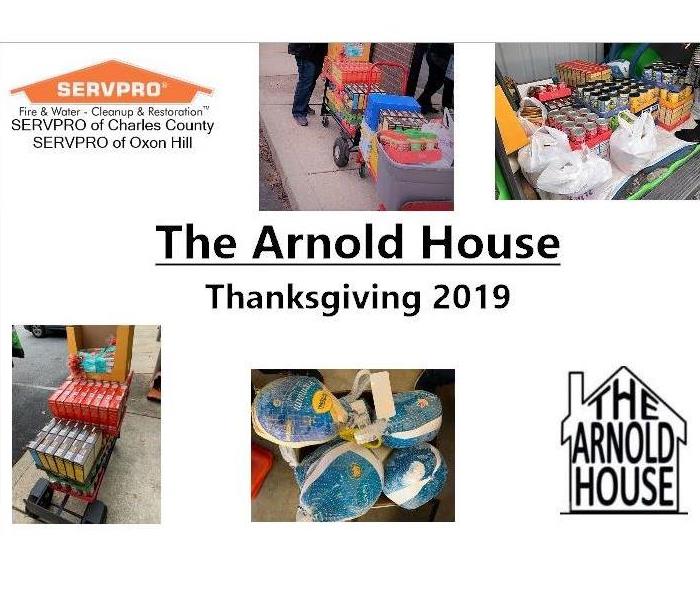 Donations made to The Arnold House in Waldorf, MD
Donations made to The Arnold House in Waldorf, MD
The Arnold House- Thanksgiving 2019
So as the holidays approach again I find myself being thankful for what I have. Of course we all strive for better and sometimes even more, but at the end of the day, I am blessed.
The Arnold House, located in Waldorf, MD, does a phenomenal job year-round feeding our community. Not until my work with The Arnold House did I realize how many families in our area struggle to provide a meal each night. This realization just made it easier to make The Arnold House one of the organizations we assist with on a regular basis. Here at SERVPRO® of Charles County, we feel as if no one should ever have to worry about where their next meal is going to come from. Though we cannot end world hunger, we wish we could, we can make a difference in our community by partnering with organizations like The Arnold House.
The Arnold House organization is a blessing to our community, and we are proud and honored to be able to assist them with their important mission. Our belief here at SERVPRO® is “If everyone did a little, we would have a lot.”
Thank you to everyone at The Arnold House for all that you do!
The United State Fire Administration: Carbon Monoxide
12/2/2019 (Permalink)
The United State Fire Administration: Carbon Monoxide
Carbon Monoxide is very dangerous as you cannot see or smell it but it can kill you in minutes. Often referred to as the silent killer, Carbon monoxide is invisible, odorless and colorless. The United States Fire Administration has offered some tips to protect yourself from Carbon Monoxide.
- Have fuel burning appliances inspected by trained professionals every year.
- Open the damper before using fireplace.
- Never use oven or stove top to heat your home.
- Make sure all fuel burning appliances are vented outside.
- If you need to warm up your vehicle remove it from the garage.
- Only use grills outside away from vents, windows and doors.
- Only use portable generators outside away from vents, windows and doors.
It is estimated that more than 400 Americans die, 20,000 visit the hospital and 4,000 are admitted to the hospital due to CO poisoning. Symptoms of CO poising include dull headache, weakness, dizziness, nausea/vomiting, shortness of breath, confusion, blurred vision and loss of consciousness.
SERVPRO® of Charles County and SERVPRO® of Oxon Hill ask you to please be aware and safe when it comes to the potential of CO poisoning and your home!
WINTER is HERE!!
11/19/2019 (Permalink)
WINTER is HERE!!! YIKES!
The temperature is dropping and Winter is coming in with a roar. As a Multi-Unit Property manager here are some tips to help winterize your units.
- Have boilers and furnaces checked immediately.
- Clear leaves out of your gutters
- Check for pooling on the roof after rainfall
- Have your trees trimmed
- Setup service contracts for snow removal in advance
- Install insulated windows or wrap current windows in plastic.
- Repair outdoor wall cracks
- Clear out storm drains
- Stock up on de-icer products
- Inspect fire alarms and smoke detectors
- Have chimneys professionally cleaned and serviced
As a commercial property manager in a Multi-Unit setting you are not alone. SERVPRO® of Charles County and SERVPRO® of Oxon Hill recommends sending out notices to all of your tenants educating them on what to look for. When you tenants see an issue, they can let you know immediately and this will provide you the opportunity to reduce or prevent damage.
If you find yourself in a situation where the damage is done, please do not hesitate to call us at 301.753.8313.
Space Heater Safety
11/18/2019 (Permalink)
Space Heater Safety
Home fires, deaths and injuries are frequent during the winter months. Heating is the second leading cause of winter home fires and space heaters are often the cause or involved in 40% these fires. Space heaters come in handy during the winter months, especially in my home with a basement and hardwood floors! BRRRR.
Safety is a main concern when using space heaters this winter. Below you will find some space heater safety tips to keep you and your family protected this winter.
- Make sure your space heater has been tested by a recognized laboratory
- Read instructions and warning labels before using
- Inspect all visible wires for damage
- NEVER leave heater unattended
- Proper placement of space heaters is critical. They should be 3 ft away from anything.
- Plug heaters directly into wall outlet- never use extension cord
- Always place heaters flat and level. NEVER place on tables or cabinets.
Please protect your family and property this winter. If you need our services you can call us 24 hours a day- 7 days a week at 301.753.8313.
SERVPRO® : Helping with Hygiene
11/18/2019 (Permalink)
SERVPRO® : Helping with Hygiene.
The Charles County Children’s Aid Society located in Waldorf, MD and has been assisting families for the past 85 years. On October 24th I was lucky enough to have been in attendance to their celebration. As most of you already know we have a phenomenal relationship with The Charles County Children’s Aid Society but even I was astonished at the additional things I saw and learned that evening.
Normally I am running through the door to pick up a delivery or rushing to drop of things off that they need, but not that evening. That evening I was able to step back and observe the facility, the working members, volunteers and board members. I noticed things that normally get lost in the hustle and bustle of service. I was able to tour the facility, see work areas, storage for Christmas connection and I even noticed bare shelves. When I asked a board member what should be in that area she informed me that they get so much help from the community but people often forget about personal hygiene. PERSONAL HYGIENE? That’s what should have lined those bare shelves!!! I sat there thinking of how I could help with this as she explained in detail how those items are overlooked. She spoke with such a grateful heart but I knew something needed to be done. This is when the “Helping with Hygiene” campaign was born.
The next day when I returned to work I immediately sprung into action and got approvals for us to do this on behalf of The Charles County Children’s Aid Society. I sent out mass emails and began making boxes. I had a great response from the community and we are currently running this campaign until December 1, 2019.
If you are interested in helping please contact Lauren Lancaster @ 301.753.8313.
Water- Frozen Pipes and what to look for!
11/13/2019 (Permalink)
Water- Frozen Pipes and what to look for!
With the extreme drop in temperature, in the Southern Maryland area, we are seeing burst pipes already this year. When the air surrounding pipes drops below freezing it causes ice in the pipes. With ice in the pipes it causes a pressure back up which can cause the pipes to burst. Burst pipe are not only a hassle but can cause severe damage to your property. There are warning signs that your pipes may be beginning to freeze.
- Strange smells from faucet or drain
- No or very little water coming out of pipes
- Frost on the pipes
- Not at the right temperature
Please be aware of the warning signs as our temperatures drop. Protect your homes from any unnecessary water damage this winter.
If you need help with your water damage please do not hesitate to reach out to SERVPRO® of Charles County and SERVPRO® of Oxon Hill @ 301.753.8313.
Winter Storm- Southern Maryland Solar Minimum
11/13/2019 (Permalink)
Winter Storm- Southern Maryland Solar Minimum
Here in Southern Maryland we are currently in a Solar Minimum. What is a Solar Minimum? Well a Solar Minimum is when a Solar Activity is really low. Obviously right? What does this mean? When Solar activity is really low it has a direct impact on our atmosphere and weather. During a Solar Minimum the earth tends to cool. When the earth cools even slightly it could cause extreme drops in temperature which in turn could produce SNOW! With the Solar Minimum occurring please be aware of precipitation and below freezing temperatures. With all of the leaves falling in Southern Maryland be sure to check your drainage pipes for blockages and check your pipes for signs of freezing.
If you are in need of service we are available 24 hours a day and 7 days a week at 301.753.8313.
What is Winter 2019-2020 going to look like?
10/10/2019 (Permalink)
What is Winter 2019-2020 going to look like?
Anyone who knows me knowssss that I despise Winter. I think Winter is so awful that I don’t like my birthday because it’s during the frigid cold of Winter. Every Fall I find myself looking for predictions on what is just around the corner, yes you guessed it, WINTER!
Over the years I have grown to find the Farmers Almanac reliable so naturally, that’s where I started.
WOW! To my surprise I was pleased, for the most part, with what the Farmers Almanac had to say for our Southern Maryland Region.
Winter temperatures will be much above normal, on average, with the coldest periods in mid- and late January and early and late February. Precipitation will be above normal, with below-normal snowfall.
But of course, it couldn’t all be sunshine in rainbows…
The snowiest periods will occur in mid- and late January and early February.
GREAT! Just what I wanted for my birthday! SNOW! (Complete sarcasm here)
Most people look forward to Snow because of school closings, hot chocolate, sledding, snowman and the beautiful scenery, yes sometimes it is beautiful, but not I. When I hear of snow coming to town, I think about packed grocery stores, wet clothes, dangerous roads and most of all, water damages.
Water damages are frequently paired with snowstorms due to sump pump failure, power outages and burst pipes. I know the damage it can cause a family and that is why I am proud to be a part of the SERVPRO® of Charles County and SERVPRO® of Oxon Hill family.
SERVPRO® of Charles County and SERVPRO® of Oxon Hill are always “Here to Help” and genuinely care about taking care of your family and home!
When is need please do not hesitate to call us 24/7 @ 301.753.8313.
Water in your crawlspace!?!
10/10/2019 (Permalink)
Water in your crawlspace!?!
When a home is built there are different options for your foundation. You can have an actual basement, a concrete slab on grade or a crawlspace.
Crawlspaces are normally chosen because of cost and accessibility. Crawlspaces allow air to circulate beneath your home, you can easily fix a sloping yard and it also allows you to run piping throughout your home with easy access for maintenance and repairs.
So far crawlspaces are sounding like a no brainer if you are not building out a basement, right? Well, not so fast. Those are all the perks to opting for a crawlspace but let’s talk about what happens when you get water in your crawlspace. Moisture in your crawlspace if not handled correctly or in a timely manner could cause significant issues.
Water in a crawlspace could pose issues to include wood rot, termite damage, hardwood floor cupping, and mold growth. Moisture in the crawlspace will eventually evaporate and could cause damage inside your home.
If you notice water in your crawlspace call SERVPRO® of Charles County and SERVPRO® of Oxon Hill today @ 301.753.8313
Fire- Fire escape Plans are a MUST!
10/8/2019 (Permalink)
Fire- Fire escape Plans are a MUST!
When a fire occurs your ability to get out is significantly greater with advanced warning from smoke alarms and with a fire escape plan in place. Seven, 7, people die everyday from a home fire and the thought of that is scary in itself.
Fire is so unpredictable and can spread so rapidly that you are often left with, on average, 2 minutes to exit safely. Having an escape plan and practicing with your family could be a lifesaver! Design an escape plan for each room in the home and discuss regularly. Have fire drills at home to make sure that everyone is aware and remembers how to respond and where they should be going.
Children in the home should have visual aids and have at least two exit plans. There should be a meeting point for the entire family in a safe place away from the home.
Placing a working flashlight in each room is a great way for anyone who would be trapped to signal to firefighter in an emergency. This will allow the firefighters to locate them in a timely manner even through the smoke.
SERVPRO® of Charles County and SERVPRO® of Oxon Hill offer free emergency ready plans in case of a disaster, 301.753.8313.
Winter Storm season and your business!
10/8/2019 (Permalink)
Winter is approaching here in Southern MD. Even though we are still in the high 80’s and Low 90’s right now, winter will be here before we know it. A winter storm can interrupt and even stop business operations completely. Preparing for winter storms is crucial to your business and your employees’ safety.
50% of business that suffer a loss may never recover. Could you imagine suffering a loss and then not being able to resume business? Small businesses are particularly vulnerable to disasters. Unlike large companies, small businesses have less capital and fewer personnel available to resume operations and recover losses. It is vital to the continuity of a small business to have a disaster plan in place and be prepared, as it can make the difference between staying open or shutting down.
The most important asset to any business is its people. Businesses cannot recover from a disaster without their people, and people cannot recover without a job to return to. In order for employees to be able to focus on their work after a disaster, they need to be personally prepared for emergencies.
Encourage your employees to:
- Sign up for local text alerts and warnings and download weather apps to their smartphone.
- Gather important documents and keep them in a safe place.
- Create an emergency supply kit.
- Develop a family emergency communication plan.
- Know the facts on how to prepare for a winter storm.
Working with SERVPRO® of Charles County and SERVPRO® of Oxon Hill we can provide you a FREE Emergency Ready Profile for your business. Our ERP provides a plan that is accessible from anywhere you are and can be the difference between your business reopening or remaining closed.
Call us today to schedule your FREE Emergency Ready Profile- 301.753.8313!
Shocking facts about lightning
9/17/2019 (Permalink)
Shocking facts about lightning
Lightning is one of the leading causes of weather related deaths even though the odds of being struck in a years’ time is 1 in 500,000. There are multiple factors that put you at a greater risk for being struck. Here are a few safety tips to help you out:
- Check the forecast before participating in outdoor activities- If you decide to go still please make sure there are shelter options nearby.
- When thunder roars go indoors. – This catch phrase is something to remember at all times. Safe shelters include homes, offices, stores and hard top vehicles with windows rolled up.
- Avoid windows, doors, porches and concrete as lightening can travel through these things.
- Avoid water- Do not bathe, shower, do dishes or anything with water as lightning can travel through plumbing.
The Science of Drying
9/17/2019 (Permalink)
The Science of Drying
Did you know that there is an actual science behind the process of drying your property? The knowledge of Psychrometrics is vital to restoring a water damaged structure. Therefore SERVPRO® of Charles County and SERVPRO® of Oxon Hill puts a tremendous focus on making sure our technicians are Certified through IICRC standards in the Water Restoration Technician (WRT) program.
When a water damage occurs on your property SERVPRO® of Charles County and SERVPRO® of Oxon Hill will
- Inspect the building to detect every area that is wet in an effort to reduce secondary damage.
- Measure the amount of moisture in an area and monitor the proper drying is taking place.
- We will speed up the drying process by using professional drying equipment to regulate the temperature and humidity in affected areas.
Here at SERVPRO® we use state of the art drying equipment and technology to ensure that your property is dried appropriately and in a timely manner. Reducing secondary damage is a main priority for us and we live by the restore vs replace method.
If you have experienced a water damage in your home please give us a call today @ 301.753.8313.
Commercial Water Disaster
9/16/2019 (Permalink)
Commercial Water Disaster
There is no such thing as a small disaster when it comes to water damage and your business. Water damage can cause mold, rot and other unseen damages. Water damage can affect the value of your property.
SERVPRO® of Charles County and SERVPRO® of Oxon Hill knows how disruptive water damages can be to your business. We are trained and certified to manage the drying process from start to finish. We use the proper equipment and moisture reading equipment so that your commercial building will be quickly dried to industry standards, which will prevent secondary damages. With our rapid response we can help you regain control of your facility and get back to business.
Don’t risk secondary damage by trying to clean up yourself, give us a call today at 301.753.8313.
Summer Grilling Safety Tips
9/16/2019 (Permalink)
Summer Grilling Safety Tips
Summer as we all know is our favorite time to break out the grill and enjoy the wonderful food with friends. Grilling is fun when hanging with friends or just cooking for your family, but it can be dangerous. Here are some grill safety tips that can be overlooked easily but can save you a catastrophe.
- Only use your grill outside and keep it at least 3 feet away from siding, deck rails and eaves.
- Always keep children and pets at least 3 feet away from your grill.
- Open your gas grill before lighting.
- Keep an eye on your grill and never walk away from it.
- Clean your grill after each use. This will remove grease that can start a fire.
- Place the coals from your grill in a metal can with a lid once they have cooled.
SERVPRO® of Charles County and SERVPRO® of Oxon Hill wants you to enjoy a safe and fun summer!
National Day of Service and Remembrance
9/2/2019 (Permalink)
National Day of Service and Remembrance
In honor and memory of those who died on September 11, 2001, as well as the survivors and First Responders, National Day of Service and Remembrance was established in 2009 as a day of reflection. Led by the Corporation for National and Community Service, this is a day to come together as Americans did following the events of 9/11 to help neighbors in need, and to honor veterans and First Responders in your community. On this day and every day, SERVPRO® salutes those heroes who arrive in the greatest times of need and stand strong in the face of disaster. These heroes are the First Responders who keep our communities safe in trying times. Give back and make a difference in your community this year.
To find a volunteer opportunity near you, or to register your National Day of Service and Remembrance event, visit nationalservice.gov/911day.
Water Damage Steps
8/31/2019 (Permalink)
Do you have a Water Damage in your home and don’t know what to expect? Well let SERVPRO® of Charles County and SERVPRO® of Oxon Hill walk you through it!
- Inspection: Let SERVPRO® asses the water damage in your home. During this inspections SERVPRO® will determine the severity, class of water and outline the next steps!
- Water Removal: SERVPRO® uses the latest technology to extract water from your property, rather it is 2 feet of standing water or just enough to soak your carpet and pad, SERVPRO® can take care of it for you.
- Drying: After the water is extracted drying is begun with air movers and dehumidifiers. This step may seem fairly easy but it is completely scientific in nature. The appropriate amount of fans, dehumidifiers, room temperature and air humidity is needed to dry out the remaining moisture in your property.
- Cleaning: Your things in this area need to be determined as salvageable and unsalvageable depending on the class of water damage you have. SERVPRO® believes in a Restore VS. Replace system so we will try to save the items that can be safely restored. The area will also be cleaned with anti-microbial if necessary! BENEFECT™ is an amazing all natural product that disinfects.
- Restoration- This is the final step in getting your home back to normal. SERVPRO® of Charles County and SERVPRO® of Oxon Hill now offers reconstruction so we can repair anything that needed to be replaced.
If you experience a water damage in Southern Maryland give SERVPRO® a call today @ 301.753.8313.
Dryers can be dangerous
8/30/2019 (Permalink)
Fire- Dryers can be dangerous.
Doing laundry seems like one of the safest tasks you would complete in your home, right? Unfortunately, that may not be the case. Clothes dryers are the cause of over 20,000 house fires each year! Regular maintenance and cleaning could protect your family and your home. Here are some dryer safety tips from SERVPRO® of Charles County and SERVPRO® of Oxon Hill.
- Clean your lint trap before each use
Did you know that lint build up is combustible? Lint causes fires! Cleaning the lint trap is one of the easiest things you can do, simply remove the screen and wipe lint from the screen and surrounding edges. There is also a dryer lint brush that will allow you to reach areas you cannot reach by hand.
At least once a year it is recommended to have your dryer vents cleaned. Cleaning your dryer vent includes cleaning the exhaust vents and all hoses. If you still have a white or silver vinyl duct hose replace it immediately as they are flammable. SERVPRO® of Charles County and SERVPRO® of Oxon Hill does provide dryer vent cleanings along with duct cleanings.
- Understand how to safely use your dryer
If your clothing has gasoline, oil or any other dangerous materials make sure to wash clothing well before putting in the dryer. Dangerous materials are combustible even with the slightest heat. Be aware of the materials you are storing near the dryer. Never leave dryer running when no one is home.
- Make sure your dryer is installed correctly
When installing or having your dryer installed you should always make sure that the dryer vent runs OUTSIDE. Dryer vents should never vent inside your home or attic. A dryers exhaust duct should not exceed 25 feet from the dryer location. The electrical outlet used to power your dryer should be a 220v grounded electrical outlet. A professional should be completing the install for gas dryers.
SERVPRO® of Charles County and SERVPRO® of Oxon Hill are always Here to Help! You can call us 24 hours a day, 7 days a week @ 301.753.8313 or 301.292.4447.
Severe Thunderstorm Warnings
8/30/2019 (Permalink)
Severe Thunderstorm Warnings
During the summer months we often hear of Severe Thunderstorm Warnings in our area. They rend to become common occurrences, just like this summer. When they are issued frequently we tend to pass over them as if they are not extremely dangerous and even deadly.
Severe Thunderstorm Warnings come with the possibility of destructive winds, hail, the possibility of tornadoes and frequent lightning.
The destructive winds during a Severe Thunderstorm Warning may be strong enough to knock down trees and powerlines which pose a great threat to your property. Hail during this time can put dents in your car and ruin the shingles on your roof at the smallest size. As the hail gets bigger you run the risk of broken windows and actual holes in your roof. During this warning in a span of minutes with low-level rotation could form a tornado. As we all know if you can hear thunder you are close enough to get struck by lightning so during a Severe Thunderstorm Warning you should take the proper precautions.
If you experience a loss in your home, please do not hesitate to call SERVPRO® of Charles County and SERVPRO® of Oxon Hill immediately. 301.753.8313.
Lightening Safety
8/2/2019 (Permalink)
Storm: Lightening Safety
Lightening Strikes the United States over 25 million times a year. That is a crazy big number! Mostly we see lightening in the summer months due to the heat but you can see lightening at any time. Did you know that thunder is created by lightening so even if you don’t see lightening but you hear thunder it is there! If you hear thunder or see lightening you should go inside. Most lightening strikes involving people are due to people enjoying themselves outside and not seeking shelter.
Have you ever heard of the 30/30 rule when it comes to lightening? “If it takes less than 30 seconds to hear thunder after seeing the lightening flash, lightening is close enough to pose a threat! After a storm wait 30 minutes before going back outside”
The best way to protect you and your loved ones from lightening is to avoid the threat. Stay indoors!
The water damage process
8/2/2019 (Permalink)
Do you have a Water Damage in your home and don’t know what to expect? Well let SERVPRO® of Charles County and SERVPRO® of Oxon Hill walk you through it!
- Inspection: Let SERVPRO® assess the water damage in your home. During this inspection SERVPRO® will determine the severity, class of water and outline the next steps!
- Water Removal: SERVPRO® uses the latest technology to extract water from your property, rather it is 2 feet of standing water or just enough to soak your carpet and pad, SERVPRO® can take care of it for you.
- Drying: After the water is extracted drying is begun with air movers and dehumidifiers. This step may seem fairly easy but it is completely scientific in nature. The appropriate amount of fans, dehumidifiers, room temperature and air humidity is needed to dry out the remaining moisture in your property.
- Cleaning: Your things in this area need to be determined as salvageable and unsalvageable depending on the class of water damage you have. SERVPRO® believes in a Restore VS. Replace system so we will try to save the items that can be safely restored. The area will also be cleaned with anti-microbial if necessary! BENEFECT™ is an amazing all natural product that disinfects.
- Restoration- This is the final step in getting your home back to normal. SERVPRO® of Charles County and SERVPRO® of Oxon Hill now offers reconstruction so we can repair anything that needed to be replaced.
If you experience a water damage in Southern Maryland give SERVPRO® a call today @ 301.753.8313.
Commercial Restoration in Southern Maryland
8/1/2019 (Permalink)
Most people in Southern Maryland think of SERVPRO® of Charles County and SERVPRO® of Oxon Hill as the Premier Residential Fire & Water Cleanup & Restoration company, but did you know that we also handle Commercial Restoration as well?
SERVPRO® of Charles County and SERVPRO® of Oxon Hill handles commercial losses from major hotel chains, popular restaurants, major shopping malls and even medical facilities. We make sure that our team of professionals are highly trained and certified to handle any loss large or small, residential or commercial.
Here at SERVPRO® of Charles County and SERVPRO® of Oxon Hill we know that the most important thing in a commercial loss is reducing the down time. The quicker we can stabilize your loss, the quicker we can get you back to business and making money.
If you have a commercial loss give us a call @ 301-753-8313 today!
Heating Safety Tips
8/1/2019 (Permalink)
HEATING SAFETY TIPS FROM SERVPRO® of Charles County and SERVPRO® of Oxon Hill
Keep anything flammable at least three feet away from heating equipment, like the furnace, fireplace, wood stove or a portable space heater. Have a three foot “kid-free zone” around open fires and space heaters.
Make sure the fireplace has a sturdy screen to stop sparks from flying into the room. Ashes should be cool before putting them in a metal container. Keep the container a safe distance away from your home.
Remember to turn portable heaters off when leaving the room or going to bed.
Test smoke alarms monthly.
Always use the right kind of fuel, specified by the manufacturer, for fuel burning space heaters.
Have heating equipment and chimneys cleaned and inspected every year by a qualified professional.
If your property does suffer fire damage, contact SERVPRO® of Charles County, 301.753.8313 or SERVPRO® of Oxon Hill, 301.292.4447 today!
How many gallons of water per person per day do you need for an emergency?
7/15/2019 (Permalink)
How many gallons of water per person per day do you need for an emergency?
When the weather around us gets crazy it has the tendency to disrupt our day to day lives. Natural disasters, water main breaks and contaminated water is not so uncommon in today’s world. If this occurs in your life you and your family could be without water for 48 hours or more. In this situation would you be able to continue your day to day?
The rule of thumb is to have one gallon of water per person per day. The Center for Disease Control and prevention suggest drinking a half gallon of water a day and using the other half gallon for hygiene. You should always be prepared for at least three days of water per person or pet.
In my household we have Three humans and a fur baby. This would mean that we should stock 56 gallons of water for two weeks of disruption. That sounds like an abundance of water right? Where would I keep this much?
Did you know that in a 24 pack of bottled water there is slightly over 3 gallons of water? With this said it would require for my family 18 cases of water to meet our water needs for two weeks. The great thing about cases of water is they can be easily stored in a closet, garage, under the beds and of course in the pantry. I believe this is worth it to make sure your family prepared in the face of disaster.
If you find yourself in an emergency situation and need water assistance call SERVPRO® of Charles County and SERVPRO® of Oxon Hill @ 301.753.8313, as most of the time is we have cases of water on hand.
Electrical Safety Tips
7/15/2019 (Permalink)
Electrical Safety Tips
Electrical cords, receptacles and light bulbs can be very dangerous. Every year these things cause 41,000 residential fires, 350 deaths, 1,400 injuries and $620 Million in property damages. Here are SERVPRO® of Charles County and SERVPRO® of Oxon Hill we would like to offer you some electrical safety tips.
Extension Cord Safety Tips
- Never run a cord under a rug
- Only use them for temporary situations
- Damaged cords should be replaced immediately as they can cause shock or fires.
- Only buy approved safety cords
- Never overload the extension cord based on rating label
Receptacle Safety Tips
- Replace broken receptacles right away
- Never alter the plug
- If you must use a grounding adapter first verify the plug is grounded
- Do not use multi plug adapters for extended periods
- Never install 3 slot receptacles where a ground is not available
- Use child safety plugs when children are present
Most Common Causes of Commercial Fires
7/14/2019 (Permalink)
If you own or manage a business or building in the Southern Maryland area, fire protection should be among your primary concerns. There are many cases of commercial fires, so it is best to understand fire safety. One of your best defenses against commercial fires is to understand and mitigate your risks.
Most Common Causes of Commercial Fires
Commercial fires are more common than you may think. It is always better to know the common causes of most commercial fires.
Cooking Equipment
Because of high cooking temperatures, flammable oils and grease, and the hectic nature of commercial kitchens, this is the single most common cause of commercial fires.
Cooking equipment is responsible for these shocking numbers;
- 65% of fires in healthcare facilities
- 61% of fires in restaurants
- 38% of fires in educational institutions
- 29% of fires in office properties
- 13% of fires in stores and mercantile properties
Heating Equipment
Commercial buildings require heat to stay comfortable for several months of the year in Southern Maryland. As with other mechanical equipment, furnaces, boilers, and radiators are at risk of overheating. This, in turn, can lead to a fire.
Heating equipment is responsible for:
- 14% of fires in industrial or manufacturing properties
- 11% of fires in office properties
- 9% of fires in restaurants
- 5% of fires in healthcare facilities
Electrical & Lighting Equipment
All of todays buildings feature electrical wiring behind the wall for light and power. Electricity carries inherent fire risk. Old or defective wiring, overloaded circuits, loose connections, faulty fuses, imbalanced electrical loads, and many other electrical or lighting problems can develop that lead to overheating or sparks that ignite a fire.
Electrical problems are responsible for:
- 12% of fires in office properties
- 10% of fires in stores and mercantile properties
- 9% of fires in restaurants
- 5% of fires in healthcare facilities
Smoking Materials
Cigars, cigarettes, and other smoking materials can start fires if disposed of improperly after smoking. Smoking materials remain one of the top five most common causes of commercial fires.
Smoking materials are responsible for:
- 9% of fires in office properties
- 7% of fires in restaurants
- 5% of fires in healthcare facilities
Intentional
An intentional fire is one that occurs as the result of the deliberate misuse of a heat source. Arson fits into this category, though to be considered arson, the fire starter must have malicious, criminal intent.
Intentional fire-starting is responsible for:
- 36% of fires in educational institutions
- 10% of fires in office properties
- 6% of fires in healthcare facilities
- 4% of fires in restaurants
Fires are definitely scary and overwhelming so if you find yourself dealing with this please do not hesitate to call SERVPRO® of Charles County or SERVPRO® of Oxon Hill @ 301.753.8313.
The three types of floods… and yes they can all occur in Southern Maryland!
7/14/2019 (Permalink)
The three types of floods… and yes they can all occur in Southern Maryland!
A flood is an overflow of large amounts of water in what is normally pretty dry areas. There are three main types of floods that can occur depending on your geographical area. The scary thing about floods is that each kind is different and requires different actions to prepare and to recover. The three main types of floods are Fluvial (river), Pluvial (surface) and Coastal Floods.
Fluvial floods (river floods)
A Fluvial flood happens when the water level in a river overflows the surrounding areas due to excessive rain or snow melting. The damage from river floods can be widespread depending on the river, lake or stream size and the area around it.
Pluvial floods (flash floods and surface water)
Flash Floods and overwhelmed drainage systems make up the Pluvial flood family. Pluvial floods occur when extreme sudden rainfall hits an area and causes a flood that is not caused by an overflowing body of water. An Overwhelmed drainage system water flows out into the surrounding areas and could potentially flood surrounding areas. Flash floods occur with torrential rain in a short amount of time. Flash floods are extremely dangerous not just because of the abundance of water but because of the potential debris associated with the area.
Coastal flood (storm surge)
Coastal flooding is conducive of areas along the coast. Coastal floods are normally caused by windstorms occurring at the same time as high tide- called storm surge. This is when the high wind forces the water to land and causes coastal floods.
Floods are very unpredictable and can happen in a moment, so it is very important that you listen to your local weather and emergency services personnel. Be prepared and be careful. If you experience flooding in Southern Maryland please do not hesitate to give us a call @ 301.753.8313.
Seven signs that you may have a water damage in your home
7/3/2019 (Permalink)
Seven signs that you may have a water damage in your home
Knowing the signs of water damage in your home could potentially save you hundreds even thousands of dollars. Most people overlook everyday things that should raise red flags and alert you to a problem. Here at SERVPRO® of Charles County and SERVPRO® of Oxon Hill we want you to be aware of these signs.
- Sudden unusual dampness or humidity
- An unexplained increase in your water bill
- Hearing running water when all faucets are turned off
- Damp, musty, moldy or even sewage smell
- Puddles or west spots around plumbing
- Cracked or flakey drywall
- Dark or wet spots on the walls or ceiling
Seeing any of these things in your h9ome should alert you to the possibility of a problem. The faster you respond to this potential problem the less risk for secondary damage. Reducing the amount of damage to your home will greatly reduce the amount of money spent to fix the issue.
If you notice any of these 7 things please do not hesitate to call SERVPRO® of Charles County, 301.753.8313, or SERVPRO® of Oxon Hill, 301.292.4447, TODAY!
Hurricane Season Ready
7/2/2019 (Permalink)
Hurricane Season is upon us and while most commercial facilities along the coasts have been built to withstand hurricane-force winds, building managers can take several additional steps to reduce the damage that can occur during major storms.
These actions can help protect your facility and help the Utilities when and if they need to restore service in your area.
Understand Your Risks
The four key trademarks of a hurricane are high wind speeds, storm surges, torrential rains, and tornadoes – any one of them can put your business at risk during a storm.
Know Your Disaster Response
Although most major commercial and industrial organizations have well-established disaster response plans in place, conducting an audit of your emergency strategy is never a bad idea. Before a storm hits, be sure to:
- Review the company’s property insurance policy to ensure the business is adequately covered against major storm damage.
- Remind staff of all hurricane-related policies and procedures and inform essential employees of their specific roles and responsibilities in the event of an emergency.
- Make sure all emergency supplies are adequately stocked.
- Revisit plans for protecting computer files to make certain critical data is secured through a backup system.
- Have your SERVPRO® ERP handy so that you can have and give direct access to the information needed.
As a Storm Approaches
As soon as a warning is issued for a hurricane or tropical storm, property managers should check the facility’s interior and exterior surroundings and take appropriate safety measures.
- Bring in exterior displays and remove any outdoor signs or other items that could become airborne in high winds. Board up glass doors and windows or tape an “X” over them to prevent shattering.
- Disconnect all electrical devices except for refrigerators. Experts also recommend turning off electricity (except for those circuits running refrigeration) at the power supply box.
- Clear all desk or work surfaces of small items and take down all loosely secured items hung on the walls.
- Move equipment and furniture away from windows.
- Make sure key employees know the processes and procedures that will need to take place before allowing people back in the building once the storm has passed.
- Shut down non-critical building systems when all employees are evacuated.
After a Storm Passes
Employees should wait to return to the building until authorities indicate it is safe to do so. A designated emergency response team should then conduct an assessment of the property before allowing people back onto the premises.
Tiger Lily Charities and SERVPRO
7/2/2019 (Permalink)
This year SERVPRO® of Charles County and SERVPRO® of Oxon Hill had the opportunity to Join forces with Tiger Lily Charities and support their 10th annual Golf Tournament!
Who is Tiger Lily Charities?
Receiving a cancer diagnosis is a life-changing occurrence that often comes with a great financial burden for the family of those affected. Tiger Lily Charities, works to ease this burden by providing financial support to patients and their families. The charity was founded by Tiffany Kuhn, a leukemia survivor, in 2010.
Tiger Lily Charities is an organization that is dedicated to leukemia patients. They provide financial support to their clients who are experiencing financial difficulties as a result of their diagnosis. They are able to provide grants for transportation costs, household bills, medical co-pays, etc. Tiger Lily Charities can also provide referrals for additional support services. They have hopes that in the future they will be able to provide free transportation services for cancer patients who do not have reliable means of transport to and from cancer-related services.
Continuity in care is extremely important during cancer treatment, and their research shows that transportation can be a barrier to care for many cancer patients.
SERVPRO® of Charles County and SERVPRO® of Oxon Hill looks forward to this continued partnership with Tiger Lily Charities and hopes you will consider this organization in the future.
Tiger Lily Charities
5 Most common commercial fires
7/1/2019 (Permalink)
With the abundance of industrial areas in Charles County and Oxon Hill we feel it is important to address the five most common causes of commercial fires are…
- Combustible Dust Fires
A combustible dust is any dust or fine material that has the potential to catch fire and explode when it is mixed in the air. Many times, materials that are normally considered non-flammable can act as a combustible when fine particles are mixed with air in a particular concentration. Combustible dust happens in two waves. A primary explosion causes particles to become airborne, and then the dust cloud can ignite and cause a secondary explosion, much more severe than the first. Combustible dust can bring down entire facilities.
How do I Prevent Combustible Dust Fires?
- Implement a hazardous dust inspection, testing, housekeeping, and control program.
- Regularly inspect for dust residues in open and hidden areas.
- Use proper dust collection systems.
- If ignition sources are present, use cleaning methods that do not generate dust clouds.
- Control smoking, open flames, and sparks (mechanical and friction).
- Hot Work Fires
Hot work is any activity that involves open flames or generates sparks or heat. This includes welding, heat treating, grinding, thawing pipes, torch cutting, brazing, soldering, etc. Hot work becomes a fire hazard when sparks and molten material travel…often as far as 35 feet, sometimes igniting combustible dust in other areas.
How do I Prevent Hot Work Fires?
- Train personnel on the hazards associated with hot work and make sure they are using proper safety equipment.
- Clear area of flammable materials including dust, gases, and liquids.
- Make sure a safety professional is on site to provide supervision of the work.
- Avoid hot work if possible.
- Flammable Liquid and Gas Fires
These are most common in chemical plants. Flammable liquids and gases can ignite off sparks from the previous hazards or add fuel to an already burning fire.
How Do I Prevent A Flammable Gas Fire?
- Know the hazards of each flammable liquid and gas on-site. Read and follow the safety information for storage and follow the material safety data sheet included with the product.
- Properly store hazardous materials according to OSHA.
- Keep ignition sources away from flammable gases and liquids.
- Provide personal protective equipment, like gloves, bodysuits, vests, goggles, shoes etc.
- Equipment and Machinery Fires
Equipment not properly installed, maintained, or operated correctly is a major cause of industrial fires. This is especially true for equipment associated with hot work and heating. Even machinery not seen as a fire hazard can become a risk with lack of proper maintenance.
How Do I Prevent Equipment and Machinery Fires?
- Training can help employers and employees identify possible risks and what to do if they find one.
- Keep the machines, equipment, and areas surrounding them, clean.
- Prevent machine overheating by following the manufacturer’s guidelines for recommended maintenance procedures.
- Electrical Hazard Fires
Electrical fires are most common in manufacturing plants and include wiring that is exposed or not up to code, overloaded outlets, extension cords, overloaded circuits, static discharge, etc. A spark from electrical hazards can cause ignition of combustible dust and flammable liquids and gases.
How Do I Prevent Electrical Hazard Fires?
- Don’t overload electrical equipment or circuits.
- Unplug temporary equipment not in use.
- Avoid using extension cords.
- Use antistatic equipment as advised by OSHA and NFPA.
- Follow a regular cleaning schedule to ensure combustible dust and other hazardous materials are removed from areas that house equipment and machinery.
Hurricane Season 2019
7/1/2019 (Permalink)
While the 2018 hurricane season was a lively one with storms that slammed the Carolinas and the Florida Panhandle, two early forecasts for this year call for fewer storms — good news for Maryland residents and beachgoers. The 2018 hurricane season's activity was about 120 percent of an average season with Hurricane Florence slamming into coastal Virginia and the Carolinas, and Hurricane Michael inundating portions of the Florida Panhandle.
The two early looks at the season — from the weather researchers at Colorado State University and the forecasters at AccuWeather — disagree in part. The Atlantic hurricane season runs from June 1 through Nov. 30.
AccuWeather predicts a near- to slightly above-normal hurricane season with 12 to 14 storms in 2019. Five to seven of those storms could become hurricanes and two to four are predicted to become major hurricanes.
"This year, we think that there will be a few less tropical storms and lower numbers in hurricanes, but again, the old saying is 'it only takes one'," AccuWeather Atlantic Hurricane expert Dan Kottlowski said.
Meanwhile, weather researchers at Colorado State University predict a slightly below-average 2019 Atlantic hurricane season. The university's Tropical Meteorology Project team said the 2019 season will be about 75 percent of an average season. The researchers are predicting 13 named storms this year.
"Of those, researchers expect five to become hurricanes and two to reach major hurricane strength ... with sustained winds of 111 miles per hour or greater," researchers said, adding that they are referring to storms that would be a category 3, 4 or 5 storms.
Other years with similar conditions saw hurricanes with impacts along the East Coast from Brownsville, Texas, to the Florida panhandle and up the mid-Atlantic coast, AccuWeather said. "This year, just about all coastal areas look like they have equal chances," Kottlowski said.
Colorado State researchers use models built on roughly 40 years of historical data and evaluate conditions that include Atlantic sea surface temperatures, sea level pressures, vertical wind shear levels, El Niño and other factors.
"It takes only one storm near you to make this an active season," said Michael Bell, associate professor in the CSU Department of Atmospheric Science.
The 2019 forecast is set to be updated on June 4, July 2 and Aug 6.
Summer Emergency Preparedness
6/15/2019 (Permalink)
Summer Emergency Preparedness
During the summer Mother Nature can wreak havoc on your business and home. Substantial rain and high winds are very common during summer storms. These factors can cause damage to your roof, siding, windows and in return allow water into your property. Being proactive is the key to avoiding and or reducing the loss to your property.
When summer weather rolls around it is imperative to stay informed of local storms and upcoming weather. Here at SERVPRO® of Charles County and SERVPRO® of Oxon Hill we stay tuned to Weather.com for overview and The Southern Maryland Chronicle as well as The Southern Maryland Chronicle Facebook, for all of our local weather updates. Being aware of any upcoming threats in advance will allow you to prepare your employees and your property as necessary.
If you do experience a loss please do not hesitate to call us immediately. SERVPRO® of Charles County 301.753.8313 and SERVPRO® of Oxon Hill 301.292.4447 are available 24 hours a day, 7 days a week.
6 Signs to call a professional!
6/15/2019 (Permalink)
Often times we find ourselves trying to fix things around the house to save a little money. There are definitely some task that we can handle ourselves but when it comes to plumbing we should rely on the professionals. These are the top 6 situations in which you SHOULD call a plumber!
- Your water isn’t running!
If your water isn’t running, you need to call a professional immediately. There are a multitude of reasons that your water is not flowing, and this would require professional attention.
If you don’t have hot water first check your hot water heater. If there is no signs of trouble there, call the professionals. There are many possibilities as to why you do not have hot water but you should let the professionals determine the cause as it can get costly.
- Are you pipes draining slowly?
If you have a pipe that’s draining slowly you can by all means try your home remedies! But let’s say this doesn’t work… Call a professional. If your home remedy doesn’t correct the issue this could mean you have a bigger issue somewhere in your drainage system. You do not want to wait because this could cause the water to come back up your pipes and into your home!
- Is your water off but you still hear it running?
I know this sound like a bad joke but it is not. If you can hear water running when its not this is a possible sign of a leak somewhere. Inspect your home for visible signs of a leak immediately. Call the professionals and give them any information you can.
If you have frozen pipes, STOP! Call the professionals. End of story!
If your drains smell you can attempt a home remedy solution. If the problem persists please call a professional immediately.
All of these things if caught early can be corrected before suffering a major water damage in your home. If you happen to not get to it in time and you do suffer a loss, do not hesitate to call SERVPRO® of Charles County, 301.753.8313 or SERVPRO® of Oxon Hill®, 301.292.4447.
SERVPRO® does commercial cleaning!
6/14/2019 (Permalink)
Did you know that SERVPRO® of Charles County and SERVPRO® of Oxon Hill does commercial cleaning in Charles County and Southern Prince Georges County, Maryland?
Most people don’t!
Here at SERVPRO® we take pride in our ability to handle all commercial jobs from a general sanitization to major water or fire losses.
Most people are not aware of what commercial cleaning consists of. Commercial cleaning consist of Waste cleanup, Hazardous cleanup and heavy cleaning of commercial areas. SERVPRO® of Charles County and SERVPRO® of Oxon Hill can also handle vandalism and biohazard cleanup in commercial spaces.
Why is it important for business owners to have SERVPRO® handle these things?
One simple answer! It reduces the businesses owner’s liability if it is not cleaned up correctly. The last thing you want to do as a business owner is have an incident occur on your property in the first place but then to add to the stress, the incident is not cleaned up properly and your business is now contaminated.
Here at SERVPRO® we adhere to all IICRC standards when it comes to cleaning which ensures that your facility is restored back to safety!
If you are looking for commercial cleaning you can call SERVPRO® of Charles County, 301.753.8313 or SERVPRO® of Oxon Hill, 301.292.4447.
The importance of cleaning dryer vents!
6/14/2019 (Permalink)
The importance of cleaning dryer vents!
According to FEMA, failure to clean home dryers causes 34% of home dryer fires each year. Home dryer fires cause $35 million in property loss and can even cause injury or death. To reduce the risk of these fires happening in your home, SERVPRO® of Charles County and SERVPRO® of Oxon Hill can help clean dryer vents and air ducts that may have lint buildup or other blockages.
Other tips for keeping your dryer vents clean from the National Fire Protection Agency include cleaning the lint filter before and after each load, making sure the outdoor vent flap will open and is not restricted by snow, a bird’s nest or other potential obstacles on a regular basis.
Don’t risk the safety of your family and home! For more information on cleaning dryer vents and air ducts, contact SERVPRO® of Charles County, 301.753.8313 or SERVPRO® of Oxon Hill, 301.292.4447 today!
SERVPRO® of Charles County and SERVPRO® of Oxon Hill can be your one stop shop.
6/13/2019 (Permalink)
SERVPRO® of Charles County and SERVPRO® of Oxon Hill can be your one stop shop.
We are excited to announce that we can now be your one stop shop! SERVPRO® of Charles County and SERVPRO® of Oxon Hill now has a reconstruction division by the name of Code 1 Contracting, Inc. SERVPRO® of Charles County, SERVPRO® of Oxon Hill and Code 1 Contracting, Inc are all owned by Jonathan Stroup. This year Jon decided that it was time to join forces to make for a better customer service experience and offer Code 1 services to our SERVPRO® customers. The ability for us to provide this service to our customers makes for a more comfortable and seamless transition into getting your home back to normal.
When a homeowner experiences a loss, it is a very emotional event as there has been damage to possibly your largest investment. When SERVPRO® arrives, we look to provide a sense of relief because we are Here to Help. We show up ready to work and begin explaining the cleanup process. At this point the homeowner begins to see a light at the end of the tunnel.
What we have realized is that once cleanup has begun there are times that we have to perform demolition in order to fully remediate the problem. When this occurs homeowners in the past have had to reach out to a separate company and deal with them on getting the demolition repaired. This is no longer the case. Now SERVPRO® and our reconstruction team, Code 1 Contracting, Inc, can come in and take care of the issue from start to finish, thus reducing the amount of stress and work on the homeowner’s plate.
If you need any reconstruction services please do not hesitate to reach out to SERVPRO® of Charles County, SERVPRO® of Oxon Hill or Code 1 Contracting, Inc today!
SERVPRO® of Charles County 301.753.8313
SERVPRO® of Oxon Hill 301.292.4447
Code 1 Contracting, Inc 240.435.0534
Email
Leave the Hassle of Board-Ups to the Professionals, SERVPRO®!
6/1/2019 (Permalink)
Leave the Hassle of Board-Ups to the Professionals, SERVPRO®!
Why take the risk? Call SERVPRO® of Charles County and SERVPRO® of Oxon Hill. Working to make it “Like it never even happened.”
Whether after a fire, storm, or other structural disaster, boarding up damaged property is a burden that no one should ever have to go through—especially if it is your property that has been damaged.
Boarding up damaged property incorrectly could cause secondary damages such as moisture or animal intrusion, making the situation even worse. The process of boarding up after an unexpected damage can also be as dangerous as the damage itself.
SERVPRO® of Charles County and SERVPRO® of Oxon Hill Professionals can board up the damaged property and mitigate and remediate the original damage, providing you with peace of mind while helping make it “Like it never even happened.”
Call us today @ 301.753.8313!
Do You Have Dirty Ducts?
6/1/2019 (Permalink)
Do You Have Dirty Ducts?
In some circumstances, such as after a fire, smoke, or suspected mold growth, duct cleaning becomes an essential part of the cleanup process. In these cases, SERVPRO® of Charles County and SERVPRO® of Oxon Hill can often restore the HVAC system and duct work to pre-damage condition.
If you have a fuel-burning furnace, stove, or fireplace, the U.S Environmental Protection Agency (EPA) recommends they be inspected for proper functioning and be serviced before each heating season to protect against carbon monoxide poisoning.
The SERVPRO® Duct Cleaning System is proven and cost-efficient. Unlike the majority of duct cleaning services, your SERVPRO® uses a portable ventilation and air duct cleaning system to examine ductwork and make a clean sweep, removing years of dust and grime.
- The process begins by using patented equipment, including a roto-scraper, which automatically adapts to the duct’s shape and diameter while traveling through the duct, removing debris and filth before vacuuming begins.
- Next, a powerful push-pull air delivery and collection system transfers the debris from the ducting to a 16-gallon container.
- Air is filtered through a HEPA filtration system, removing 99.97 percent of the particles in the airstream. HEPA filters capture debris and keep the indoor environment clean.
- As an optional process, a sealant or coating product may be sprayed to address odor or microbial concerns. Filters will either be cleaned or replaced to remove odor and dirt.
For more information on duct cleaning, or the schedule an appointment, contact SERVPRO® of Charles County and SERVPRO® of Oxon Hill @ 301.753.8313!
What Would Happen to Your Business if Disaster Struck?
6/1/2019 (Permalink)
Being the owner and/or responsible for a commercial building can carry a lot of stress. Not only are you worried about day to day operations, but also what you would do if a disaster such as a fire, water damage, or mold should occur.
Does your staff know what actions should they take if any of those things happen? Do they know where the main building shut offs are? These are very important questions that any owner should be asking. Being unprepared could mean not only the possibility of secondary damage, but also a larger loss of income.
Do not worry though! SERVPRO® of Charles County and SERVPRO® of Oxon Hill offer a free service to lift the stress off your shoulders. It is called an Emergency Response Plan (ERP). An ERP not only labels important contacts, but also important shut off sources. ERP’s are available in paper copy as well as a living online document, and the owner or manager can easily make sure that even if they are not at the property, they can get an ERP into the right hands via email.
The ERP has pictures of important shut offs for a business, but also detailed notes of how one would access it. This makes the ERP valuable for even firefighters and plumbers. Quick action, a contingency plan, and Emergency Response Plan (ERP) are very valuable for any commercial buildings success of getting back to business.
Please make sure that you are prepared for any disaster that may occur. Call SERVPRO® of Charles County or SERVPRO® of Oxon Hill now to schedule your free Emergency Response Plan today at (301) 753-8313!
SERVPRO® and our community!
6/1/2019 (Permalink)
SERVPRO® of Charles County and SERVPRO® of Oxon Hill has been in business for over 32 years serving the Southern Maryland area. Jon Stroup has not only built a company that cares about their community, but he has also created a company that cares about their employees and employees that care about their customers.
SERVPRO® of Charles County and SERVPRO® of Oxon Hill enjoy being involved in things that help the community be a better place. From sponsoring soup kitchens, donating food and participating in golf tournaments to fight cancer, Jon is all about supporting the community he serves.
There are a lot of events coming up that you will see SERVPRO® in attendance and we would love for you to stop us and take pictures. We look forward to this year’s events and many more to come.
Water Backup Coverage?
6/1/2019 (Permalink)
Water Backup Coverage?
Water Backup Coverage is an option that you can add on to your insurance policy that protects you from the potentially costly repairs of water damage due to sump pump failure or drain backups.
Sump pumps are designed to remove water that accumulates around your home’s foundation. If the system fails or power goes out, overflow may occur. Most insurance policies do not have this as a covered loss without the added protection of Water Backup Coverage. Water backup coverage will help cover the cost of the water damages from an unexpected backup and it may also help cover the cost in replacing furniture and other belongings lost.
Your home or businesses is the largest purchase you will make in a lifetime for most people. Are you covered properly in case of a disaster? Over the last year we have seen an influx in water damages due to Sump Pump failures and we want to make sure our customers are educated when it comes to this topic.
SERVPRO® of Charles County and SERVPRO® of Oxon Hill recommends talking with your insurance company today to make sure that you and your home or business is protected today!
Spring Safety Tips from SERVPRO®
5/15/2019 (Permalink)
Spring Safety Tips from SERVPRO®
Spring is here and with that comes the possibility of storms! Wind, hail and of course floods can happen anytime. It is important to make sure you and your home are protected in the event of a severe storm.
- Look at your home and property. Make sure you check your gutters, roof and property for damage or potential hazards. If you have a chimney be sure to inspect that as well as heavy rain and a damaged chimney are not a good combination.
- Check your trees. I know it is time consuming to prune trees and inspect the branches, but this could prevent major damage to your home and cars in the event of heavy rain and winds. Trees and limbs should be at least 10feet way from your home.
- Check your sump pump. Here at SERVPRO® of Charles County and SERVPRO® of Oxon Hill this is the most common cause of home damage during a storm. If you do not have a battery back up it would be advised to think about investing in one.
- Secure loose items. Making sure that your grill, patio furniture, trash cans etc. are secured could prevent major damage to your home and items themselves. Securing these items could also prevent your items from damaging a neighbor’s property and that comes with a whole new set of issues.
- KNOW YOUR COVERAGE! Please review your insurance policy yearly so that you can be clear on what is covered and not covered! You would be shocked at the varying values of homes and contents from year to year. Make sure that your policy is COMPLETELY covering you and your property.
Class Types of Fires
5/1/2019 (Permalink)
Not all fires are the same. Per NFPA 10, burning may be classified into one or more of the following fire classes and your fire protection specialist will select the right fire extinguisher size and agent for the hazard.
Class A
Class A fires are fires in ordinary combustibles such as wood, paper, cloth, rubber, and many plastics.
Class B
Class B fires are fires in flammable liquids such as gasoline, petroleum greases, tars, oils, oil-based paints, solvents, alcohols. Class B fires also include flammable gases such as propane and butane. Class B fires do not include fires involving cooking oils and grease.
Class C
Class C fires are fires involving energized electrical equipment such as computers, servers, motors, transformers, and appliances. Remove the power and the Class C fire becomes one of the other classes of fire.
Class D
Class D fires are fires in combustible metals such as magnesium, titanium, zirconium, sodium, lithium, and potassium.
Class K
Class K fires are fires in cooking oils and greases such as animal and vegetable fats.
Some types of fire extinguishing agents can be used on more than one class of fire. Others have warnings where it would be dangerous for the operator to use on a particular fire. Please read all warning labels and attempt to educate yourself in case of an emergency. Being prepared in these situations can reduce the risk of injury as well as reduce the amount of damage. In the event of a fire call SERVPRO® of Charles County- 301.753.8313 or SERVPRO® of Oxon Hill- 301.292.4447 today!
National Building Safety Month
5/1/2019 (Permalink)
MAY IS NATIONAL BUILDING SAFETY MONTH
Building Safety Month- in its 37th year- is an initiative of the International Code Council (ICC) and their 57,000 members across the world, as well as their partners in building construction and design, and the safety community. Building Safety Month is an opportunity to educate insurance and commercial property professionals, as well as the general public, on “what it takes to create safe, resilient, affordable, and energy-efficient homes and buildings,” according to the ICC website.
The theme for 2017 is Code Officials- Partners in Community Safety and Economic Growth and highlights managing disasters, specifically natural disasters, in week three of this year’s campaign.
Some of the topics and tips shared throughout the month include Disaster Safety and Mitigation, as well as Fire Safety and Awareness.
The general public may not be aware how codes and code officials “improve and protect the places where we live, learn, work, worship, and play,” and this month can certainly improve that awareness!
IMPORTANT TIPS FROM THE ICC
DISASTER SAFETY & MITIGATION
- If you live in a high wind or hurricane prone area and do not have tested and code-approved shutters for protection from windborne debris, consider temporarily protecting your doors and windows by mounting exterior grade, 7/16” minimum thickness plywood and fastening it into place. Visit flash.org for detailed instructions on how to use plywood for emergency board-up.
- Consider building or retrofitting to create a tornado-safe room in your home. Follow ICC/NSSA 500 Standard for detailed construction information and to ensure you achieve the highest level of protection for your family.
- In wildfire prone areas, remove fine (dead grass, leaves, etc.) and coarse fuels (dead twigs, branches, etc.) within 30 feet of a building to create a survivable space in case of wildfire. Be sure to remove dry leaf and pine litter from roofs, rain gutters, decks, and walkways. Follow ICC’s International Wildland-Urban Interface Code® for detailed requirements.
- Flooded roads could have significant damage hidden by floodwaters. Never drive through floodwaters or on flooded roads. Do not attempt to cross a flowing stream. It takes only six inches of fast flowing water to sweep you off your feet and two feet of water to move an SUV-sized vehicle.
Source: iccsafe.org
Not another tag line!
5/1/2019 (Permalink)
Faster to any size disaster.
This is not just another tag line for SERVPRO® of Charles County and SERVPRO® of Oxon Hill —it is a commitment from each of us to be there when you need us most.
Whether you are a small business or home owner facing minor fire or water damage, or a property manager dealing with a widespread disaster, the SERVPRO® System has the resources needed to respond quickly and efficiently. The sooner help arrives, the sooner restoration begins and the sooner you can resume business as usual.
SERVPRO® of Charles County and SERVPRO® of Oxon Hill are just the tip of the iceberg. Should a major disaster such as a flood or wildfire occur, SERVPRO’s Disaster Recovery Team® is always poised and ready to go where they are needed.
If a fire, water or mold damage strikes, no matter the size, call SERVPRO® of Charles County- 301.753.8313 or SERVPRO® of Oxon Hill- 301.292.4447. Backed by a system of more than 1,700 Franchises strong, we’ll help make your property disaster “Like it never even happened.”
Do you have a water damage?
5/1/2019 (Permalink)
Do you have a water damage?
Your home is one of the biggest investments you will ever make. Protecting that investment is a top priority and you should be aware of things to look for. Catching an issue before it worsens will save you a lot of time, money and headache.
A Water damage left unattended can impact the structure of your home and could cause other issues such as organic growth. Here are some tips from SERVPRO® of Charles County and SERVPRO® of Oxon Hill to help catch water intrusion early!
Pay attention OUTISDE!
Yes I said it, OUTSIDE! Look for standing water outside of your home. This could indicate poor drainage in you yard or gutters that aren’t properly moving water away from the house. These things could threaten the foundation of your home. Also look above to your roof for missing or damaged shingles and water puddles.
Watch your flooring
Your floors will be sure to show signs of water damage. Tile and wood floors will have cracks or warping. Carpet is obvious as it will be wet and begin to smell!
Stains and Damage
Looking for water stains on drywall or cabinets is the easiest way to see a water damage. Peeling paint is another indicator that there could be a water intrusion behind the drywall. There could also be water stains on the floor in the kitchen or bathroom. Keep your eyes open!
Mold
Mold growth is caused by moisture and humidity. Now this does not always indicate that there is a water damage but it is imperative that you investigate where the moisture is coming from.
BIOHAZARD, CRIME SCENE, AND VANDALISM CLEANUP- SERVPRO® has you covered!
4/25/2019 (Permalink)
BIOHAZARD, CRIME SCENE, AND VANDALISM CLEANUP- SERVPRO® has you covered!
Recognized as a leading fire and water cleanup and restoration provider by hundreds of insurance companies, SERVPRO® of Charles County and SERVPRO® of Oxon Hill also offer fast, reliable biohazard and crime scene cleanup* and restoration services to residential and commercial property owners.
Exposure to biological and chemical contaminants can pose serious health consequences for building occupants, employees, customers, and owners. A failure to properly handle and safely remove such hazardous substances can contribute to unhealthy and even dangerous environments.
SERVPRO® of Charles County and SERVPRO® of Oxon Hill are trained to safely and effectively remove biohazardous substances and prepare waste for proper disposal according to OSHA, EPA, and state and local health regulations.
Equipped with the necessary safety equipment and cleaning products, SERVPRO® helps turn unsafe environments into clean, safe homes and offices.
SERVPRO® can help with the following issues:
- Bloodborne Pathogens
- Methamphetamine Labs
- Crime Scene Residues
- Arson n Vandalism
- Sewage Backups
- Black Water Intrusions
- Mold Mitigation and Remediation
BLOODBORNE PATHOGENS
SERVPRO® removes and dispose of bodily fluids, tissue, and other potentially pathogenic substances resulting from accident, trauma, crime, or death. Trained SERVPRO® Franchise Technicians thoroughly clean, disinfect, and deodorize the structure.
METHAMPHETAMINE LABS
Many of the chemicals used in the production of illegal drugs such as methamphetamine are volatile and can leave harmful residues throughout a structure. SERVPRO® Franchise Professionals follow federal and state guidelines to properly clean all surfaces.
CRIME SCENE RESIDUES
From fingerprint powder and evidence-gathering chemicals to tear gas and pepper spray residues, SERVPRO® Franchise Professionals can clean and restore your property and contents.
ARSON AND VANDALISM
SERVPRO® Franchise Professionals are recognized as leaders at helping property owners recover quickly from fire and water damage. Your local Franchise Professional also provides general cleaning and deodorization services for situations resulting from vandalism including graffiti, egg, spoiled foods, and human or animal waste.
Contact SERVPRO® of Charles County and SERVPRO® of Oxon Hill today for 24-hour Emergency Service.
*State and local regulations vary.
Commercial Fears
4/1/2019 (Permalink)
A big fear of many business owners is a disaster striking their building. Not only is it a headache to deal with the situation, but the loss of revenue is another big concern. With everything happening, one can feel overwhelmed and loss. This is where SERVPRO® of Charles County strives in helping these owners. We follow the 1-4-8 Service Response Guidelines. Within one hour from notice of a loss, SERVPRO® of Charles County will contact you to arrange scheduling. Within four hours of the loss notification, a SERVPRO® professional will be on-site to begin mitigation services. With eight business hours of on-site arrival, a verbal briefing of the scope is communicated to the appropriate person. With the 1-4-8 Service Guidelines, any owner can take a sigh of relief knowing that SERVPRO® will make the remediation process easy and pain free. Additionally, SERVPRO® of Charles County offers business owners a free service called Emergency Response Plan (ERP). With an ERP, a SERVPRO® representative would have gone to the place of business and compiled information from important phone numbers, pictures and locations of shut offs, and have a point of contact in the event of a disaster. An ERP makes it easy for the business to respond to a disaster because all the information anyone would need to respond is in the packet that even employees can use. So, no matter the size of your commercial business, rest assured that SERVPRO® of Charles County will help make it "Like it never even happened."
Why SERVPRO
4/1/2019 (Permalink)
When an unexpected disaster hits your home, it is an emotional and tragic event. Many are left confused and upset, not knowing the next steps to take. Do not fret though, your Service Professionals at SERVPRO® of Charles County are here to help guide you through the remediation process making it as least worrisome as possible! With our crews who have the Institute of Inspection, Cleaning and Restoration Certification (IICRC) certifications, you know you are in good hands. With the highest standard of care, our crews are trained to not only take care of your property, but also you. With constant communication, you will always understand the steps in remediation process of your house. Any questions are answered with a detailed explanation to ensure that there is not any confusion. Whether you occupy the affected home or not, you can rest easy knowing you are being taken care of in the best matter of care provided. SERVPRO® of Charles County also deals directly with your insurance provider to make it easier for you. This limits the time needed to get approvals and helps the remediation process move along swiftly. We know that during this tragic time, the most important thing to you is getting your house back to its previous condition and to move along in your life from the disaster that has occurred to you. With SERVPRO® of Charles County, our goal is to not only remediate your home but also to make it "Like it never even happened.”
SERVPRO® of Charles County and SERVPRO® of Oxon Hill Fire and EMS Service
4/1/2019 (Permalink)
SERVPRO® of Charles County and SERVPRO® of Oxon Hill Fire and EMS Service
Charles County Maryland is in the Southern Central part of Maryland with 643 Square miles of land and 185 square miles of water. The estimated population is 159,700 as of 2017. Charles County 12 all-volunteer fire departments and 14 all-volunteer Emergency Medical Service organizations. There is also an all-volunteer Dire-Rescue team within the county. There is also a 911 Communications Headquarters Center in La Plata, MD.
In 2018 there were 9,674 fires in Charles County Maryland with the highest month being April 2018 with 1266. This is an alarming number in general but especially when you think about the damage and stress caused by these fires.
SERVPRO® of Oxon Hill helps Accokeek, Brandywine, Clinton, Fort Washington, National Harbor, Oxon Hill and Temple Hills as well. In our territory we have five (5) Volunteer Fire Departments that we are able to assist with fire damage.
With the new construction at the National Harbor and MGM at National Harbor our volunteer Fire Fighters and EMS personnel stay busy.
This is where SERVPRO® of Charles County comes in to provide an excellent level of customer service and make this process as seamless as possible. Our Technicians are properly trained in Fire & Smoke Restoration through IICRC. We take pride in making sure that we can handle each scenario and provide a sense of comfort knowing your home or business is in good hands.
If you have experienced a fire or smoke damage give us a call today! 301.753.8313.
Rainfall YTD
4/1/2019 (Permalink)
Rainfall YTD
So I can’t be the only one who feels like a soggy mess! It seems like rain has been the only thing constant so far in 2019. As of March 1st 2019 the SERVPRO® of Charles County and SERVPRO® of Oxon Hill territory has accumulated over 10 inches of rain and that does not include SNOW! YIKES!
In 2018 we accumulated approximately 60-70 inches of rain and in some spots over 80 inches of rain. Rain can be a great thing for our ecosystem but can be very damaging to our homes and businesses. It is so important to understand and pay attention to the Weather warnings in our area.
Failed sump pumps, burst pipes and ground water intrusion are some of the common things in our area when we have storm conditions. These things should be understood and watched for by everyone.
SERVPRO® of Charles County and SERVPRO® of Oxon Hill have seen businesses lose revenue because of water damages and 50% of small business that have to close due to damage NEVER reopen! That is a scary but true statistic. We have also seen people’s homes and belongings be destroyed due to water damages. One Property completely shifted from the foundation due to a water damage that was not caught in time.
Water is a tricky, dangerous thing and should be left for the professionals. If you have experienced a water damage and you need a professional, give us a call today! 301.753.8313!
Three Categories of Water Damage
4/1/2019 (Permalink)
When a home is flooded, water is the only thing that comes to your mind. Many people do not realize that there are actually classifications when is comes to the water that floods their homes and businesses. Water damages fall into three main categories according to the IICRC (Institute of Inspection Cleaning and Restoration Certification).
The first category is Clean Water. The classification of clean water means that the source of the water is from a sanitary place. This could be drinking fountains, faucets, or water lines. Even though the source is sanitary, it must not be taken lightly. Without proper remediation, clean water can become unsanitary and poses the possibility of causing health issues to anyone who lives in the affected home.
The second category is Grey Water. The classification of grey water is water that can cause illness or discomfort if ingested. The source of the water could come from “used” water, overflowing toilets with urine (not feces), dishwashers, and washing machines.
Lastly, the third category is Unsanitary. The classification of Unsanitary water in a water damage means that the water contains contaminants that are not only unsanitary but dangerous. If ingested, it may lead to serious illness or death if ingested. The sources could be sewer back up, flooding from rivers or streams, or stagnant water that has become a habitat for bacteria.
Therefore, it is important to contact a Service Professional such as SERVPRO® of Charles County or SERVPRO® of Oxon Hill to assist with your water damage. In the time of need, you want to make sure you have experienced professionals to help you through hard times and safely remediate your home.
Fire preparedness
3/1/2019 (Permalink)
As children, we have been told repeatedly what to do in case there is a fire in our homes. These lessons stay with us and help keep everyone safe. Between having working fire alarms to an emergency escape plan, ourselves as individuals have made it very important to not only prevent fires, but safely live through one if it happens. Something that is not brought up in school lessons a lot is fire safety for the elderly or individuals with access or functional needs. For those individuals, it may be hard or physically impossible for them to follow emergency escape plans that have been set up due to having different needs. Luckily, there are ways to accommodate so that they themselves are safe in the event of a fire.
Smoke Alarms are very loud and are a clear indicator that there is a fire present somewhere in the house but what would you do if you were hearing impaired? In that case, a smoke alarm with a flashing strobe light or vibrations are available. For visually impaired individuals, they have a smoke alarm that has paused in between each cycle so you would be able to hear any verbal instructions someone else in your home could tell you. Additionally, there are smoke alarms that can be connected to a strobe light outside the home to alert neighbors that there may be a fire and you need assistance.
Fire escape plans are very important, even more important that they are planned out and tested. If you have a wheelchair or a walker, you want to be sure that you can get through the doorways safely in the case of evacuation. Another thing the consider if is there are accessible ramps by the exit doors to assist your evacuation. If you live in an apartment building or a multi-leveled home, it may be best for you to live on the ground floor. Not only does it decrease your escape time, but if you are physically impaired if may safe your life. In the event of a fire, elevators are shut off leaving a stairway as the only means of transportation to the ground floor level. Make sure that you let your family, neighbors, and property manager know of your special needs and fire plan, so they know how to assist you if the time ever comes. Additionally, always keep a phone on you or near your bed just in case. Safety is something to be considered for everyone and is something that needs to be taken very seriously. Your life is too valuable to be lost to a fire.
Commercial Emergency Ready Plan
2/28/2019 (Permalink)
Being the owner and responsible for a commercial building can carry a lot of stress. Not only are you worried about day to day operations, but also what you would do if a disaster such as a fire, pipe burst, or mold should occur. Does your staff know what actions should they take if any of those things happen? Do they know where the main building shut offs are? These are very important questions that any owner should be asking. Being unprepared could mean not only the possibility of secondary damage, but also a larger loss of income. Do not worry though! SERVPRO® of Charles County offers a free service to lift the stress off your shoulders. It is called an Emergency Response Plan (ERP). And ERP not only labels important contacts, but also important shut off sources. Coming in a paper copy as well as a living online document, and owner can easily make sure that even if they are not on the property, they can get an ERP into the right hands. The ERP has not only pictures of important shut offs for a business, but also detailed notes of how one would access it. This makes the ERP valuable for even firefighters and plumbers. With quick action and a contingency plan, and Emergency Response Plan is a very valuable tool for any commercial building. Please take actions to make sure that you are prepared for any disaster that may occur. Call SERVPRO® of Charles County now to schedule your free Emergency Response Plan today at (301) 753-8313!
What you should know
2/11/2019 (Permalink)
What You Should Know about Mold
- Potential health effects
- There is no practical way to eliminate all mold and mold spores in the indoor environment; the way to control indoor mold growth is to control moisture.
- If mold is a problem in your home or school, you must clean up the mold and eliminate sources of moisture.
- Fix the source of the water problem or leak to prevent mold growth.
- Reduce indoor humidity (to 30-60%) to decrease mold growth by:
- Venting bathrooms, dryers and other moisture-generating sources to the outside
- Using air conditioners and de-humidifiers
- Increasing ventilation
- Using exhaust fans whenever cooking, dishwashing and cleaning
- Clean and dry any damp or wet building materials and furnishings within 24-48 hours to prevent mold growth.
- Clean mold off hard surfaces with water and detergent, and dry completely. Absorbent materials such as ceiling tiles, that are moldy, may need to be replaced.
- Prevent condensation: Reduce the potential for condensation on cold surfaces (i.e., windows, piping, exterior walls, roof, or floors) by adding insulation.
- In areas where there is a perpetual moisture problem, do not install carpeting (i.e., by drinking fountains, by classroom sinks, or on concrete floors with leaks or frequent condensation).
- Molds can be found almost anywhere; they can grow on virtually any substance, providing moisture is present. There are molds that can grow on wood, paper, carpet, and foods.
Charles County Water Damage
1/1/2019 (Permalink)
Charles County Water Damage
Water damage to a residential or commercial location can be very devastating to those involved. The problem is that water damage is one of the leading causes behind building damage that is irreversible. Damage to a building that is not taken care of properly might lead to further loss and damage to the building or location. SERVPRO® of Charles County is a professional water damage company that takes pride in providing high quality service to all their clients in a very timely manner.
Home owners and business owners first step is to seek the services of a professional water damage team like SERVPRO® who are involved with complete water damage restoration, complete cleanups, debris removal, water extraction, drying out the building, cleaning carpets, odor control, sanitizing the building, and more.
Home owners and commercial building owners require a reliable service that is available 24 hours a day, 7 days a week, to handle the situation which could easily get out of hand. Our company hires only the best people to work with clients who are in a very stressful situation. Our team understands how to work quickly with removal and cleanup of the property. The team of specialists will work to bring the property back to normal and livable. Today, water damage is a very prevalent problem for home owners and business owners. It pays to hire the best qualified specialists who guarantee satisfaction.
It is important for our customers to understand that they should follow a few basic guidelines before the specialist arrives for the cleanup. Wait for the cleanup and damage control team to arrive. Never attempt to cleanup with a wet vacuum or electrical cleaning device while the carpets are soggy or there is a lot of water in the room. If possible, shut off the water to the building at the source. Here at SERVPRO® your safety is always a priority.
For water damage cleanup and restoration call us today @ 301.753.8313.
Mold Remediation in Schools and Commercial Buildings Guide
12/11/2018 (Permalink)
Mold Remediation in Schools and Commercial Buildings Guide
Concern about indoor exposure to mold has been increasing as the public becomes aware that exposure to mold can cause a variety of health effects and symptoms, including allergic reactions. This document presents guidelines for the remediation/cleanup of mold and moisture problems in schools and commercial buildings; these guidelines include measures designed to protect the health of building occupants and remediators. It has been designed primarily for:
- Building managers
- Custodians
- Others who are responsible for commercial building and school maintenance
It should serve as a reference for potential mold and moisture remediators. Using this document, individuals with little or no experience with mold remediation should be able to make a reasonable judgment as to whether the situation can be handled in-house. It will help those in charge of maintenance to evaluate an in-house remediation plan or a remediation plan submitted by an outside contractor1. Contractors and other professionals who respond to mold and moisture situations in commercial buildings and schools may also want to refer to these guidelines.
Molds can be found almost anywhere; they can grow on virtually any organic substance, as long as moisture and oxygen are present. There are molds that can grow on wood, paper, carpet, foods, and insulation. When excessive moisture accumulates in buildings or on building materials, mold growth will often occur, particularly if the moisture problem remains undiscovered or unaddressed. It is impossible to eliminate all mold and mold spores in the indoor environment. However, mold growth can be controlled indoors by controlling moisture indoors.
Molds reproduce by making spores that usually cannot be seen without magnification. Mold spores waft through the indoor and outdoor air continually. When mold spores land on a damp spot indoors, they may begin growing and digesting whatever they are growing on in order to survive. Molds gradually destroy the things they grow on.
Many types of molds exist.
All molds have the potential to cause health effects. Molds can produce allergens that can trigger allergic reactions or even asthma attacks in people allergic to mold. Others are known to produce potent toxins and/or irritants. Potential health concerns are an important reason to prevent mold growth and to remediate/clean up any existing indoor mold growth.
Since mold requires water to grow, it is important to prevent moisture problems in buildings. Moisture problems can have many causes, including uncontrolled humidity. Some moisture problems in buildings have been linked to changes in building construction practices during the 1970s, 80s and 90s. Some of these changes have resulted in buildings that are tightly sealed, but may lack adequate ventilation, potentially leading to moisture buildup. Building materials, such as drywall, may not allow moisture to escape easily. Moisture problems may include:
- Roof leaks
- Landscaping or gutters that direct water into or under the building
- Unvented combustion appliances
- Delayed maintenance or insufficient maintenance are also associated with moisture problems in schools and large buildings
Moisture problems in portable classrooms and other temporary structures have frequently been associated with mold problems.
When mold growth occurs in buildings, adverse health problems may be reported by some building occupants, particularly those with allergies or respiratory problems. Remediators should avoid exposing themselves and others to mold-laden dusts as they conduct their cleanup activities. Caution should be used to prevent mold and mold spores from being dispersed throughout the air where they can be inhaled by building occupants
CELEBRATE SAFELY THIS HOLIDAY SEASON
12/11/2018 (Permalink)
CELEBRATE SAFELY THIS HOLIDAY SEASON
Pretty lights, candles and decorations are just a few of the items bringing charm and cheer to the holiday season— however, if they are not used carefully your holidays may go from festive to frightening. The American Red Cross offers the following safety tips to help greatly reduce the fire risk in your home or business this holiday season.
- Place Christmas trees, candles and other holiday decorations at least three feet away from heat sources like fireplaces, portable heaters, radiators, heat vents and candles.
- Make sure light strings and other holiday decorations are in good condition. Do not use anything with frayed electrical cords and always follow the manufacturer’s instructions.
- Always unplug tree and holiday lights before leaving the property or going to bed. n Never use lit candles to decorate a tree. Always extinguish candles before leaving the room or going to bed.
- Use only sturdy tree stands designed not to tip over. Keep curious pets and children away from Christmas trees.
- Keep anything that can catch fire—pot holders, oven mitts, wooden utensils, paper or plastic bags, food packaging and towels or curtains—away from your stove top.
- Designate one person to walk around your property to ensure all candles and smoking materials are properly extinguished after guests leave.
Your local SERVPRO® Franchise Professionals wish you a safe and happy holiday season!
DID YOU KNOW? The top three days for home candle fires are Christmas, New Year’s Day, and Christmas Eve.
Helping the Children’s Aid Society
12/7/2018 (Permalink)
Helping the Children’s Aid Society
Located in Charles County since 1934, the Children’s Aid Society has been a beacon for local families who need help improving their quality of life. This non-profit holds many events to give to their community and SERVPRO® of Charles County proudly supports them. Every year, SERVPRO® of Charles County helps with the Children’s Aid Society’s Back to School event, and their Christmas Toy Connection.
The Back to School event provides school supplies for families who would not be able to normally afford it. With the proper school supplies, the children can succeed in their academic year! SERVPRO® of Charles County provides a numerous number of items to ensure the Back to School event goes smoothly. Some of those items are backpacks and lunch boxes, packs of paper, pencils and pens, etc.
The Christmas Toy Connection is one of the biggest programs of the year for Children’s Aid Society. Working with the Charles County Department of Social Services, the program assists over 2,000 children by providing them with Christmas toys and gifts. SERVPRO® of Charles County helps aid this program in two ways. One way is by dropping off the Children’s Aid Society’s toy collection boxes to local business and retrieving them at a later date. The second way is by SERVPRO® of Charles County’s toy donation. This donation is one of the largest campaigns we donate to by buying a large number of toys and gift to be given out.
SERVPRO® of Charles County is proud to help serve an amazing organization as the Children’s Aid Society!
Why SERVPRO® of Charles County
12/5/2018 (Permalink)
Why SERVPRO® of Charles County
There is no disaster that hits home quite like a disaster to your property, home, or business. When you have suffered a fire, water, or mold damage, you don’t have time to waste searching for a company to fix your property.
When disaster strikes, depend on SERVPRO® and our network of over 1,700 Franchises in North America. Whether the job is big or small, SERVPRO® of Charles County Professionals will be there to help make it “Like it never even happened” so you can get back to your home or business and on with your life.
On our website, you will find information on the mold mitigation and remediation process and what may take place if you are dealing with a mold loss. There’s also information on services you may never think you’ll need: biohazard, crime scene, and vandalism cleanup.
It’s good to know SERVPRO® of Charles County is here if you ever need us. If you’re in need of cleanup and restoration services, call SERVPRO® of Charles County today @ 301-753-8313.
2019 Winter Storm Predictions are in!
11/28/2018 (Permalink)
2019 Winter Storm predictions are in!
Farmers' Almanac is predicting that this winter is going to suck.
In its prediction for the 2019 winter season, Farmers' Almanac is expecting “teeth-chattering” cold across the country. And not only will the cold be colder than usual, according to the forecast, it’s going to last longer.
“Our time-tested, long-range formula is pointing toward a very long, cold, and snow-filled winter,” editor Peter Geiger said in a statement. “We stand by our forecast and formula, which accurately predicted the many storms last winter, as well as this summer’s steamy, hot conditions.”
“From the Continental Divide east through the Appalachians,” Americans should invest in a good winter coat for this winter season, according to Farmers ‘Almanac.
The Great Lakes, Midwest and central and northern New England are expected to experience heavier-than-normal snowfall. Skiers in those areas should plan to hit the slopes in January and February, when the heaviest snowfall is expected.
Those who are looking to escape the cold should plan their warm-weather vacations for the middle of February, when Farmers' Almanac predicts temperatures will be their most brutal. The cold is expected to last through the end of March. But winter could linger until April.
However, Farmers' Almanac's predictions are directly in opposition to those from the National Oceanic and Atmospheric Administration (NOAA) released last month. The NOAA predicted a warmer-than-average winter across the country, but did concede that heavy precipitation (either snow or rain) was likely to fall in the later half of the season.
No matter which prediction you believe, winter weather is always a great excuse to book a trip somewhere nice.
https://www.travelandleisure.com/travel-tips/weather/farmers-almanac-predicts-long-cold-winter
Helping Those Who Help Others
11/28/2018 (Permalink)
Helping Those Who Help Others
“We are not put on this earth for ourselves but are placed here for each other. If you are always there for others, then in time of need, someone will always be there for you.” This is a quote by Jeff Warner that fully captures one of our beliefs. When SERVPRO® of Charles County sees an organization that is doing all they can to help the community, we love to help them in any way.
The Arnold House is a nonprofit organization that aids families in the Southern Maryland area providing them with food and items that they need to help them daily. One of the many ways SERVPRO® of Charles County helps the community is by donating to The Arnold House. Every year we help with their three major events; Back to School, Thanksgiving, and Christmas.
With Back to School, numerous school supplies are given ranging from backpacks to pencils. Additionally, we donate items that can be used for school lunches. The Arnold House is ONE of the various locations throughout the area that does the summer lunch program. This is where children can come and get a free lunch during the summer. No child should be worried about their next meal but unfortunately that is not always the case, so we gladly step up and help!
For Thanksgiving and Christmas, holiday food is donated to make sure the families in Southern Maryland can have bountiful meals. Here at SERVPRO® we have even helped with making and distributing the packages the families in need and it was the best day ever!
Our owner and our staff are overjoyed to be able to partner with such a wonderful organization such as The Arnold House!
Why IICRC is so important to SERVPRO® of Charles County
11/28/2018 (Permalink)
Why IICRC is so important to SERVPRO® of Charles County
Most people are unaware of what IICRC is, and that is normal. I didn’t know what IICRC was until I took my first class.
IICRC, Institute of Inspection, Cleaning and Restoration Certification, is a certification and standard setting non-profit for the cleaning and restoration industry. IICRC was founded in 1972 and have evolved to a global organization. IICRC has been the driving force in establishing the industry standards and reference guide for professional cleaning and restoration. Every five years the standards are reviewed and updated. This industry changes rapidly with advancements in technology and science so the standards must also evolve.
IICRC Certified firms are held to a higher standard ensure their certifications are in good standing. IICRC firms must present accurate information to consumer and conduct business with honest and integrity. They also require a technician on all jobs who has been formally trained, and passed, all required testing. Certified firms are required to participate in continuing education programs to keep technicians up to date on the latest changes. We must maintain liability insurance to protect all parties in the event of an accident. We must also maintain a written complaint policy and agree to BBB or similar arbitration to resolve disputes and accept the conclusions and recommendations of arbitration.
Here at SERVPRO® of Charles County we take pride in our team being certified through IICRC. We even certify office staff because the knowledge gained through IICRC certifications is extremely useful in day to day operations. We believe that investing in our team is how we produce the best levels of customer service.
Water Damage and Your Policyholder or Property Owner
11/15/2018 (Permalink)
Water Damage and Your Policyholder or Property Owner
When they have water damage, your policyholder or property owner looks to you to handle the situation. You collect information and provide reassurance everything will be returned to normal. SERVPRO® Franchise Professionals understand your priority is helping restore the property and the insured’s or owner’s peace of mind, while minimizing the loss on a claim.
The first 24 hours following a water incident are the most important in preventing secondary or permanent damage. Within four hours of loss notification, a SERVPRO® Franchise Professional will be on-site to help ensure a water damage is handled properly by completing the following steps.
INSPECTION
SERVPRO® Franchise Professionals will inspect affected areas of the property to determine the extent of damage. They will also review the inspection with you, your insured, or property manager and answer any questions before beginning work.
EMERGENCY SERVICES
Next, SERVPRO® Franchise Professionals will take immediate steps to protect the home or property and personal belongings from further damage by extracting the excess water and preparing for drying. They will explain in detail the needed emergency services step-by-step.
MONITORING
To help ensure your insured’s or owners home and personal belongings, or property are dried to appropriate industry standards, a SERVPRO® Franchise Professional will monitor the drying process. The results will be consistently communicated to you throughout the monitoring process.
RESTORATION SERVICES
SERVPRO® Franchise Professionals will replace structural materials such as drywall and baseboards, reinstall carpets, and clean affected areas of the property and belongings. A final walk-through of the jobsite will be conducted with you, your insured, or owner to help ensure their property was returned to preloss condition when possible.
Don’t Let A Kitchen Fire Invite Itself to Your Holiday Party
11/14/2018 (Permalink)
Did you know that cooking fires are the number 1 cause of house fires in the United States? During the Holiday season, many things can go astray during the excitement and flurry of commotion. The last thing you want, is a kitchen fire to erupt. Are you prepared on how to prevent or stop a kitchen fire in case it happens? If not, do not worry! Here are some tips to keep you safe during the holiday season.
Don’t Overload the Electrical Outlets
Electrical fires are twice as deadly as other home fires. Preventing overcrowding in the circuits are the way to go! If you don’t have enough outlets to avoid plugging in two crockpots full of holiday goodness into the same outlet, then a surge protector is one of the best holiday gifts you can give yourself!
Additionally, never use any electrical device where there is a potential for the device to get wet. If there is an electrical issue, AVOID WATER. Unplug the device if it is safe enough to do so with a towel, turn the circuit breaker off, and tend to the fire if it is possible. You never want to put your family at risk, so if the fire is too out of control, evacuate the household quickly and contact your local fire department.
Decorations, Decorations, Decorations
Who doesn’t go full out when decorating for holidays? Candles, decorative towels, bows, and so much more dress our entire house. Why could that be an issue if the decorations are not placed safely? The issue is that in November and December, 20 percent of house fires are due to decorations being too close to an open flame or heat. Decorations are fun for holidays when you can take them down at the end of the year, not when you have to rebuild and decoration an entire kitchen after a fire!
Gas Leak
When temperatures drop, and kitchens are busy cooking holiday feasts, a household gas consumption increases. This is when you need to be aware of the smells in your home or any hissing noises. The smell of rotten eggs is a sign of a dangerous gas leak and needs to be taken seriously. Hissing noises could mean that your stove could have a breach in its connection but DO NOT pull the stove away to check. You could further the disconnection and create a larger leak. Do not turn on lights of use your phone due to the potential of a fire to spark. Instead, evacuate, turn off the gas to your home, and call 911.
Don’t Let Fun Time Take Away From Safety
Grease fires can start in a second, don’t let old family stories cause you to leave the kitchen unattended with food cooking. When a fire starts, especially from grease, you want to put that fire out before it damages your home or your family.
Water is not your friend when grease fires are involved. Pouring water on a grease fire will cause the flame to intensify and become a larger fire. Baking soda and salt are the best things to put out that kind of flame!
In Conclusion
Holidays are very fun, yet very dangerous if you are not taking safety into consideration. Make sure to have functioning smoke detectors and a fire hydrant easily accessible in your home and take a moment to learn and prepare how to handle a kitchen fire if it happens. The only fire you want in your home, is the one in your fireplace when you are roasting chestnuts. Happy Holidays!
Commercial Indoor Air Quality
11/1/2018 (Permalink)
Why the indoor air quality of dialysis centers and hospitals can’t be neglected.
Indoor air quality is a major concern for dialysis centers and hospitals around the country. Dialysis and medical centers are especially vulnerable to mold, which compromises the integrity of air quality. But what makes dialysis centers and hospitals so prone to mold growth, and what does that mean for indoor air quality?
If you help operate a dialysis center or a hospital, you can’t afford to overlook the threat that mold poses for your air quality. Here are some of the reasons why your center is vulnerable to mold and why it matters:
- Vulnerability:There are quite a few reasons why dialysis centers and hospitals are prone to mold infestations…
- Dialysis centers: Dialysis centerscan harbor multiple mold infestations if they are not properly maintained. Since dialysis centers use reverse osmosis water therapy, moisture is an integral part of the daily practice of dialysis centers. And, since mold only needs moisture in order to thrive, improperly maintained dialysis centers can be breeding grounds for mold.
- Hospitals and medical centers:There is plenty of moisture to go around in hospitals and medical centers, as well. Combine the prevalence of moisture with the combination of all sorts of bacteria and chemicals, and you have a recipe for mold infestation and, as a result, poor indoor air quality.
- Health:Poor indoor air quality can be detrimental to health, especially for those going through the volatile process of recovery. Airborne mold can cause allergic reactions, such as sneezing, coughing, and bodily irritation. When people are trying to overcome an illness or recover from surgery, the air must be as clean as possible.
- More mold:Indoor air quality problems can lead to serious mold infestations. If the air quality is not properly regulated, then mold can infest countless surfaces in the building. This unfortunate fact was recently highlighted in Pittsburgh, where two University of Pittsburgh Medical Center hospitals have experienced serious and dangerous mold infestations. A review by the CDC indicates that the mold infestation was a result of poor air quality since dust and mold spores most likely entered the medical centers through the ventilation.
If you need our assistance, please call us @ (301) 753-8313.
Be Disaster Aware in Charles County
10/1/2018 (Permalink)
Be Disaster Aware- Take Action to Prepare
The regular occurrence of natural disasters demonstrates the importance of being prepared for any emergency or disaster. While each situation is unique, your family can be better prepared if you plan carefully, put emergency procedures in place, and practice for all kinds of emergencies. The following are measures you and your family can take to start getting ready. A commitment to begin planning today will help support your family, home, and the community. Review the following questions to learn if your family and home is prepared.
Be Informed
Do you know what kind of emergencies might affect your home or daily life? Do you know what you and your family will do in an emergency situation?
Prepare Your Emergency Plan
Do you have an evacuation and shelter-in-place plan? Do you have a plan to communicate with your family before, during, and after an incident? Do you have an emergency supply kit?
Practice the Emergency Plan
Have you practiced your plan recently? Does your family know where to go in the event of a natural disaster? Have you reviewed your plans in the last 12 months?
Review Insurance Coverage
Have you reviewed your insurance coverage recently to see if you’re covered in a disaster?
Secure Your Home
Have you conducted a room-by room walk-through to determine what safety measures can be taken?
Improve Cyber Security
Have you installed a firewall on your computer? Do you regularly update your antivirus software? If you answered “No” to any of these questions, visit ready.gov and learn how to better prepare your family and home for an emergency or natural disaster.
Call SERVPRO® of Charles County today for your FREE Emergency Plan! 301.753.8313
Let SERVPRO® of Charles County Destroy Odors with Deodorization
10/1/2018 (Permalink)
Let SERVPRO® of Charles County Destroy Odors with Deodorization
Even a small fire can cause odors for years to come if the affected areas are not properly cleaned and deodorized. Fire, smoke, and soot damage in your home or business can create unpleasant and potentially permanent problems.
As various material burn, the smoke produced travels throughout the structure, leaving odorous residues and deposits on surfaces and in hard to reach places. Unless fast, professional action is taken, these residues and deposits can cause permanent damage to contents and may result in resurfacing odors.
With technicians certified by the Institute of Inspection, Cleaning and Restoration (IICRC), SERVPRO® of Charles County provides specialized services that can rid your home or business of offensive odors left by fire or smoke damage. SERVPRO® professionals do not cover up lingering odors with fragrance; we seek out and remove the sources of the odor.
If you suffer a fire damage or some other accident and require deodorization services, contact SERVPRO® of Charles County at 301.753.8313. Whether it’s fire, water, or Mold damage, or just a stubborn odor that refuses to go away, we’ll help make it “Like it never even happened.”
Managing Mold in Charles County
10/1/2018 (Permalink)
Managing Mold in Charles County
When there’s a water intrusion, like a roof leak or leaking water line, mold can quickly become a problem in your home or business. Mold can cause health effects and can also cause significant damage to your property. Fortunately, SERVPRO® of Charles County has the training, protective gear, and specialized equipment necessary to handle your mold problem. Although every mold damage scenario is different requiring a unique solution, the general mold remediation process stays the same. The following steps illustrate a “typical” mold removal process.
Call the Team in Green
The mold cleanup and restoration process begins when you call SERVPRO® of Charles County. A representative will ask a series of questions to help determine the necessary equipment, resources, and personnel needed.
Inspection and Damage Assessment
Your property will be carefully inspected for signs of mold using technology designed to detect mold and hidden water sources. Mold feeds on cellulose and water and can be hidden from plain view. Mold Containment Various containment procedures will be placed to prevent the spread of mold and isolate the contaminated area with physical barriers and negative air pressure to keep the mold spores from spreading during the cleanup process.
Air Filtration
Specialized filtration equipment captures microscopic mold spores out of the air. SERVPRO® technicians utilize powerful air scrubbers and HEPA vacuums to prevent the spread of these mold spores while the mold remediation is in progress.
Removing Mold and Mold-Infested Materials
The mold remediation process depends on the amount of mold growth and the types of surfaces on which the mold appears. Antifungal and antimicrobial treatments will be used to eliminate mold colonies and help prevent new colonies from forming. Removing and disposing of mold infested porous materials, like drywall and flooring, may be necessary to remediate heavy mold growth.
Cleaning Contents and Belongings
SERVPRO® of Charles County will clean your furniture, decorative items, curtains, and other restorable items affected by mold. They use a variety of cleaning techniques to clean and sanitize your belongings. They are also trained to remove odors and deodorize using fogging equipment.
Restoration
Depending on the level of mold damage, drywall, subfloors, and other building materials may be removed. Restoration may involve minor repairs, such as replacing drywall, painting, and installing new carpet; or it may entail major repairs such as the reconstruction of various areas or rooms in a home or business. SERVPRO® of Charles County understands mold and mold growth and have the training and equipment to remediate mold in your home or business.
Call Us today 301.753.8313
Commercial Crime Scene, Biohazard and Vandalism Cleanup
9/1/2018 (Permalink)
BIOHAZARD, CRIME SCENE, AND VANDALISM CLEANUP
Recognized as a leading fire and water cleanup and restoration provider by hundreds of insurance companies, SERVPRO of Charles County also offers fast, reliable biohazard and crime scene cleanup* and restoration services to residential and commercial property owners.
Exposure to biological and chemical contaminates can pose serious health consequences. Employees, customers, and owners. A failure to properly handle and safely remove such hazardous substances can contribute to unhealthy and even dangerous environments.
SERVPRO of Charles County is trained to safely and efficiently remove biohazardous substances, and prepare waste for proper disposal according to OSHA, EPA, and state and local health regulations. Equipped with the necessary safety equipment and cleaning products, SERVPRO of Charles County can help turn unsafe environments into clean, safe homes and offices.
SERVPRO of Charles County can help with the following issues:
- Bloodborne Pathogens
- Methamphetamine Labs
- Crime Scene Residues
- Arson
- Vandalism
- Sewage Backups
- Black Water Intrusions
- Mold Mitigation and Remediation
State and local regulations vary.
Contact SERVPRO of Charles County today for 24-hour emergency service. 301.753.8313
Summer Ready
9/1/2018 (Permalink)
SERVPRO® of Charles County IS “Ready for whatever happens.”
YOU CAN BE TOO THIS SUMMER
Each year, families and friends across the country enjoy the summer months with barbecues, camping trips, or by cooling off in a pool or lake. To enjoy these occasions, it is important to keep safety top of mind to ensure you have fun in the sun.
According to a recent study by U.S Consumer Product Safety Commission, nearly 11,900 Americans were injured by fireworks in 2015, with the majority happening in the month surrounding the Fourth of July. Another 8,700 are injured by charcoal/wood-burning and propane grill fires. A grill should always be supervised when in use. Keep children and pets a safe distance from the grilling area to prevent accidental burns or tipping of the grill.
Grills also cause an average of 8,900 home structure or outdoor fires. “These fires cause an annual average of 50 civilian injuries and $2 million in direct property damage,” according to the National Fire Protection Association (NFPA).
If you enjoy lounging by the pool or going for a boat ride to cool off from the summer sun, make sure you exercise caution, especially when children are present. Only swim in approved areas and supervise children at all times when near the water.
The summer season should be a time to make memories and enjoy the great outdoors. Don’t become a statistic. Take precautions to prevent these events from putting a damper on your summer months!
DEFENSE AGAINST MOLD GROWTH in CHARLES COUNTY
9/1/2018 (Permalink)
DEFENSE AGAINST MOLD GROWTH in CHARLES COUNTY
Prompt and proper mitigation is vital to avoid mold growth, which can be visible in as little as 24 to 48 hours under certain conditions. Below we have included some tips to help defend your home or office against mold!
- Keep the humidity between 30 to 60 percent.
- Provide for proper drainage away from building foundations.
- Regularly inspect plumbing and appliances for leaks.
- Keep gutters and drains clear of debris.
- Respond to all water intrusions immediately.
- Inspect the roof, windows and other areas where water might enter the building and perform necessary maintenance.
- Contact SERVPRO® of Charles County Professionals for assistance after a water damage or if you discover mold.
Why take the risk? Call a SERVPRO® of Charles County 301.753.8313!
Working to make it “Like it never even happened.”
HURRICANE SEASON
9/1/2018 (Permalink)
HURRICANE SEASON
Hurricane season is currently underway. For the Atlantic, the season begins June 1 and runs through November 30. The Eastern Pacific hurricane season began in mid-May and also ends November 30.
Hurricane can be life-threatening as well as cause serious property-threatening hazards such as flooding, storm surge, high winds, and tornadoes. While the primary threat is in coastal areas, many inland areas can also be affected by these hazards, as well as by secondary events such as power outages as a result of high winds and landsides due to rainfall.
Preparation is the best protection against the dangers of a hurricane. Plan an evacuation route and your emergency plan, take inventory of your property, and take steps to protect your home or business.
For more information and preparation tips, visit the Ready campaign website at www.ready.goc/hurricanes.
DID YOU KNOW?
- About 40% of hurricanes hit Florida.
- 2004’s Hurricane Ivan produced 127 tornadoes in nine different states over a five-day period.
- To identify these storms, the World Meteorological Organization maintains a six-year rotating list of names.
Source: noaa.gov
WHEN DISASTER STRIKES
When a storm or disaster strikes, SERVPRO’s Disaster Recovery Team® is poised and “Ready for whatever happens.” With a network of more than 1,700 Franchises, the SERVPRO® System strives to be faster to any size disaster. Strategically located throughout the United States, SERVPRO’s Disaster Recovery Team® is trained and equipped to handle the largest storms and highest flood waters. Providing experience, manpower, equipment, and other resources, the Disaster Recovery Team® assists your local SERVPRO Franchise Professionals. SERVPRO’s Disaster Recovery Team® has responded to hundreds if disaster events. In the aftermath of a disaster, there is only one objective: to help you make it “Like it never even happened.”
2016 East Tennessee Wildfires:
One of the largest in history of Tennessee, the Great Smoky Mountains wildfires burned more than 17,000 acres and about 2,500 structures in November 2016. The 12 crews that were dispatched worked a total of 78 jobs, where they mitigated over $1 million in damages.
2016 Hurricane Matthew:
Following the East Coast from Florida up to North Carolina, this hurricane caused major
flooding, primarily as rivers rose in Eastern North Carolina. SERVPRO® had 169 crews dispatched. These crews took on more than 1,050 jobs and over $7.5 million in damages.
2016 Louisiana Flooding:
Catastrophic flooding occurred in Southern Louisiana where rainfall measured 20 inches or more total, falling at a rate of more than 2-3 inches per hour in some places. This caused rivers and inland waterways to rise to record levels. The Disaster Recovery Team® responded to over 830 jobs with 185 crews.
2016 Houston, TX Flooding:
In April, a nearly stationary mesoscale convective system developed over Houston, resulting in widespread rainfall rates of 2-4 inches per hour. This was a historic flooding event for Harris County, which saw a total of nearly 18 inches of accumulated rainfall. The Storm Team dispatched 81 crews to over 360 jobs, mitigating over $3 million in damages.
2015 Siberian Express:
Record subzero temperatures caused major problems for a large portion of the country stretching from Florida to Maine. The Midwest also experienced record breaking low temperatures, resulting in frozen pipes and ice dams causing major problems for residents. The Storm Team dispatched a total of 257 crews from 108 Franchises to assist local SERVPRO® Franchises completing nearly 2,000 jobs.
2014 Mid-Atlantic Flooding:
Rainfall rates up to 2 inches per hour caused major flash flooding stretching from Northeast Ohio all the way to Portland, Maine. Eastern Michigan and Baltimore, Maryland, were also impacted, creating over 1,381 jobs for the Storm Team to produce. A total of 82 SERVPRO® Franchises and 173 crews mitigated over $4.3 million in damages while assisting the local Franchises.
2014 Polar Vortex:
Record low temperatures caused by a break in the North Pole’s polar vortex resulted in an unprecedented freezing event, spanning from east of the Rocky Mountains to as far south as central Florida, affecting all or part of 39 states and 70% of the SERVPRO® Franchise System.
2013 Colorado Floods:
Heavy rainfall, with amounts up to 17 inches in some areas, resulted in widespread flooding in Fort Collins, Boulder, and surrounding Colorado mountain communities. The Disaster Recovery Team® responded with 109 crews from 48 Franchises to assist the local SERVPRO® Franchises in the emergency response.
2012 Hurricane Sandy:
Affecting more than 20 states, Sandy left widespread damage and flooding from Florida stretching the entire eastern seaboard to Maine. The Disaster Recovery Team® placed nearly 1,000 crews in affected areas, representing over 300 SERVPRO® Franchises from across the country. Teams traveled from as far as Arizona, California, Oregon, and Washington
IT’S THE WATER YOU DON’T SEE
9/1/2018 (Permalink)
IT’S THE WATER YOU DON’T SEE
Even small water damages have the potential to cause serious structural and indoor air quality issues over time.
The key to avoiding costly future restoration is to handle every water problem as a real threat to your property. SERVPRO® of Charles County has the equipment, training and experience to find and dry unseen water before secondary damages occur. The proper equipment makes a measurable difference in reducing the damage expense during a fire or water loss.
When time matters, technology and equipment must be counted on to perform. SERVPRO® of Charles County will answer your call with fast action and a full arsenal of drying equipment. Here are a few of the tools used by SERVPRO® of Charles County.
Moisture Sensors are used to detect moisture in carpets, baseboards and walls.
Moisture Meters are used to determine the actual moisture content of various materials. The moisture tester provides accurate readings, allowing SERVPRO® of Charles County to monitor the drying process.
Thermohygrometers measure temperature and relative humidity. When armed with this information, SERVPRO® Franchise Professionals can calculate and create an environment most condusive to drying. When facing a contaminated water loss, it is not only important to dry the structure, but the structure must also be disinfected and often deodorized.
Ultra Low-Volume (ULV) Foggers (pictured below) will atomize liquid deodoraizing agents, producing a fine mist that can easily penetrate the site where odor-causing residues may accumulate. This device can also be used to inject fungicides and disinfectants into wall cavities and other hard-to-reach areas.
Thermal Foggers dispense solvent based products by creating a dense fog. The fog consists of tiny particles of deodorant solution that attach to and neutralize odor causing particles to deodorize structures, garments, automobiles and other places where cleaning cannot reach.
The bottom line? SERVPRO® of Charles County has the training and equipment to make it “Like it never even happened.”
When Water Strikes Charles County
8/15/2018 (Permalink)
When Water Strikes Charles County
The first 24 hours following a water incident are the most important in preventing secondary or permanent damage. Within four hours of loss notification SERVPRO® of Charles County will be on-site to help ensure a water damage is handled properly by completing the following steps.
INSPECTION
SERVPRO® of Charles County will inspect affected areas of the property to determine the extent of damage. They will also review the inspection with you and answer any questions before beginning work.
EMERGENCY SERVICES
Next, SERVPRO® of Charles County will take immediate steps to protect the home or property and any personal belongings from additional or secondary damage by extracting the excess water and preparing for drying. They will explain in detail the needed emergency services step-by-step.
MONITORING
To help ensure your home and personal belongings, or property are dried to appropriate standards, SERVPRO® of Charles County will monitor the drying process. The results will be consistently communicated to you throughout the monitoring process.
RESTORATION SERVICES
SERVPRO® of Charles County will replace structural materials such as drywall and baseboards, reinstall carpets, and clean affected areas of the property and belongings. A Final walk-through of the job site will be conducted with you to help ensure the property was returned to preloss condition when possible.
Call us today 301.753.8313!
Smoke Alarms: Life Savers
7/30/2018 (Permalink)
Smoke Alarms: Life Savers
Smoke alarms save lives when properly installed and maintained, according to the National Fire Protection Association (NFPA).
In homes, smoke alarms should be in every bedroom and on every level, including the basement. In office and commercial environments, check your state requirements or contact your local Fire Marshall to help ensure all codes are met.
Test smoke alarms monthly using the test button. Smoke alarms with non-replaceable batteries need the entire smoke alarm unit replaced every ten years. Other alarms need batteries replaced every year, and the unit replaced every ten years. If the alarm chirps signaling low battery, take the proper steps to replace the unit or the batteries immediately. Never disable or remove the batteries from an alarm. Almost half of fires where smoke alarms were present but did not activate had missing or disconnected batteries (NFPA).
In larger commercial facilities, hard wired or wireless smoke alarms offer benefits such as not needing to be tested as often and activating throughout the entire building if smoke is detected in just one area (NFPA).
If you need help installing, testing or changing batteries in your smoke alarms contact your local fire department, an electrician or the American Red Cross.
Be sure your home or workplace has a fire emergency plan in place and conduct regular fire drills. For more information on Emergency Preparedness, contact SERVPRO® of Charles County at 301.753.8313.
Flooding can happen anywhere
7/30/2018 (Permalink)
Flooding can happen anywhere
According to the National Weather Service (NOAA), “Approximately seventy-five percent of all Presidential disaster declarations are associated with flooding.” NOAA list the most common flood hazards in the United States as:
- Flash Flooding
- River Flooding
- Storm Surge and Coastal Inundation from Tropical and Non-Tropical Systems
- Burn Scars/Debris flows caused by wildfires
- Ice/Debri jams
- Snowmelt
- Dry Wash caused by heavy rain in dry areas
- Dam Breaks/ Levee Failures
Just because you haven’t experienced a flood doesn’t mean you wont in the future. In fact, 20% of all claims paid by the National Flood insurance program (NFIP) were for policies in low-risk communities. On average, floods cost $3.5 billion in annual losses in the United States, and commercial claims more than $75,000 (NFIP).
When catastrophic water damage happens to you, SERVPRO® of Charles County can help. We can prepare you ahead of time with an Emergency Ready Profile®(ERP) or respond to any size disaster to begin cleanup and restoration to get you back in business as soon as possible.
SERVPRO® of Charles County is ready to help make it “Like it never even happened.”
EMERGENCY FIRE DAMAGE TIPS for Charles County, MD
7/2/2018 (Permalink)
EMERGENCY FIRE DAMAGE TIPS for Charles County, MD
These emergency tips will assist you in taking proper action until SERVPRO® of Charles County arrives. Follow these DO’s and DON’Ts to help reduce damage and increase the chances of successful restoration.
DO:
- Limit movement in the home to prevent soot particles from being embedded not the carpet and avoid tracking.
- Keep hands clean. Soot on hands can further soil upholstery, walls, and woodwork.
- If electricity is off, empty freezer and refrigerator completely and prop doors open to prevent odor.
- Wipe soot from metal kitchen and bathroom faucets, trim and appliances.
- If heat is off during the winter, pour RV antifreeze in sinks, toilet bowls, holding tanks, and tubs to avoid freezing pipes and fixtures.
- Remove soot particles from plants with damp cloth.
- Change HVAC filter, but leave system OFF until a trained professional can check the system.
- Tape double layers of cheesecloth over air registers to stop particles of soot from getting in or out of the HVAC system.
DON’Ts:
- Don’t attempt to wash any walls or panted surfaces without first contacting SERVPRO® of Charles County.
- Don’t attempt to shampoo carpet, rugs, or upholstered furniture without first consulting SERVPRO® of Charles County.
- Don’t attempt to clean and electrical appliances such as TV, radios etc., that may have been close to fire, heat, or water. Consult an authorized repair service.
- Don’t consume any food or beverages that may have been stored close to fire, heat, or water. They may be contaminated.
- Don’t turn on ceiling fixtures if ceiling is wet. Wiring may be wet or damaged and cause electrical shock, and air movement may cause secondary damage.
- Don’t send garments to the dry cleaner. Improper cleaning may set in smoke odor.
When fire and water damage take control of your life, SERVPRO® of Charles County will help you take it back.
Preparing for a Flood with SERVPRO® of Charles County
7/2/2018 (Permalink)
Preparing for a Flood with SERVPRO® of Charles County
Flooding can happen fast in many environments. The American Red Cross recommends having the following list of items packed and ready to go in the event of an evacuation due to flooding.
- Water- 3+ day supply; one gallon per person
- Food- 3+ day supply of non-perishable, easy to prepare food.
- Flashlight
- Battery powered or hand crank radio
- Extra batteries
- First Aid Kit
- Medications- 7 day supply and medical items such as glasses, hearing aids, contact etc.
- Multi-purpose tool
- Sanitation and personal hygiene items
- Copies of personal documents such as medication list, ID, lease or deed etc.
- Cell phone with chargers
- Family and emergency contact information
- Extra Cash
- Emergency Blanket
- Maps of the area
- Baby supplies
- Pet supplies
- Tools/Supplies for securing your home
- Extra set of car keys and house keys
- Extra clothing, hat and sturdy shoes
- Rain gear
- Insect repellent
- Camera for photos of damage
Understanding Water Types
7/2/2018 (Permalink)
Understanding Water Types
When your home or business suffers a water damage, understanding what type of water you are dealing with is critical to ensuring proper cleanup.
There are three types of water. Clean water is water from a broken pipe, or other water source; rain water is also considered clean. The term gray water is used to classify slightly contaminated water. Clean water becomes gray water when it is left untreated allowing bacteria and other contaminants to begin growing, making the water hazardous. Black water is highly contaminated and filled with fungi, bacteria, chemical and more. Black water is typically caused by sewage damage, flooding or any type of natural disaster. Black water should always be handled by trained professionals.
Consider taking the following precautions to help minimize damage or prevent further damage while waiting for help to arrive.
DAMAGE FROM CLEAN WATER
- Shut off water source if possible or contact a qualified professional.
- Turn off circuit breakers for wet areas of the building id access to the panel is safe
- DO NOT enter rooms with standing water as electrical shock hazards may exist.
- Remove as much excess water as possible by mopping and blotting
- Remove and prop up wet upholstery cushions to allow more even drying
- Move any paintings, art objects, computers, documents and other valuable items that may be sensitive to moisture to a safe place
- Do not leave books, newspapers, magazines or other colored items on wet carpets as they may cause staining.
- Do not use your household vacuum cleaner to remove water as there is potential for electric shock.
- Do not turn on ceiling fixtures if ceiling is wet.
DAMAGE FROM CONTAMINATED WATER
- Avoid all contact with sewage and items contaminated by sewage. Wash your hands thoroughly if you do come in contact with contaminated items.
- Do not walk through contaminated areas, as you could spread damage to unaffected areas.
- Do not turn on the HVAC system if there is a possibility of spreading contaminated air.
- Do not use household fans to dry the structure; air flow could spread contaminants.
- Discard any food and/or products for personal hygiene and cleanliness if exposed to contaminated areas.
When you have a water damage, don’t leave you property to chance. Call SERVPRO® of Charles County at 301.753.8313.
SERVPRO® of Charles County’s Mold Mitigation & Remediation Process
7/2/2018 (Permalink)
SERVPRO® of Charles County’s Mold Mitigation & Remediation Process
When there’s a water intrusion, like a roof leak or leaking water line, mold can quickly become a problem in your home or business. Mold can affect your health and can also cause significant damage to your property. Fortunately, SERVPRO® of Charles County have the training, protective gear, and specialized equipment necessary to handle your mold problem. Although every mold damage scenario is different, requiring a unique solution, the general mold remediation process stays the same. The following steps illustrate a “typical” mold removal process.
Call your local SERVPRO® of Charles County
The mold cleanup and restoration process begins when you call SERVPRO® of Charles County. A representative will ask a series of questions to help determine the necessary equipment, resources, and personnel needed.
Inspection & Damage Assessment
Your property will be carefully inspected for signs of mold using technology designed to detect mold and hidden water sources. Mold feeds on cellulose and water which can be hidden from plain view.
Mold Containment
Various containment procedures will be placed to prevent the spread of mold and isolate the contaminated area with physical barriers and negative air pressure to keep the mold spores from spreading during the cleanup process.
Air Filtration
Specialized filtration equipment captures microscopic mold spores out of the air. SERVPRO® technicians utilize powerful air scrubbers and HEPA vacuums to prevent the spread of these mold spores while the mold remediation is in process.
Removing Mold & Mold-Infested Materials
The mold remediation process depends on the amount of mold growth and the types of surfaces on which the mold appears. Antifungal and antimicrobial treatments will be used to eliminate mold colonies and help prevent new colonies from forming. Removing and disposing of mold-infested porous materials, like drywall and flooring, may be necessary to remediate heavy mold growth.
Cleaning Contents & Belongings
SERVPRO® of Charles County clean your furniture, decorative items, curtains, and other restorable items affected by mold. They use a variety of cleaning techniques to clean and sanitize your belongings. They are also trained to remove odors and deodorize using fogging equipment.
Restoration
Depending on the level of mold damage, drywall, subfloors, and other building materials may be removed. Restoration may involve minor repairs, such as replacing drywall, painting, and installing new carpet, or it may entail major repairs such as the reconstruction of various areas or rooms in a home or business. SERVPRO® of Charles County understands mold and mold growth and have the training and equipment to remediate mold in your home or business.
YOU CAN BE RUINED, OR YOU CAN BE READY with the Help of Technology
7/2/2018 (Permalink)
YOU CAN BE RUINED, OR YOU CAN BE READY with the Help of Technology
Technology can now be a vital tool in preparing for emergencies or disasters, as well as during or after to stay informed of the situation and in communication with others. From common technology you already use on a day-to-day basis to taking a few extra steps to prepare, the following will help you be ready in the event of an emergency or disaster.
Store Information Online
There are many places to store important information securely online. Services like Google Drive and Dropbox offer free way to store different types of files, from a Word document to images of important documents. Ready.gov suggests saving an electronic version of insurance policies, identification documents, medical records, and information on your pets, if necessary.
Follow the News
Stay informed by following agencies such as FEMA, local news channels, and local government on Twitter for the most up-to-date information in a disaster situation. You can also alert first responders if a rescue is needed through Twitter.
Mark Yourself Safe
The American Red Cross offers a Safe & Well check-in site to list yourself as safe or find family and friends in situations where communication is difficult to establish. Facebook also has a feature called Safety Check that is activated after natural disasters or a crisis. You will receive a notification from Facebook if you’re located in the affected area at that time.
Get in Touch
Make sure your contact information is up-to-date in your phone and e-mail for communication with family, friends, business contacts, and others whom you may need to get in contact with before, during, or after a disaster.
Charge Up
Keep a portable charger in your car and home in case of an emergency. You may need to recharge this from time to time, but you can also buy solar-powered chargers as well.
Get an Emergency READY Profile®
SERVPRO® is proud to offer Emergency READY Profiles® (ERP) for free at ready.SERVPRO.com to help prepare you, your property, or your business for an emergency. By developing a SERVPRO® Emergency READY Profile® for your property or business, you minimize business interruption by having an immediate plan of action. Knowing what to do and what to expect in advance is the key to timely mitigation and can help minimize how water and fire damage can affect your property or business. Put help in the palm of your hand with the Ready Plan App. Get in touch with your local SERVPRO® Franchise Professional today for more information on developing an ERP for your property or business, and SERVPRO® will be there to help make it “Like it never even happened.”
SUMMER TIPS TO PREVENT MOLD
6/28/2018 (Permalink)
SUMMER TIPS TO PREVENT
MOLD
SERVPRO® would like to offer you some summer tips to prevent mold in your home. During the warm summer months, mold thrives because mold needs warm temperatures in order to grow. Preventing mold takes preventative maintenance, but it’s a lot less work and a lot cheaper than cleaning up a household mold problem later.
Tips to Prevent Mold in Summer
Some simple things you can do to prevent mold in summer include:
- Use your air conditioner on hot days. Mold grows best at temperatures above 77 degrees Fahrenheit, so keep the indoor temperature lower than that if you can.
- Watch for any condensation or moisture in your air ducts. Sometimes using the air conditioner can cause condensation and that moisture provides a place for mold to grow.
- Mold thrives in moist environments, so it’s best to keep the relative humidity below 50 percent. If any areas of your home have relative humidity higher than that, purchase a dehumidifier to reduce the amount of moisture in the air. Mold doesn’t grow well in dry environments.
- Close windows when it rains. If windows are open when it rains, dry windowsills, floors or any other surfaces as soon as possible. If carpet gets wet, use a fan to dry it faster.
- If it’s a rainy summer, watch for signs of a leak in your roof. A discolored spot on the ceiling generally means a leak, even if you don’t see water coming through the ceiling. Have any leaks repaired as soon as possible to keep mold from developing.
In addition to the above summer tips to prevent mold, you should do some basic things all year around, including:
- Repair any leaky pipes or appliances as soon as possible.
- Make sure your clothes dryer is vented to the outdoors, not into your attic or crawlspace.
- Turn on the exhaust fan or open a bathroom window a couple inches when showering. The steam that fills the bathroom when you shower provides ample moisture for mold.
- Don’t use carpet in bathrooms. It’s hard to dry out carpet thoroughly. It’s much easier to dry linoleum or tile floors if they get wet. You can use throw rugs in bathrooms, which can be machine washed and hung to dry, which prevents them from getting moldy.
- Clean up any spills of water or other liquids immediately.
- Address any mold problems that do occur promptly to prevent the mold from growing and spreading to other areas of the home.
- If you notice a musty smell in the home, you probably have mold somewhere. Mold often grows in hard-to-see places, like under carpet and inside walls. If you smell something musty but can’t find any mold, call SERVPRO® of Charles County @ 301.753.8313.
If Mold Develops Despite Your Best Efforts at Prevention
If mold does develop despite your best efforts at prevention, we recommend scheduling a free consultation. SERVPRO® will visit your home, inspect the premises for mold, provide recommendations and advice for cleaning up the mold, and also provide recommendations for preventing mold from recurring in the future.
Summer Fire Safety Tips From FEMA
6/21/2018 (Permalink)
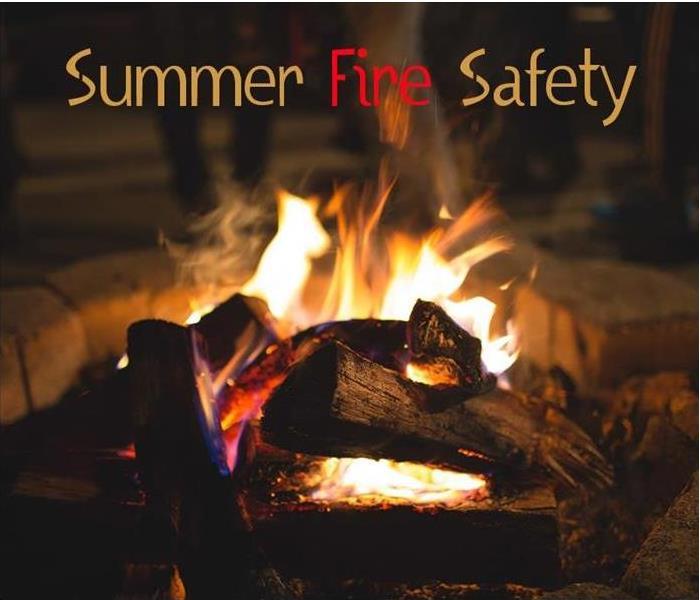 Summer Fire Safety
Summer Fire Safety
Summer Fire Safety Tips From FEMA
Release date: June 29, 2011Release Number: R10-11-22SEATTLE, Wash. -- As skies clear and weather turns warmer, Pacific Northwest residents are hoping for glorious weather this Fourth of July. But however the weather turns out, the Federal Emergency Management Agency (FEMA) and the U.S. Fire Administration (USFA) warn that careless handling of fireworks and outdoor grills can ruin parties and picnics -- and entire summers. In 2010, U.S. hospital emergency rooms treated an estimated 8,600 people for fireworks-related injuries, and according to FEMA Regional Administrator Ken Murphy, 73 percent of fireworks injuries occurred between 18 June and 18 July.
"When celebrating the Fourth of July, Americans need to remember to use fireworks, fires and barbecues with care. The best way to enjoy fireworks is to visit public displays held by trained professionals," said Murphy. "Summer holidays should be fun and generate good memories, not pain and remorse. Have fun, but be safe."
FIREWORKS SAFETY TIPS:
If fireworks are legal where you live and you decide to set them off on your own, be sure to follow these important safety tips:
- Observe local laws.
- Keep a bucket of water handy in case of a malfunction or fire.
- Read and follow all warnings and instructions.
- Never allow children to play with or ignite fireworks.
- Be sure other people are out of range before lighting fireworks. Never shoot a firework at or near another person.
- Only light fireworks on a smooth, flat surface away from the house, dry leaves, and flammable materials.
- Never try to relight fireworks that have not fully functioned. Douse and soak them with water and throw them away.
- Never ignite fireworks in a container, especially a glass or metal container.
- Keep unused fireworks away from firing areas.
- Store fireworks in a dry, cool place. Check instructions for special storage directions.
GRILLING FIRE SAFETY TIPS
- Propane and charcoal BBQ grills must only be used outdoors. If used indoors, or in any enclosed spaces such as tents, they pose a fire hazard and a risk of exposing occupants to deadly carbon monoxide poisoning.
- Place the grill a safe distance from lawn games, play areas, and foot traffic. Grills should be positioned at least 10 feet away from siding, deck railing, and out from under eaves and overhanging branches.
- Keep matches, lighters, and starter fluid out of the reach of children in a locked drawer or cabinet.
- Keep children and pets away from the grill area: declare a three-foot "kid-free zone" around the grill.
- Use long barbeque mitts and long-handled grilling tools to protect the chef from heat and flames when cooking.
- Periodically remove grease or fat buildup in trays below the grill so it cannot be ignited by a hot grill.
USFA, part of the Federal Emergency Management Agency, serves the American public and the nation's fire services through training, data collection and analysis, public fire education, and fire protection technology research. For more information, visit: www.usfa.fema.gov. For wildfire preparedness tips, sample preparedness plans and emergency checklists, visit firewise.org or www.fema.gov.
Last Updated: January 3, 2018 - 12:19
Prevent water damage in your home this summer
6/21/2018 (Permalink)
Prevent water damage in your home this summer
This year in Southern MD has seemed to be one of rain and flood. We have seen an above average amount of precipitation in our area which causes flooding all around. We have had 25-30 inches already this year in SOMD alone. With all of this rain and flooding the last place you want to see water is in your home. Here are some tips to help prevent water damage in your home.
- Clean out roof gutters. We know it is always on your to do list and you just brush it off and you’ll get to it next time. On a rainy day a clogged gutter can force water to spill into your homes foundation, through your roof, or down to your basement and can cause serious damage. So next time, make sure that your gutters are cleaned out and if they are too high to reach seek professional help.
- Keep an eye on your water bill. Water pipes are hidden behind your walls and in the floors in your house. If there is a leak you may not know until the damage has been done. Keep an eye on your monthly water bill, if things are starting to look unusual or the cost has gone up it is a pretty good sign you may have a leak somewhere.
- Test your sump pump. Checking your sump pump once a year can prevent water damage to your house. Also test it more frequently during storms to make sure nothing has changed or is broken.
- Fix any water leaks. Whether it is a dripping pipe, a leaking roof, your roof is missing, has loose, or damaged shingles. Fixing these now can save you a costly fix later.
- If you go on vacation, close and lock all doors, windows, skylights, and vents to keep out water and wind. If you are leaving for an extended period of time shut off the gas to the water heater or turn to vacation setting.
If water does make it into your home please do not hesitate to call SERVPRO® of Charles County, 301.753.8313. We are available 24/7 for your emergency needs.
FREE Commercial Emergency Preparedness: Charles County, MD
6/14/2018 (Permalink)
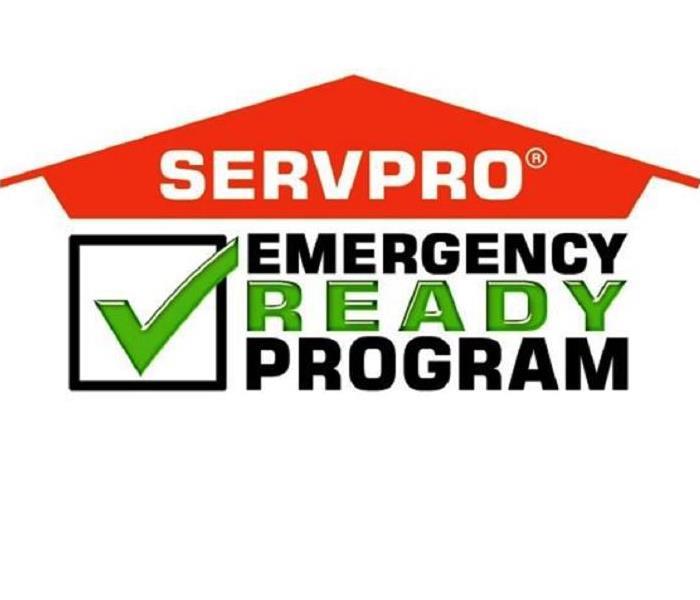 ERP
ERP
Many businesses are not prepared to deal with disaster. Statistics show that 50% of small businesses that close due to disaster NEVER reopen. Small businesses are at such risk due to all of their operations being housed in one central location that is damaged or destroyed. This is why Emergency planning is vital to the success and continuation of small businesses.
Most storms and other natural disasters approach with notice which allows for some advanced planning and preparing. But even in the scenario where advance notice is not provided SERVPRO’s Emergency Ready Plan (ERP) can help. SERVPRO’s ERP provides all necessary information about your business and building that you would need to be able to respond immediately. In the face of a disaster immediate response is vital to getting you back to business.
SERVPRO’s ERP outlines all of your company contacts, utility companies and account information as well as important building information. You may ask how is SERVPRO’s ERP different than having all of this information in a file? Well let me explain. SERVPRO’s ERP compiles all important information in ONE document, which means not sifting through a stack of papers. This document is with you wherever you go! How? SERVPRO® developed the READY PLAN app so you can carry and electronic copy of your ERP with you always. As a business owner or even a manager what happens if you are on vacation and disaster strikes?? With the READY PLAN app you can email a copy of your ERP to anyone so they know who to call and what steps to take. Let’s say disaster strikes with no advance notice and you cannot get into the building to access your paper copy of the ERP! NO PROBLEM! If you have your cell phone, computer or tablet you have your ERP.
Now that you have a clear understanding of the SERVPRO® ERP, would you believe me if I told you it was FREE? SERVPRO® of Charles County doesn’t just want to help you after disaster strikes, we want to make sure that you are prepared in the face of disaster. This is one of the many ways we believe in giving back to our community and making sure that businesses thrive around us!
CONTACT US TODAY TO SCHEDULE YOUR FREE ERP! 301.753.8313
2018 US Summer Forecast
6/14/2018 (Permalink)
2018 US summer forecast: Early tropical threat may eye South; Severe heat, drought to bake southern Plains
By Jillian MacMath, AccuWeather staff writer
May 02, 2018, 8:01:15 AM EDT
Share this article:
The Northeast and mid-Atlantic are in for a bit of everything this summer as the weather transitions between hot, humid and stormy.
Meanwhile, the southern United States will endure persistent storms and the threat for an early tropical impact.
In the Southwest and California, building heat and dryness will pose a high risk for wildfires.
Summer to bring heat, humidity and severe weather to Northeast, mid-Atlantic
From heat to humidity and severe weather, the Northeast and mid-Atlantic are set to experience a bit of everything this summer.
A few hot periods will take hold throughout the summer, though it won’t be persistent.
“I think there’s going to be surge later in June when we really start to feel some heat here in the Northeast. But will it stick around the whole summer? I don’t think that’s going to happen,” AccuWeather Expert Long-Range Forecaster Paul Pastelok said.
I-95 cities, including New York City, Boston and Philadelphia, are predicted to average close to normal with respect to the number of 90-degree days.
“Humidity-wise they’ll have to watch out for August. That may be up a little bit,” he said.
Severe weather could strike the northern mid-Atlantic states and eastern Ohio in June.
In July, that risk will shift farther northward.
Showers and thunderstorms to target the Southeast, Tennessee Valley, Gulf Coast
A barrage of showers and thunderstorms will target the Southeast, with Florida set to bounce back from severe drought conditions.
“They’re going to see some more action across the peninsula throughout the summer, which is good for them. I don’t see any dry conditions developing like we saw a couple of years ago,” Pastelok said.
Heavier storms will pose a risk for flooding with the Tennessee Valley and central Gulf coast facing the greatest threat.
Meanwhile, the entire region will be at risk for an early tropical impact.
“The last several years we’ve seen early tropical hits. I don’t see anything against that this year. Whereabouts? That’s a tough call. Anywhere is possible along the Gulf coast this year,” Pastelok said.
If a tropical system does impact the region, it’s more likely to be a tropical storm which would pose a greater risk for flooding rainfall, he said.
Severe weather to threaten the western Ohio Valley, Midwest, central/northern Plains
Short-term periods of high heat will blast the region in June, though temperatures will bounce up and down throughout the summer.
Severe weather will also target the first month of the season.
“June, I think, will be the month for the severe weather in the northern Plains,” Pastelok said. “It could linger a bit into July, but it will take a break before coming back in August.”
Stifling heat, drought to grip the southern Plains
Severe drought is predicted to continue across the southwestern Plains as intense heat dominates the summer.
June could end up being one of the top-five hottest on record for the region.
“Places like Dallas, Amarillo, Oklahoma City, those places are going to record above-normal temperatures and below-normal precipitation this summer,” Pastelok said.
The forecast could spell bad news for cattle farmers and consumers alike.
“The Plains drought could have an effect on agriculture and grazing for cattle,” Pastelok said. “The grass is not going to grow as much, so farmers are going to end up spending more on feed.”
High fire threat for the Southwest, California as heat and dryness build
Heat and drought will also stretch into the Southwest and California.
The fire threat in both of places will arrive early then remain high for a good part of the summer before rainfall increases into July and August.
Flash flooding is possible as precipitation increases for the interior Southwest and the central Rockies around the midpoint or latter half of the season.
Typical summer to transpire in Northwest, Rockies
Following a typical pattern for the Northwest and Rockies, late spring and early summer will remain mostly wet and cool.
The transition to warmer and drier summer weather won’t arrive until later in the season.
As the warmth increases in mid-July and August, drought conditions may develop east of the Cascades.
This could result in the threat for fires from late summer and into the fall season.
Prepare for Spring Weather
4/13/2018 (Permalink)
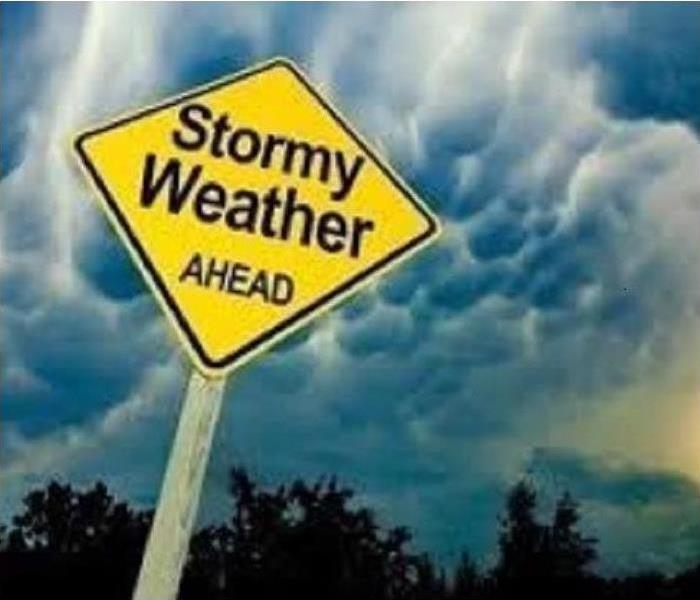 Spring Storms
Spring Storms
Prepare for Spring Weather
Spring is the time of year when many things change—including the weather. Temperatures can swing back and forth between balmy and frigid. Sunny days may be followed by a week of stormy weather. Sometimes extreme weather changes can occur even within the same day. Mark Twain once said, “In the spring I have counted one hundred and thirty-six kinds of weather inside of four and twenty hours.”
Thunderstorms cause most of the severe spring weather. They can bring lightning, tornadoes, and flooding. Whenever warm, moist air collides with cool, dry air, thunderstorms can occur. For much of the world, this happens in spring and summer.
Because spring weather is so unpredictable, you may be unprepared when severe weather hits—particularly if you live in a region that does not often experience thunderstorms, tornadoes, or flooding. And when severe weather hits unexpectedly, the risk of injury and death increases. So planning ahead makes sense; prepare for storms, floods, and tornadoes as if you know in advance they are coming, because in the spring, they very likely will.
Advance planning for thunderstorms, lightning, tornadoes, and floods requires specific safety precautions. You can follow many of the same steps that you would for all extreme weather events. Keep an emergency kit on hand. Some items to include are:
- A battery-operated flashlight, a battery-operated NOAA Weather Radio, and extra batteries for both
- An emergency evacuation or shelter plan, including a map of your home and, for every type of severe weather emergency, routes to safety from each room
- A list of important personal information, including:
- telephone numbers of neighbors, family, and friends
- insurance and property information
- telephone numbers of utility companies
- medical information
- According to the American Red Cross a first aid kit may include:
- non-latex gloves
- assortment of adhesive bandages
- antibiotic ointment
- sterile gauze pads in assorted sizes
- absorbent compress dressings
- tweezers
- scissors
- adhesive cloth tape
- aspirin packets (81 mg each)
- first aid instruction booklet
(NOTE: Customize your first aid kit to meet your individual and family needs.)
- A 3–5 day supply of bottled water and nonperishable food
- Personal hygiene items
- Blankets or sleeping bags
- An emergency kitin your car
Prepare your family members for the possibility of severe weather. Tell them where to seek appropriate shelter as soon as they are aware of an approaching storm. Practice your emergency plan for every type of severe weather. Show family members where the emergency supplies are stored, and make sure they know how to turn off the water, gas, and electricity in your home.
Often by the time we are aware of an approaching storm, we have little if any time to prepare for it. But we do know that when spring arrives, thunderstorms, tornadoes, and floods are real possibilities. So why not take the surprise factor out of severe weather and prepare yourself, your family, and your home? If thunderstorms, tornadoes, and floods do occur, you’ll be ready for them.
Mold Allergy Peak in Spring
3/30/2018 (Permalink)
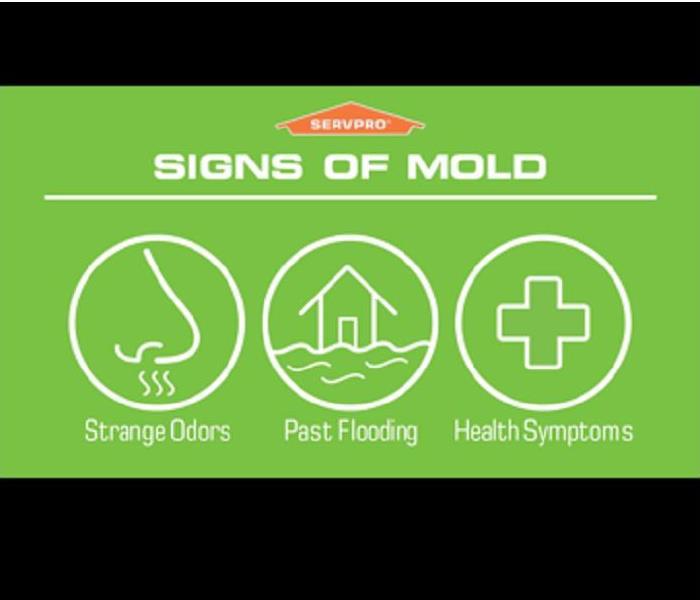 Signs of Mold
Signs of Mold
Mold Allergy Peak in Spring
by ALLERGY GUY
Mold allergy problems increase in the spring. This can be confused with a pollen allergy, but they are quite different.
You may be suffering from both, to make matters worse.
What can you do about it?
Mold is around all year because it grows indoors as well as outside. If you live far enough north to experience winter temperatures below freezing, mold allergies are usually less of a problem during those months.
Mold does not grow outside when it is frozen, and the drier air inside from heating reduced mold growth in your house as well.
Outside is a a different matter.
As temperatures increase, the mold begins to wake up. I’ve seen mold growing on top of snow as it melts, and under the snow, so that its already growing on the grass even before you can see the grass.
All of this aggravates your mold allergy
Last year’s leaf litter is this spring’s mold bed. There is no getting away from it.
Allergy shots may help with your mold allergy. See your allergist about this in the winter so that you’re already taking the shots before the spring mold season.
Open the windows for fresh air in the evening when temperatures are lower and the mold less active, then close them during the day. This is the opposite of what you should do in the summer in some cases.
Make sure the fresh air intake damper for forced air heating is turned off during the spring. Do open it during the summer and winter.
Reduce your humidifier setting to maintain a drier atmosphere inside. This discourages mold growth in your home.
Keeping your house a bit warmer in the spring may also help.
Spring can be a bad time for mold allergies, so do your best to avoid mold problems.
SERVPRO's FREE Emergency Ready Profile
3/1/2018 (Permalink)
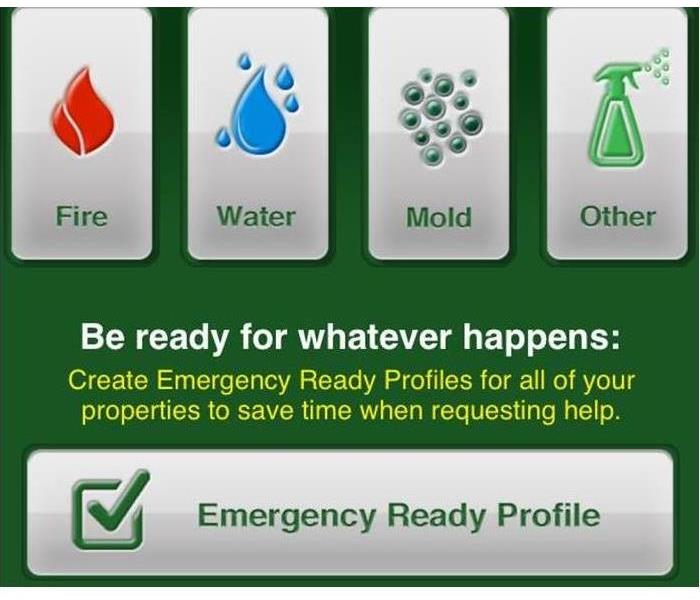 ERP
ERP
It is estimated that up to 50% of businesses that close due to a disaster, such as fire and flood never reopen! Of the businesses that survive, the overwhelming majority of them had a preparedness plan in place.
Are you “Ready for whatever happens?”
Preparation is a key component for making it through any size disaster, whether it’s a small water leak, a large fire, or an area flood. The best time to plan for such events is not when the event happens, but well before it happens.
The SERVPRO® Emergency READY Profile serves as a quick reference of important building and contact information or can be an ideal supplement to any well-designed emergency preparedness or existing contingency program. Rather than simply reacting to disaster situations, most prefer proactive measures to establish a relationship with a restoration services company.
By working with SERVPRO® of Charles County to develop your personalized Emergency READY Profile your business will receive the benefit of over 40 years of experience in reducing the impact of any natural or man-made disaster. SERVPRO® is a leader in water and fire damage response and can help you quickly get your property back in working order.
Call Lauren at 301.753.8313 Today for a No Cost Assessment
of Your Facility!
Helping you to be “Ready for whatever happens,”
SPRINGTIME TIPS TO REDUCE FIRE RISK
3/1/2018 (Permalink)
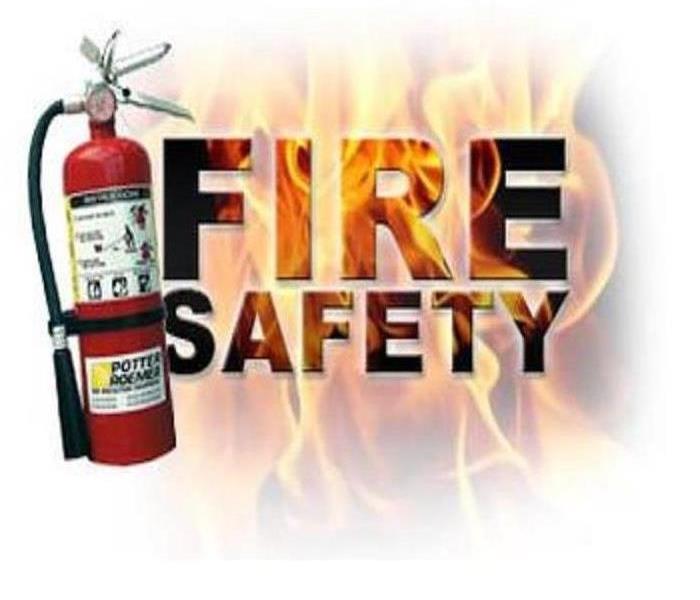 Fire Tips
Fire Tips
SPRINGTIME TIPS TO REDUCE FIRE RISK
We have come a long way in preventing house fires and their associated injuries and deaths over the last 40 years. For example, in 1977, 723,500 house fires resulted in nearly 5,900 civilian deaths and $10.2 billion in damage. In 2013, there were just 369,500 house fires, 2,700 civilian deaths and $6.8 billion in property damage. Within our individual communities and neighborhoods, we need to do everything we can to bring those numbers down even further.
There is no way to eliminate house fires completely. However, there are steps we can all take to make our homes safer and to reduce the risk of injuries and deaths should a house fire occur.
Spring is a great time to start thinking about fire safety. You are already in spring cleaning mode, so why not take the spring months to do some simple things that can reduce your fire risk. Below are some easy-to-implement tips along with a brief explanation of how wireless home security can help.
Check Your Smoke Alarms
Fire departments around the country take advantage of the start of daylight saving time to encourage people to check the batteries in their smoke alarms. Your smoke alarm should have a test button that you simply press to make sure the battery is working. If not, replace the battery with a fresh one.
If your smoke alarms are hardwired to your home’s electrical system, they still need to be checked. They can fail from time to time. Also, be aware that sometimes hardwired smoke alarms are temporarily disconnected for whatever reason. Make sure yours are not.
Check Electrical Outlets and Cords
Electrical outlets and cords take a beating during the winter months because we are inside for longer hours, resulting in more frequent use of electrical appliances. While you clean, give each of your outlets (and the cords plugged into them) a quick inspection to make sure everything is okay. Do the same for exterior electrical outlets as well. They can sometimes suffer damage from winter weather.
Replace Extension Cords
If you have been utilizing extension cords in your home for long-term purposes, spring is the time to change that. Extension cords are meant to be temporary only. So, if you have one that has been plugged in for months, it is better to run wiring to install a new outlet so the extension cord can be eliminated.
Remove Unnecessary Flammables
Your spring cleaning will undoubtedly involve the garage – if you have one. A good thing to pay attention to in the garage is the existence of flammables including gasoline and charcoal lighter fluid. If there are any flammables you no longer need, check with your county or city to make arrangements to properly dispose of them. Those you do intend to keep should be sealed in approved containers and kept in a cool place.
How Wireless Home Security Can Help
If you are not already utilizing home security, spring is a great time to look into it. The most basic of systems usually includes both burglary and fire monitoring at a very reasonable price. The advantage of fire monitoring is that it keeps track of your home even when you are not there. Monitoring also allows for quicker response times because monitoring centers can immediately notify local first responders.
Reducing the risks associated with house fires is no accident. It takes a concerted effort among homeowners to keep themselves and their families as safe as possible. We hope you will utilize these tips in combination with installing a wireless home security system with fire monitoring.
Prevent Frozen and Bursting Water Pipes
1/3/2018 (Permalink)
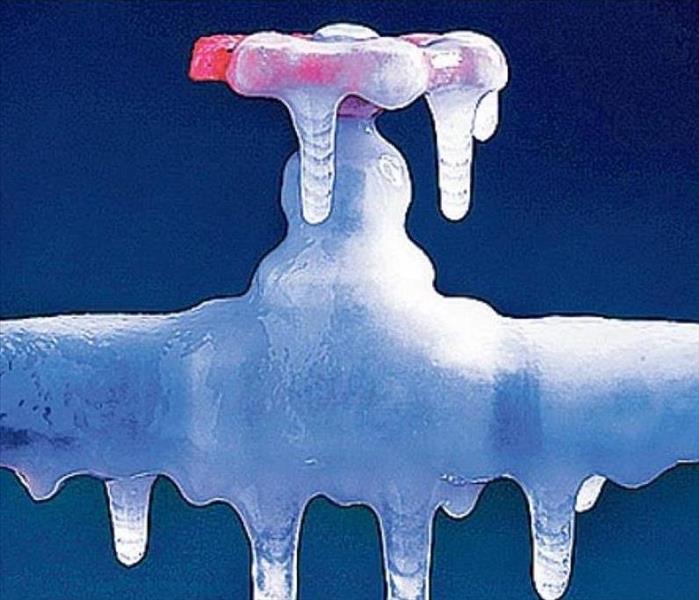 Frozen Pipes
Frozen Pipes
Prevent Frozen and Bursting Water Pipes
Due to the unusually cold weather temperatures, residents are experiencing frozen and busted water pipes. Please be aware that indoor pipes can freeze, depending on temperatures, insulation, and placement in the building. Pipes in attics, above ceilings, in crawl spaces and basements, and near exterior walls are highly vulnerable to freezing, especially where there is poor insulation, wall cracks, or other openings that allow entry of cold outside air.
It is important for owners to know where the main water shut-off valve(s) are located, in case of a pipe break. Never attempt to thaw a frozen pipe with an open flame.
Monitor water-based fire protection systems such as automatic sprinkler systems, fire pumps, hoses and hydrants. These systems must remain heated and ice-free to minimize losses from fire and water damage.
To prevent pipes from bursting or ice formation within the pipes, considerer these preventive measures:
•Always place piping in heated areas of a building.
•Properly insulate attics, exterior walls, and other areas lacking adequate heating.
•Repair broken windows, ill-fitting doors, and other conditions that allow heat loss.
•Keep exterior doors closed, even if not in the immediate vicinity of piping.
•Maintain heat in buildings at all times. No area with piping should be allowed to fall below 40°F (4°C). (This requires regular maintenance, inspection, and servicing of existing heating equipment, and safe emergency measures during a prolonged power failure.)
•Shut off water lines and drain all pipes if the building is to be left unattended for an extended period. (The exceptions are sprinkler systems unless all combustible materials are removed and the building is noncombustible or fire-resistive.)
•Provide insulation around a pipe sufficient to reduce heat loss, or provide heat tracing, if the pipe might be exposed to freezing temperatures.
•Install low temperature alarms (with remote monitoring) in cold-prone areas.
•Adequately maintain and prepare dry-pipe sprinkler systems for cold weather (drain low points, etc.).
•Properly service and winterize private yard hydrants.
•Clear snow and ice from private yard hydrants, outside hose connections, and fire protection system valves to help prevent freezing of these systems.
If adequate heat cannot be maintained, the main domestic water supply valve should be shut off and all water from piping should be completely drained by a qualified plumber. Sprinkler systems and other water-based fire protection systems are a special case. Every effort should be made to keep these systems in service for your safety.
http://www.charlescountymd.gov/news-releases/prevent-frozen-and-bursting-water-pipes-0
Would your business open after a disaster?
12/13/2017 (Permalink)
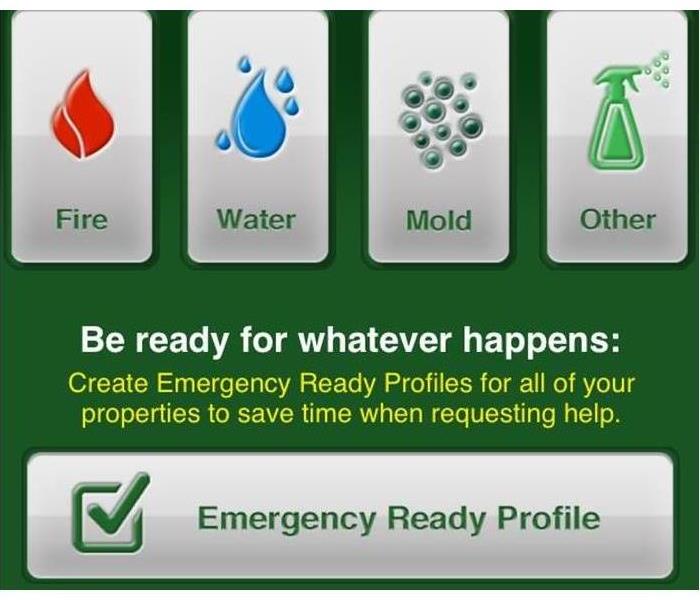 ERP
ERP
Many businesses are not prepared to respond to a man-made or natural disaster. Statistics show that, of the businesses that close because of a disaster, at least one in four never reopens. Small businesses are particularly at risk because they may have all of their operations concentrated in one location that is damaged or destroyed. That is why disaster planning is a critical part of every business’ operational objectives.
By developing a SERVPRO Emergency READY Profile for your business, you minimize business interruption by having an immediate plan of action. Knowing what to do and what to expect in advance is the key to timely mitigation and can help minimize how water and fire damage can affect your business.
- A no cost assessment of your facility.
This means there is no need to allocate funds, giving you a great value at no cost.
- A concise Profile Document that contains only the critical information needed in the event of an emergency.
It will only take a little time to complete and will not take you away from current projects. But it will save a lot of time if ever needed.
- A guide to help you get back into your building following a disaster.
This can help minimize the amount of time your business is inactive by having an immediate plan of action.
- Establishes your local SERVPRO Franchise Professional as your disaster mitigation and restoration provider.
You have a provider that is recognized as an industry leader and close by.
- Identification of the line of command for authorizing work to begin.
This saves time so we can begin the work of mitigating the damage which can save you time and money.
- Provides facility details such as shut-off valve locations, priority areas and priority contact information.
Having a quick reference of what to do, how to do it and who to call provides solutions in advance of an emergency so that during the emergency you are "Ready for whatever happens.
Call 301.753.8313 today to schedule your Emergency Ready Profile!
Ten Things You Should Know about Mold
12/13/2017 (Permalink)
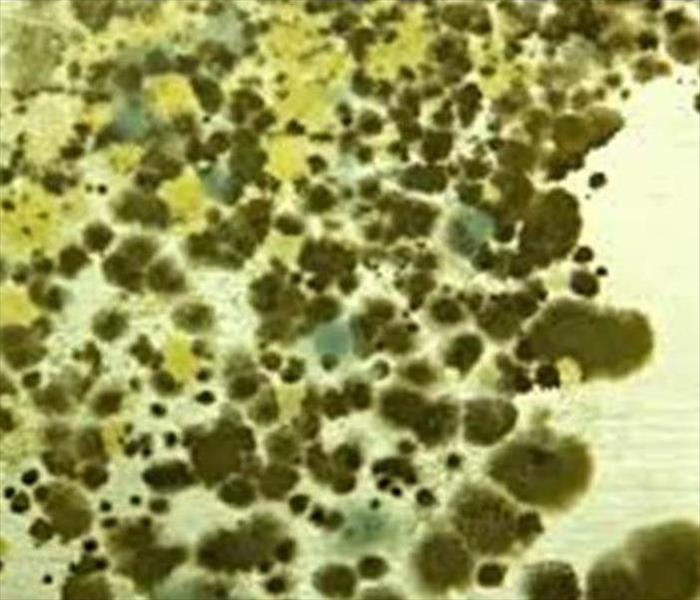 Mold
Mold
Ten Things You Should Know about Mold
- Potential health effects and symptoms associated with mold exposures include allergic reactions, asthma and other respiratory complaints.
- There is no practical way to eliminate all mold and mold spores in the indoor environment; the way to control indoor mold growth is to control moisture.
- If mold is a problem in your home or school, you must clean up the mold and eliminate sources of moisture.
- Fix the source of the water problem or leak to prevent mold growth.
- Reduce indoor humidity (to 30-60%) to decrease mold growth by:
- Venting bathrooms, dryers and other moisture-generating sources to the outside
- Using air conditioners and de-humidifiers
- Increasing ventilation
- Using exhaust fans whenever cooking, dishwashing and cleaning
- Clean and dry any damp or wet building materials and furnishings within 24-48 hours to prevent mold growth.
- Clean mold off hard surfaces with water and detergent, and dry completely. Absorbent materials such as ceiling tiles, that are moldy, may need to be replaced.
- Prevent condensation: Reduce the potential for condensation on cold surfaces (i.e., windows, piping, exterior walls, roof, or floors) by adding insulation.
- In areas where there is a perpetual moisture problem, do not install carpeting (i.e., by drinking fountains, by classroom sinks, or on concrete floors with leaks or frequent condensation).
- Molds can be found almost anywhere; they can grow on virtually any substance, providing moisture is present. There are molds that can grow on wood, paper, carpet, and foods.
Facing Water and Mold after a Fire sounds like a nightmare!
12/2/2017 (Permalink)
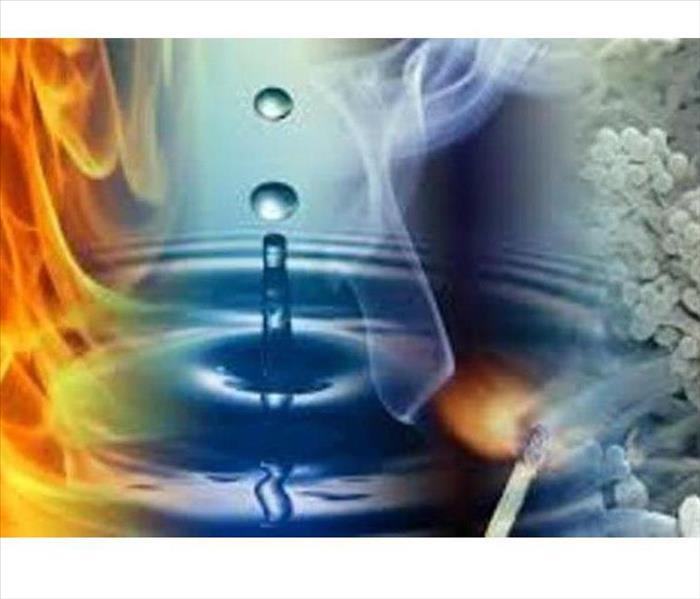 Fire- Water- Mold
Fire- Water- Mold
Facing Water and Mold after a Fire sounds like a nightmare!
So there were some events that occurred in Southern, MD last week that really got my mind thinking. When you think of a Fire breaking out in a home you instantly hope that everyone is safe and that the home is not burnt to the ground. Once you find out that everyone is safe and the home is still standing you tend to have a sigh of relief. Unfortunately there are so many other scenarios that most people do not stop to think about.
So your home catches on fire but your sprinkler system is activated and puts the fire out almost immediately! GREAT! Well not so great. Now you have a home that could have extensive water damage from the sprinklers putting out the fire. WOW! Catch 22! Now you have minimal fire damage but a large water damage!
This is where hiring a professional to handle the work in your home is so important. You need to make sure that they can not only handle the Fire but the Water damage as well. As we all know if water damage is not treated properly it could result in microbial growth! (MOLD) This then opens another wound in an already frustrating scenario.
Here at SERVPRO® Charles County we hate to see anyone experience these losses but we also are glad that we can be of service during these difficult scenarios. Sometimes people just need someone to listen to them vent and tell them that it will be ok. Here at SERVPRO® we are ALWAYS “Here to Help.”
IICRC Mold Remediation: What Happens After a Flood?
11/30/2017 (Permalink)
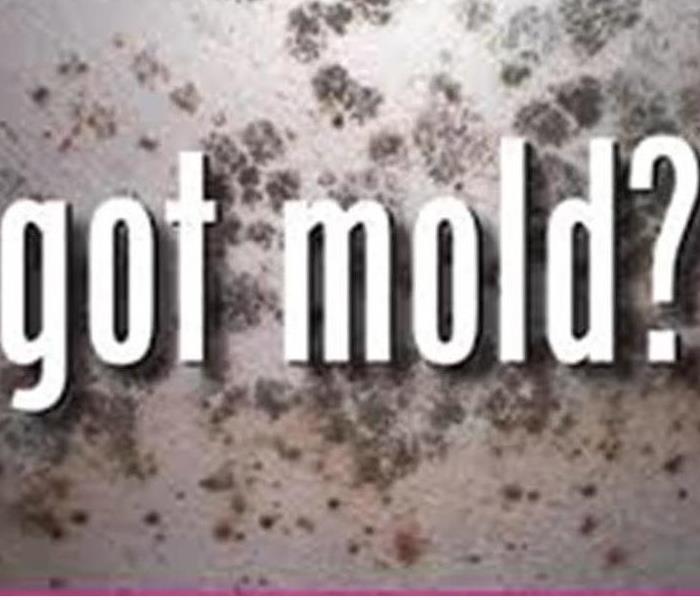 Mold
Mold
IICRC Mold Remediation: What Happens After a Flood?
Have you ever wondered what happens when a mold removal specialist gets called to a mold-damaged facility? The Institute of Inspection, Cleaning and Restoration Certification (IICRC) shares five steps a mold removal specialist takes when conducting mold remediation.
“Many people aren’t aware of the dangers, nor the difficulty level of removing mold from a facility,” said IICRC Chairman Tony Wheelwright. “Mold remediation is a potentially hazardous process that should only be undertaken by a certified professional.”
Five steps that each mold-removal specialist takes when conducting mold remediation includes:
- Determine the degree of contamination. The first step for a mold remediation specialist may be to bring in an Indoor Environmental Professional (IEP) to determine the extent of the mold damage and test for contamination within the facility. Because mold spores and other microscopic contaminants can travel easily throughout a building, the IEP may collect and analyze samples from affected as well as unaffected areas of the building. Once the IEP has finished the inspection they will develop a remediation plan for the mold removal specialist with steps to return the home to its preloss condition (Condition 1).
- Set up and verify containment. To make sure mold contamination does not spread to other areas of a facility, the mold remediation specialist will set up containment by creating isolation barriers. Once the barriers are set up, the specialist will need to verify the containment with a lower partial pressure differential (negative pressure) to ensure there is no air leakage between containment zones. Exit chambers would then be used to serve as a transition between the containment and the unaffected area of the building. Once the containment is verified and the correct amount of pressure is achieved, the removal process can begin.
- Remove unsalvageable materials. Porous materials and items that cannot be restored or cleaned effectively must be carefully discarded. Unsalvageable items include but are not limited to drywall, insulation and other items with visible mold growth. It is important for the specialist to wear the appropriate personal protective equipment which may include a full face respirator equipped with a P100/OV cartridge, disposable coveralls and nitrile gloves.
- Clean surfaces with a high-attention to detail. A mold remediation specialist will likely begin the cleaning process by thoroughly vacuuming the contaminated areas using a HEPA vacuum with a high-efficiency filter to catch mold spores. He or she will then begin a detailed cleaning process involving mold removal tools such as a HEPA filtered sander, followed by the damp wiping of surfaces with an effective cleaning solution.
- Verify remediation. Once cleaning is complete, the IEP will return to too to verify the remediation was successful. The area must be returned to the dry standard and should be visually dust free with no malodors. In addition an IEP may perform surface or air sampling as part of the verification that the area is back to normal fungal ecology (Condition 1).
“Mold remediation requires mold removal specialists to perform techniques that promote source removal rather than relying on chemicals, paints and coatings as a replacement,” said Rachel Adams, President of Indoor Environmental Management, Inc. “Understanding and managing air flow is also critical to the success of a mold remediation project. Working with qualified IEP can also help to reduce the liability for the technician as well as provide a final determination if the remediation was successful.”
For more information on mold remediation or the latest in mold remediation standards, visit the IICRC website at http://www.IICRC.org.
Dangers of Winter Weather- Southern MD
11/29/2017 (Permalink)
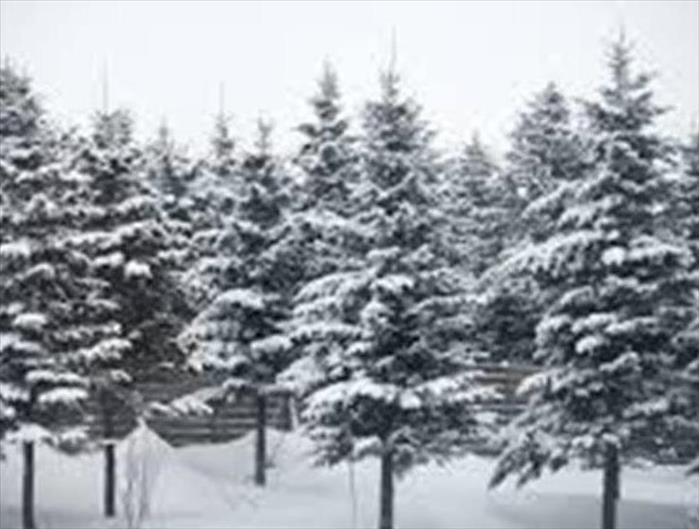 Winter Storm
Winter Storm
There are a number of different ways that winter storms can impact a region and the people who live there. Winter storms are considered deceptive killers because most deaths are not directly related to the storm itself. People could get in an automobile accident on icy roads, have a heart attack while shoveling snow, or suffer frostbite or hypothermia from prolonged exposure to the cold.
Wind - Some winter storms have extremely strong winds that can create blizzard conditions with blinding, wind driven snow, drifting, and dangerous wind chills. These intense winds can bring down trees and poles, and can also cause damage to homes and other buildings.
Snow - Heavy snow accumulations can immobilize a region and paralyze a city, strand motorists, stop the flow of supplies, and disrupt emergency services. Buildings may collapse, and trees and power lines can be destroyed from heavy snow. In rural regions, homes and farms may be isolated for days, and livestock could be lost.
Ice - Heavy ice accumulations can bring down objects like trees, utility poles and lines, and communication towers. Power can be disrupted or lost for days while utility companies repair the damage. Even a small amount of ice can cause hazardous conditions for motorists and pedestrians.
Cold - Extremely cold temperatures can accompany winter storms and be left in their wake. Infants and the elderly are most susceptible to prolonged exposure to the cold, which can cause potentially life-threatening conditions such as hypothermia and frostbite. Below freezing temperatures can damage vegetation and cause pipes to freeze and burst inside homes. Exposure to cold can cause frostbite or hypothermia and become life-threatening.
What constitutes extreme cold varies in different parts of the country. In the South, near freezing temperatures are considered extreme cold. In the North, extreme cold means temperatures well below zero. Freezing temperatures can cause severe damage to citrus fruit crops and other vegetation. Pipes may freeze and burst in homes that are poorly insulated or without heat.
Wind Chill is not the actual temperature, but rather how wind and cold actually feel on exposed skin. As the wind increases, heat is carried away from the body at an accelerated rate, driving down the body temperature. Animals are also affected by wind chill; however, cars, plants and other objects are not.
Frostbite is damage to body tissue caused by extreme cold. A wind chill of -20° Fahrenheit (F) with light winds will cause frostbite in just 30 minutes. Frostbite causes a loss of feeling and a white or pale appearance in extremities, such as fingers, toes, ear lobes or the tip of the nose. If symptoms are detected, get medical help immediately! If you must wait for help, slowly re-warm affected areas.
However, if the person is also showing signs of hypothermia, warm the body core before the extremities. Hypothermia is a condition brought on when the body temperature drops to less than 95°F, and it can kill. For those who survive, there is likely to be lasting damage to the kidneys, liver and pancreas. Warning signs include uncontrollable shivering, memory loss, disorientation, incoherence, slurred speech, drowsiness and apparent exhaustion. Take the person’s temperature. If below 95°F, seek medical care immediately!
If Medical Care is Not Available, warm the person slowly, starting with the body core. Warming the arms and legs first drives cold blood toward the heart and can lead to heart failure. If necessary, use your body heat to help. Get the person into dry clothing and wrap them in a warm blanket, covering the head and neck. Do not give the person alcohol, drugs, coffee, or any hot beverage or food. Warm broth is an excellent choice.
SERVPRO® of Charles County: Supporting the community you SERV!
11/21/2017 (Permalink)
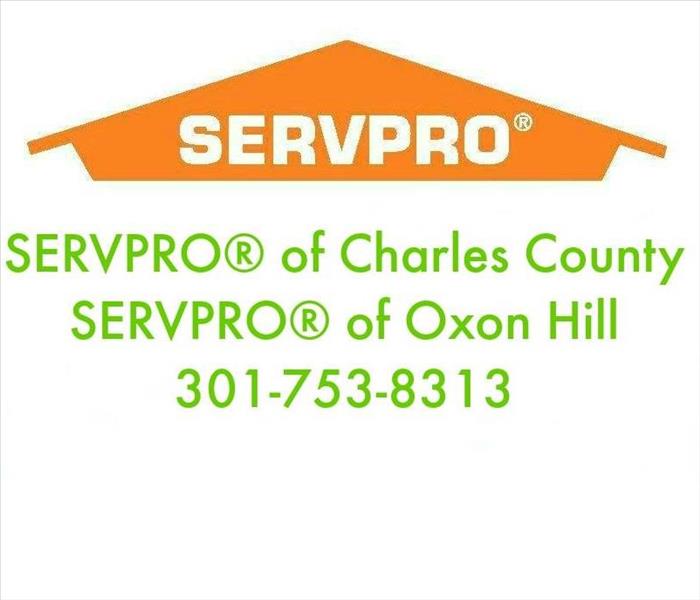 #SERVPROsmiles
#SERVPROsmiles
One of our core principals here at SERVPRO® is supporting the community you SERV! We are blessed to be a part of our community and feel as if we should give back, not just through the holidays but all year long. We thought about this and found 3 organizations that we will be helping throughout the year and are so excited about these partnerships. The three organizations we have chosen are Children’s Aid Society, The Arnold House and Sacred Heart Parish. These three organizations do so much within our community that we were excited to get involved!
The Children’s Aid Society
The mission of the Charles County Children’s Aid Society, Inc. a 501 (c) (3) non-profit human service agency, is to improve the quality of life for struggling Charles County families with children under age 18 by providing them with the basic necessities of life including, but not limited to, clothing, food, and holiday assistance. Servicing Charles County since 1934.
The Arnold House
The Arnold House is a “Boots on the Ground” grassroots not for profit organization dedicated to raising awareness on the plight of homelessness and hunger in Southern Maryland. We partner with citizens, commercial businesses, public and private organizations to deliver meals and other basic necessities to those in need.
Sacred Heart La Plata
Loretta and Mary’s Pantry will be hosting food distributions for those in need that will offer various fresh produce items and meats from the Pantry on the Go Program through the Maryland Food Bank.
#SERVPROsmiles
Timeline of Smoke/Fire Damage
11/16/2017 (Permalink)
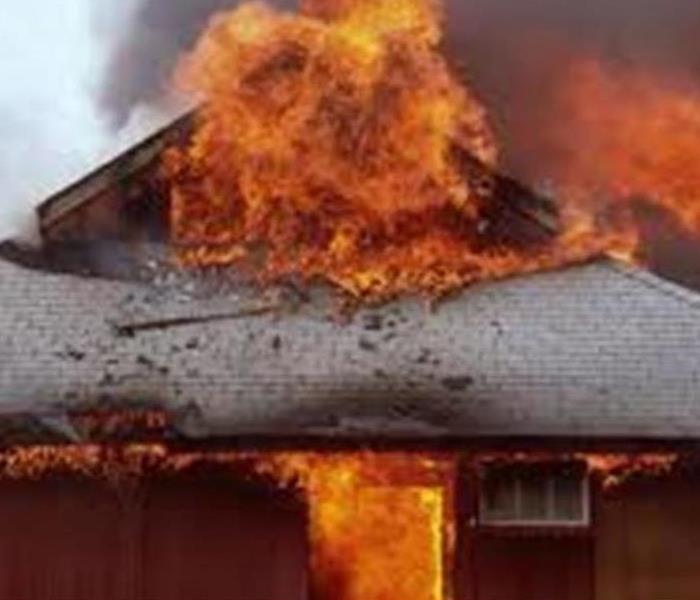 FIRE
FIRE
Timeline of Smoke/Fire Damage
In the wake of a fire that has covered homes with smoke and ash, it’s important to begin clean up as soon as possible in order to prevent permanent damage or discoloration from soot residue. The IICRC provides the following tips for fire victims facing clean up:
- Practice safety first. Use a dust mask (like painters use) and gloves as you work.
- Ventilate the home. Place a box fan in an open window to draw the air and dust out.
- Clean from top to bottom. Start with the ceilings, walls and fixtures, and work your way down to the contents of the room, then to the floor.
- Vacuum floors and upholstery. Make sure your vacuum cleaner has a high efficiency filter. Otherwise, you risk blowing soot back into the air.
- Some draperies, clothing and machine-washable items may be laundered. Use a mild alkaline cleaner to neutralize the acid in the soot. Fine clothing should be dry cleaned.
- Most exterior walls (brick, stone, wood, paint, siding) and eaves can be cleaned by spraying with a detergent, agitating soot with a soft-bristled brush, pressure washing from bottom to top, then rinsing from top to bottom.
- If the damage and residue are heavy, it may be best to hire a professional to thoroughly restore your home and belongings.
- Check with your insurance company to see if smoke damage from outdoor sources is covered by your policy.
- If the fire has warped or distorted the structure, consult a licensed general contractor.
Professional restoration technicians know that damage increases and restoration costs escalate the longer neutralization, corrosion control and cleaning is delayed. When homeowners prolong the restoration of their home, they extend the effects brought on by the smoke exposure. The following is a timeline of the effects of fire and smoke on a home.
Within Minutes: Acid soot residues cause plastics to yellow; small appliances located close to the source of combustion discolor; highly porous materials (marble, alabaster) discolor permanently.
Within Hours: Acid residues stain grout in bathrooms; fiberglass bath fixtures may yellow; uncoated metals tarnish, counter tops may yellow; finishes on appliances, particularly refrigerators, may yellow; furniture finishes may discolor.
Within Days: In time, acid residues cause painted walls to yellow permanently; metal corrodes, pits and rusts; wood furniture requires refinishing; vinyl flooring requires refinishing or replacement; clothing becomes soot stained; upholstery stains permanently.
Within Weeks: Restoration costs escalate tremendously. Synthetic carpet fibers may yellow or discolor permanently; silver plate is corroded permanently; glass, crystal, china may require replacement due to severe etching and pitting caused by prolonged exposure to acid soot residues.
Cleaning up soot residue must be done as quickly as possible. During combustion, soot residue and volatile vapors are carried by rising and expanding air to surfaces throughout a structure, and are deposited. This process occurs repeatedly until combustion ends, with soot residue building up on surfaces layer by layer. By the time restoration technicians arrive, lacquer-like soot residue may be quite difficult to dissolve and remove.
In addition to removing residue, ridding your home of its smoky odor is necessary. Professionals use this four-step process to remove odors:
- Remove the source of the odor, as possible, including unsalvageable debris that contributes to odor generation and recontamination of cleaned and deodorized areas.
- Clean salvageable surfaces and items to physically remove odor-causing residue.
- Chase remaining odor with an odor counteractant. In the case of smoke, create a deodorizing fog or gas that seeks out and combines with odor-causing substances.
- Seal salvageable surfaces that are inaccessible or slightly scorched, not only for aesthetic purposes, but primarily to encapsulate odor and prevent progressive recontamination.
Understanding the effects of a fire can help homeowners evaluate the damage to their home. By learning more about residue clean-up and deodorization after a fire, you can minimize the need for costly repair. Fire and smoke restoration experts can help you return your home and furnishings to a “preloss” condition.
Dangers of Winter Weather
11/6/2017 (Permalink)
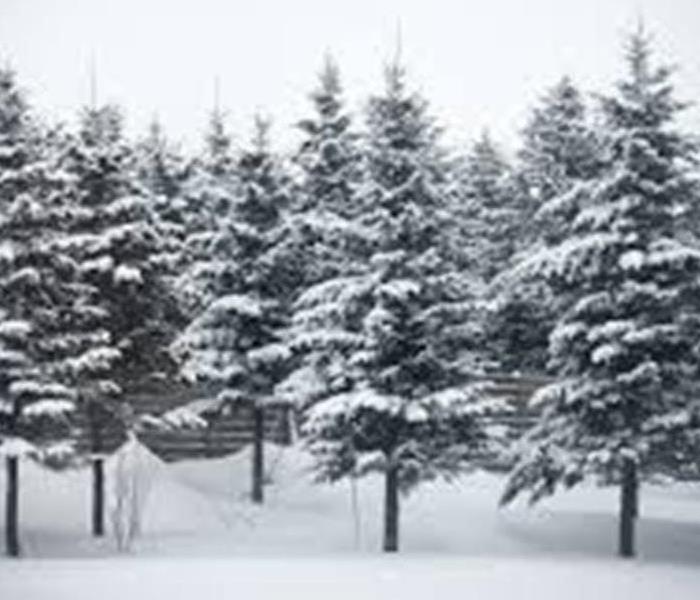 Winter Storm
Winter Storm
There are a number of different ways that winter storms can impact a region and the people who live there. Winter storms are considered deceptive killers because most deaths are not directly related to the storm itself. People could get in an automobile accident on icy roads, have a heart attack while shoveling snow, or suffer frostbite or hypothermia from prolonged exposure to the cold.
Wind - Some winter storms have extremely strong winds that can create blizzard conditions with blinding, wind driven snow, drifting, and dangerous wind chills. These intense winds can bring down trees and poles, and can also cause damage to homes and other buildings.
Snow - Heavy snow accumulations can immobilize a region and paralyze a city, strand motorists, stop the flow of supplies, and disrupt emergency services. Buildings may collapse, and trees and power lines can be destroyed from heavy snow. In rural regions, homes and farms may be isolated for days, and livestock could be lost.
Ice - Heavy ice accumulations can bring down objects like trees, utility poles and lines, and communication towers. Power can be disrupted or lost for days while utility companies repair the damage. Even a small amount of ice can cause hazardous conditions for motorists and pedestrians.
Cold - Extremely cold temperatures can accompany winter storms and be left in their wake. Infants and the elderly are most susceptible to prolonged exposure to the cold, which can cause potentially life-threatening conditions such as hypothermia and frostbite. Below freezing temperatures can damage vegetation and cause pipes to freeze and burst inside homes. Exposure to cold can cause frostbite or hypothermia and become life-threatening.
What constitutes extreme cold varies in different parts of the country. In the South, near freezing temperatures are considered extreme cold. In the North, extreme cold means temperatures well below zero. Freezing temperatures can cause severe damage to citrus fruit crops and other vegetation. Pipes may freeze and burst in homes that are poorly insulated or without heat.
Wind Chill is not the actual temperature, but rather how wind and cold actually feel on exposed skin. As the wind increases, heat is carried away from the body at an accelerated rate, driving down the body temperature. Animals are also affected by wind chill; however, cars, plants and other objects are not.
Frostbite is damage to body tissue caused by extreme cold. A wind chill of -20° Fahrenheit (F) with light winds will cause frostbite in just 30 minutes. Frostbite causes a loss of feeling and a white or pale appearance in extremities, such as fingers, toes, ear lobes or the tip of the nose. If symptoms are detected, get medical help immediately! If you must wait for help, slowly re-warm affected areas.
However, if the person is also showing signs of hypothermia, warm the body core before the extremities. Hypothermia is a condition brought on when the body temperature drops to less than 95°F, and it can kill. For those who survive, there is likely to be lasting damage to the kidneys, liver and pancreas. Warning signs include uncontrollable shivering, memory loss, disorientation, incoherence, slurred speech, drowsiness and apparent exhaustion. Take the person’s temperature. If below 95°F, seek medical care immediately!
If Medical Care is Not Available, warm the person slowly, starting with the body core. Warming the arms and legs first drives cold blood toward the heart and can lead to heart failure. If necessary, use your body heat to help. Get the person into dry clothing and wrap them in a warm blanket, covering the head and neck. Do not give the person alcohol, drugs, coffee, or any hot beverage or food. Warm broth is an excellent choice.
SEWAGE BACK-UPS TIPS
11/2/2017 (Permalink)
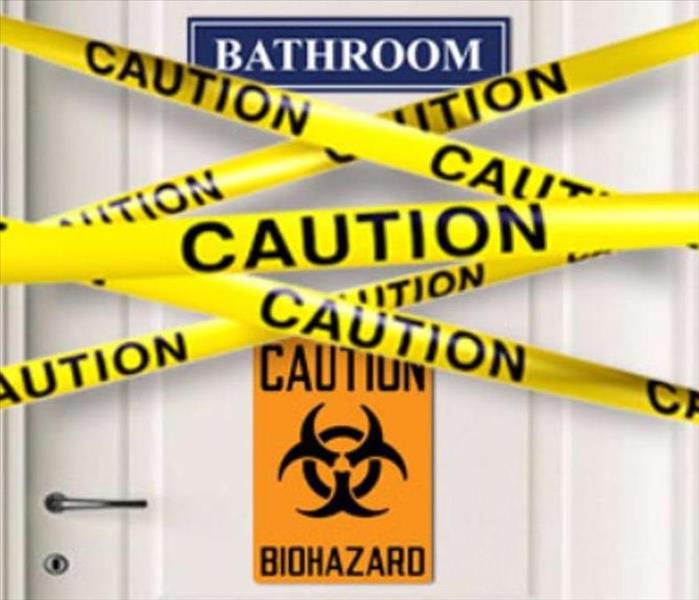 SEWAGE BACK-UP
SEWAGE BACK-UP
SEWAGE BACK-UPS TIPS
Sewage is one of the most dangerous substances to enter homes or buildings. It contains fungi, bacteria and viruses, many of which are disease-causing. Unfortunately, many people fail to understand the hazards that sewage presents, particularly for the very young or very old, or for those with compromised immune systems or respiratory problems.
The IICRC complied guidelines for professional sewage clean-up called the Standard for Water Damage Restoration (S500).
Here are the key principles homeowners should know about sewage back-ups:
- Sewage contains a variety of pathogenic – disease causing – fungi, bacteria, viruses and parasites. Anyone who works on sewage losses must have updated vaccinations, including one for Hepatitis B.
- Sewage exposure is particularly dangerous for people with weakened immune systems, including anyone under two or over 60, those who are pregnant, ill, recovering from surgery, on prescription drugs or chemotherapy, or are AIDS victims.
- It is not safe to stay in a building that’s flooded with sewage unless the contaminated area can be completely sealed off and placed under controlled air flow so that there will be no cross contamination of unaffected areas.
- Highly absorbent sewage-saturated materials, such as carpet, pad, upholstery, bedding, wicker, paper or even fabrics that can’t be washed in hot water (130°F/54°C) for at least 10 minutes, must be contained and disposed of properly. This goes for sewage-saturated drywall, insulation and several other structural materials too. There’s simply too great a health risk involved if any of these materials are dried in place and cleaned only.
- Only the most highly trained professionals should attempt sewage remediation work. Then, a “third party” indoor environmental professional can provide post-remediation verification or “clearance testing” to ensure that the home or building is safe to re-occupy.
Charles County- Fire Safety
10/27/2017 (Permalink)
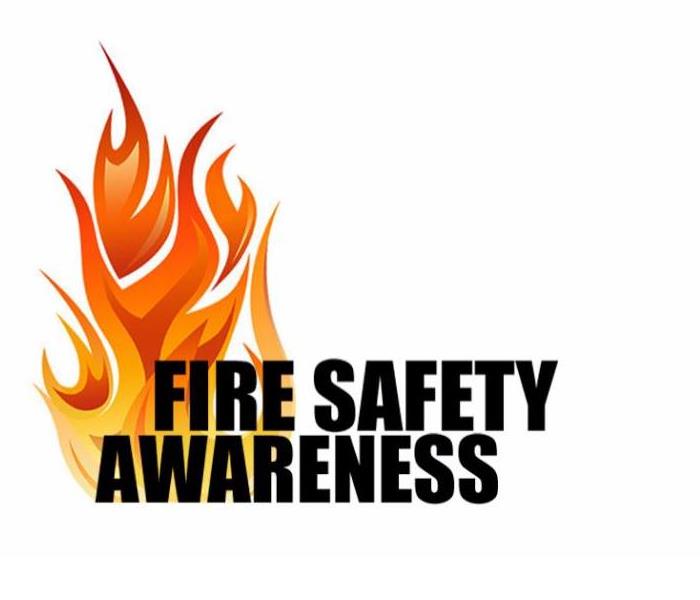 Fire Safety
Fire Safety
This week I was alerted to an unoccupied house fire in our area and as I arrived on scene it was still an active fire. As I sat down the street (out of the way) my eyes began to fill with tears. The images of the brave men and women working to contain and stop this fire brought back memories of a fire I personally went through and a flood of emotions. There were your typical emotions such as fear, sadness and hope but there was also a sense of pride. I was proud to be a part of a community where our volunteer fire fighters serve selflessly to help others. To see these men and women working together to save this home was amazing. It is not often that we get to see these guys in action and when I did it was amazing, but it also sparked the thought process of fire safety.
SERVPRO® is known for the cleanup and restoration of house fires but we are also proactive in helping create an emergency plan. Safety is very important and we try to talk to everyone about being prepared in case of an emergency. The safety and well being of our community is a vital part of our business. We want people to be knowledgeable, safe and prepared. Does your family have a fire safety plan? Do your kids know EXACTLY what to do and do you practice? If you do not please let us know!
Top Tips for Fire Safety
- Install smoke alarms on every level of your home, inside bedrooms and outside sleeping areas.
- Test smoke alarms every month. ...
- Talk with all family members about a fire escape plan and practice the plan twice a year.
- If a fire occurs in your home, GET OUT, STAY OUT and CALL FOR HELP.
Get a Head Start in Advance of Specific Severe Weather Threats
10/19/2017 (Permalink)
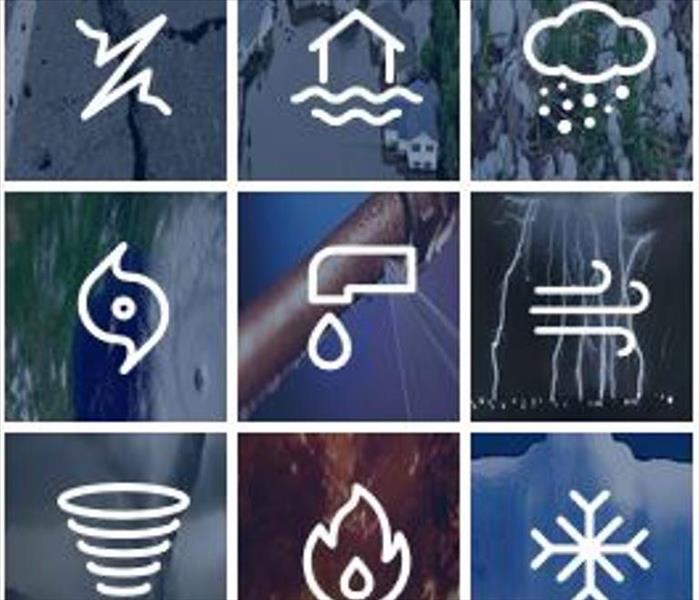 RISK
RISK
Get a Head Start in Advance of Specific Severe Weather Threats
While emergency planning ideally is a twelve-month priority, the start of the severe weather season in your area is a good time to refocus your efforts. This is the time to:
- Designate an employee to monitor weather reports and alert your team to the potential of severe weather.
- Review your business continuity plan and update as needed, including employee contact information.
- Remind employees of key elements of the plan, including post-event communications procedures and work/payroll procedures. Make sure all employees have a paper copy of the plan. Review emergency shutdown and start-up procedures, such as electrical systems, with appropriate personnel, including alternates.
- If back-up power such as a diesel generator is to be used, test your system and establish proper contracts with fuel suppliers for emergency fuel deliveries.
- Re-inspect and replenish emergency supplies inventory, since emergency supplies are often used during the offseason for non-emergency situations.
- Test all life safety equipment.
- Conduct training/simulation exercises for both your business continuity and emergency preparedness/response plans.
5 Days Before Storm Conditions – Start to Focus on What Needs to Get Done
- Notify employees of the potential for severe weather and to be prepared for the emergency plan possibly to be implemented.
- Inspect the roof and grounds for loose debris, which may become a hazard in high winds. If staff or temporary help is available, begin removal of the debris, otherwise the removal may be done at the 72-hour interval.
- Provide a list of storm tips and needed supplies to help your employees prepare their homes and families. The Insurance Information Institute (III) has developed a free “Know Your Plan” app to help families make their own emergency plan; it also features property protection guidance from IBHS. The app is available in iTunes, or by searching “Insurance Information Institute” in the App store from any Apple device.
- Ensure all employees have your business’ designated emergency telephone numbers and key contact other information (i.e., employee emergency wallet card).
72 Hours before Storm Conditions—Time to Activate the Plan
- If not completed already, remove or secure all loose roof and ground items, including landscaping that may become wind-borne debris.
- Clear roof drains, gutters and downspouts of debris, to prevent water back-up
- Clean out all debris from outdoor perimeter drains, especially in areas where water may collect such as shipping and receiving areas where the ground slopes towards the building.
- Fill emergency generators with fuel and contact fuel suppliers with anticipated needs for post-storm deliveries.
- Ensure fire protection systems are in proper working order.
- Notify key customers, suppliers, and partners of office/facility closing and contingency plans (post office, Fed Ex, UPS, cleaning service, building management, vendors, etc.).
- Make decisions on when to excuse employees so that they have sufficient time to prepare their homes and families, and notify employees of office closure details.
- Make any necessary alternative travel arrangements for employees away on business.
- Customize messages for business’ website, telephone recording, employee intranet, etc.
- Decide which outstanding invoices, bills, expense reports, etc. should be paid by your accounts payable department, before a possible closure
- Instruct employees with laptops to take them home at the end of each day and confirm that they can connect to your business’ server from home.
- Remind employees to make sure their cell phones are fully charged and that they have a power cord and car charger.
- Advise employees to begin checking your employee emergency hotline and/or company intranet/website for updates on the status of your office/facility.
48 – 24 Hours before Storm Conditions – Finalize Preparations and Make Sure Employees are Safe
- Process accounts payable and payroll. Protect or relocate vital records.
- Make sure all employees with calling responsibilities have the most updated version of the company telephone call list and have it in multiple formats (hard copy, electronically, etc.).
- For hurricanes and other high wind events, install window protection; if window protection is unavailable, close all window blinds, and cover office equipment with plastic sheets or tarps.
- Close and lock all office doors, especially perimeter offices.
- If you expect your building to be exposed to flooding or storm surge, seal all water entry points such as utility penetrations into the building and install flood protection including first-floor drain plugs.
- Conduct full/partial shutdown procedures. If volunteers are to remain onsite during the storm, make sure they can remain in a safe and secure area. If conditions permit, instruct them on how to monitor, document, and mitigate against leaks and water infiltration in critical areas with vital equipment.
- Advise employees to check the status of your office/facility at least twice per day.
- Disconnect all electrical equipment and unplug from power source.
- Place a “Closed” notice on office/facility main entrance.
During and Immediately After the Storm
- Update employee emergency hotline and/or company intranet and company website with postings on the status of your operations.
- Activate the company telephone call list process, in order to contact all employees regarding the status of your office/facility.
- Designate times for key staff members to call into conference calls for situation overviews.
Recovery: After the Storm
- Designated personnel should return to the facility, assess conditions, document damages, and notify the emergency operations teams of their findings.
- When it is deemed safe, designated personnel should begin start-up procedures.
- When all safety and operational concerns are addressed and an “All Clear” is provided, employees can return to work.
- Activate employee communications tools and local media contacts to give notice of re-opening.
- Take an overall inventory, including photos of all damaged property, and report damage and related expenses to your insurance company.
- Employees returning to the building should be instructed to examine their work area, test all office equipment and report findings back to the designated staff contact.
- Notify key customers, suppliers, and partners of office/facility re-opening and any necessary property or operational changes resulting from storm damage.
Businesses and The Emergency Ready Plan
10/5/2017 (Permalink)
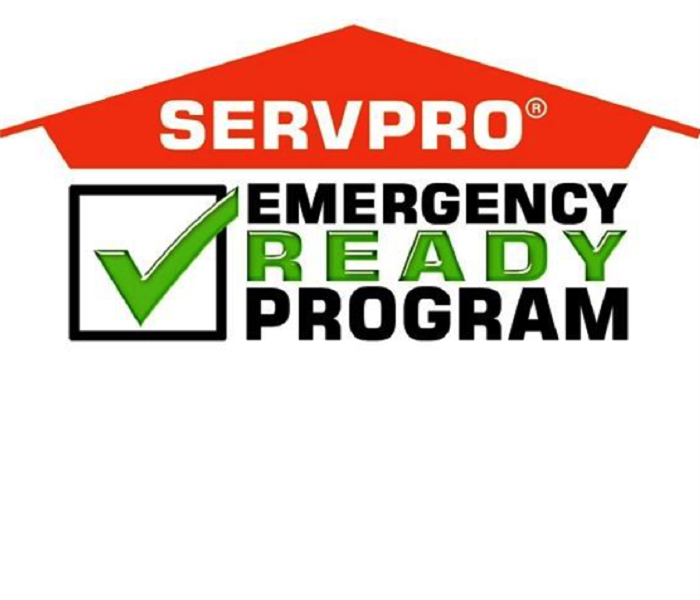 ERP
ERP
Businesses and The Emergency Ready Plan
Many businesses are not prepared to respond to a man-made or natural disaster. Statistics show that, of the businesses that close because of a disaster, at least one in four never reopens. Small businesses are particularly at risk because they may have all of their operations concentrated in one location that is damaged or destroyed. That is why disaster planning is a critical part of every business’ operational objectives.
To help keep small businesses “open for business,” SERVPRO® has developed The Emergency Ready Plan (ERP), a streamlined business continuity program that gives business owners tools to better understand the risks they face; plan for how to contact key suppliers, vendors and employees; understand how to access data; and identify where to go for help after a disaster.
ERP is an essential tool not only for business continuity but also to help identify priorities and organize essential information. Once this initial step is done, the next focus should be on emergency preparedness and response planning—the specific actions and tasks needed to protect people and property from physical and economic damage should disaster strike, as well as those to be taken directly following a disruption to your business. Not having a plan, or a having poorly prepared or misunderstood plan, could lead to disorganized preparation or confused response, with the possibility of harm to your employees or property.
To schedule your businesses FREE Emergency Ready Plan call (301) 753.8313.
How A Water Restoration Technician Assists After Disaster
9/20/2017 (Permalink)
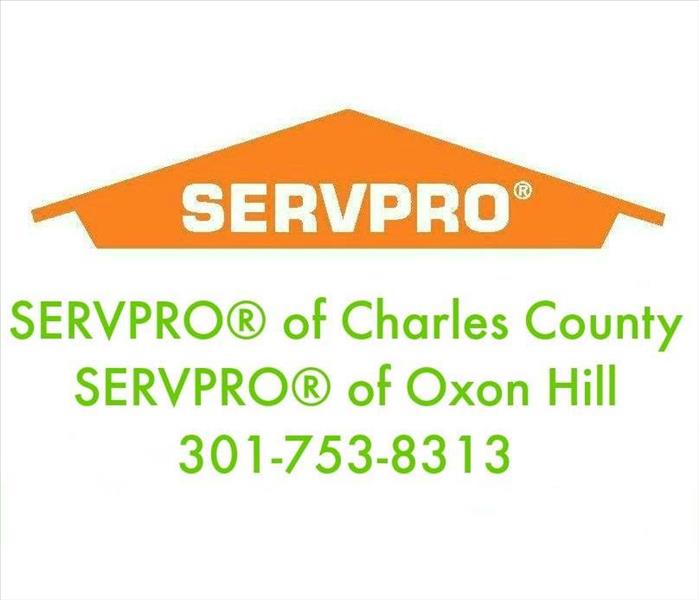 SERVPRO
SERVPRO
How A Water Restoration Technician Assists After Disaster
A water restoration technician has an extremely important job when a home is affected by excess moisture or fluid. Certified professionals in the industry can quickly reverse the extensive damage that a flood or sewage backflow can cause, and save as many items as possible in the process. And when dealing with contaminated fluids, especially when it has pooled in the home, only certified professionals should be allowed to manage the cleanup. Attempting to perform cleanup efforts without expert assistance can lead to injury or illness, both of which can be severe.
A certified water restoration technician will usually be on call around the clock, except for those times when an entire community has been affected by a major disaster. As soon as a professional is on site, they will assess the situation and determine what items need immediate rescuing. If fluid has pooled in areas around the home, then pumps will be used to remove it.
The home will be dried using a configuration of heavy duty air movers and dehumidifiers, and while it dries, the firm will move through the building and look for any evidence of mold or pathogen contamination. If pathogens or mold are present, they will be eliminated using special procedures. This will ensure the home is safe to return to, and with concerted drying efforts, the building will as good as new once professionals have completed their work.
Damage From Water Should Be Cleaned By Certified Professionals
9/20/2017 (Permalink)
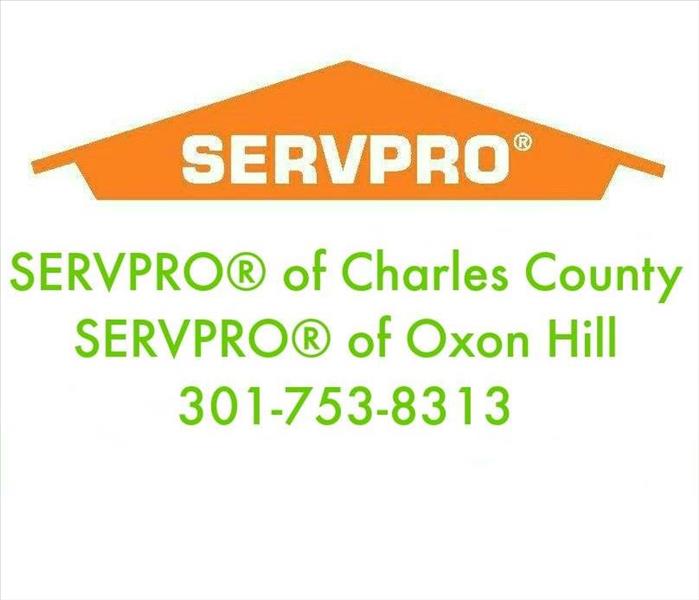 SERVPRO
SERVPRO
Damage From Water Should Be Cleaned By Certified Professionals
The amount of damage water can cause is amazing, and often underestimated by homeowners. Excess moisture is bad enough, but when a home is flooded or hit with a plumbing disaster (like a burst pipe), the situation can quickly get out of hand. There’s a reason why these incidents are among the most expensive problems a homeowner can face. Contaminated water not only creates immediate structural problems, it can leave serious biological threats behind after it has been removed.
Floods, sewage backflows, and other sources of contaminated fluid usually cause the worst damage. Dirty water is filled with all kinds of deadly substances, ranging from chemical residues to animal feces to parasites. Bacteria, viruses and fungi grow explosively in contaminated fluid, and severe health risks, like salmonella and hepatitis, are common in flood waters.
This problem is compounded by the composition of most homes, which are filled with organic materials. Drywall, wood and the matter that is trapped in carpet fibers are just a few examples, and they can give pathogens room to grow. Within 48 hours, mold may begin creeping behind the walls and releasing spores, and any organic materials that have been soaked through by contaminated fluid will usually have to be destroyed.
That’s why restoration firms, in addition to surveying the home for structural problems, will dry the home quickly and apply antibacterial, antiviral, and antifungal agents to all surfaces that had contact with the water. This ensures the family can return to a safe home, and not one harboring a collection of deadly pathogens.
Alway
The 4 most common types of fire
9/18/2017 (Permalink)
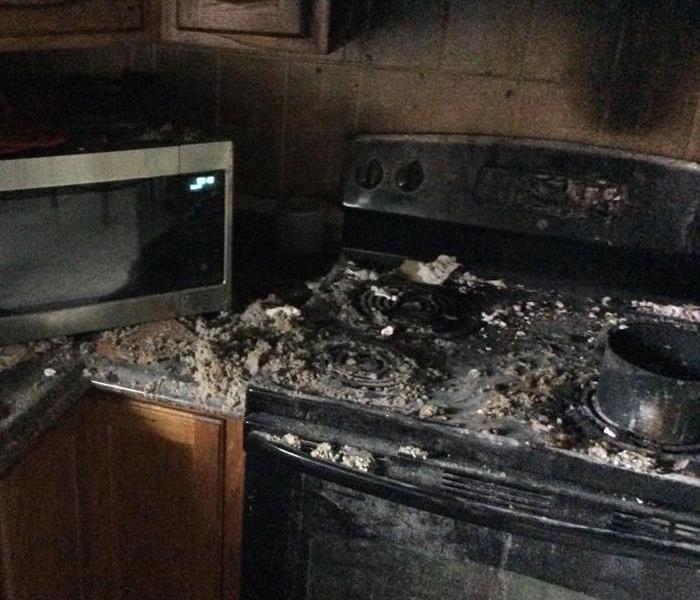 Kitchen Fire is #1
Kitchen Fire is #1
The 4 most common types of fire
Kitchen, electrical, heater and smoking-related fires are the four most common types of fires
Dec 21, 2011
While fires can start at anytime and anywhere, below are descriptions of the four most common types of fires. Acknowledging these types of fires may help you to reduce or even eliminate the risk of starting a fire.
1. The most common type of fire in the U.S. is the kitchen fire. The reason that the kitchen is the source of many fire hazards is because the kitchen is where heat, electricity, water, and grease come together.
The most common type of kitchen fire is the grease fire. A grease fire is extremely dangerous as it can get out of control quickly and spread from the stove throughout the kitchen and into other rooms of the house.
Many grease fires occur because someone leaves a frying pan on the stove unattended. They also occur when someone overheats a pan during attended cooking if the grease catches fire. Grease fires can cause serious injury and extensive property damage.
Other types of kitchen fires include oven fires and appliance fires. Fires can also get started in the kitchen when electricity comes in contact with water.
2. Electrical fires are another common type of fire. Electrical fires are caused by a number of different factors, including faulty appliances, worn or faulty electrical wiring, improper use of electrical outlets and worn out breaker boxes.
Older homes often do not have the proper wiring to handle the amount of electrical appliances in use today. Often old wiring inside walls becomes frayed or worn, causing shorts and sparks that can ignite.
Old breaker boxes are made to shut off electrical current when the circuit becomes overloaded as a fire prevention measure, but often the connections are worn or broken and do not activate the breaker switch.
Lighting is another cause of electrical fires, which can be triggered by improper wiring or the use of bulbs that are higher in wattage than the amount recommended for the lighting appliance.
3. Heater fires are among the most common types of fires in the months of December, January and February. Portable heaters should always have automatic shutoffs that activate when they overheat as a fire precaution.
Coil space heaters are especially hazardous because the coils will ignite anything combustible nearby. Always keep any type of space heater a minimum of three feet from anything combustible. That includes curtains, bedding, clothing and furniture. Always shut space heaters off when you’re not in the room.
Extension cords should not be used with space heaters as they generate too much electricity and can start a fire.
4. Another major type of fire is smoking-related. Fires caused by cigarettes account for 1,000 deaths in the U.S. every year. Many times the smoker is not the person who dies.
Most smoking fires are started by embers igniting on furniture, bedding and trash cans. Smokers should always be sure cigarettes are completely extinguished before emptying ashtrays into the trash.
Never smoke in bed and never smoke when you are tired, inebriated, or drowsy from medication. Do not place ashtrays on flammable surfaces like couches, chairs, or beds where they can tip over and start a fire.
The best way to prevent smoking-related fires is to smoke outside the house and have a can filled with sand to extinguish cigarette butts.
References:
www.Fire-Extinguisher101.com
www.RestorationSOS.com
Facts About Smoking and Home Fires (pdf)
Four Seasons of Safety
9/18/2017 (Permalink)
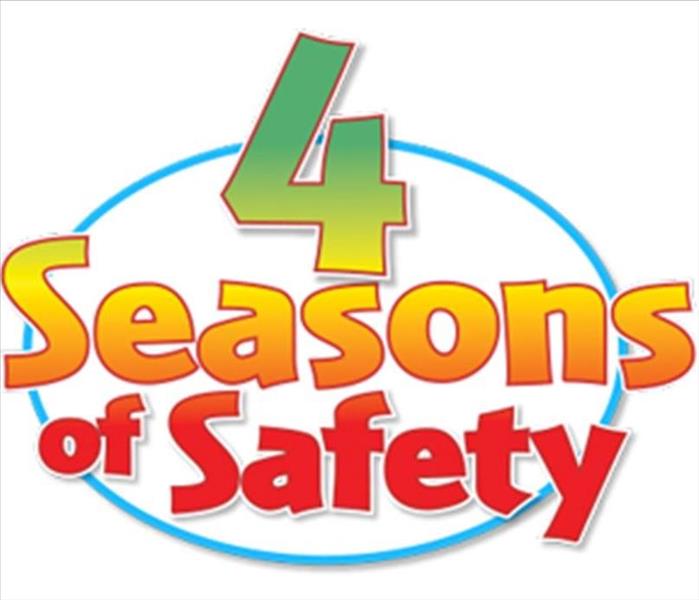 4 Season of Safety
4 Season of Safety
Four Seasons of Safety
Each season of the year has unique fire and electrical safety dangers that are related to common seasonal activities. The 4 Seasons of Safety program includes tips, lessons and activities that help students learn about basic fire and electricity concepts while also providing critical safety information that helps them learn to identify and prevent the fire and electrical safety hazards. All included activities can be conducted without the need for additional resources or supplies and with little to no advance preparation required.
The program also includes valuable family involvement opportunities. Take-home resources empower students to share the safety information they have learned with their families.
The 4 Seasons of Safety program resources are appropriate for students in grades 3-5 and have been developed to align with the following educational standards:
Mid-continent Research for Education and Learning (McREL)
- Science Standard 9
- Health Standard 5
National Science Teachers Association (NASTA) National Science Education Content
- Standard B Physical Science
- Standard F Science in Personal and Social Perspectives
Common Core English Language Arts Standards – Reading: Informational Text
- CCSS.ELA-Literacy.RI.3.8
- CCSS.ELA-Literacy.RI.4.7
- CCSS.ESL-Literacy.RI.5.9
Fire Prevention and Electrical Safety Classroom Toolkit: Each section of the toolkit includes two seasonal lessons and safety tips along with information to help you tailor the activities to your grade level.
Classroom Poster: Display this colorful poster in a prominent place in your classroom as a constant reminder of the steps we can take to stay safe all year long.
4 Seasons of Safety Interactive White Board Activities
The 4 Seasons of Safety program includes tips, lessons and activities that help students learn about basic fire and electricity concepts while also providing critical safety information that helps them learn to identify and prevent the fire and electrical safety hazards. All included activities can be conducted without the need for additional resources or supplies and with little to no advance preparation required. Available in ".Notebook" format.
Funding for this program was provided by a 2012 Fire Prevention and Safety (FP&S) Grant from the Department of Homeland Security / Federal Emergency Management Agency.
Does Homeowners Insurance Cover Mold?
9/18/2017 (Permalink)
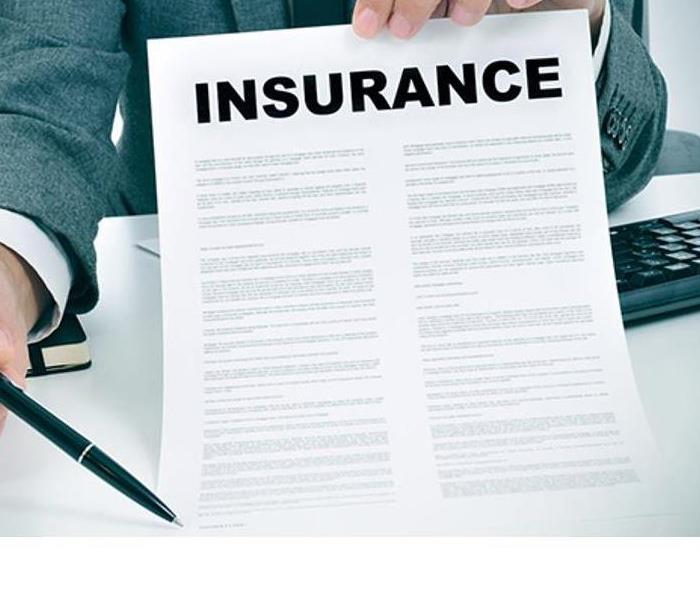 Does Homeowners Insurance Cover Mold?
Does Homeowners Insurance Cover Mold?
People are usually afraid of the fact that mold can grow in their homes. However, this is not an excuse to ignore the topic altogether. We have covered methods before about Mold Prevention and Control Tips; however, what about you already have mold damage in your home? Are there any insurance plans that will protect you from the costs of mold remediation? Well, these questions that homeowners ask leads to the big question. Does homeowners insurance cover mold? Let’s discuss.
Does Homeowners Insurance Cover Mold?
Homeowners insurance does not usually cover mold damages. Although, there are instances when mold is covered. These instances are generally when the cause of mold is due to an incident that homeowners insurance does cover. For example, if mold has grown due to accidental and sudden pipe burst or if a recent fire has caused mold, your homeowners insurance will likely cover the mold damages. On the contrary, if mold has grown due to improper maintenance practices, such as on-going humidity exposure or a continuous leak, homeowners insurance will not likely cover the damages.
How To File a Homeowners Claim for Mold
The first step in filing a claim is to call your insurance company quickly and informing them of the damages. Once you speak with your insurance company and they provide you with next steps, gather the evidence. You can do this by taking several pictures of the damages. Also, take pictures any mold that becomes visible before anyone comes out and fixes the issue. Keep in mind that mold only needs 24 hours to begin to grow. It would also be a good idea to contact a mold remediation company and have them come out and dry the water before mold starts to grow. However, consult with your insurance company before making this call to be sure that they will cover the costs.
Once your insurance claim goes through and resolves all damages, keep any documentation and images. If mold later grows in that area and the growth is due to the initial incident, then your insurance company will likely have to cover the costs of going back in and fixing the problem.
Mold Prevention Tips
9/18/2017 (Permalink)
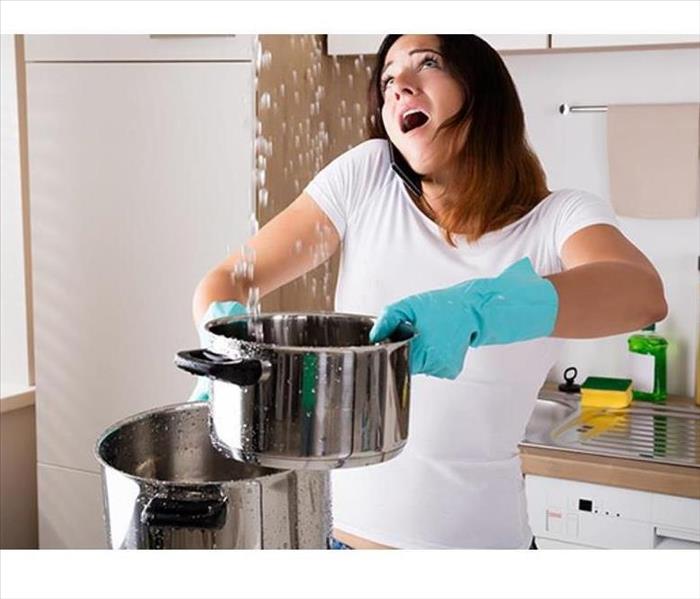 Mold Prevention Tips
Mold Prevention Tips
Mold can be very costly to repair and the effects it can have on your health can be serious. We have put together a list of mold prevention tips to help keep your home and your family healthy.
Mold Prevention Tips
- When water leaks or intrusions occur, act quickly! Wet or damp material that is dried within 24 – 48 hours of the leak, in most cases, will NOT grow mold.
- Remove wet carpet or furniture that cannot be dried within 24 – 48 hours.
- Do not install carpet in areas of water usage such as bathrooms, kitchens, and basements.
- Remove wet clothes from the washer promptly.
- Do not leave damp clothes or towels lying around.
- Keep indoor humidity levels below 60%. The ideal level is between 30 – 50%. Relative humidity can be measured by a moisture or humidity meter, a small and inexpensive instrument available at most hardware stores.
- If you see condensation or moisture collecting on windows, walls or pipes, act fast to dry the wet surface and reduce the moisture or water source.
- Use air conditioners or dehumidifiers to keep humidity low.
- Keep air conditioning drip pans clean and the drain lines free of obstructions.
- Be sure dryers, stoves, heaters and exhaust fans vent to the outside, not into the walls or attic.
- Use a bathroom exhaust fan or open the window when you shower.
- Dry shower walls after a shower.
- When cooking or using the dishwasher, use an exhaust fan or open the window.
- Keep furniture from blocking air returns and vents.
- Dust and vacuum often.
- Remove mold growing in the soil of houseplants.
- Clean and repair gutters regularly.
- Repair any roof leaks as soon as you discover them.
- Make sure the ground slopes away from the building foundation so that water does not enter or pool around the foundation.
- Insulate cold surfaces such as cold water pipes to prevent condensation.
- Repair any plumbing leaks as soon as you find them.
- Use mold-resistant building materials when available.
- Install a vapor barrier in the crawlspace to prevent moisture from the ground.
- Keep the crawlspace and basement well ventilated.
- Ensure that the attic is properly ventilated and properly insulated.
More Mold Tips
In addition to tips for mold prevention, we have listed a few things you should not do when you have a mold infestation.
- Do not ignore the problem! It will not go away and will actually get worse! If the affected area is small enough, you can remediate the mold yourself. Any area larger than 10 square foot will require a mold remediation expert.
- Do not attempt to clean mold with bleach! Bleach will not penetrate a porous surface and is 97% water. The water component will provide moisture for mold to grow. This is a very ineffective way to treat mold as well as being a very corrosive chemical.
- Do not try to remove mold, even a small area, without proper protection.
- Do not paint or caulk over moldy surfaces. Clean up the mold and dry the area before painting to avoid the paint from peeling.
Hopefully, these tips have given you a better understanding of mold and how to prevent it. For even more tips on mold prevention, check out these 25 Mold Facts That Everyone Should Know.
A Hurricane Preparedness List
9/18/2017 (Permalink)
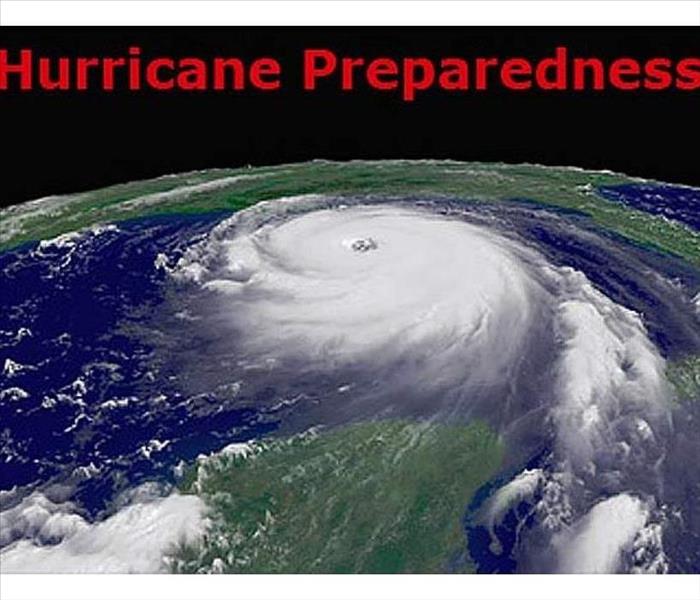 A Hurricane Preparedness List
A Hurricane Preparedness List
A hurricane preparedness checklist will provide reassurance that you will have thought of all the essentials (provided that they are on the list) and will greatly reduce the likelihood that you will forget something during the stressful time immediately before a potential hurricane disaster.
Note: No list is a perfect or complete list because we all have our own unique circumstances, concerns, and existing resources. Besides, it would take a book to complete one… That said perhaps this list will help get you going in the right direction. It is intended to provoke thought, prepping & preparedness for a hurricane.
HURRICANE PREPAREDNESS: GENERAL SUPPLIES
- Pack a “Bug Out Bag” and/or “72 hour kit”: This bag of contents should be packed with essential supplies, food & water, clothing, and whatever you feel is important to have during an evacuation. There are lots of articles on our site with more specifics…
- Cash: ATMs and credit card machines may not work for a while after the storm.
- Battery-operated radio: Make sure you have extra batteries too, so that you can keep up with news reports and alerts. Hand-crank radios work well, too.
- Secure a two-week supply of prescription medicine: Anyone on prescription medications, should pack a two-week supply of their meds in a sealable plastic bag, clearly labeled.
- Flashlight and lanterns: Make sure you have a couple of flashlights, candles, matches, lanterns and other alternate sources of light.
- Personal hygiene items: It might be hard to get to the store to buy toilet paper, tissues, soap and other sanitary items after the storm.
- Extra keys: Having an extra set of keys in your kit is a good idea in case people get separated or if they’re lost in a flood or the confusion.
- Pet items: Remember food, medicine and water for your pet, too.
- Disinfectant: You never know what mess you’ll have after a storm.
- Checklist: Customize your own hurricane preparedness checklist and print it out for your reference.
- Extra batteries: You’ll need extra batteries for your radio, flashlights, and other items. Get these early before they all sell out.
- Prepare early: Emergency items sell out quickly at the stores, so stock up your kit before hurricane season even starts.
C. Crane Company Emergency Radio
Emergency Solar Charger for Phones and USB devices
Related articles on MSB:
Bug out
72 hour kits
HURRICANE PREPAREDNESS: FIRST AID
- Basic First Aid Kit: Keep this on hand for general purpose.
- Antiseptic solution: Keep this on hand to keep infections at bay.
- Allergy medicine: Storms can blow in all kinds of stuff that drive your allergies wild.
- First aid instructions: Know some basic First Aid skills such as how to stop bleeding, the Heimlich, CPR, and other basic aid in case you need it in an emergency.
- Mosquito repellent: If it floods — or even rains a lot — your area could have a serious and potentially dangerous mosquito problem.
- Prescription glasses: If you run out of contact solution or all the nastiness in the air after a storm irritates you, you’ll have back-up glasses.
- Adhesive tape: You can use this to fasten bandages, hold large lacerations together and even splint broken bones.
- Gauze, bandages and band-aids: Even little cuts and scrapes need to be dressed, so have a range of bandages on hand.
- Hand sanitizer: Nothing compares to soap and water, but in a fix, hand sanitizer with at least 60% alcohol will help.
Related article:
Best First Aid Kit 2017
First Aid Skills
HURRICANE PREPAREDNESS: REPAIR AND MAINTENANCE
- Plywood: Nailing plywood over windows is still the best option for protecting the inside of your house.
- Sand bags: If you live in a low area, especially, use sand bags to dispel water.
- Bring outside furniture indoors: Move patio furniture and pool toys into the garage.
- Turn off utilities if you leave: Before evacuating, shut off power, propane gas and water, but leave on natural gas unless told to do so by authorities. A licensed professional is the only one who can turn it back on.
- Anchor mobile homes: Pre-1994 construction mobile homes probably aren’t anchored well enough to stand even Category 1 hurricanes.
- Buy impact resistant glass: Well before you hear about any storms, replace older windows with higher resistance ones.
- Lock windows and doors: Lock up your windows and doors for personal safety and to keep the wind from blowing them open.
- Prune trees and shrubs: Loose limbs and plants will fly around easily when the winds pick up.
- Get storm shutters: Place these over glass doors, windows and skylights.
- Check smoke and carbon monoxide detectors: Make sure these will work even if the power is out.
- Buy tarps and rope: Already have these items on hand so that you can start repairs as quickly as possible to prevent more damage.
- Fill bathtub with water: If you’re going to get hit pretty badly, give your family an extra supply of water by filling a sanitized bathtub.
WaterBOB Emergency Drinking Water Storage
Emergency Gas & Water Shutoff Tool
HURRICANE PREPAREDNESS: FOOD AND WATER
- Food and water should last for 72 hours: Make sure you have enough supplies to last everyone in the house for at least 72 hours. More is better!
- Quality Water Filter: Clean drinking water is a top priority. Get a quality water filter!
- Use good food rotation practices: If you’re keeping an emergency kit stocked with some food supplies, replace food items every six months to ensure freshness and safety.
- Be aware of “boil water” alerts: After a storm, you may have to boil water for a few days due to flooded wells, spilled sewage and other contamination.
- Get out your ice chest: Fill an ice chest with ice or dry ice before and after the storm to keep food cold.
- Canned foods: Canned meat, fish, fruits, soups, milk and vegetables are all smart, easy-to-prepare options.
- Stock up on non-perishable foods: The power will probably go out, so acquire foods that don’t require refrigeration.
- Cooking without electricity: Fill your BBQ grill tank. Do you have a camp stove?
- Use camping gear: If you have basic camping gear like a small grill, you can make simple meals while the power’s out.
- Baby formula, diapers: Don’t forget to store enough baby formula, baby food, diapers, if this applies to your situation.
Big Berkey Countertop Water Filter
Without Electricity: Level-1 Prepping & Preparedness
HURRICANE PREPAREDNESS: POWER OUTAGES
- Consider a generator: A generator will make your life much easier during and after a storm if the power goes out — but run it outside!
- Keep phone numbers of energy companies handy: Write down or store in your phone the numbers of energy providers so that you can notify them of an outage.
- Use grills and gas cook stoves outside: Gas grills and generators carry a carbon monoxide risk.
- Stay away from downed power lines: Let trained workers clean up the damage.
- Have a realistic understanding of restoration times: It may take longer than you think. Having MORE food and water than 72 hours is a very good idea.
- Drink lots of water: When it’s hot and you don’t have A/C, drink water to stay cool and hydrated.
- Know how to connect a generator: Be sure that you or someone understands how to do this, and the dangers and precautions that must be met if connecting to the homes electrical system.
HURRICANE PREPAREDNESS: ENTERTAINMENT
- Board games or cards: Get out board games or play cards to keep you distracted during the storm and to play if the power goes out.
- Read: Read a book! If the power is out, today’s modern electronic entertainment will be too…
- Play with your pets: Give your pets extra attention, especially if they seem stressed or scared.
- Play charades: Games like charades or hide and go seek don’t require any power and are fun with the kids.
- Tell stories: Kids love to hear stories.
- Get to know your family better: A perfect time to ‘talk’ together instead of everyone’s head stuck in an electronic device.
Kids and Pets: Level-1 Prepping and Preparedness
HURRICANE PREPAREDNESS: SPECIAL NEEDS AND CHILDREN
- Minimize stress: Help children cope better by minimizing stressful situations and discussions.
- Limit TV time: Don’t let your kids watch scary footage of the storm on TV.
- Maintain normal routines: Keeping up with a somewhat normal routine helps soothe everyone from babies to adults, provided that you are already prepared.
- Contact home health care service: If you use a home health care service, call them and ask for advice regarding the impending storm.
- Answer children’s questions: Welcome questions from children about what to do, what a hurricane is, and how to prepare for it.
- Get older kids to help: School-aged children will feel more prepared and maybe even excited if they’re allowed to help gather supplies, find the flashlights & batteries, etc..
- Bunk with the neighbors: If you’re elderly, ask to spend the night at the neighbors’ house, or work out some kind of signal for help should you need it and if the phones go out.
- Stay hydrated: People who are sick and the elderly are especially at risk for dehydration.
- Know the risks: Disabled individuals will find it harder to evacuate, so know all the obstacles and risks involved in transporting them or keeping them safe in your home.
HURRICANE PREPAREDNESS: EVACUATING
- Find a place for pets ahead of time: If you’re unable to take your pets with you, make arrangements ahead of time, and never leave your pet chained up / alone on your property. It’s cruel.
- Get a real map: You may not be able to rely on your GPS, especially if roads are blocked or flooded. Get a real map to help you find your way out.
- Let someone know where you’re going: Contact family or friends before you evacuate and let them know your planned destination. If you lose contact, this will help alleviate questions and concerns.
- Sleeping bag: Get a sleeping bag, blankets and pillows ready if you have to evacuate.
- Keep your gas tank full: Fill it up all the way. Even when you’re on the road try not to let your tank get below half full.
- Familiarize yourself with evacuation routes: There should be standard routes, but listen to the news to learn about any new or updated routes. They will get clogged. Leave early! Consider back roads.
- Plan to stay with friends: Hotels will book up quickly, so plan to stay with friends or family who live inland at least for the first couple of nights.
- Leave early if forecasts look bad for your area: Avoid the worst traffic and road closures. Don’t wait if it looks like your area will be in the hurricane.
- Carefully inspect your home upon return: Before letting children back, watch for danger, hanging electrical wires, loose debris, broken glass, etc..
Road Atlas Map For Each State
HURRICANE PREPAREDNESS: PAPERWORK
- Emergency contact information: Hard copy of all important phone numbers and other emergency contact information in your preparedness kit. Don’t rely on having a charged cell phone and it’s contact list.
- Prioritize what’s important: You can’t take everything with you, but consider important documents such as deeds, wills, birth certificates, passports, important financial statements, etc..
- Use a USB thumb drive: Download important data onto a flash drive and put it in a waterproof, sealable bag or container.
- Check home insurance: Do this before hurricane season starts, otherwise updated coverage may not take effect until the following year. Also look into flood insurance.
- Write down serial numbers: In case important belongings are stolen or lost in the storm, you might need serial numbers as proof for insurance.
- Video your belongings: Walk through the house and video everything you own. Great proof for insurance claims.
- Proof of residence: A driver’s license or mail should suffice.
- Use a fireproof / waterproof safe: A fireproof safe will keep your belongings protected.
HURRICANE PREPAREDNESS: STAYING INFORMED
- Know the terminology: Know the difference between tropical depressions, tropical storms and hurricanes so that you can follow the reports better.
- Listen for warnings: Heed the advice especially if ‘they’ are advising to evacuate. Listen for what the weather forecasters and/or emergency management people are saying.
- Stay up to date with a weather radio: Best Weather Radio
HURRICANE PREPAREDNESS: SAFETY
- Head to a windowless room: Even if your windows are boarded up, stay in a windowless room while the winds are blowing.
- Stay downwind: This area is the opposite side of the house that the wind is hitting.
- Stay inside: Stay indoors for the entire duration of the storm, and do not go outside during the calm of the storm, when the eye passes over.
- Be careful with candles: Only light them if you have to, and set a reminder to blow them out before leaving the room or going to bed.
- Personal Security: Unfortunately the reality is that the bad element takes advantage during disasters. Do what you need to do regarding your own personal security.
How to Prepare for a Power Outage
9/18/2017 (Permalink)
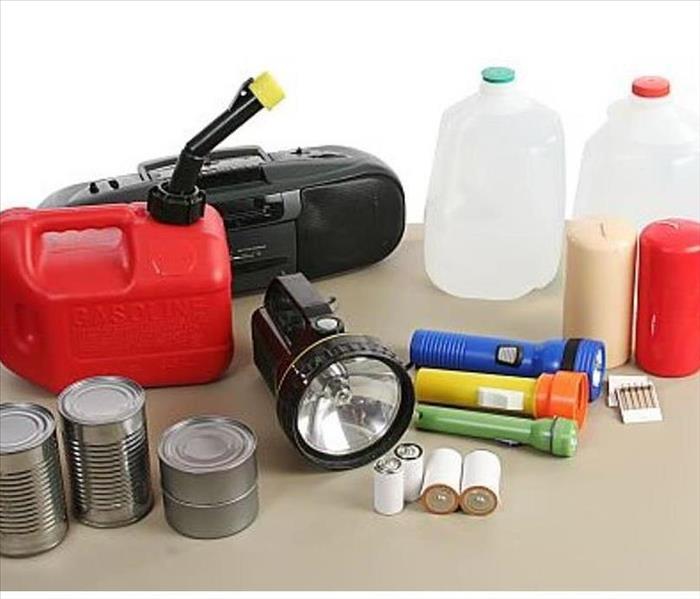 How to Prepare for a Power Outage
How to Prepare for a Power Outage
How to Prepare for a Power Outage
Posted on 2017-03-10 12:52:43 by Jennifer
Weather can be unpredictable, and we need to keep ourselves and loved ones safe during a bad storm. Here are some basic things you can do to prepare your home for loss of power any time of year:
Things to do before a power outage
- Be prepared for injuries. You should have an emergency kit at your home that's fully stocked with bandages in various sizes, sterile dressings and gloves, hand sanitizer and antibiotic towelettes, a thermometer, pain medicines, tweezers, and scissors. Make sure you purchase or build your own first aid kit that is large enough for your family.
- Make sure your generator is up and running. Review generator safety tips before using your generator for the first time each year.
- Stock up on bottled water. Water purification systems may not work when the power goes out.
- Purchase a battery operated or hand cranked radio to stay tuned into news and emergency information when power is out.
- Fill up all your vehicles’ tanks in case gas stations lose their power as well. Remember, if you're using a generator they require roughly 12-20 gallons of gas per day. Store all fuel away from the house.
- Have car chargers for cell phones and keep a corded phone as well. Cordless phones require AC power. Keep in mind cell phones may be more reliable than landline phones when local service is disrupted.
- Be prepared for special needs. Tell your utility and local fire department before a storm if someone in your home uses an oxygen concentrator, ventilator, or medical bed, as power may be restored to you sooner. Always keep a one month supply of medication on hand.
Don’t get caught in the dark
- Keep a few emergency automatic power failure night lights plugged in. Place them in dark hallways, bedrooms, common areas, basements, and garages. Emergency lights can last from 6-20 hours depending on the model. These can come in handy the first couple of hours during a power outage, especially when you're trying to make your way around a dark home.
- Have candles and plenty of matches available. Make sure you keep your candles away from anything flammable, such as drapes.
Food Safety: What to do when power remains out for over 4 hours
- Invest in a cooler and ice packs. Keep the cooler in a convenient location inside your home and ice packs in the freezer. When the power goes out, don't open your refrigerator if you don't have to, unless the power outage lasts longer than 4 hours. After 4 hours, get your cooler and ice packs and pack items from your refrigerator into your cooler. Throw away any food that has a temperature of more than 40 degrees Fahrenheit.
- If your freezer is half full, it will hold safely for up to 24 hours. A full freezer will hold safely for 48 hours – don't open the freezer if you can avoid it.
- Get the right food before you lose power. Keep at least a 3-day supply of nonperishable foods such as crackers, whole-grain cereals, and canned goods. Don’t forget a manual can opener!
It's important to plan ahead and be prepared, as you never know when a bad storm or power surge will hit. Sudden power outages can be frustrating and troublesome, but being prepared can eliminate some of that stress. For prolonged power outages, it may be wiser to seek shelter with friends, family, or at a hotel. Stay safe!
Commercial Carpet Cleaning- maintaining high-traffic areas
9/18/2017 (Permalink)
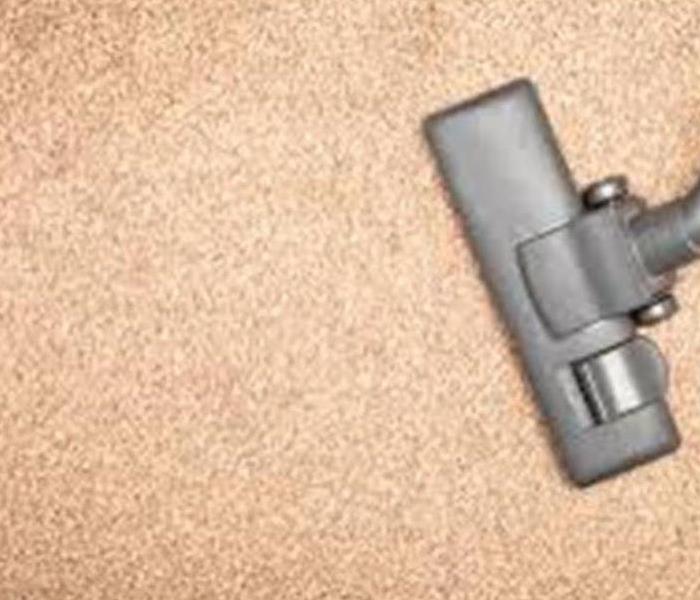 high-traffic areas
high-traffic areas
What steps should I take to maintain carpet in a high-traffic area on a daily basis, and to deal with spills and stains?
- It's a good idea to keep sand, grit and grass clippings off walkways outside entries to prevent inward tracking of these abrasive soils.
- Purchase a properly sized entry mat, the bigger the better. There must be room for at least two steps to sufficiently wipe soil from feet before encountering the installed carpet. A carpet with a nylon face and vinyl back is best for moisture and oils absorption, combined with the resiliency necessary to collect a quantity of particle soil. The IICRC suggests a rental mat, since that guarantees frequent maintenance. Place entry mats on hard surfaces rather than on carpet where they can trap moisture or cause plasticizer migration.
- Vacuum, vacuum, vacuum daily, especially after major events. The sooner you collect soils from the surface, the easier it is to remove them. For most carpet, you should use an upright vacuum with brush agitation, unless your canister vacuum is particularly well designed. The wider the head, the more efficient.
- Typically, deep cleaning should be accomplished on at least a semi-annual basis, with no more than two entry and high-traffic area "rinse" cleanings between the deep cleaning. This is dependent on traffic and daily maintenance as well. At a minimum, some attention should be given to primary entry areas on a quarterly basis.
- If spots are treated immediately, most will respond with plain warm water and very little mild detergent added.
- Use high-efficiency double-lined poly-fiber collection bags. This reduces periodic maintenance such as dusting of furniture, heating, ventilation and air conditioning (HVAC) filter exchange.
- Make sure the HVAC system is slightly positively pressurized as well, which means that air is going out when doors are opened, rather than being sucked in. Proper air exchange rates can be calibrated according to ASHRAE regulations for the building with a trained HVAC contractor.
- Ensure proper air filtration through the HVAC System. High-efficiency pleated filters, rather than inexpensive fiberglass filters, are recommended.
Structural drying
9/18/2017 (Permalink)
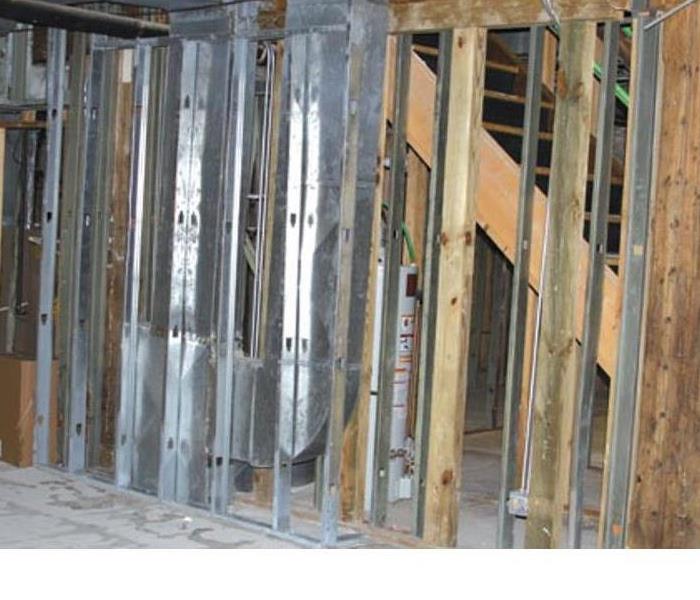 Structural Drying
Structural Drying
Structural drying is a simple concept: Remove excess moisture from wet materials that make up the structure until it reaches a reasonable approximation of a dry standard or goal. Therefore, drying wet buildings involves removing trapped moisture in building materials (e.g. drywall, dimensional lumber, concrete, etc.).
The challenges take place in deciding what the end game, or drying goal, should be so that the affected structural material dries within an acceptable range, in a reasonable time frame and takes into account budgetary restrictions.
Much attention has been lavished on drying the air; however, in the water damage restoration industry, contractors are tasked with drying wet materials that make up the structure. Problems arise when the drying process is too slow, causing water to migrate to previously unaffected materials (secondary damage) or create conditions that are favorable to microbial amplification - the result being mold growth or moisture differences that cause wood to warp or swell. Moisture plays a critical role in the stability of the indoor environment. The IICRC S500 standard is relevant to every structural remediation job because it establishes procedures that make up the industry standard of care that water remediation contractors should follow when drying wet structures.
It is important to understand, especially for water damage restoration contractors, that in a conditioned structure, drastic seasonal variations occur in moisture content of structural materials and hidden spaces or voids are almost always present in structures. This is important because drying goals must take into account the dry standard for structural materials based on moisture content at the time of the water loss and contractors must locate structural voids in order to determine if there are factors (e.g. location, vapor barriers, permeability) which will have an impact on drying. In time I expect our industry will also be measuring water activity in order to establish that a building has actually been returned to a preloss condition and be able to rule out the growth of certain classes of microorganisms. The industry is already seeing an increasing trend towards the use Adenosine Triphosphate (ATP) testing to establish cleanliness levels.
The bulk of water in structural materials is usually held in horizontal surfaces (e.g., bottom plates, decking, subfloors and joists). Materials dry at a different rate depending on saturation levels and permeance or porosity. If the materials include dimensional lumber that has absorbed water over time, drying will be slower. Generally, the more porous the material, the more likely it will be that more moisture will have been absorbed. Evaporating moisture from wet structural materials is critical and drying should be accelerated using appropriate principles of restoration. Low vapor pressure, often created by hot dry air movement across the wet structural material surfaces, ensures that efficient drying will expedite the drying process. Care must be taken during the evaporation phase that water vapor molecules do not increase and create high relative humidity situations that create accumulation, or condensation, on structural surfaces.
There is no debating the fact that restorers today have a plethora of tools to dry wet structural materials (e.g., LGR dehumidifiers, thermal energy systems, desiccant dehumidifiers, negative and positive pressure systems, etc.). Given the competition among equipment manufacturers, testing facilities and new research, along with improvements in drying equipment, structural drying is reaching new levels of efficiency. The debate is what tool works best.
As a researcher and consultant, I became involved with the issue of drying structural materials to inhibit conditions that favor mold growth. I am struck by the large number of simple water claims that end up dealing with mold issues. Many mold issues are the result of delay in mitigating the water loss. I don’t understand why it takes so long to get a water remediation contractor out on a loss. There is nothing that would save carriers more claim dollars and homeowners more angst than for a restoration contractor to arrive at a water loss on the day the loss is discovered. Any delay in beginning the drying process increases costs and provides opportunity for microbial amplification.
Since Dr. Michael Berry wrote his book Protecting the Built Environment – Cleaning for Health, our industry has realized that we play an important role in preventing microbial amplification in buildings. Today’s contractor must not make the mistake of believing that processing a water damaged structure is simply extracting standing water and leaving air movers and dehumidifiers in the structure to dry it out. To properly dry structural materials, the contractor must understand how moisture content in structural materials is removed. Today the drying process is accomplished faster utilizing more efficient equipment than we used in the past. The older type conventional refrigerant dehumidifiers are less efficient than today’s LGR dehumidifiers. Contractors should understand that refrigerant dehumidifiers rated using AHAM conditions may not actually remove as much water as they are rated for when drying a wet structure with different conditions than those tested in a controlled test chamber (800F with 60% relative humidity for 24 hours)The key to successful structural drying is control of the drying process, including temperature of wet materials and air, humidity levels and air flow. Updating your education and modernizing your drying equipment are the way to best serve your customer.
5 GERMIEST PLACES IN THE GYM
8/31/2017 (Permalink)
5 GERMIEST PLACES IN THE GYM
OCTOBER 28, 2013
BY JEFF HIERS
Few people give any thought to the germiest places in the gym. Ask random people what they think about gyms, and chances are, majority of the answers will be something along the lines of: “it’s where you go to get healthy and fit.” That kind of answer is actually an ideal that is promoted by health buffs, fitness instructors, and wellness gurus. Actually, a gym is really a place for exercising – for toning muscles and building cardiovascular strength. The goal, of course, is becoming healthy and staying that way.
However, a gym can also do the opposite and be a source of numerous infectious diseases. Bacteria and viruses are all around us. They float in the air that we breathe, hide in various nooks and crannies, multiply in moist places, and infect us opportunistically. The good news is, some of the germiest places in the gym can be dealt with easily and effectively.
GERMS ARE ABUNDANT IN GYMS BECAUSE OF THE FOLLOWING REASONS:
- Numerous people use the gym and its facilities – some of them may be carriers of infectious diseases. Even with membership-only gyms, there is no pre-entry screening done. It is typically assumed that anyone who enters the gym and uses it, is fit to do so.
- Moisture is plentiful in the gym – sweat that rolls off or drips from the bodies of the people exercising often accumulates and stays where they accumulated, such as equipment handles, towels, or exercise mats. Moisture leads to dampness, which is a breeding ground of germs and fungi that harbor communicable diseases.
- A typical gym is enclosed – the air that circulates inside most gyms is not fresh, because of the walls and the artificial ventilation being used. Stale air is bad for the lungs and can contain dangerous contaminants.
- Touch point interaction is heavy – this is especially true during peak hours, when clients use the equipment in quick succession. Anything that has been touched by othersis subject to suspicion. No one really knows whether equipment handle that has been touched, or a mat that touched the sweaty body of someone else is free from contamination.
THESE ARE FIVE OF THE GERMIEST PLACES IN THE GYM:
- Lockers – dark and dank, lockers are bound to harbor persistent disease-carrying germs. Plus, locker room itself is also extensively populated with infectious agents that we cannot see with our naked eyes.
- Cardio machines – sweat, as well as saliva (from sneezing and coughing, sometimes from drooling out of exhaustion) drip from people who use cardio machines. Plus, the towels used for wiping these kinds of discharge may be placed on the handlebars.
- Exercise mats – anyone who uses a mat that has already been used a gazillions times is fair game to a concerted attack by the host of germs that silently live on these heavily shared gym materials.
- Bathrooms – floors are often left wet, with shower heads or faucets dripping; dirt is also tracked in by shoes that have been brought from outside, bodily fluids are not always contained.
- Weights (dumbbells, barbells, kettlebells) – these are among the most frequently used gym equipment which is why they rank as one of the germiest places in the gym. Fortunately, some of the larger gyms are placing sanitizing wipes at each station which helps germ reduction.
To ensure that the highest standards of cleanliness and sanitation are observed, engage a professional janitorial service company to take care of your facility on a nightly basis. Then you can use your employees to spot clean the germiest places in the gym during regular hours.
A CLEAN OFFICE SETS THE TONE FOR YOUR EMPLOYEES
8/31/2017 (Permalink)
A CLEAN OFFICE SETS THE TONE FOR YOUR EMPLOYEES
SEPTEMBER 3, 2013
BY JEFF HIERS
Improving employee productivity has always been a concern for many employers, especially because the quality of work that you get from your employees is usually directly related to how productive they feel. This is why companies pay a lot of attention to compensation and benefits, as well as other ways to make their employees feel important and happy. What most employers don’t realize is that it can take something as simple as making sure you have a clean office & workplace to improve productivity and set the tone for your employees.
THE IMPORTANCE OF A FUNCTIONAL ENVIRONMENT
This is not to say that compensations and benefits don’t work, but making a few changes in their work area can lead to significant improvements. The fact is, our surroundings are actually quite important in making people thrive. Whatever you’re surrounded with can actually affect how you act and how you feel. This is the same for office workers. Elements in the office can affect how people work. One particular research shows that among workspace features, there are those that stand out and actually affect employee productivity:
- Clean Office
- Decorative office
- Lighting
- Absence of noise in the office
- Close office floor plan
- Moderate room temperature and ventilation
This means that if your office is well-lit, well-ventilated, and more importantly, clean, then your employees will tend to be in a better and more productive mood. It’s as simple as that. In fact, the same research shows having all of these elements actually prevents work-related illnesses, absenteeism and employee turnover. A simple solution to complex problems! Another paper highlights that poor environmental conditions like a dirty and unorganized office can actually cause inefficiencies in worker productivity, reducing job satisfaction and even affecting the organization’s financial well-being.
A CLEAN OFFICE — LEAVING IT TO THE PROFESSIONALS
Clearly, the importance of having a well-organized and clean office could not be stressed enough. And because this is of such huge importance, it needs to be a priority for business owners and managers. However, you have better things to do and you need to concentrate on running your business. By hiring a professional janitorial service company, you’re leaving the cleaning to those who actually know what they’re doing based on years and years of experience. They will also have the technology and expertise needed to ensure a clean office facility.
DIRTY RESTROOMS CAN MEAN LOST BUSINESS
8/31/2017 (Permalink)
DIRTY RESTROOMS CAN MEAN LOST BUSINESS
NOVEMBER 28, 2013
BY JEFF HIERS
When you’re trying to make your business establishment a place where customers would want to go, you have to focus on a lot of things. You have to make sure that the products you offer are topnotch. You need to have knowledgeable personnel who can deal pleasantly with customers. The ambiance of the place should be relaxing and inviting, so people can feel at ease. With your focus on so many different things, sometimes the simple need for clean and proper restrooms can get lost in the shuffle.
PEOPLE AVOID ESTABLISHMENTS WITH DIRTY RESTROOMS
A telephone survey conducted by Harris Interactive revealed that just about everyone—94% to be exact—would stop returning to an establishment if they ever encounter a dirty restroom. When asked about specifics, 79% of the more than a thousand adult respondents identified hotels and restaurants as places which should have clean restrooms if they want customers to return. Another 77% would not return to healthcare facilities with dirty restrooms, and 50% thought the same of supermarkets. Sizable number of people also expected retail stores, gasoline stations, and even car dealerships to offer clean restrooms, if they wanted their customers to come back for another visit.
WHAT’S A DIRTY RESTROOM?
Some people have different definitions of what “dirty” means when it comes to restrooms. Another survey by Harris Interactive clarified this issue by conducting a survey among more than 3100 adults. About 93% would call a restroom dirty if it had sticky or grimy floors.
Other signs of dirty restrooms include:
- Toilets that have not been flushed
- Foul odor
- Trash cans filled to the brim
- Toilet paper or paper towels on the floor
- No toilet paper
- Soap dispensers are empty or outdated
- There’s water around the sink area or on the floor
- Broken doors and toilet seats
- Insufficient lighting
- Graffiti
HOW YOU CAN LOSE BUSINESS
People want clean restrooms not just because they want a pleasant experience while they’re there. In many cases, customers equate the cleanliness of the restroom to the quality of the service or product the business is offering. For example, a majority of customers believe that the cleanliness of the restroom in a restaurant is a clear indication of the cleanliness of the kitchen. If you can’t take care of your restroom, the reasoning goes, then you can’t be expected to take care of the rest of your business.
It’s not just the fact that a customer won’t return that causes you to lose business. You also lose any potential referrals. And with social networking sites like Facebook these days, the word can spread about your dirty restrooms like wildfire.
Keeping your business restroom clean and nice can’t be just an afterthought or a bonus service. It’s an essential part of doing business if you’re serious about success because dirty restrooms and most definitely mean lost business.
CARPET CLEANING TIPS
8/31/2017 (Permalink)
CARPET CLEANING TIPS
MARCH 29, 2012
BY JEFF HIERS
Maintaining and keeping a clean carpet is more than just healthy, as it can also help to prolong the life of the carpet — which can amount to substantial financial savings. Around 80% of the soils that enter a building or residence are dry. The remaining 20% are greases, oils, and starches. The dry soil types are easily removed by vacuuming. And, the more often they are removed, the less damage to the carpets. But, vacuuming alone isn’t enough. These carpet cleaning tips will help to identify the most important steps you can take in caring for your carpets.
4 CARPET CLEANING TIPS
CARPET CLEANING TIP 1
Carpets should be thoroughly vacuumed at least once per week. In most commercial buildings, the traffic areas are vacuumed at each service with a detailed vacuum during one of those service days. High quality vacuums are the best choice and using one with a HEPA filter is especially good for improving the air quality in your home or office.
CARPET CLEANING TIP 2
The 2nd of our carpet cleaning tips is to keep your eye out for spills and take care of them quickly. For most liquids, you can fold a cloth or stack of paper towels, place over the spill, then step on the towel using your body weight to help adsorb the liquid. If this doesn’t remove the spill, pour a small amount of water on the area then follow the same process. In most instances, this will remove the majority of the residue from the spill. There are also numerous products that can be used to spot treat carpets. By taking immediate action you can prevent spills from becoming stains that leave you with a dirty and messy carpet.
CARPET CLEANING TIP 3
Make sure that you have the carpets cleaned as often as it is needed. Based on the type of carpet and the facility, either a dry-chemical or extraction method will be used. Normally, a thorough carpet cleaning is needed every 6-12 months depending on traffic patterns.
CARPET CLEANING TIP 4
The easiest of our carpet cleaning tips is the proper use of walk-off mats since this will help to keep most of the tracked soils off the surface of the carpet. You should use walk-off mats at all entrance doors — and place them both inside and outside if possible. At home, you can also take off your shoes prior to entering your home or have a special set of shelves by the door to store shoes.
BENEFITS OF KEEPING CARPETS CLEAN
Using these carpet cleaning tips to keep carpets clean will add value to the building or residence. It will also help to keep the facility free from odors and pathogens. And finally, it will help to make a comfortable environment for guests, occupants, and/or employees.
Keeping kids safe from fire
8/31/2017 (Permalink)
Keeping kids safe from fire
The U.S. Fire Administration (USFA) reviews and collects resources for you to use in your public outreach activities to keep children safe from fire. Explore these materials to learn more about discussing fire safety with parents, teachers and other caregivers.
Prevention and safety messages to share
Make an escape plan
It is important to have a plan when there are children in your home. Children sometimes need help getting out of the house. They may not know how to escape or what to do unless an adult shows them.
- Have a plan for young children who cannot get outside by themselves.You will need to wake babies and very young children and help them get out. In your plan, talk about who will help each child get out safely.
- It is important to find two ways out of every room in your home, in case one exit is blocked or dangerous to use.
- Choose a meeting place outside your home.Children should know what to do when they hear a smoke alarm and there is no adult around. Help them practice going to the outside meeting place. Teach them to never go back inside a building that is on fire.
Keep children safe from fire and burns
Some children are curious about fire. There are simple steps you can take to keep you and the people you love safer from fire and burns.
- Keep children 3 feet away from anything that can get hot.Space heaters and stove-tops can cause terrible burns. Keep children at least 3 feet away from stoves, heaters or anything that gets hot.
- Keep smoking materials locked up in a high place.Never leave cigarette lighters or matches where children can reach them.
- Never play with lighters or matches when you are with your children.Children may try to do the same things they see you do.
Smoke alarms save lives.
8/31/2017 (Permalink)
Smoke alarms save lives.
65% of home fire deaths happen in homes with no smoke alarms at all or no smoke alarms that work. When there is a fire, smoke spreads fast and you need smoke alarms to give you time to get out.
Safety Tips
- Install smoke alarms in every bedroom, outside each separate sleeping area and on every level of the home, including the basement. Interconnect all smoke alarms throughout the home. When one sounds, they all sound
- An ionization smoke alarm is generally more responsive to flaming fires and a photoelectric smoke alarm is generally more responsive to smoldering fires. For the best protection, either types of alarms or a combination alarm (photoelectric and ionization) should be installed in homes.
- Test alarms at least monthly by pushing the test button.
- Smoke rises; install smoke alarms following manufacturer’s instructions high on a wall or on a ceiling. Save manufacturer’s instructions for testing and maintenance.
- Replace batteries in all smoke alarms at least once a year. If an alarm “chirps,” warning the battery is low, replace battery right away.
- Replace all smoke alarms, including alarms that use ten year batteries and hard-wired alarms, when they are ten years old or sooner if they do not respond properly when tested.
- Be sure the smoke alarm has the label of a recognized testing laboratory.
- Alarms that are hard-wired (and include battery backup) must be installed by a qualified electrician.
- If cooking fumes or steam sets off nuisance alarms, replace the alarm with an alarm that has a “hush” button. A “hush” button will reduce the alarm’s sensitivity for a short period of time.
- An ionization alarm with a hush button or photoelectric alarm should be used if the alarm is within 20 feet of a cooking appliance.
- Smoke alarms that include a recordable voice announcement, in addition to the usual alarm sound, may be helpful in waking children through the use of a familiar voice.
- Smoke alarms are available for people who are deaf or hard of hearing. These alarms use strobe lights. Vibration equipment can be added to these alarms.
- Smoke alarms are an important part of a home fire escape plan.
Emergency Preparedness for Owners of Pets and Service Animals
8/31/2017 (Permalink)
Emergency Preparedness for Owners of Pets and Service Animals
Every disaster plan must include your pets. If you know disaster is imminent, bring your pet inside immediately. Get your animals under control as quickly as possible, either using a leash or by putting them in a pet carrier. Disasters often strike suddenly, while you are away from home. You can improve your pet’s chances for safety if you leave him/her inside, with collars and identification tags, when you go out.
Consider an arrangement with a trusted neighbor who would be willing to evacuate your pets in your absence. Make sure the person knows your animals, can locate your emergency supplies, and has a key to your home. Provide him or her with instructions and phone numbers on how to reach you. Keep your animal’s license and identification current. Keep up-to-date identification on your pets at all times. Use a properly fitting collar with an identification tag.
Consider using a microchip for identification, but make sure local shelters have microchip scanners. Keep current color photographs of your pet, showing any distinguishing markings, with your emergency supplies. If you evacuate, take your pet. Your animal’s best protection is to be with you. Remember, taking your pet with you requires special planning. Locate a safe place for your pets before disaster strikes. Evacuation shelters generally do not accept animals for public health and safety reasons. Service animals, on the other hand, are allowed to accompany their owners to an emergency shelter. Call hotels and motels in your immediate area and a reasonable distance from home to see if they will accept pets and under what conditions. Also, contact local boarding kennels and veterinary hospitals with boarding facilities. Ask friends and family members whether they will provide foster care for your pets.
NOTE:
Animal shelters will provide temporary foster care for owned pets in times of disaster, but this should be considered only as a last resort. Emergency Supplies Kit Assemble a portable pet emergency supplies kit to provide for your pet’s needs for seven days. Pack the supplies in a carry case, in case you evacuate.
Include the following:
- Medications and medical records, including vaccination records (stored in a water proof container) and a first aid kit. Name and telephone number of your veterinarian. List medical conditions and special considerations.
- Sturdy leashes, harnesses, and carriers to transport pets safely and ensure that your animals can’t escape.
- Current photos of your pets in case they get lost.
- Food, portable water, bowls, cat litter and pan, and can opener.
- Plastic bags/paper towels for disposing of animal waste.
- Favorite toys and pet beds with kennel or carrying case.
- Maintain a list of emergency contact numbers in the kit. Even with a disaster plan in place, pets and their owners can sometimes run into trouble, or a disaster can exceed local resources. Visit the Humane Society of the United States for more information, www.hsus.org.
HOW TO PREVENT MOLD IN YOUR HOME
8/31/2017 (Permalink)
HOW TO PREVENT MOLD IN YOUR HOME
Humidity leads to moisture problems and MOLD. How can you prevent moisture problems in your home? Here are some tips from EPA.gov.
- When water leaks or spills occur indoors - ACT QUICKLY. If wet or damp materials or areas are dried 24-48 hours after a leak or spill happens, in most cases mold will not grow.
- Clean and repair roof gutters regularly.
- Make sure the ground slopes away from the building foundation, so that water does not enter or collect around the foundation.
- Keep air conditioning drip pans clean and the drain lines unobstructed and flowing properly.
- Keep indoor humidity low. If possible, keep indoor humidity below 60 percent (ideally between 30 and 50 percent) relative humidity. Relative humidity can be measured with a moisture or humidity meter, a small, inexpensive ($10-$50) instrument available at many hardware stores.
- If you see condensation or moisture collecting on windows, walls or pipes ACT QUICKLY to dry the wet surface and reduce the moisture/water source. Condensation can be a sign of high humidity.
Actions that will help to reduce humidity
- Vent appliances that produce moisture, such as clothes dryers, stoves, and kerosene heaters to the outside where possible. (Combustion appliances such as stoves and kerosene heaters produce water vapor and will increase the humidity unless vented to the outside.)
- Use air conditioners and/or de-humidifiers when needed.
- Run the bathroom fan or open the window when showering. Use exhaust fans or open windows whenever cooking, running the dishwasher or dishwashing, etc.
Mold in the home: how big a health problem is it?
8/31/2017 (Permalink)
Mold in the home: how big a health problem is it?
Published Wednesday 28 January 2015
By James McIntosh
970
For many people, January is a cold and damp month. During the winter, activities at home can lead to increased humidity and moisture indoors and, unfortunately, this can lead to the growth of mold.
Walls, clothes, books, toys and even CDs - nothing is sacred when it comes to mold growth. Its seemingly insidious growth can turn prized possessions into musty, moist sadness that only look fit for the garbage.
But for all its corrupting menace, to what extent should we be worried about mold when it invades our homes? If these are the effects that it can have on our possessions, what effects can it have on our bodies?
In this spotlight feature, we take a look at precisely what mold is, what causes it to grow, whether it is bad for our health and, if so, what can be done to stop it.
Ten Things You Should Know about Mold
8/31/2017 (Permalink)
Ten Things You Should Know about Mold
- Potential health effects and symptoms associated with mold exposures include allergic reactions, asthma and other respiratory complaints.
- There is no practical way to eliminate all mold and mold spores in the indoor environment; the way to control indoor mold growth is to control moisture.
- If mold is a problem in your home or school, you must clean up the mold and eliminate sources of moisture.
- Fix the source of the water problem or leak to prevent mold growth.
- Reduce indoor humidity (to 30-60%) to decrease mold growth by:
- Venting bathrooms, dryers and other moisture-generating sources to the outside
- Using air conditioners and de-humidifiers
- Increasing ventilation
- Using exhaust fans whenever cooking, dishwashing and cleaning
- Clean and dry any damp or wet building materials and furnishings within 24-48 hours to prevent mold growth.
- Clean mold off hard surfaces with water and detergent, and dry completely. Absorbent materials such as ceiling tiles, that are moldy, may need to be replaced.
- Prevent condensation: Reduce the potential for condensation on cold surfaces (i.e., windows, piping, exterior walls, roof, or floors) by adding insulation.
- In areas where there is a perpetual moisture problem, do not install carpeting (i.e., by drinking fountains, by classroom sinks, or on concrete floors with leaks or frequent condensation).
- Molds can be found almost anywhere; they can grow on virtually any substance, providing moisture is present. There are molds that can grow on wood, paper, carpet, and foods.
Mold 101
8/31/2017 (Permalink)
The Bottom Line
Mold is a non-scientific term for many types of unwanted fungi found both indoors and outdoors. Active mold growth requires moisture. Actively-growing mold damages the material it lives on, thereby impairing structural integrity. In addition, mold is associated with some untoward health effects in humans, including allergies and infections.
The Full Story
Mold is a non-scientific term for many types of fungi - unwanted, unappealing patches of black, brown, yellow, pink, green, smelly, fuzzy growths. Countless species of mold are found both indoors and outdoors.
"Mold" and "fungus" have many connotations, most of them unpleasant: musty odors, damp basements, moldy carpets, water leaks, soggy drywall, athlete's foot, and poisonous mushrooms, among others. On the positive side, molds are also responsible for penicillin and blue cheese; yeasts are fungi (plural of fungus) used to make bread, beer, and wine; and some types of mushrooms are considered edible delicacies. And without fungi to break them down, the world would be buried in leaves, trees, grass, and garbage.
Although mold and its spores are literally everywhere, active mold growth requires moisture. Whether on visible surfaces or hiding behind drywall, in attics, or under carpets, indoor mold grows in the presence of excessive dampness or water. Also found in damp indoor environments are:
- bacteria;
- dust mites;
- break-down products of bacteria and molds, such as proteins, cell-wall particles (glucans) and volatile organic compounds (the actual cause of the musty odor associated with mold);
- airborne chemicals, gasses, and particulate matter caused by destruction of materials by growing molds.
Indoor mold may be unsightly and smelly, but the potential problems are more serious than that. By definition, actively-growing mold damages the material it lives on, thereby impairing structural integrity. In addition, mold is associated with some untoward health effects in humans, including allergies and infections. (Some health effects attributed to mold may in fact be caused by bacteria, dust mites, etc., found in mold-colonized environments. So-called "toxic mold" has been claimed as the cause of "toxic mold disease"; this syndrome remains undefined and "toxic mold" as a cause remains unproven. "Toxic mold" is also unproven as a cause of the various symptoms associated with "sick building syndrome".1,2)
Mold growth in homes, schools, and businesses should be eliminated for the sake of human health, structural integrity, and quality of life. Cleaning up small amounts of mold can be done by homeowners. Eliminating mold from large areas requires expertise and protection both for the removal specialists and occupants of the affected space.
Fungus and mold
Fungi comprise a vast world of organisms, perhaps as many as 300,000 species. The U.S. Environmental Protection Agency defines funguses, or fungi, as "types of plants that have no leaves, flowers or roots."3Fungi include such seemingly unrelated substances as poisonous and non-poisonous mushrooms; organisms that can cause athlete’s foot, fingernail infections, and some types of pneumonia; molds found in cheese, peanut butter, mulch, hay, grains, and spoiled foods; and the black material growing in bathroom grout.
Fungi reproduce by means of spores which are spread through the air but land and survive on surfaces. Many spores can remain dormant for long periods under dry conditions, but typically develop into fungi in the presence of moisture.
Outdoors, fungi break down organic matter, including leaves, grass clippings, and dead trees. The fungi themselves constitute a large mass of material with many types of spores. These spores vary with the material on which they are found, the season, and the weather. At any given time, the same types of spores are found indoors because they enter through doors and windows and on clothing and shoes.
Molds are fungi. Homes and structures often provide many opportunities for mold spores to grow, even in the absence of frank water leaks: seepage through foundation walls and cellar floors, dehumidifiers and air conditioners, window condensation, defective plumbing, damp bathrooms, air filters, and potted plants.4 Different types of mold spores thrive on different surfaces; for example, the "yellow slime" found on hardwood mulch won’t be found growing in a tiled bath enclosure.
Common indoor mold species include Aspergillus, Alternaria, Acremonium, Cladosporum, Dreschslera, Epicoccum, Penicillium, Stachybotrys, and Trichoderma.2 Specific types of molds can be tested for and identified. This allows comparison of indoor and outdoor mold species at a given location and time. If the two don't correlate, at least roughly, it is possible that indoor mold colonies have developed. Even if they're not in a visible location, such molds can release spores and other material into the indoor air.
The presence of molds or mold metabolites does not necessarily correlate with human illness, though. Tests identify the presence of these substances at a moment in time, and not necessarily the time frame in which individuals are exposed and illness develops. Also, the presence of these substances does not necessarily mean exposure: the fact that they are present doesn't necessarily mean they were inhaled.5
Note that identification of specific mold spores is not necessary when cleaning up indoor mold colonies. It may or may not be useful when treating health effects of mold exposure, depending on the circumstances. In any case, the role of testing for indoor mold is undefined, because as yet there are no standards for interpreting these tests.6
Allergies and Asthma
As suggested above, there are hundreds of studies reaching a variety of conclusions. It can be difficult or impossible to assess all types of molds, spores, fungal fragments, chemicals from destruction of mold-colonized materials and second-hand smoke, and other airborne matter indoors at any given time. Though numerous studies associate the presence of dampness and mold with respiratory allergies and asthma, it can be equally difficult or impossible to establish the presence of these substances as the definitive cause of illness in particular patients.
Even so, it is possible to assess and treat individuals who have symptoms of respiratory allergies and asthma. Khalili and colleagues emphasize that determining whether respiratory symptoms are related to mold exposure involves a process of elimination. Before mold is considered the likely cause of respiratory symptoms and infections, patients must be evaluated for the possible presence of pre-existing illness or the recent onset of an illness that happens to coincide with mold exposure. Once other possible causes of respiratory symptoms have been ruled out, patients can be assessed for the possibility of mold-induced illness.18
In a lengthy document, Storey and colleagues identify three groups of patients to be assessed for mold exposure: those who present with symptoms often associated with wet spaces and mold; those whose symptoms occurred at the time of a presumed exposure to mold or damp spaces; and patients concerned about exposures to mold even though they have no symptoms.2
In any case, a medical diagnosis is needed. For example, does the person have an allergy, asthma, or an infection? There are established methods for diagnosing these and many other conditions. Diagnosis is related to the disease process, not a specific trigger. For example, it is possible to test people for allergies to molds, but positive results do not necessarily correlate with symptoms. A sizable percentage of the U.S. population will test positive for mold allergens but have no symptoms; estimates range from 3 percent to more than 90 percent.9 And, generally speaking, treatments will not differ if the cause is mold exposure versus other triggering conditions.
One issue is whether to undertake environmental assessments for the presence of mold or other airborne substances found in damp homes, schools, and workplaces. If someone does develop respiratory conditions in a given location only, an environmental assessment may be indicated if there are no other known triggers. These conditions include asthma (either newly diagnosed or worsening of existing asthma), the lung conditions called interstitial lung disease and hypersensitivity pneumonitis, sarcoidosis, and recurring cold-like symptoms, sinus infections, and hoarseness.2
Hypersensitivity pneumonitis is a lung disease sometimes called "farmer's lung" as it is associated with overwhelming exposure to fungi found in feed and grain. Hypersensitivity pneumonitis also has been associated with bird droppings in pigeon breeders and exposure to molds in homes and hot tubs.19
If mold and related substances seem to be causing adverse health effects, removal from the damp place is a necessary part of prevention and treatment. Storey and colleagues provide several case studies of people who developed allergies, bronchitis, and asthma when spending time in damp spaces. Avoiding those places decreased symptoms and re-exposure caused symptoms to recur.2 Unquestionably, removing people from those environments until dampness was controlled and mold removed was indicated in those cases, even if the precise cause of illness could not be determined.
Infection
Spending time in damp and moldy buildings seems to increase the risk of bronchitis and respiratory infections, but is not proven to do so. If it is a cause of these infections, bacteria or chemical emissions are likely to be responsible.10
There are well-known fungal infections, but they are not typically a result of exposure to indoor molds. Examples include:
- Allergic bronchopulmonary aspergillosis. Although Aspergillus is a fungus found indoors and outdoors, people who develop this condition usually suffer from asthma, cystic fibrosis, or immune deficiency. The illness is related to the anatomy of the lung, not exposure to indoor molds.5,20
- Athlete's foot and thrush are among many fungal infections that are not related to the presence of indoor mold.21,22
Pulmonary hemorrhage
In the 1990s, several children in Cleveland, OH, developed pulmonary hemorrhage (bleeding in the lungs). One of those children died. A preliminary study identified exposure to mold, particularly mycotoxins from Stachybotrys chartarum, as a possible cause of these illnesses.23,24 On further review, however, the U.S. Centers for Disease Control and Prevention (CDC) determined that the earlier analyses were in error and that the cause remained unknown. CDC also noted that a similar cluster of cases in Chicago was not associated with mold exposure and that pulmonary hemorrhage was not consistent with what is known of exposure to this fungus.25
"Toxic Mold Syndrome"
The original publication about pulmonary hemorrhage fueled concerns and speculation about the health effects of Stachybotrys chartarum, or "black mold". "Black mold" is indeed unsightly, but has not been identified as a cause of human illness.
"Toxic mold syndrome" is a legal construct, rather than a medical diagnosis, involving unidentified disease processes, a constellation of disparate symptoms, and reports of illness uncorroborated by a physical examination of the patients or a professional examination of their surroundings. Although "black mold" or "toxic mold" has been identified in litigation as a cause of human illness, there is no established cluster of symptoms or physical findings associated with this alleged disease. There are neither diagnostic criteria nor any valid scientific publications establishing Stachybotrys or other molds as a cause of these diverse symptoms.Footnote 2;Reference 1
There are many practitioners who advertise themselves on web sites as experts in "treating" victims of "toxic mold disease", an entity which does not exist. For large sums of money, they will advise on numerous supplements and restrictive diets to "extract" mold from people. Since mold is not retained within human organs, it is pointless to spend money on such processes.
"Sick Building Syndrome"
The Environmental Protection Agency defines "sick building syndrome" as "situations in which building occupants experience acute health and comfort effects that appear to be linked to time spent in a building, but no specific illness or cause can be identified". Those effects might include headache, fatigue, and irritation of skin, eyes, or throat, among others. Most often, these symptoms are linked to indoor air quality problems when a building is insufficiently ventilated or maintained.
It is possible for mold to be an indoor air contaminant, for example in heating ducts or other areas where moisture can accumulate and stagnate. Any number of other contaminants may be responsible for symptoms, though; a lengthy list ranges from bacteria, to body odors, plumbing exhaust, copy machine fumes, cleaning agents, pesticides, bird droppings, carpeting, and furniture.26
Preventing and eliminating indoor mold
Mold spores are literally everywhere; controlling moisture is the key to preventing their growth. Sources within homes, businesses, and schools include leaks through roofs, walls, and basements; condensation on windows and in bathrooms; standing water in drains, on floors, and in heating, cooling, and dehumidifying equipment; heating/cooling ducts; and wet floors and carpets. Preventing mold growth requires preventing leaks, removing standing water, venting areas prone to condensation (especially bathrooms and kitchens), and immediately drying or removing damp carpets and furniture. Mold-inhibiting paints can be used indoors, and air conditioners and dehumidifiers can be used in humid weather.27
If mold is present or suspected, it is possible to assess the building for mold and mold spores. However, there are no nationwide standards for mold inspectors, testing methods, normal amounts of mold, or reporting formats. This makes it difficult to interpret test results and their potential implications.6,27 A process developed by EPA identifies DNA of some molds in indoor spaces, even if the mold is hidden; this testing method is being used experimentally.16
If mold is clearly present, as determined by visual inspection or a reputable inspector, it should be removed because it can destroy the materials it grows on and is associated with human health problems. Small amounts of mold on hard surfaces can be removed with commercial mold and mildew removers, or with a solution of bleach and water (one cup bleach to one gallon water).27 Follow product instructions carefully to avoid breathing fumes, irritating skin, or splashing chemicals in the eyes.
Large amounts of mold require specialized removal techniques and personal protective equipment. The U.S. Environmental Protection Agency described the necessary steps in a document entitled "Mold Remediation in Schools and Commercial Buildings". However, this document is applicable to mold removal in homes as well.28
Summary
Moisture is required for indoor mold to grow. Indoor mold damages or destroys whatever substances it grows on. That, plus associated odors, causes diminished quality of life in people who spend time in such spaces.29 There is considerable disagreement in the scientific community about whether adverse health effects are actually caused by indoor mold, though most seem to agree that spending time in damp/moist environments can contribute to such respiratory illnesses as allergy, asthma, cough, runny nose, and sinus conditions. Whether these illnesses are caused by mold, mold by-products, dust mites, chemicals emitted from deteriorating surfaces, or indoor air pollution, remains a subject for further research.
This may seem like scientific hair-splitting to an average person who simply wants to live and work in nuisance-free environments. Whether or not scientists agree on the cause of illnesses that might occur in damp places, or even the definition of dampness, there are abundant reasons to keep indoor environments clean and dry. This process begins with determining the source(s) of excess moisture, taking necessary steps to eliminate those sources, getting rid of mold that may already be in place, and keeping the area dry afterwards to minimize the potential for further growth of mold.
People who feel they are ill should seek medical care to establish a diagnosis and course of treatment, rather than relying on self-appointed "experts" who advertise unfounded "cures" on the internet.
Take-Home Messages:
Mold is a non-scientific term for many types of fungi - unwanted, unappealing patches of black, brown, yellow, pink, green, smelly, fuzzy growths. Countless species of mold are found both indoors and outdoors.
Although mold and its spores are literally everywhere, active mold growth requires moisture. Whether on visible surfaces or hiding behind drywall, in attics, or under carpets, indoor mold grows in the presence of excessive dampness or water. Also found in damp indoor environments are:
- bacteria;
- dust mites;
- break-down products of bacteria and molds, such as proteins, cell-wall particles (glucans) and volatile organic compounds (the actual cause of the musty odor associated with mold);
- airborne chemicals, gasses, and particulate matter caused by destruction of materials by growing molds.
Indoor mold may be unsightly and smelly, but the potential problems are more serious than that. By definition, actively-growing mold damages the material it lives on, thereby impairing structural integrity. In addition, mold is associated with some untoward health effects in humans, including allergies and infections. (Some health effects attributed to mold may in fact be caused by bacteria, dust mites, etc., found in mold-colonized environments. So-called "toxic mold" has been claimed as the cause of "toxic mold disease"; this syndrome remains undefined and "toxic mold" as a cause remains unproven. "Toxic mold" is also unproven as a cause of the various symptoms associated with "sick building syndrome".) Mold growth in homes, schools, and businesses should be eliminated for the sake of human health, structural integrity, and quality of life. Cleaning up small amounts of mold can be done by homeowners. Eliminating mold from large areas requires expertise and protection both for the removal specialists and occupants of the affected space.
Rose Ann Gould Soloway, RN, BSN, MSEd, DABAT emerita
Clinical Toxicologist
What You Can do Before Severe Weather Strikes
8/31/2017 (Permalink)
What You Can do Before Severe Weather Strikes
Fact: Hundreds of people die each year in the United States due to heat waves, hurricanes, lightning, flash floods, powerful thunderstorm winds, and winter storms or winter cold. Additionally, thousands of people are injured by these weather events each year. Will it happen to you?
Fact: If you are aware of what weather event is about to impact your area, you are more likely to survive such an event. To stay on top of the weather, utilize NOAA Weather Radio All Hazards receiver units that can be purchased at most electronic stores. Make sure the model you purchase has a battery-backup. The programmable types allow you to selectively screen out those county warnings you are not interested in. Most homes have a smoke detector; shouldn’t your home also have a weather radio?
What You Can do Before Severe Weather Strikes
- Develop a disaster plan for you and your family at home, work, school, and when outdoors. The American Red Cross offers planning tips and information on a putting together a disaster supplies kit at: http://www.redcross.org
- Identify a safe place to take shelter. Information on how to build a Safe Room in your home or school is available from the Federal Emergency Management Agency at: http://www.fema.gov/hazard/tornado/to_saferoom.shtm
- Know the county/parish in which you live or visit – and in what part of that county you are located. The National Weather Service issues severe weather warnings on a county/parish basis, or for a portion of a county/parish.
- Keep a highway map nearby to follow storm movement from weather bulletins.
- Have a NOAA Weather Radio All Hazards receiver unit with a warning alarm tone and battery back-up to receive warning bulletins.
- National Weather Service (NWS) watches and warnings are also available on the Internet. Select your local NWS office at: http://www.weather.gov/organization.php …or go to the to the NWS Home Page at http://www.nws.noaa.gov
- Listen to commercial radio or television/cable TV for weather information.
- Check the weather forecast before leaving for extended periods outdoors. Watch for signs of approaching storms.
Tornado Safety Tips:
8/31/2017 (Permalink)
Tornado Safety Tips:
- Seek shelter in a sturdy building, or a pre-designated shelter. Go to the lowest level of the building, preferably in a basement, and get under a heavy desk or workbench or sit next to the wall and cover your head with your arms/hands. Best bet – have a safe room in the basement.
- If an underground shelter is not available, move to an interior room/hallway – put as many wall between you and the outside of the building, and stay away from windows. Other possibilities: get into a bathtub or under a bed or sofa.
- Get out of vehicles – they can easily be tossed around – do not try to outrun a tornado.
- If caught outside – lie flat on the ground and cover your head with your hands. Remember, in tornado situations debris likes to settle in roadside ditches or other low spots. If heavy rains are falling in the area, ditches and low spots may quickly flood. Therefore, laying down in a ditch may not be your best choice.
- Be aware of flying debris – most deaths and injuries are caused by flying debris.
- Manufactured homes (mobile trailers) offer little protection, even if tied down. Leave these for a sturdy shelter before the storm approaches.
- Do not seek shelter under a highway overpass. Wind blow stronger under the overpass due to the wind-tunnel effect. Additionally, flying debris (glass, wood, metal) can pummel you, and the tornado winds may suck you out from under the overpass anyway.
- Don’t waste time opening windows and doors to equalize air pressure differences – this is a waste of time and buildings have enough air leakage to equalize air pressure differences anyway. Buildings are more likely to explode after the wind gets inside.
- The southwest side of the basement isn’t necessarily the safest place to be – vehicles can be pushed into basements – you can still be crushed no matter where you are in the basement. Even the bricks/stones of a fireplace can crash into the basement and crush you!
- Remember – the tornado can occur before there is a visible funnel cloud. A tornado is nothing more than a violently rotating column of air extending from the ground to the cloud base. You may not be able to see the tornado (can’t see the rotating air) until enough debris and dirt get swept into the vortex, and/or the visible funnel cloud develops all the way to the ground.
- No place is totally safe from tornadoes (except for a safe room) – if weather conditions come together properly, the tornado will go over or through mountains, lakes, rivers, swamps, marshes, bogs, and through downtown areas that have 1000 foot skyscrapers!
What is water damage restoration?
8/31/2017 (Permalink)
What is water damage restoration?
Water damage restoration is the process of restoring a property back to preloss condition after sustaining any level of water damage. While there are currently no government regulations in the United States dictating procedures, two large certifying bodies, the IICRC and the RIA, do recommend standards of care. Most companies use the IICRC procedural standard, which is the S500. It is based on reliable restoration principles, research and practical experience with extensive consultation and information gathered from numerous sources. These include the scientific community, the international, national and regional trade associations serving the disaster restoration industry, chemical formulators and equipment manufacturers, cleaning and restoration schools, restoration service companies, the insurance industry, allied trades persons and others with specialized experience. The S500 water damage guide is subject to further revision as developments occur in technology, testing and processing procedures.
The IICRC S500 provides a specific set of practical standards for water damage restoration. It does not attempt to teach comprehensive water damage restoration procedures, rather it provides the foundation and basic principles of proper restoration practices. Prior to specifying the job scope and procedures, the S500 must be reviewed. This is important so that the individual circumstances of each restoration job is taken into account. Users of the S500 must be in pace with technology and follow all rules and regulations of a country whether it may be federal, state, provincial or local law. Federal, State and local laws might also determine who can do the water damage restoration assessment and who can authorise remediation procedures. In British Columbia (Canada) the Insurance Council of British Columbia has determined that an Insurance Adjuster working for an Insurer (to mitigate a loss or potential loss) can authorise restoration efforts on private property even though it may not be a covered peril; but, the Adjuster is not accountable for the outcome of any restoration effort, even if the Insured party was, or could be, knowingly placed in harms way. Each case of a water damage may be unique and common sense may require deviation from the S500.
The procedures to be followed and the precaution to be observed when performing water damage or sewage damage restoration of homes, buildings and other structures, and their contents describes specific guidelines or steps.
Loss Assessment and Evaluation
A professional water damage restoration service will document the materials which were affected by the water damage and refer to industry standard pricing guides such as The Blue Book in order to determine the proper value of the residence's materials lost and their service.
Water damage services include the inspection of the affected area(s) with water sensing equipment such as probes and other infrared tools in order to determine the source of the damage, and possible extent of area affected. Restoration services would then be rendered to the residence in order to dry the structure, sanitize any affected or cross contaminated areas, and deodorize all affected areas and materials. After the labor is completed, water damage equipment including, but not limited to, air movers, air scrubbers, dehumidifiers, wood floor drying systems, and sub floor drying equipment is left in the residence. After a period of two to three days are the labor is completed, a reevaluation of the residence is taken to monitor the drying process, and any equipment not further needed is removed as to keep the charges under control.
Categorization of Water in Water damage
Water , under the IICRC's S-500 Standard and Reference Guide for Professional Water Damage Restoration, has been broken off into three categories. These categories are based upon the level of contamination present, or presumed present, in the source water.
Category 1 is water from a clean or sanitary source. Previously known as clear water, this descriptor has since been removed to reduce confusion. These can include water from broken clean water supply lines; clean water from toilet tank or bowl; faucets; and bottled water. Although the source may be from a clean source, category 1 water can quickly degrade into category 2 or 3 depending upon such factors as time and contact with contaminants.
Category 2 is water with some level of contaminants that could cause discomfort or illness if ingested. Previously known as grey water, this descriptor has since been removed to avoid confusion. Sources for category 2 water may include washing machine overflow; toilet overflow with some urine, but no feces; dishwasher overflow. Category 2 water can quickly degrade into category 3 depending upon such factors as time and contact with contaminants.
Category 3 water is grossly unsanitary, and could cause severe illnes or death if ingested. Previousy known as black water, this descriptor has since been removed to avoid confusion. Sources for category 3 water include, but are not limited to, sewage; flooding from rivers or streams; water from beyond the toilet trap; water from the toilet bowl with feces; and standing water that has begun to support microbial growth.
Principles in Drying
Structural and Contents Consideration
When working within a residence, it is often the case that those whom are performing the water damage restoration must work with and around the contents of the home. This includes, but is not limited to, furniture, electronics, books, and any other materials that may have been affected by the water damage. The moving around of the said contents is often referred to "contents manipulation." Water damage restoration firms often bill contents manipulation on a per hour basis.
Contents may also require treatment due to the affects of water damage. This may include, but is not limited to, sanitization, deodorization, drying, and storing of said contents. Other contents may simply be unsalvageable or the cost of having it salvaged would exceed its current value. In these cases, the contents would be discarded.
Monitoring
It is important to be proactive in the monitoring process. Many questions have to be asked and answered: Is the drying equipment set up properly? Is the personnel qualified to relocated equipment and conduct new techniques? Are the machines in good working order and are they maintained properly? Check the work of professionals it is important and dont assume their interests are yours.
After professional water damage equipment is left for two to three days after the labor was completed, firms will return to the residence to monitor the temperature, humidity, and moisture content of the affected walls, contents, or other affected materials. Should one area be dry and another affected area still wet, the firm will relocate or remove equipment as they see fit.
Final Inspection and Completion
Once the temperature, humidity, and moisture content is deemed acceptable and safe according to industry standards, the water damage restoration equipment would be removed and the water damage restoration process would be complete.
Some homeowners, property managers, building maintenance operators use their own personnel to perform water damage restoration to save on the growing costs, it is prescribed to hire a professional water damage restoration company to perform these services since there are defining criteria's and methods to be used for assessing water damage and establishing restoration procedures. Because of the unique circumstances of every water damage restoration project, it is impractical to issue blanket rules intended to a situation. In extenuating circumstance, deviation from portions of the S500 may be appropriate. In performing a job, carelessness is never acceptable and common sense should always prevail.
STORM SAFETY TIPS:
8/31/2017 (Permalink)
STORM SAFETY TIPS:
Lightning Safety Tips:
- Postpone outdoor activities if thunderstorms are imminent. Lightning can travel 5-10 miles away from the thunderstorm and strike the ground with blue sky overhead. The storm doesn’t have to be overhead in order for you to be struck.
- Move to a sturdy shelter or vehicle. Do not take shelter in a small shed, under isolated trees, or in a convertible-top vehicle. Stay away from tall objects such as trees or towers or poles.
- If in your vehicle when lightning strikes – don’t touch a metal surface. You are safer in a vehicle than being outdoors.
- Remember that utility lines or pipes can carry the electrical current underground or through a building. Avoid electrical appliances, and use telephones or computers only in an emergency.
- If you feel your hair standing on end – get down into a baseball catcher’s position and plug your ears with your finger tips so if lightning does hit it will not blow your ear drums out. Do not lie flat!
- 30/30 rule – if the time between lighting and thunder is 30 seconds or less, go to a safe shelter. Stay there until 30 minutes after the last rumble of thunder.
Flash Flood/Flood Safety Tips:
- Nearly half of all fatalities in a flash flood involve a person driving a vehicle. Do not drive into a flooded area – Turn Around Don’t Drown! It takes only 2 feet of water to float away most cars. It’s amazing how powerful we feel when we get behind the wheel – don’t do it!
- It takes only 6 inches of fast-moving water to sweep a person off their feet – don’t walk through a flooded area!
- If you are camping in a river valley, move to higher ground if thunderstorms with heavy rains are in the area. Do not attempt to drive away.
- Don’t operate electrical tools in flooded areas.
- Most flash flood deaths occur in the middle of the night when it is more difficult to see rising water levels judge the depth of water covering road surfaces.
Severe Thunderstorm Straight-line Winds:
- Don’t underestimate the power of strong thunderstorm winds known as straight-line winds – they can reach speeds of 100 to 150 mph. Hurricane-force winds start at 74 mph. Wisconsin does experience these kinds of winds!
- If a severe thunderstorm warning contains hurricane-force wind speeds seek shelter immediately (as you would for a tornado situation).
- Stay away from windows and go to the basement or interior room/hallway. Do not use electrical appliances.
- Be aware that tall trees near a building can be uprooted by straight-line winds – that tree can come crashing through the roof of a home and crush a person to death.
- Powerful straight-line winds can overturn a vehicle or even make a person air-borne when they get up over 100 mph!
- One type of a straight-line wind event is a downburst, which is a small area of rapidly descending rain-cooled air and rain beneath a thunderstorm. A downburst can cause damage equivalent to a strong tornado!
Large Hail:
- Although it is rare, people have been killed by large hail stones after sustaining head injuries. Additionally, several people are injured by large hail stones each year in the U.S.
- Some thunderstorms can produce large hail stones that can reach the size of baseballs, softballs, or even as big as computer compact discs (CD) or DVDs! These large hail stones can fall at speeds over 100 mph! – that’s why they are dangerous! The largest hail stone in Wisconsin was over 7 inches in diameter!
- If a severe storm is producing large hail stones, seek a sturdy shelter and stay away from windows that can easily be smashed.
- If you are in your vehicle before the hail storm starts, get out of it and go to a sturdy shelter. Glass windows in vehicles can easily be smashed by the hail stones. If you can’t get out of your vehicle, then come to a stop and cover your head with your arms and hands.
5 Things You Need to Know About Water Damage
8/31/2017 (Permalink)
5 Things You Need to Know About Water Damage
Has water damage happened to you? Here's what to do next to keep it from getting worse.
By Lisa Appel
February 20, 2015
When a pipe bursts, a drain backs up, or a flood occurs in your home, it can be hard to see past the mess. A million questions will run through your mind.
What do I do now?
What’s going to happen?
Is my stuff ruined?
And the most important question of all: Will my homeowner’s insurance cover the damage?
There’s no doubt about it. Water damage is extremely stressful, and the more you know about it, the better you’ll be able to decide how to address it. Here are five things that every homeowner needs to know about water damage.
- There are different insurance policies for flood damage and water damage.
You might think that water is water, whether it’s from flooding or a burst pipe, but flood damage is not covered under homeowner’s insurance. If you live in an area likely to experience flooding, you will probably already have a separate policy through the National Flood Insurance Policy (NFIP). When you report the claim to the insurance company, make sure to specify whether the claim is for water damage or for flood damage, so they can begin adjusting your claim correctly.
- Not all water damage is covered by your insurance.
It is a good idea to look over your insurance policy and familiarize yourself with any exclusion to your water damage coverage. For instance, most policies cover sudden damage, like water damage from a really bad storm or from an overflowing washing machine. On the other hand, any water damage that happens because you didn’t maintain the property may be excluded, as well as gradual leaks that caused water damage over time.
- Once water damage has happened, the clock is ticking before it gets worse.
When your property has been water damaged, you don’t have the luxury of waiting around for a convenient time to start the cleanup. Secondary damage from mold growth can present serious health risks associated with mold in the living environment.
Mold spores are everywhere, but they need moisture and a nutrient source to grow. And that is exactly what your wet carpet or drywall offers.
There is a 24 to 48 hour window from the time something gets wet until mold can begin to grow. After that time, mold will multiply rapidly. When mold growth is widespread, you may need the services of a professional mold remediation service to safely treat and remove the mold.
To prevent mold growth, you will need to get your property completely dry again within that 48-hour window. To do this, you’ll need to contact a company that specializes in water damage restoration and emergency water extraction. They will have the professional water removal equipment and drying equipment to get the job done as quickly as possible. Many have 24-hour a day emergency hotlines, so you can start recovering your property almost immediately.
- Your insurance company needs to know right away.
It’s a good idea to call your insurance company right away when you discover water damage. Your insurance agent can start the claims process immediately, as well as guide you through the first steps you will need to take to protect your property from more damage, like stopping the source of the water at the main water turnoff.
Your insurance company may also direct you to a water damage restoration company that they have worked with in the past. Keep in mind that you do not have to call the company that they recommend. You may choose any reputable restoration specialist to restore your property for the insurance claim.
- The pollution level of the water is important.
Water damage is categorized as one of three levels by how polluted the water source was that caused the damage.
Category 1: Water from a clean water source, like a fresh water line for a dishwasher. This water will not cause illness or any ill effects.
Category 2: Water that may cause illness through contact. It may have bacteria in it,
Category 3: Water that is highly contaminated. Contact can cause severe illness or death. Think sewage backup, an overflowing toilet, or storm waters.
Even though water may start out as Category 1, that doesn’t mean it will stay that way. Any contamination that the water touches, such as dirty carpeting or soil from the ground, can change water damage Category to 2 or even Category 3. And since standing breeds bacteria, the longer the water is around, the worse the contamination of your property.
More contamination can mean that the restoration team will have to use more aggressive measures to clean your structure and property, and it might mean that soft furnishings, like your carpet and the carpet pad, may have to be discarded for your safety.
Water damage can be dangerous and expensive, so preventing water damage is an important part of home maintenance. But if you know the basics of what to do once it happens, you can prevent it from doing its worst.
3 Types of Water Damage: Water Backup, Overflow, Discharge and Flood
8/31/2017 (Permalink)
3 Types of Water Damage: Water Backup, Overflow, Discharge and Flood
Are You Insured for Water Damage to Your Home?
By Mila Araujo
Updated July 25, 2017
Is Your Home Insured For Water Damage?
Water is one of the most common causes of damage in homes, and it represents a large number of insurance claims. Water damage to your property can happen from any number of sources, such as plumbing, appliances, storms, accidents and infiltration.
Causes of Water Damage in Insurance: What's Covered?
If water damage is sudden and accidental, there's a good chance you are covered by most standard home insurance policies.
Depending on your policy, you might have coverage for damage caused by water. Some coverage is included in a standard home policy like an HO-3; other sources of damage might not be covered unless you add an endorsement to your policy. It really depends on the type of home, condo insurance or renters insurance you have. Your standard homeowner policy will include:
- Damages caused by the weight of ice, snow or sleet. This can cause roof collapse or water damage, among other problems.
- Discharge and overflow of water, even if it is an accident.
- Tearing apart, cracking, burning or bulging of a steam or hot water heating system.
- Freezing of plumbing and pipes.
However, if you opted for the least expensive type of policy, or if you're restricted to a policy like an HO-1 or HO-8, you might have very limited coverage. Unlike the other standard policies, these cover a very limited set of perils and will not normally include the items listed above.
Understanding the Differences in Insurance Water Damage Coverages
If you're frustrated or confused by water damage coverages and insurance, you aren't alone. Here are some explanations and definitions of the most often confused water damage terms and what you need to know about your coverage if you have to make a claim. You won't want to have your water damage claim denied.
Types of Water Damage in Insurance
Some types of water damage are pretty straightforward. It's helpful to be familiar with three of them. When you call to make a claim and to find out if you're covered, the insurance company may use terms like:
- Sewer backup or water backup
- Overflow and discharge
- Flood
The source of water damage is not always obvious, so the insurance company might throw some of these terms around when you call to ask if you're covered. For example, many people use the term "flood" to explain any kind of water in their house, but ?a flood is very specifically defined when it comes to insurance. It helps to understand insurance jargon for different types of damage so you can understand if something might be covered or not.
The insurance company will send an adjuster to manage the claim and will investigate the source of the damage to see if it is covered.
Water Damage May Be Limited on Your Insurance
In some cases, water damage coverage may be added onto your policy. You can check to see if you have special water damage coverages like sewer backup added as an endorsement by looking at your policy's declaration page.
1
Sewer or Water BackUp Coverage — Home Insurance Claims
How to know when water damage is covered by insurance or not. RuslanDashinsky / GettyImages
Sewer backup describes what happens when water comes up or is pushed into your home through the pipes from sewer or drainage systems. It is a very unpleasant type of water damage because it often involves dirty water from the sewers that will not only destroy your personal property but can also impact your health because it's so unsanitary.
Most people don't know a lot about sewer backup coverage if they've never had to make a claim. Sewer backup can cause thousands of dollars in damage. The Civil Engineering Research ?Foundation, indicates that the rate of sewer backup incidents is increasing at a rate of 3 percent a year, so this is one coverage you don't want to do without.
There are several potential sources of sewer backup:
- Blockage of a city sanitary main: If the city main gets blocked, it may cause water to back up into your home through your pipes.
- Aging sewer systems that require updates or repair.
- Tree roots: When you have older pipes, sewer ?lines and water entry pipes, tree roots can find their way into the pipes and cause blockages. You can check for this problem on your own lines by having a plumber check your pipelines with a camera and do some basic preventative maintenance on your home.
- City-related pipeline issues like combined pipelines or problems in the sanitary main: When the system you are using combines the sewage and storm water into one pipeline instead of having a separate pipeline for each, these are combined pipelines. The system can get overwhelmed in a storm and the water can back up into your home.
- Overflow or back-up of the drainage systems in your home. If your gutter systems or rainwater pipes are blocked or overwhelmed by debris or sudden water flow it may cause a back-up into your home.
Sewer backup is not automatically included in most standard homeowner policies. You must add it to your policy by endorsement to make sure you're adequately protected.
Sewer backup coverage can be added to a policy for as little as $40 to $50 a year, according to the Insurance Information Institute. Contact your insurance company to find out the specific cost, but considering the aging sewer systems in many areas and the increased incidence of severe weather and storms causing claims, it's worth finding out.
2
Overflow Water Damage and Discharge Water Damage
Appliances breaking down may cause water damage find out what's covered. Sturti/ Getty Images
Overflow and discharge water damage is the type of water damage most people think about when they imagine a water damage claim in their home.
Overflow involves water escaping or overflowing from appliances, pipes or water outlets in your home. Some examples include your bathtub or washing machine overflowing.
Discharge is what happens when water is released from plumbing or appliances and then floods your home. For example, if your water heater gives out or a pipe bursts, there is a sudden discharge of water.
The key to coverage in these cases is it must be sudden and accidental, not a maintenance or wear-and-tear issue.
Another type of damage that people often have a hard time understanding is seepage. Seepage is not sudden, therefore it is not usually covered. Overflow and discharge are often sudden and accidental and they usually cause large amounts of water to enter your home. More
3
Flood Insurance Water Damage
Understanding Flood vs Other Water Damage. PICIMPACT / GettyImages
You would generally use the term "flood" to define that you have water in your home. You might say, "My basement got flooded." It can be confusing when you're told that insurance doesn't cover flood damage, yet people get paid for "water damage floods." Insurance doesn't cover flood damage because there is a difference between water damage and flood damage.
Insurance would view a flood claim as a body of water overflowing so the level of water outside your home rises to a point where it enters your home. The official definition of a flood states that it's "a general and temporary condition of partial or complete inundation of two or more acres and two or more properties of normally dry land."
A good way to understand whether you have a real flood claim or a water damage claim is to determine if more than one home is affected. If so, you may be looking at a flooding situation or a flood claim. If only your home is affected, you probably don't have a flood claim even though you feel that you are "flooded." The source of water and cause of damage is likely one of the scenarios described above. If it is sudden and accidental and not due to maintenance, it could be a covered water damage claim.
A flood is generally not covered by home insurance policies. If you have concerns specific to your area, contact your local state commissioner's office for details about what insurance is available in your area. It can vary from state to state.
Understanding What Water Damage Coverage You Need
The most difficult thing to deal with when you have water damage can be figuring out if you're covered. Now that you understand the different kinds of water damage commonly covered in insurance terms, you can discuss your coverage with your personal insurance representative to find out what is covered on your policy type. You can also use this information as a tool to help you figure out if you need to add additional endorsements to add water damage to your policy. Every insurance company is different. This information is a guide to help you understand your options. Your insurance representative is not only in the best position to give you the specifics of what's covered on your policy, but is also an excellent source of information when it comes to the risks in your area. He may have access to information about local claims and water damage trends that could affect you. If you want more information from another source, you can always contact your state insurance commissioner's office to find out more about what is available in your state and city.
How often you should clean upholstery — and the right way to do it!
8/21/2017 (Permalink)
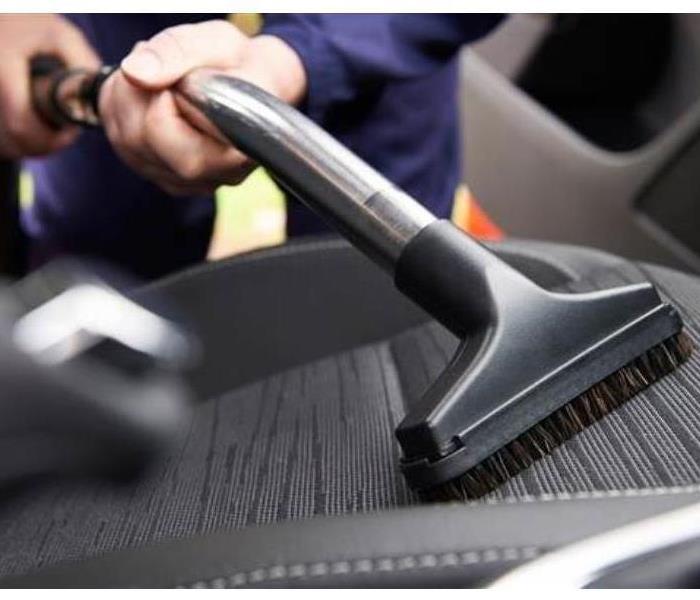 Shutterstock
Shutterstock
How often you should clean upholstery — and the right way to do it!
Aug. 14, 2017 at 4:07 PM
Karen B. Gibbs
TODAY
need of a clean? What about your car? Upholstery, like carpet, needs regular attention, says Shawn Bisaillon, owner of Professional Carpet Systems of North Denver. As an industry consultant for cleaning and restoration, he's sharing insider tips for keeping upholstery looking great.
Upholstery cleaning basics
- If you're going to hire a professional: Bisaillon recommends having upholstery cleaned by a certified cleaning technician every 12 to 24 months — more frequently in households with small children or pets.
To assure that you’re getting a qualified cleaner, look for certification by International Cleaning and Restoration Association or International Institute of Cleaning and Restoration. Before booking an in-home cleaning, request the name of the technician and his/her ICRA or IICR registration number.
- Vacuum: Use upholstery and crevice attachments (they make a huge difference!) to pick up crumbs and dust on a weekly basis.
- Clean spills immediately: Blot them up ASAP. If the spill leaves a spot, follow instructions on the fabric care label. If it’s safe to use water, blot the area alternately with a damp towel and a dry towel to remove it.
- Treat the stain: As always, follow cleaning instructions on the fabric care label. For stains on silk and antique fabrics, consult a professional, otherwise if the stain is from an organic source, like mustard, coffee or other foods, Bisaillon suggests lightly misting it with 3 percent hydrogen peroxide.
Pro tip: Always test in an inconspicuous place first to make sure the fabric is color-safe.
These items were hand-picked by our editorial team because we love them - and we hope you do, too. TODAY has affiliate relationships, so we may get a small share of the revenue from your purchases. Items are sold by the retailer, not by TODAY.
For other stains, Bisaillon uses a CRI-approved spot remover like Benefect Impact Cleaner for Carpet and Fabric. Test it first in a hidden spot, then follow manufacturer’s directions. After working on the stain, leave a towel on top of the treated area as well as on the underside of the fabric to absorb residual liquid.
Clean it yourself
What to do:
- Start by thoroughly vacuuming, using the upholstery and crevice attachments.
- If using cleaning products to break up soil, remember to lightly mist them onto the fabric. (Overspraying can cause the cleaner to seep into cushions.) Then, with a gentle touch, groom the fabric with a soft sponge or brush.
- Rinse the fabric by lightly spraying with warm water and suctioning away moisture with a wet/dry vac. Blot with an absorbent towel. Allow furniture to dry completely before using. To hasten the drying process, use fans or place the cushions outside to dry.
Shutterstock
What to use:
For touch-ups, look for professional-grade home products like Stain X Pro Carpet and Upholstery Shampoo or any other approved upholstery product listed on the Carpet and Rug Institute website. Never use bleaches or de-greasers.
For pet messes, use a wet/dry vac to vacuum up as much of the urine as possible. Apply a bio-enzymatic urine digester, such as Urine Off or Nilodor, according to package directions.
Prepare for disaster
You can spare yourself a lot of work and expense by applying a fabric protector to new or newly cleaned upholstery, especially if the upholstery is made of delicate, soft fibers like silk. For such fabrics, professionally applied Fiber ProTector repels stains, adds UV protection, reduces static electricity and inhibits growth of bacteria, mold and mildew.
For family-friendly fabrics, professionally applied, high-performance 3M Scotchgard does the job. Regular 3M Scotchgard, while not as powerful, is a good DIY option.
Smart Heating and Cooling tips
8/21/2017 (Permalink)
 Smart Cooling and Heating Tips
Smart Cooling and Heating Tips
Smart Heating and Cooling tips
Running your household can often feel like a chore. There are many tasks related to maintenance that you have to keep in your mind at all times to keep your space performing in efficient ways. One primary area to focus your attention is the HVAC system you use to keep your home comfortable. Paying attention to the needs of your units can help you to avoid disaster and keep your home cooled and heated in the best possible ways.
To see excellent results from your maintenance endeavors, be sure to focus on specific aspects of your system. By paying attention to certain areas, you will have a much easier time getting your home in the state that you would like it to be in.
Low Numbers
Staying comfortable at home is not always the easiest of tasks. When you crank up the heat in the winter it can cost you. Energy bills are not cheap and plenty of homeowners are looking for ways to lower the numbers that they spend each month. To keep your costs low while simultaneously reducing the amount of stress on your heating & cooling systems you need to keep the thermostat set to lower numbers. When you turn the heat up as high as it can go, it will cost you a small fortune.
Instead, you can keep the thermostat at a normal temperature and see better results from a financial perspective. In addition to this, keeping your thermostat at a low temperature will help to ensure that you get many years of service out of your HVAC system. This does not mean that you can’t play around with keeping your house different temperatures but the default should always be something reasonable. Finding a balance here will help your home perform the way you would like it to.
Keeping It Clean
Another excellent way for you to make sure that your HVAC system is in great shape is by cleaning it out from time to time. Your units will benefit greatly by you taking a little bit of time to check over the various parts and provide a little care. The filters, for example, can wind up being one of the more important components of your system. These filters are responsible for catching any loose dust or dirt that is floating through the air and circulating through your units. Unfortunately, the filters can clog pretty quickly.
The more clogged a filter is, the more difficult it becomes for your HVAC system to perform the way it is intended. This can put a lot of strain on the unit, causing it to break and wear down far faster than is normal. To avoid all of this, get into the habit of changing the filters at a sensible pace. Knowing when it is time for you to change the filters can allow you the room that you require to keep your system running right and give your home a comfortable feeling whenever you walk through the door.
In the Still of the Night
Many HVAC systems also offer the option of running fans to keep a home circulated. This can be helpful if you want to make sure that your home has a fresh feeling. It can also be useful if you want to cool down your home with the natural air outside instead of having cooler air created by your unit. To achieve this goal with a level of success, run the fans primarily at night. Temperatures are lower at night and keeping the fans of your HVAC running at this point can help you to give your home a cool atmosphere.
Running a household is not always a simple task. To see the most success from your endeavors, focus on the maintenance required by your heating and cooling systems. The more you learn now, the easier it will be to spot an issue down the line.
partnered post • cc-licensed photo by Neal Fowler
Solved! The Best Way to Clean Hardwood Floors
8/21/2017 (Permalink)
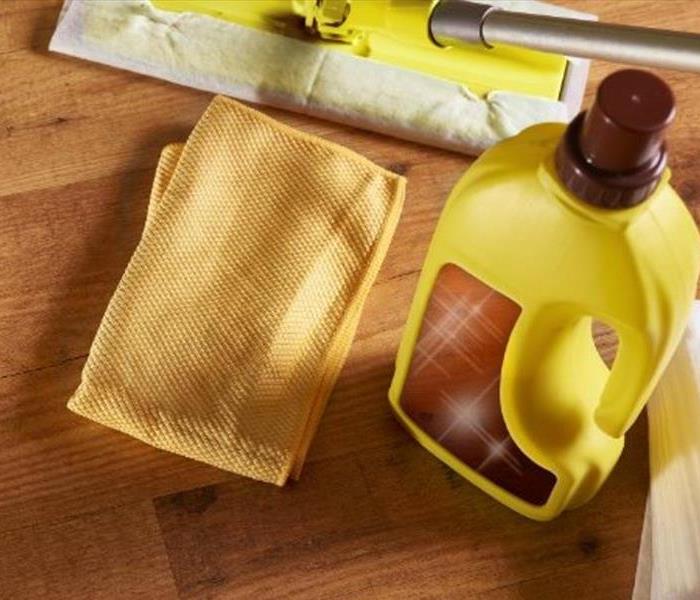 The Best Way to Clean Hardwood Floors
The Best Way to Clean Hardwood Floors
Get hardworking hardwood spic-and-span with these safe solutions for dusting, deep cleaning, and stain removal.
By Manasa Reddigari
Q: I never gave much thought to cleaning my cherry wood floor until I noticed how dingy it had become! What’s the best way to clean hardwood floors? I need recommendations for both cleaning techniques and supplies.
A: It’s true, regular cleaning is a must to maintain the rugged beauty of hardwood floors. Because different floor finishes have unique care requirements, the best way to clean hardwood floors will depend on the type of finish, rather than the wood species (e.g., cherry, maple, oak)—employ the wrong method and you could do damage! Read on to learn how to identify your floor’s finish, then choose the best technique and supplies ideal for dusting, deep cleaning, and removing stains.
Test your floor’s finish. There are two main types of hardwood floor finishes: surface finishes and penetrating finishes.
- Surface finishessuch as urethane and polyurethane form a protective waterproof barrier on the surface of the floor. When liquids come into contact with surface finishes, they pool rather than penetrate the wood—so it’s safe to use water and water-based cleaning products on them. The easiest way to check if your floor has a surface finish is to take a sharp knife blade to a small, hidden area of the floor and scrape off a tiny amount of finish. If the scraped material is clear, your floor probably has a surface finish. If scraping the floor finish smudges it, but no clear material comes away, your floor likely has a penetrating finish.
- Penetrating finishessuch as linseed or tung oil soak through the surface of hardwood floors, and then are usually topped with a wax coat for added sheen. These finishes easily absorb water, and water can warp wood floors, so use only solvent-based cleaning products instead of water-based ones on floors with penetrating finishes.
Start by busting dust. Dry mopping, sweeping, and/or vacuuming on a weekly basis is the best way to rid hardwood floors of light dust, dirt, and pet hair accumulations. Your best bet for a mop is one with a large, flat head affixed with a microfiber cloth pad that can be removed, machine-washed, and re-attached. Available in a variety of brands, including Scotch-Brite and O-Cedar, for $10 to $20 at home centers or office supply stores, these mops feature tiny synthetic fibers that reach into the grooves of wood floors to pick up and hold dust without scratching the wood. If sweeping, opt for brooms with exploded tips (synthetic fiber ends) to help trap collected dust in the broom head and prevent it from resettling on the floor. When vacuuming, use a floor-brush attachment and avoid the beater-bar—its rotating brush can dent wood floors. Move your cleaning tool from one side of the floor to the other, giving extra attention to spots where adjacent floor boards meet—this is a common hiding place for trapped dust. This routine works on floors with either surface or penetrating finishes.
Deep clean heavy dirt and grime buildup. If a surface-finished hardwood floor still looks dingy or dull after dusting, deep clean it with any pH-neutral, wax-free, and petroleum-free cleaner such as Bona PowerPlus Hardwood Floor Deep Cleaner or a homemade solution comprising a quarter-cup of dish soap and a gallon of warm water. Saturate a sponge mop with the cleaner, wring out the excess liquid until the mop head is damp but not dripping, then mop three-foot sections of the floor at a time using circular motions to draw out dirt and grime. Then, rinse the mop in fresh water, wring out the excess, and damp mop the floor again to soak up lingering cleaner. Use a soft, clean towel to dry the floor.
If your floor has a penetrating finish, the best way to deep clean it is to strip away the grimy old wax coat and re-apply a fresh wax coat. Rub a clean cloth saturated in mineral spirits over two-foot sections of the floor at a time, letting the mineral spirits dwell for five minutes on each section before wiping away with a fresh cloth dampened slightly with water; then, dry thoroughly with a fresh, dry cloth. Finally, apply a solvent-based hardwood floor wax such as DuraSeal Paste Wax with a soft cloth in the manufacturer-recommended amount, and then use the cloth or an electric polisher (buy one for between $50 and $150, or get a four-hour rental rent for about $30, at hardware stores) to buff the wax in circular motions, polishing in to two-foot sections at a time.
Perform the appropriate deep cleaning routine on a biannual basis, whether you see grimy buildup or not. It can be hard to notice on a floor you walk on every day, but once it’s clean you’re likely to be impressed by the difference!
Scrape off food stains. Remove caked-on food from either a surface or penetrating finish by carefully inserting the tip of a plastic knife under the lower edge of the debris, and then gently slide the knife upwards. Rub the scraped spot with a clean cloth slightly dampened with a few drops of water, then make a second pass with a dry cloth to sop up the water. If using this technique on a floor with a penetrating finish and a small section of the wax coat gets stripped by the knife, re-apply a dollop of solvent-based hardwood floor wax to the area with a soft cloth, buffing it in to render the area shiny and spotless.
Fight oil stains with TSP. Oil and grease stains on floors with surface or penetrating finishes easily break down when exposed to trisodium phosphate (TSP), available in powder form for $3 to $4 per pound from home centers. Donning gloves and protective glasses, dilute two tablespoons of TSP in one gallon of warm water in a large bucket. Dip the tip of a clean cloth into the solution, then use gentle circular motions to work it into the stain. Once the TSP dissolves it, run a water-dampened cloth over the area to sop up the TSP, then quickly dry the area with a clean cloth.
Ice out wax and gum. Dried candle wax, crayon marks, and chewing gum on floors with surface or penetrating finishes readily come away with ice. Fill a freezer bag with a few ice cubes, then place the chilled bag over the offending buildup until it becomes brittle, then scrape it off with the edge of a plastic spatula. If the spatula removes the protective wax from a floor with a penetrating finish, re-apply a solvent-based hardwood floor wax to the scraped area with a soft cloth, then buff it into the repaired area with the cloth.
Scrub water, ink, and pet stains well. Spots left by water, ink, or pet urine represent the most stubborn of stains. Remove them from floors with penetrating finishes by lightly sanding the stain with extra-fine sandpaper, then gently scrubbing with a coarser “00” grade steel wool wet with mineral spirits. Wipe away the mineral spirits with a water-dampened cloth, followed by a dry cloth to remove the water. Apply a solvent-based hardwood floor wax to the scrubbed area with a soft cloth and buff it in to restore its shine. Sandpaper and steel wool can degrade surface finishes, so you’ll want to tackle these stains using only a hardwood floor cleaner (like Bona Hardwood Floor Cleaner) and a scouring pad designed for surfaced-finished floors.
Children's Aid Society 2017 School Supply Drive
8/21/2017 (Permalink)
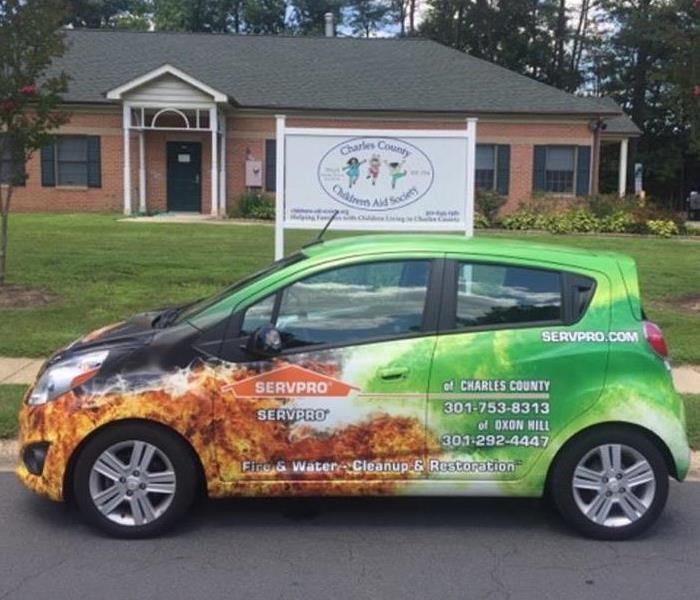 Children's Aid Society 2017
Children's Aid Society 2017
SERVPRO® of Charles County and Children's Aid Society 2017 School Supply Drive
All across Maryland parents are preparing to send their kids back to school and we all know what that means.... shopping for school supplies. Kids LOVE getting new school supplies, I know my daughter does. The unfortunate truth is there are many families that cannot afford school supplies for their children each year. I know from personal experience that each year the list gets bigger and BIGGER!
This is where phenomenal organizations such as The Children's Aid Society come into play. They do a school supply drive that helps many families provide supplies for their children. They depend on donations big and small to make this happen each and every year.
Here at SERVPRO® we find it very important to be involved in our communities beyond doing business. We are fortunate enough to work, live and SERV our communities, so we feel as if we should give back as well. SERVPRO® of Charles County is involved in different campaigns throughout the year and this is The Children's Aid Society School Supply Drive 2017!
It takes one small gesture to start a movement!
Christmas 2016
8/21/2017 (Permalink)
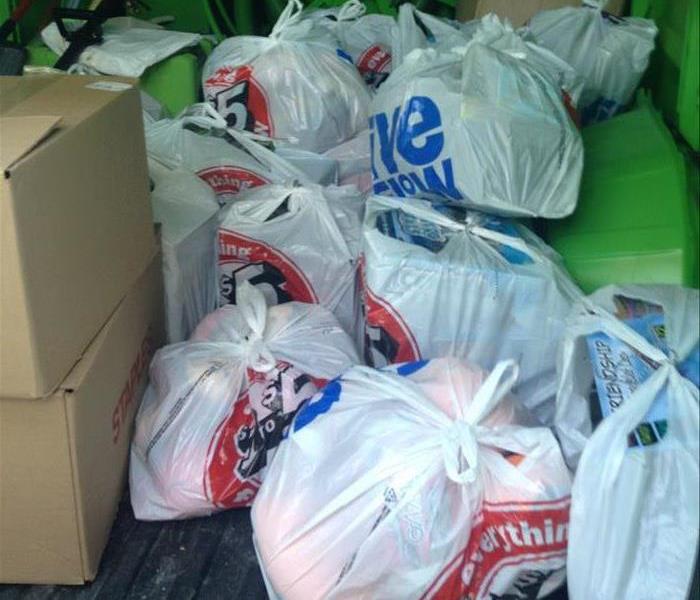 Christmas Shopping 2016
Christmas Shopping 2016
There is nothing more precious than a child’s face on Christmas morning. Regardless of what life throws at you, we believe every child should have something on Christmas morning. SERVPRO® of Charles County and SERVPRO® of Oxon Hill wanted to do our part in helping our community, so we went SHOPPING! We went shopping for all of the fun things children look forward to on Christmas morning as well as basic necessities including socks, hats and gloves. Providing items for children in our community filled our hearts with so much joy and we look forward to doing it again! We played a small part in helping our community and it was one of the most amazing days!
It takes one small gesture to start a movement!
HANDY DIY PRODUCTS WORTH BUYING AT THE DOLLAR STORE
8/21/2017 (Permalink)
 Handy DIY products at Dollar Store
Handy DIY products at Dollar Store
HANDY DIY PRODUCTS WORTH BUYING AT THE DOLLAR STORE
Jul 13 2017
This won’t be a long post, but during my long saga with the master bathroom reno (next steps should be posting this weekend!), I wanted to pop in about a recent trip I made to the dollar store.
My trip was practically arbitrary, having decided just to stop in really quickly to see if I can find a disposable bucket for grout. I have some old dollar store trash bins I’ve kept in a stack in the garage for years, but I had finally depleted my stash and needed more. I have often used cheap dollar buckets instead of my 5-gallon buckets for tile projects because whenever I mix up materials (tile adhesive, grout, etc.), the product is usually half-dried by the time I start to clean up. This also means that it’s a beast to remove, and can make a huge mess in my yard while I clean everything out. By letting the leftover product simply dry up in the dollar bucket, I can then toss away the entire thing if I can’t get the dried slop to come off cleanly (it’s about 50/50 as to whether or not I need to reuse it).
It was time to restock, but I was very surprised to find a number of other great DIY supplies that I never knew were available. For $1 apiece, these make for some great items to keep around for home repair projects!
On this trip, I got:
- disposable particulate masks
- assorted foam brushes
- batteries
- small utility knives (I love having these all over the house… they are my go-to over scissors)
- 4×6 plastic tarp (decent size for the price!)
- rubber mallet (this was the most surprising find)
- cleaning towels (for wiping off grout haze)
- wrinkle releaser (not DIY necessarily, but good for photography)
- more buckets
- one-time use super glue (I don’t know about you guys, but mine always dry up between uses, so smaller containers is ideal!)
- not pictured: a set of mixing spoons (they came in a set and I’m out of paint sticks, so these were great as disposable mixing paddles)
- not pictured: drain declogger tool
Other items that I saw were available (but I don’t need, so I didn’t get, but worth noting):
- hammer
- level
- screw driver sets
- safety goggles
- tape measures
- work light/flash light (small, but still!)
It occurred to me that since my friends are in that stage of buying homes and such, stopping by and picking up a handful of these things is a great idea for a housewarming gift! I wouldn’t recommend that you buy things like a hammer, or a decent tape measure, or other tools that you really need quality for at a dollar store necessarily, but if a homeowner isn’t super handy and probably doesn’t have them already, it makes a great little gift in case they run into a DIY emergency (and new homeowners always do). If they do have quality tools, they can still appreciate the other items that one can never really have too many of, like tarps, or shop pencils, or utility knives.
Have you found anything at the dollar store that surprised you?
Charles County Smoke and Soot Cleanup
8/9/2017 (Permalink)
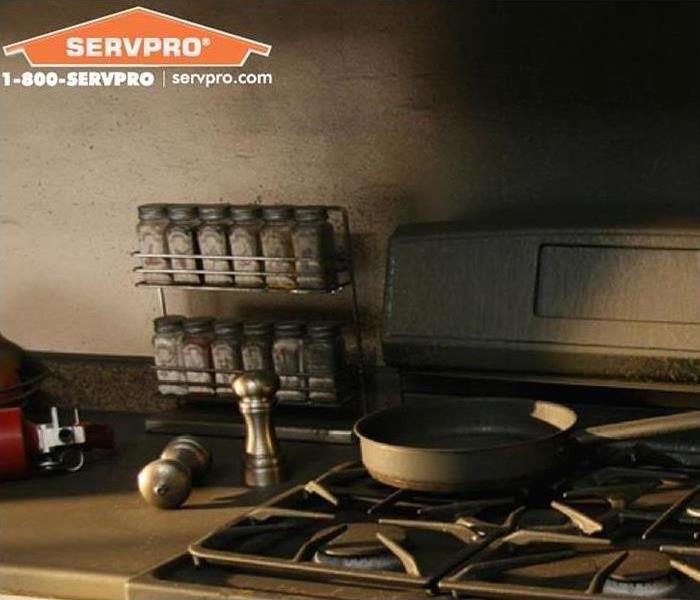 Smoke and Soot Damage Can Cause a Pervasive Odor in Your Charles County Home.
Smoke and Soot Damage Can Cause a Pervasive Odor in Your Charles County Home.
Smoke and soot is very invasive and can penetrate various cavities within your home, causing hidden damage and odor. Our smoke damage expertise and experience allows us to inspect and accurately assess the extent of the damage to develop a comprehensive plan of action.
Smoke and soot facts:
- Hot smoke migrates to cooler areas and upper levels of a structure.
- Smoke flows around plumbing systems, seeping through the holes used by pipes to go from floor to floor.
- The type of smoke may greatly affect the restoration process.
Different Types of Smoke
There are two different types of smoke–wet and dry. As a result, there are different types of soot residue after a fire. Before restoration begins, SERVPRO of Charles County will test the soot to determine which type of smoke damage occurred. The cleaning procedures will then be based on the information identified during pretesting. Here is some additional information:
Wet Smoke – Plastic and Rubber
- Low heat, smoldering, pungent odor, sticky, smeary. Smoke webs are more difficult to clean.
Dry Smoke – Paper and Wood
- Fast burning, high temperatures, heat rises therefore smoke rises.
Protein Fire Residue – Produced by evaporation of material rather than from a fire
- Virtually invisible, discolors paints and varnishes, extreme pungent odor.
Our Fire Damage Restoration Services
Since each smoke and fire damage situation is a little different, each one requires a unique solution tailored for the specific conditions. We have the equipment, expertise, and experience to restore your fire and smoke damage. We will also treat your family with empathy and respect and your property with care.
Have Questions about Fire, Smoke, or Soot Damage?
Call Us Today – 301.753.8313
When Storms or Floods hit Charles County SERVPRO is ready!
7/24/2017 (Permalink)
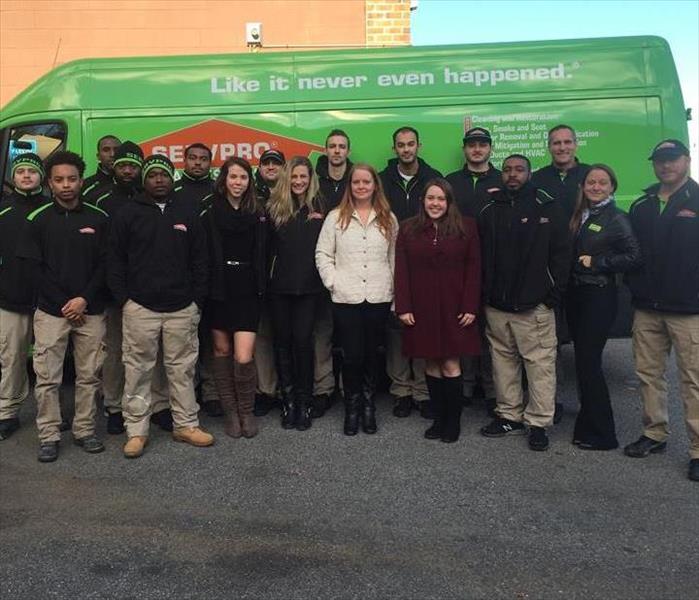 Our highly trained crews are ready to respond 24/7 to storm or flood damage in Charles County.
Our highly trained crews are ready to respond 24/7 to storm or flood damage in Charles County.
SERVPRO ofCharles County specializes in storm and flood damage restoration. Our crews are highly trained and we use specialized equipment to restore your property to its pre-storm condition.
Faster Response
Since we are locally owned and operated, we are able to respond quicker with the right resources, which is extremely important. A fast response lessens the damage, limits further damage, and reduces the restoration cost.
Resources to Handle Floods and Storms
When storms hit Charles County we can scale our resources to handle a large storm or flooding disaster. We can access equipment and personnel from a network of 1,650 Franchises across the country and elite Disaster Recovery Teams that are strategically located throughout the United States.
Have Storm or Flood Damage? Call Us Today 301.753.8313
Faster to your Charles County Water Damage Event
7/12/2017 (Permalink)
Flooding and water emergencies don’t wait for regular business hours and neither do we. SERVPRO of Charles County provides emergency cleaning and restoration services 24 hours a day, 7 days a week—including all holidays.
Faster To Any Size Disaster
Flooding and water damage is very invasive. Water quickly spreads throughout your home and gets absorbed into floors, walls, furniture, and more. SERVPRO of Charles County arrives quickly and starts the water extraction process almost immediately. This immediate response helps to minimize the damage and the cleaning and restoration costs.
Need Emergency Service? Call Us 24/7 – 301.753.8313
Water Damage Timeline
Within Minutes
- Water quickly spreads throughout your property, saturating everything in its path.
- Water is absorbed into walls, floors, upholstery, and belongings.
- Furniture finishes may bleed, causing permanent staining on carpets.
- Photographs, books, and other paper goods start to swell and warp.
Hours 1 - 24:
- Drywall begins to swell and break down.
- Metal surfaces begin to tarnish.
- Furniture begins to swell and crack.
- Dyes and inks from cloth and paper goods spread and stain.
- A musty odor appears.
48 Hours to 1 Week:
- Mold and mildew may grow and spread.
- Doors, windows, and studs swell and warp.
- Metal begins to rust and corrode.
- Furniture warps and shows signs of mold.
- Paint begins to blister.
- Wood flooring swells and warps.
- Serious biohazard contamination is possible.
More Than 1 Week:
- Restoration time and cost increase dramatically; replacing contaminated materials and structural rebuilding may be extensive.
- Structural safety, mold growth, and biohazard contaminants pose serious risks to occupants.
About SERVPRO of Charles County
SERVPRO of Charles County specializes in the cleanup and restoration of residential and commercial property after a fire, smoke or water damage event. Our staff is highly trained in property damage restoration. From initial and ongoing training at SERVPRO’s corporate training facility to regular IICRC-industry certification, rest assured our staff is equipped with the knowledge to restore your property.
For Immediate Service in Charles County, Call SERVPRO
7/12/2017 (Permalink)
SERVPRO of Charles County provides 24-hour emergency service and is dedicated to being faster to any-sized disaster in Charles County. We can respond immediately to your emergency and have the expertise to handle your restoration or cleaning needs.
- 24-Hour Emergency Service
- Faster to Any-Sized Disaster
- Highly Trained Restoration Technicians
- A Trusted Leader in the Restoration Industry
- Locally Owned and Operated
- Advanced Restoration and Cleaning Equipment
Have Questions? Call Us 24/7 – 301.753.8313
Residential Services
Whether your Charles County home needs emergency flood damage or your upholstery cleaned, you can depend on us. Our technicians have extensive cleaning and restoration training and can make your property look its best. Learn more about our residential services:
- Water Damage Restoration
- Fire Damage Restoration
- Mold Remediation
- Storm Damage Restoration
- Cleaning Services
- Building/Reconstruction Services
Commercial Services
There's never a convenient time for fire or Water damage to strike your Charles County commercial property. Every hour spent cleaning up is an hour of lost revenue and productivity. So when the need arises for professional cleaning or emergency restoration services we have the training and expertise to respond promptly with highly trained technicians to get your property back to business. Learn more about our commercial services click:
Washington Redskins Cheerleader's Youth Dance & Cheer Camp
8/13/2014 (Permalink)
 In front of Redskin Stadium
In front of Redskin Stadium
SERVPRO of Charles County is proud to announce the sponsorship of Brooklyn Pritchect at the 2014 Washington Redskins Cheerleaders Youth Dance & Cheer Camp. At this event, Brooklyn was able to learn and practice her cheering and dancing skills with the best of the best, the Washington Redskin Cheerleaders! All of us here at SERVPRO are very proud of her participation and accomplishments, as she won the award of “Great Energy & Entertainment” at camp and was selected for the All Star Team. Brooklyn keep up the great work!
Always Improving!
8/13/2014 (Permalink)
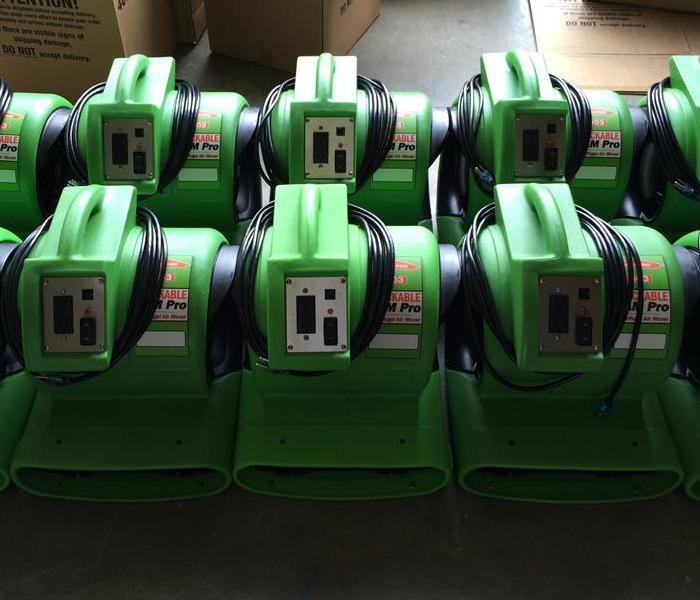 803 Stackable CAM Pro Air Movers
803 Stackable CAM Pro Air Movers
Here at SERVPRO of Charles County, we pride ourselves on providing our customers with new innovative equipment for their drying needs. That is why we have begun purchasing the new Stackable Cam Pro Air Movers. This product’s design allows for more airflow using less power, which means the drying process takes less time while using less power. Just one of the many ways we clean up your water damage as quick and as efficient as possible.
Our Sexy New Air Mover!
4/23/2014 (Permalink)
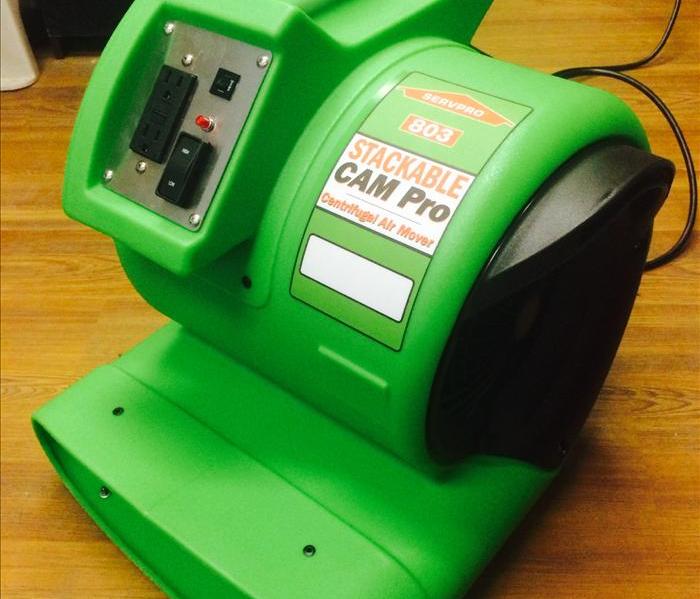 803 Phoenix™ Stackable CAM Pro Air Mover
803 Phoenix™ Stackable CAM Pro Air Mover
From time to time, equipment reaches its end of life from heavy use and is forced to be replaced. SERVPRO of Charles County is devoted to continously purchasing equipment with newer features to help our customers dry their water damages more effectively and faster. We are in the process of replacing air movers that features low amps, high CFM and utilizes an innovative stable, stackable design.





 24/7 Emergency Service
24/7 Emergency Service









